HSO (Herschel Space Observatory)
Non-EO
ESA
Astronomy and Telescopes
Quick facts
Overview
| Mission type | Non-EO |
| Agency | ESA |
| Launch date | 19 May 2009 |
HSO (Herschel Space Observatory)
Spacecraft Launch Mission Status Sensor Complement Ground Segment References
HSO is an infrared astronomy mission, the fourth and final “Cornerstone” mission of ESA's (European Space Agency) Horizon 2000 program. In 1997, the Scientific Program Committee of ESA confirmed the Herschel (FIRST) mission. In December 2000, the former FIRST (Far Infrared and Submillimeter Telescope) mission was renamed to “Herschel” in honor of Britain's pioneering astronomers William and his sister Caroline Herschel. In 1800, Sir William Herschel (1738-1822) demonstrated that the electromagnetic spectrum extends beyond the visible range of light that is now known as the “infrared” region. 1) 2)
The primary objectives of the mission are to:
• Study the formation of galaxies in the early universe and their subsequent evolution
• Investigate the creation of stars and their interaction with the interstellar medium
• Observe the chemical composition of the atmospheres and surfaces of comets, planets and satellites
• Examine the molecular chemistry of the universe.
With a primary mirror 3.5 m in diameter, Herschel is the largest aperture infrared telescope sent into space so far. With its ability to observe across the far infrared and submillimeter wavelengths (55 - 672 µm, entire FIR region), Herschel will furnish observation data that has previously been unobtainable. In particular, HSO will have an unprecedented view of the cold universe, bridging the gap between what can be observed from ground and earlier space missions of this kind. Infrared radiation can penetrate the gas and dust clouds that hide objects from optical telescopes, looking deep into star-forming regions, galactic centers and planetary systems. Also cooler objects, such as tiny stars and molecular clouds, and even galaxies enshrouded in dust, which are barely emitting optical light, can be visible in the infrared. 3) 4) 5) 6)
A lot of cutting-edge technology was introduced to make this ambitious mission possible.
Background: The main scientific goals, mission requirements, and technological needs for Herschel were discussed for the first time already back in the 1980s at a time when the United States-Dutch-British IRAS (InfraRed Astronomical Satellite, launch Jan. 25, 1983) satellite inaugurated infrared space astronomy by mapping 250,000 cosmic infrared sources and large areas of extended emission. On November 19, 1995, ESA launched its ISO (Infrared Space Observatory) which has allowed a more detailed insight and new discoveries of the infrared sky. In August 2003, NASA launched SIRTF (Space Infrared Telescope Facility - SIRTF was renamed to Spitzer Space Telescope in Dec. 2003), a spaceborne, cryogenically cooled infrared observatory. As ESA's fourth key science mission (Cornerstone), Herschel is building on the success of these earlier missions by being the first to extend the spectral coverage into the FIR (Far-Infrared) and submillimeter wavelengths (Ref. 7).
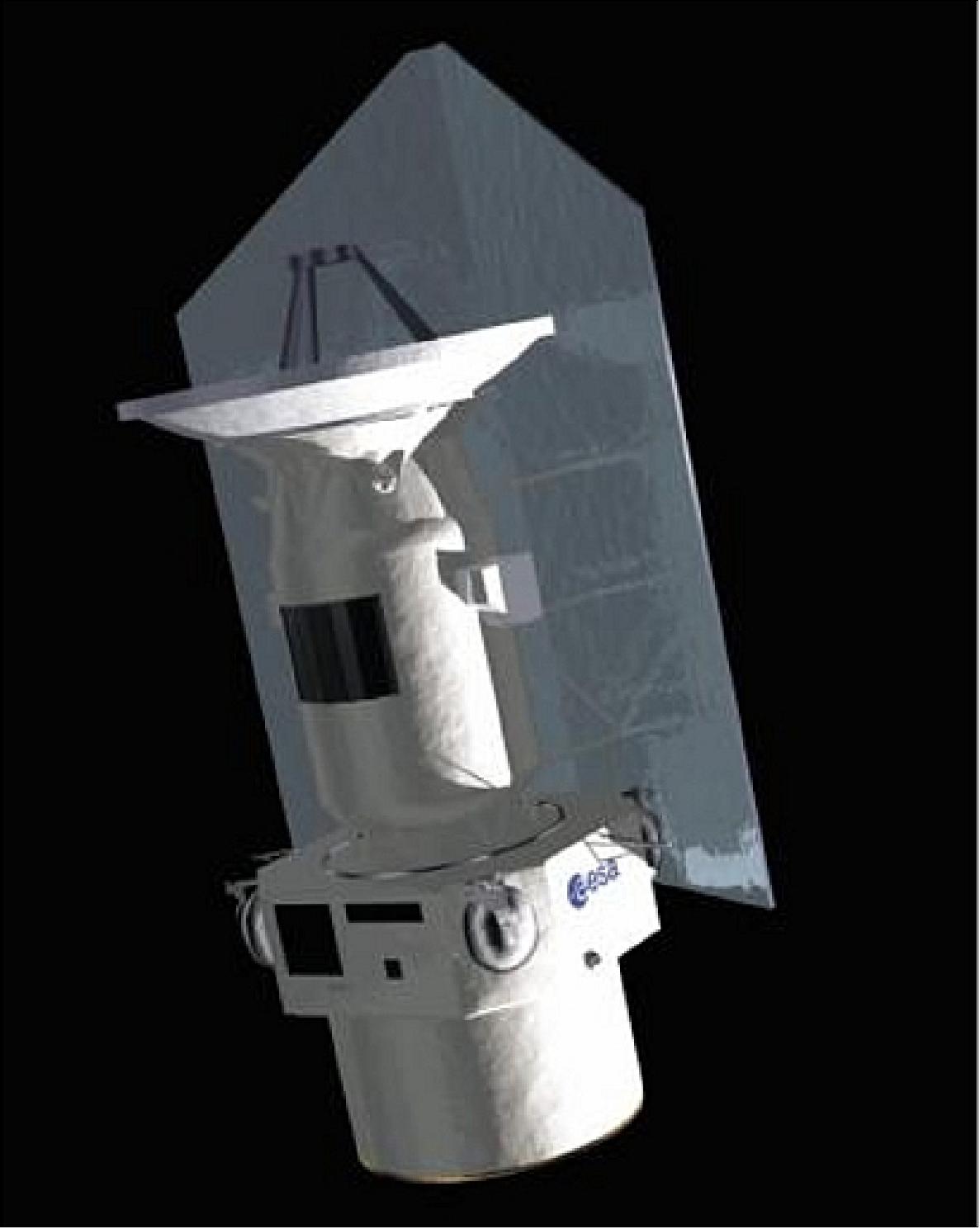
Spacecraft
ESA's prime contractor for Herschel is TAS (Thales Alenia Space), Cannes, France, which led a consortium of industrial partners with EADS Astrium (Friedrichshafen, Germany) responsible for the payload module, and the TAS industry branch (Turin, Italy) responsible for the service module. EADS Astrium (Toulouse, France) provided the telescope. There is also a host of subcontractors spread throughout Europe. - The kick-off for industry was in April 2001 and the Preliminary Design Review (PDR) was closed out at the end of 2002, while the Critical Design Review (CDR) was completed by mid 2004. 7) 8) 9) 10)
The Herschel satellite is a tall cylinder, about 7.5 m high and 4.0 m wide. The spacecraft features a modular design, consisting of the EPLM (Extended Payload Module) and the SVM (Service Module).
• The EPLM consists of the PLM ‘proper’ with the superfluid helium cryostat – based on the proven successful ISO (International Space Observatory, a 60 cm infrared telescope of ESA with a launch in 1995) technology – housing the HOB (Herschel Optical Bench) with the instrument FPUs (Focal Plane Units), and supporting the telescope, the SS (Sunshield/Sunshade), and payload associated equipment.
• The SVM houses ‘warm’ payload electronics, and provides the necessary ‘infrastructure’ for the satellite such as power, attitude and orbit control, the on-board data handling and command execution, communications, and safety.
SVM (Service Module)
The SVM is formed by an octagonal box built around a conical tube (cone):
- The SVM houses the equipment of the avionics and servicing subsystems, the payload "warm" units (WU) for HIFI, PACS and SPIRE instruments. The Herschel SVM is designed to provide the required mechanical and thermal environments during launch and in-orbit phases to the various equipment and instruments installed in it.
- The SVM supports the PLM cryostat support truss on the top of the cone. It supports other PLM items as the SVM shield for radiative de-coupling between SVM and cryostat, and SS (Sunshield and Sunshade) support truss (both on the top of the cone and upper closure panels).
- The SVM ensures the mechanical link with the launcher through the interface ring, and therefore ensures the main load path during launch.
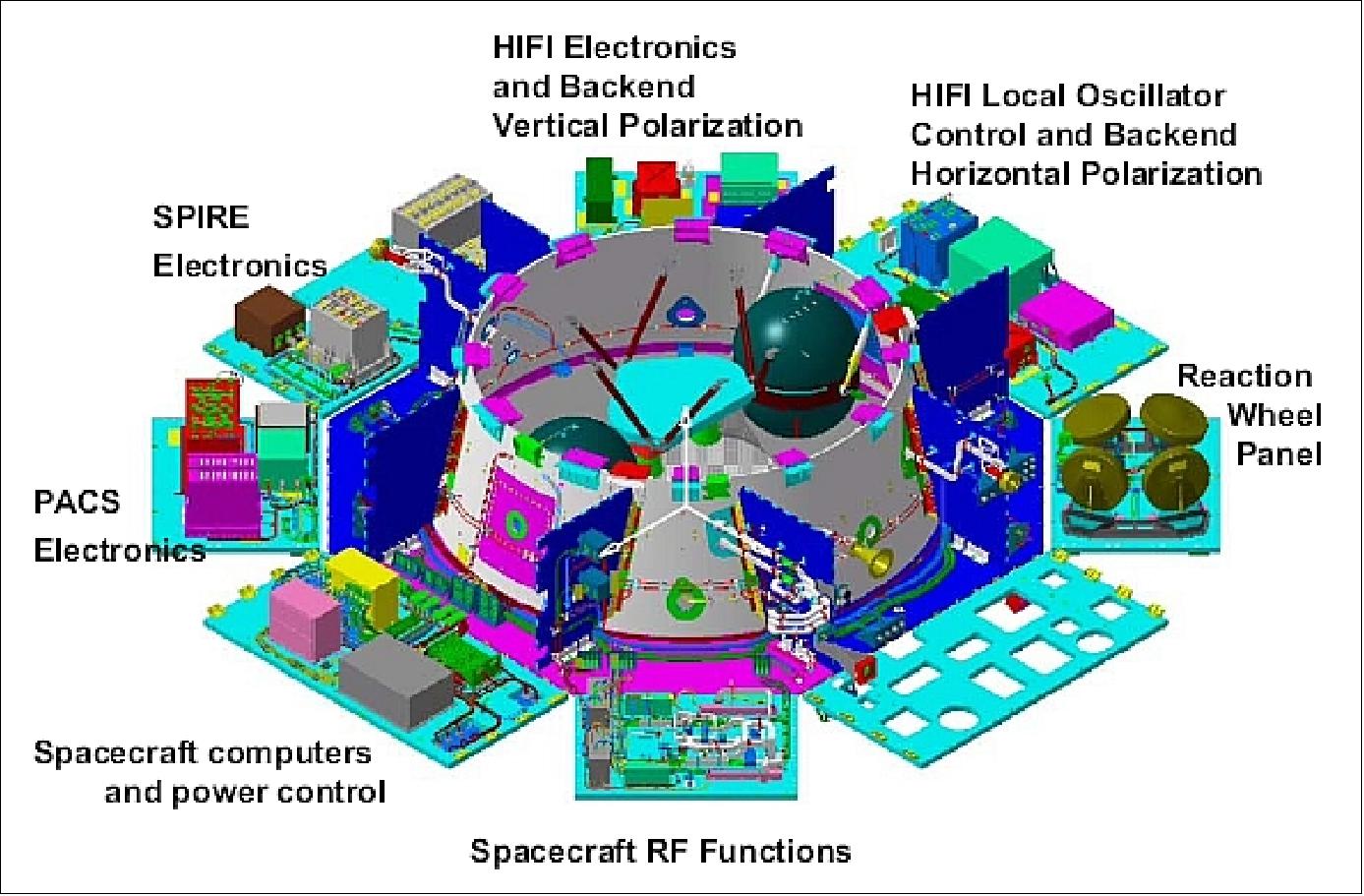
The ACMS (Attitude Control and Measurement Subsystem) uses a star tracker (STR) for attitude sensing. An absolute pointing error of < 3.7 arcsec is required. The star tracker is supplemented by the CRS (Coarse Rate Sensor), SAS (Sun Acquisition Sensor), and the AAD (Attitude Anomaly Detector). The attitude is estimated from the measurements of the star tracker and of an accurate gyroscope and is controlled by the reaction wheels of the RWS (Reaction Wheel Subsystem). Due to a typical duration of observations with an instrument of less than a few hours, momentum dumping is not expected to interfere with the scientific observations. All ACMS devices are controlled by the ACC (Attitude Control Computer) using the ACMS bus or discrete interfaces (Figure 3).
The STR device used on-board the Herschel spacecraft was built by Selex Galileo (former Galileo Avionica), and is basically a video camera with a FOV of 16.4º x 16.4º and an image processing unit that interprets star field images in order to determine spacecraft attitude information, measured with respect to the J2000 inertial reference system. Two identical units are mounted together on the base of the cryostat and are operated in cold redundancy in order to minimize any thermal distortions that may disturb the relative alignment between their bore sight and that of the telescope, which is aligned along the same spacecraft axis but looks in the diametrically opposite direction (i.e. –X for the STR and +X for the telescope). At the heart of the STR is a thermoelectrically cooled CCD (512 x 512 pixels) and an ASIC that provides all of its low-level real-time digital functions, along with some pre-processing operations. All high level functions are managed by software permanently stored in PROM and EEPROM memories and run within an ERC32 microprocessor, which outputs data at 4 Hz onto the ACC’s 1553 data bus. 11)
The gyroscope (GYR), built by Northrop Grumman, consists of four HRG (Hemispherical Resonator Gyro) units, each sensitive to rates about one axis, integrated into a single gyro package that is mounted directly onto a service module shear wall panel. The four HRGs are arranged in redundant octahedral tetrad configuration such that any three of four axes provides observability to three orthogonal axes. Each HRG has its own set of buffer electronics that transfers its signals to a signal processor via one of two redundant gyro interface electronics units (GYR-E). Each gyro rate signal is then computed by the signal processors and is output at 4 Hz as an accumulated angle and a time tag by the GYR-E, onto the ACC’s 1553 data bus. The signal processor also provides precise thermal control for each HRG, via dedicated heater control channels, while the spacecraft’s service module provides active thermal control for the GYR’s immediate environment, via thermistors located on the unit’s mounting plate.
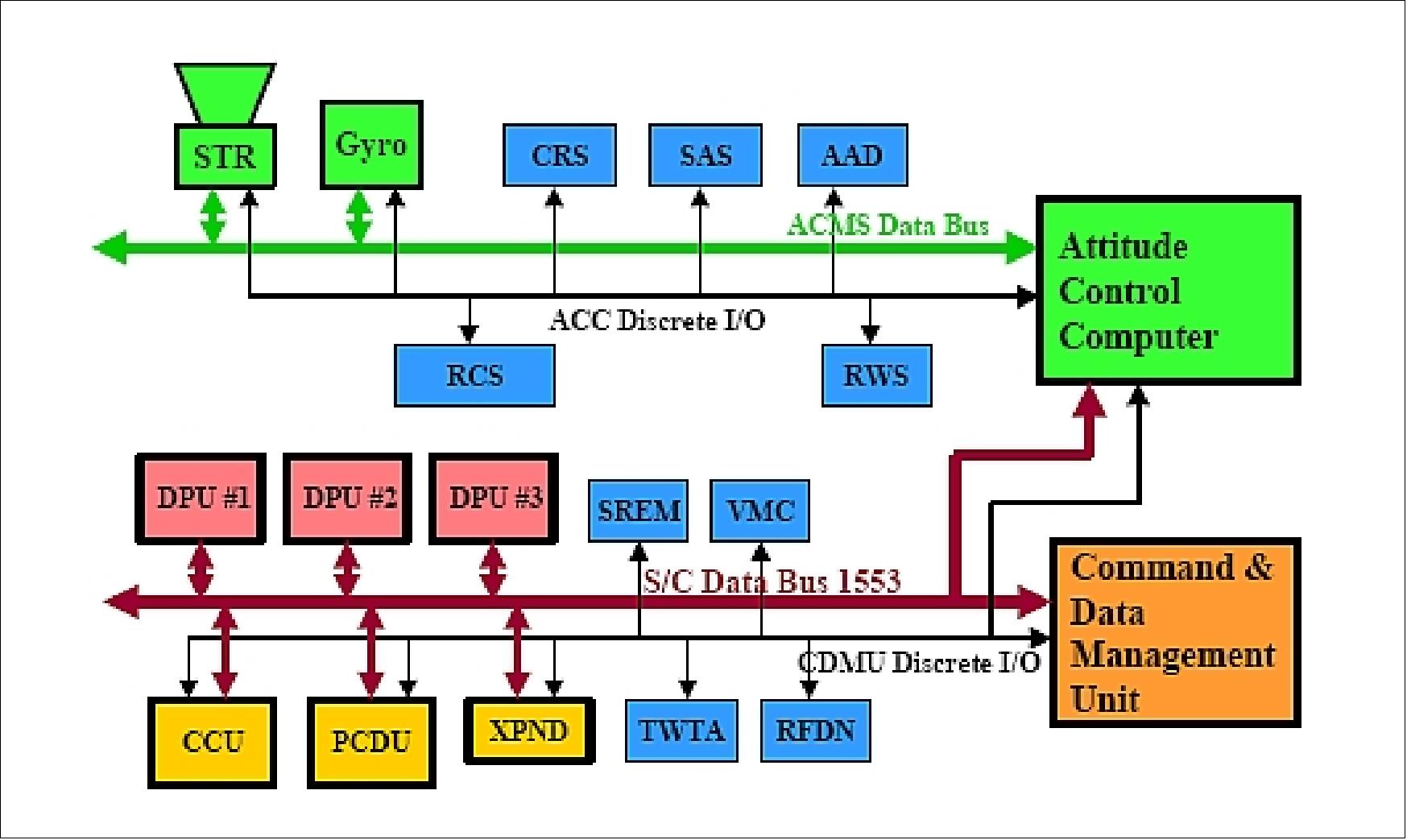
Legend to Figure 3: CRS (Coarse Rate Sensor Assembly), SAS (Sun Acquisition Sensor), AAD (Attitude Anomaly Detector)
Herschel science observations are made via three distinct attitude modes:
- fine pointing, for staring at fixed targets
- line scans, for mapping large areas of the sky
- raster scans, for imaging large areas of the sky via a sequence of fine pointings (rarely used).
After verification of the in-orbit performance of the ACMS during the Service Module commissioning phase, which revealed and corrected for interference from the thermal control of the Gyro Unit (Scalable Inertial Reference Unit), the pointing accuracy was monitored and improved during various campaigns (Ref. 11).
In-flight experience during Herschel operations allowed optimization of the overall pointing performance of the ACMS (Attitude Control and Monitoring System) to a factor 4.5 better than the requirements. After identification and correction of interference of the external heaters of the GYR box, which indeed had caused a violation of the AME (Attitude Measurement Error), further stepwise improvement of mainly the APE (Absolute Pointing Error) was achieved through the removal of warm pixels on the CCD of the Star Tracker, through the correction of the on-board knowledge of the focal length and the CCD characteristics, and finally through a clean-up of the on-board “star catalog” (Ref. 11).
Herschel is now (2012) observing with an accuracy in the order of < 1 arcsec for the APE (Absolute Pointing Error). The present absolute pointing performance is measured as APE ~ 0.8-0.9 arcsec (1σ) since OD1011 (Operational Day 1011). 12)
RCS (Reaction Control System): The RCS on the Herschel spacecraft is responsible for providing all the necessary forces and torques needed to change the angular momentum of the spacecraft. This is used to perform all in-orbit maneuvers, including those for orbit transfer, insertion and maintenance, and for attitude control. The Herschel RCS includes two propellant storage tanks, two latch valves and a pressure transducer, and 12 thrusters (6 nominal plus 6 redundant). The fuel of choice for the thrusters is hydrazine.
The CDMU (Command and Data Management Unit) is the main OBC of the CDMS (Command and Data Management System) using the 1553 bus protocol and a dedicated packet structure for interfacing with all subsystems. The data interfaces with the various subsystems are provided by: the DPUs (Data Processing Units) for the sensor complement, the CCU (Cryostat Control Unit), the PCDU (Power Control and Data Unit), and the XPND (Transponder). The mass memory on the CDMU has a capacity of 25 GByte (EOL) and is compatible with the needs of the mission requirement calling for autonomous operations of up to 48 hours. The CDMU and the ACC house the on-board software. Both are based on an ERC-32 microprocessor connected via the 1553 B interface.
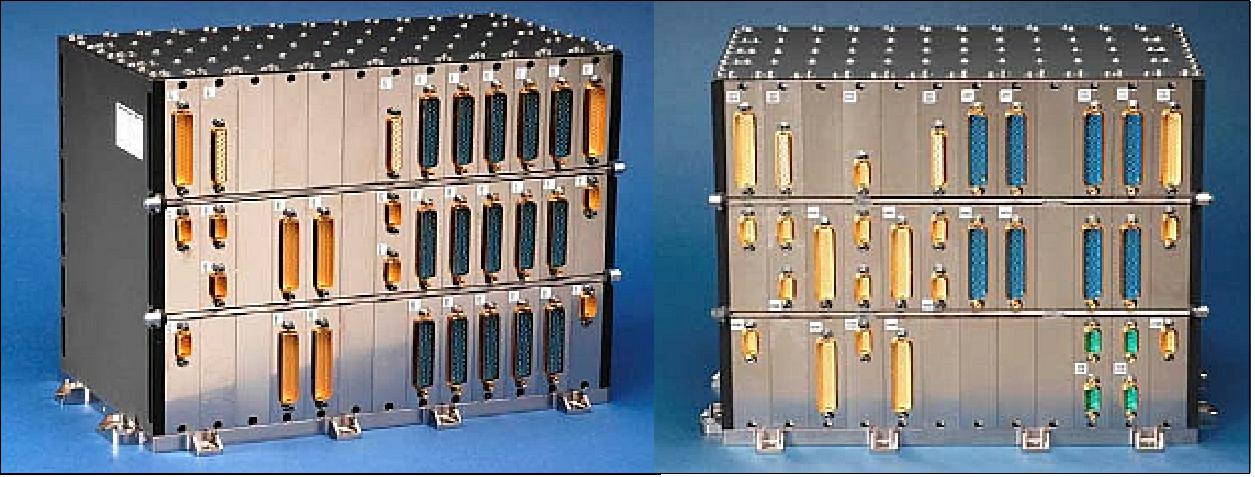
RF communications: The subsystem is a full X-band system in downlink and uplink (i.e. TT&C and payload data) with the ground stations, providing a high downlink rate of up to 1.5 Mbit/s at L2 to download the scientific data during the 3 hours daily telecommunication period (the average data rate of the sensor complement is 130 kbit/s). The subsystem consists of two X-band transponders supporting GMSK modulation, 2 TWTA (Travelling Wave Tubes Assemblies) with 35 W power each, the MGA (Medium Gain Antenna) for high data rate transmission, LGAs (Low Gain Antennas) to ensure omni-directional coverage (2 antennas on Herschel). The RFDN (Radio Frequency Switching Network) permits to connect nominal and redundant RF chains to the various antennas. 13)
Nominal contact periods between a ground station and the Herschel spacecraft are planned for 3 hours per day, referred to as DTCP (Daily Telecommunication Period). To ensure autonomous operations, two main mechanisms have been implemented:
- An operation scheduling mechanism in charge of the programmed operations of the spacecraft including the instruments
- A fault protection system – mainly the FDIR (Failure Detection, Identification and Recovery) system – to guarantee safe operation of the spacecraft including the instruments in case of failure.
The spacecraft’s housekeeping and scientific data are downloaded from the spacecraft and routed from the receiving station to the MOC (Mission Operations Center) in ESOC (Darmstadt, Germany), and from there to the HSC (Herschel Science Center) at ESAC (ESA/European Space Astronomy Centre) in Villafranca, Spain. Here the data are processed, archived in the Herschel Science Archive, and made available to the observers.
Relevant data are distributed to the instrument control centers, where they are used to monitor and optimize instrument performances. The Herschel instrument control centers are:
• PACS: MPE (Max Planck Institute for Extraterrestrial Physics), Garching, Germany
• SPIRE: RAL (Rutherford Appleton Laboratory, Didcot, UK
• HIFI: SRON Netherlands Institute for Space Research, Groningen, the Netherlands.
• An additional center is the NASA Herschel Science Center, located at the California Institute of Technology Infrared Processing and Analysis Center, Pasadena, California, USA.
During LEOP (Launch and Early Orbit Phase), the satellites (Herschel and Planck) are being monitored 22 hours a day using ESA’s Deep Space Stations at New Norcia, near Perth, Australia (primary ground station), Cebreros, Spain, Perth, Australia and Kourou, French Guiana. 14) 15)
Spacecraft modules (2) | EPLM (Extended Payload Module), SVM (Service Module) |
Spacecraft launch mass, power | 3375 kg, 1260 W |
Spacecraft size | 7.5 m (high), 4 m x 4 m overall cross section |
Spacecraft stabilization | 3-axis stabilized |
Pointing accuracy | 0.24 arcsec relative pointing accuracy over 1 minute |
Attitude thrusters | 12 thrusters, 20 N each |
Solar arrays | Flat, fixed panels of triple-junction, GaAs cells, |
Batteries | 39 Ah Lithium ion batteries |
Mission lifetime | 3 years nominal starting from end of commissioning phase |
Telescope | Cassegrain design, 3.5 m primary and 0.3 m secondary mirror |
Telescope mass | 315 kg |
RF communications | 2 low gain antennas, 1 medium gain antenna |
Operational orbit | Lissajous orbit at an average distance of 800,000 km from L2 |
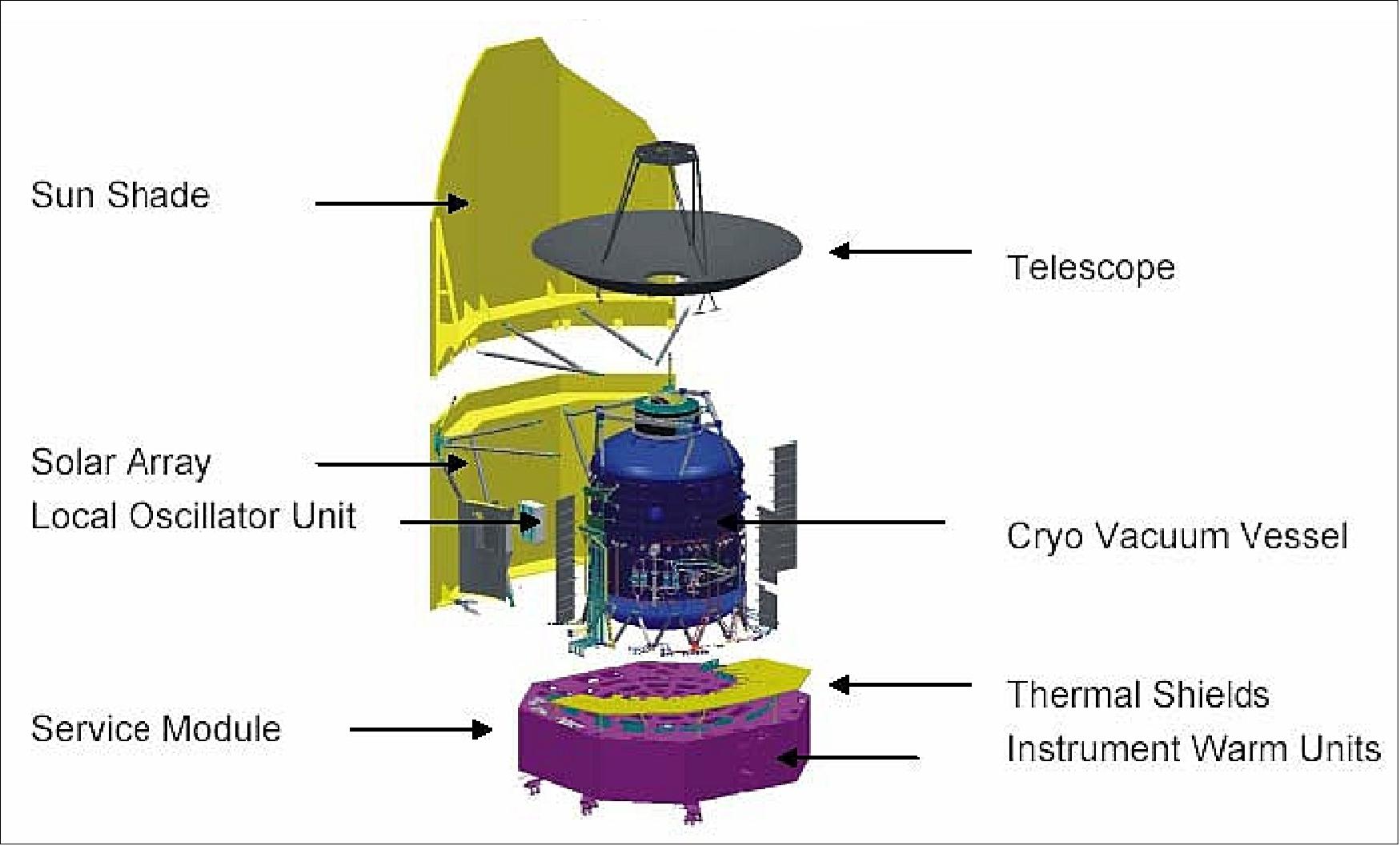
EPLM (Extended Payload Module)
The EPLM is mounted on top of the satellite bus, the SVM (Service Module) and consists of the cryostat containing the instruments' focal plane units (FPU) and the Herschel telescope.
Cryostat
Herschel relies on the successful ISO cryostat technology with a cryostat lifetime requirement of 3.5 years. From L2, both the Sun and the Earth always will be in the same general direction in the sky making it possible to design the spacecraft to have a ‘warm’ and a ‘cold’ side. This fact has enabled optimization of the thermal design including equipping the CVV (Cryostat Vacuum Vessel) with radiators on the ‘cold’ side, significantly lowering the outside temperature of the cryostat. The resulting helium boil-off rate for Herschel, just over 2 mg s-1, is only approximately half that of ISO, while the fraction of the total cryogen heat load contributed by the science payload has doubled to ~20%.
Herschel’s superfluid helium tank, where the helium is kept at its boiling temperature (1.65 K or –271.5ºC). The helium cools the focal plane unit of the scientific instruments and the three thermal shields. The liquid boils and produces gas that slowly flows from the tank into pipes around the payload, cooling it to between 1.7 K (– 271.4ºC) and 4 K (– 269ºC).
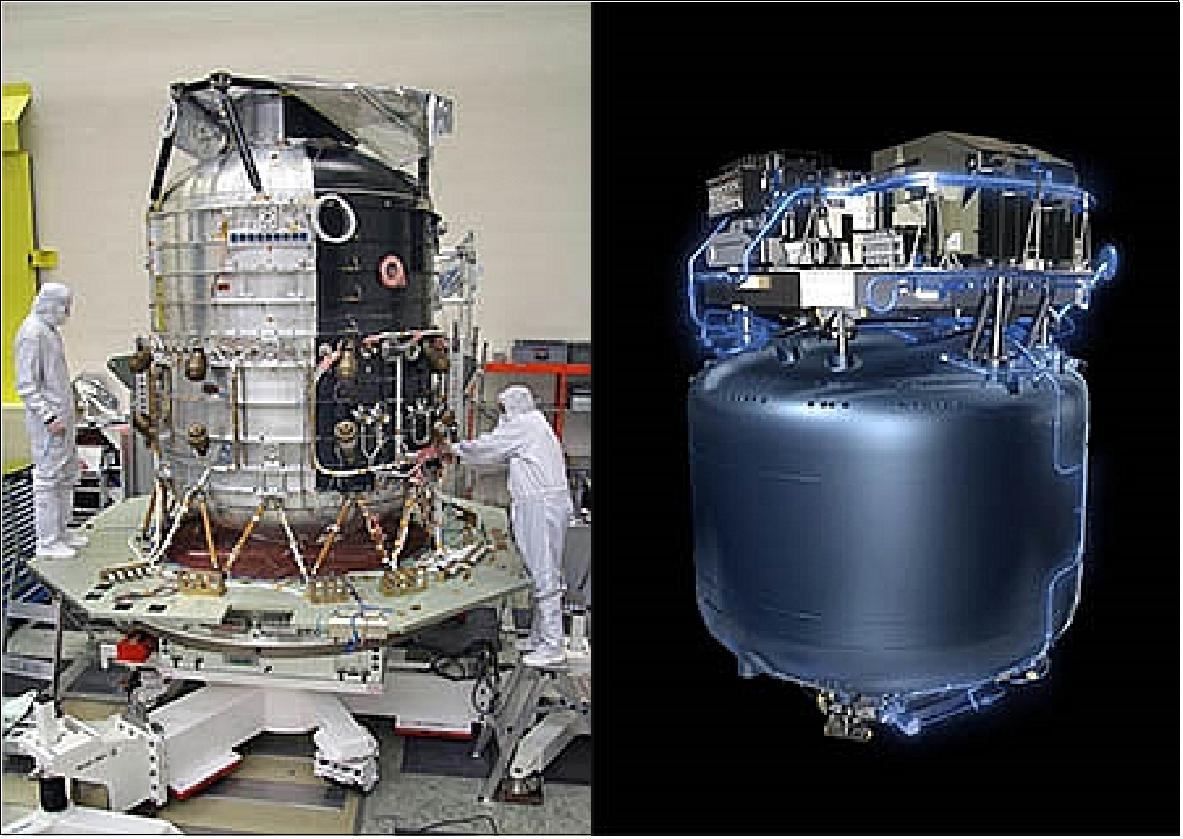
The detector FPUs (Folcal Pane Units) of all three science instruments accommodated in the CVV, mounted on the optical bench on top of the the superfluid helium tank, and are being cooled by the cryostat. This sophisticated vacuum flask was filled with 2367 liter of superfluid helium at launch, at temperatures below – 271ºC. Further cooling – down to 0.3 K – is necessary for the SPIRE and PACS bolometric detectors (a bolometer is a device capable of detecting and measuring small amounts of thermal radiation).
The cryostat, with the largest spaceborne dewar so far, plays a key role in the Herschel mission because it determines the lifetime of the observatory. The helium evaporates at a constant rate, gradually emptying the tank. When it has all gone, the temperature of the instruments will start to rise and Herschel will no longer be able to perform observations. However, its data will keep astronomers busy for decades.
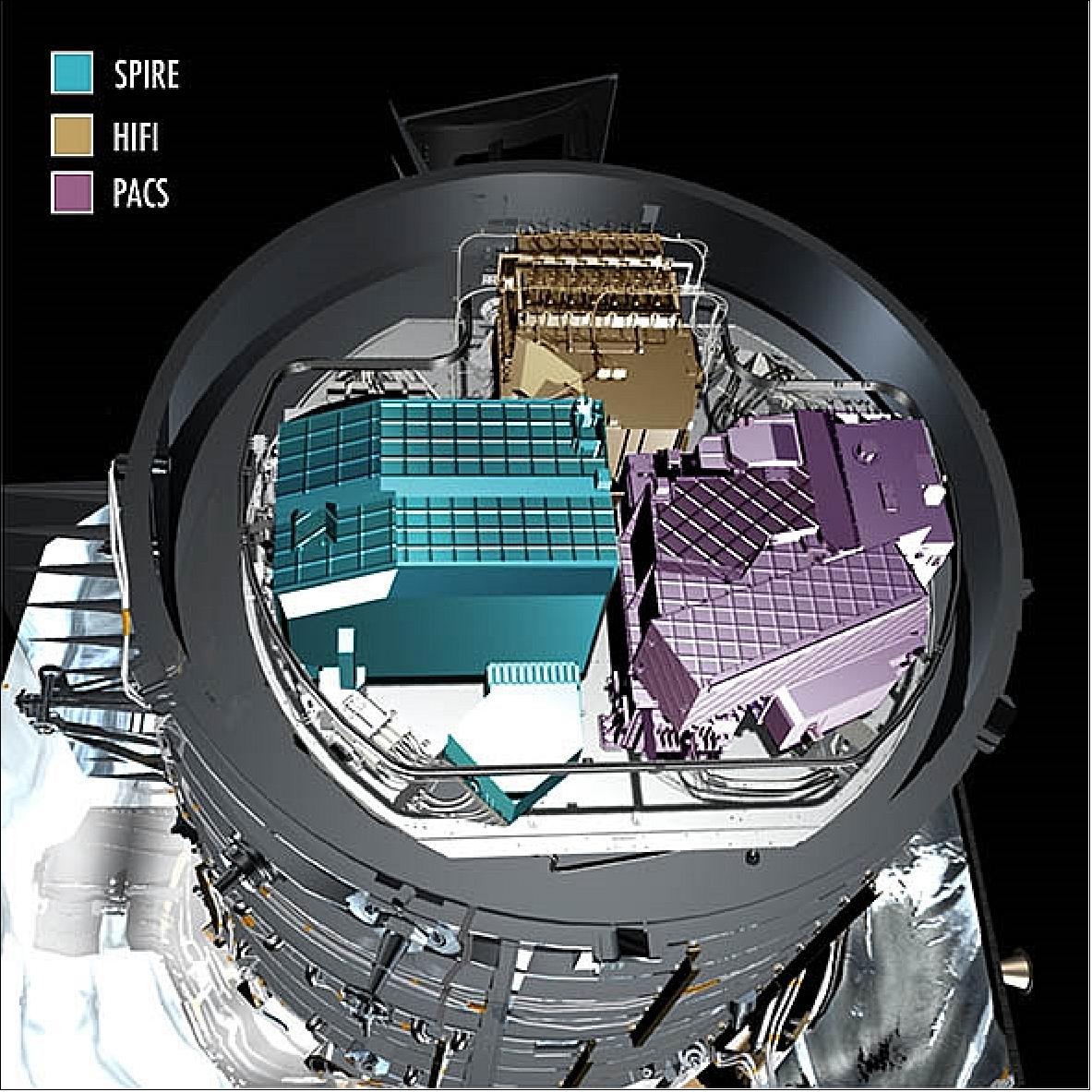
Telescope
The Herschel telescope is constructed of innovative materials representing major technological achievements. The requirements called for a stiff (optical and mechanical stability) and lightweight primary mirror of 3.5 m in diameter with an areal density of < 30 kg/m2. In addition, a diffraction-limited performance was required for the shortest wavelength. The total WFE (Wave Front Error) of the telescope was set to 6 µm rms. The size of Herschel’s primary mirror meant that it could not be built in a single piece but instead had to be constructed from 12 separate petals, thus becoming the first “segmented” space mirror as well as the largest to date. 17) 18) 19)
The telescope diameter is only limited by the size of the fairing on the Ariane 5-ECA rocket. ESA opted for a monolithic telescope built in 12 large segments of a ceramic material called Silicon Carbide (SiC). This meant segments of the mirror were 'baked’ like pottery in an oven rather than traditionally cast before the segments then were brazed together – forming the largest ceramic object ever built. The resulting mirror dish has a mass of about 300 kg, 1/3 the mass of the Hubble Space Telescope's primary reflector of 2.4 m aperture and ~ 900 kg mass, despite being almost two times larger in area.
Telescope diameter | 3.5 m (3.3 m effective aperture) |
Field of view radius | 0.25º |
Total telescope mass, mass of primary mirror | 315 kg, 210 kg |
Predicted operating temperature range | 60 – 90 K |
Telescope emissivity | < 4% (the monolithic telescope is passively cooled) |
Operating wavelengths | 57 - 672 µm |
Telescope total WFE (Wave Front Error) | < 6 µm rms (root mean square) |
Transmission | > 0.95 |
Longitudinal frequency, lateral frequency | > 60 Hz, > 45 Hz |
The Herschel telescope is a classic Cassegrain design with a 3.5 m parabolic primary mirror and the secondary mirror. The primary makes a perfect image of an on axis object point at infinity and the secondary re-images this point in a perfect manner in the focal plane.
The most complex element is obviously the 3.5 m primary reflector that is composed of 12 SiC segments brazed together and coated with a thin aluminum reflective layer. The segment is open-back lightweighted with triangular cells of inner diameter ~ 120 mm. The rib heights and thickness are optimized for minimizing mass while meeting frequency requirement.
The secondary mirror (M2), with 308 mm diameter, has been manufactured in a single SiC piece. It is adjusted on the SiC barrel by tilt and focus adjustment shims. In order to avoid the Narcissus effect on the detectors, the central part of the secondary mirror is shaped in such a way that no parasitic reflected beam can enter the focal plane.
The hexapod structure (also made of SiC) supports M2 in a stable position with respect to M1. Finally, three quasi-isostatic bipods, made of titanium, support the primary mirror and interface with the cryostat. The focus is approximately 1 m below the vertex of M1, inside the cryostat.
Primary reflector | Radius of curvature = 3500 mm |
Secondary reflector | Radius of curvature = 345.2 mm |
Image surface | Radius of curvature = -165 mm |
The telescope is located outside the cryostat and protected by the sunshade from direct radiation from the Sun. The expected orbital temperature is below 80 K. At this temperature, even given a low emissivity, the source contribution is almost always only a small fraction of the telescope background. For comparison, the telescope background ‘flux’ is of the order of 1000 Jy (“Jansky”), while that of Uranus is ~ 250 Jy and Neptune ~ 100 Jy. Therefore, a precise characterization of its behavior is of critical importance. The telescope background depends primarily on:
- The average temperature: The telescope temperature will be in the 60-90 K range, but the actual value will only be known in space. Efforts are being made to lower the value and to narrow the range of uncertainly as much as possible. The telescope temperature depends critically on the temperatures and emissivities of the thermal interfaces, the sunshade/shield and the CVV topside.
- The effective emissivity: beyond 100 µm, it has a stronger influence on the telescope background level than the temperature. It has been observed that a 1% reduction in emissivity gives a greater improvement than a 5 K reduction in temperature.
- The straylight.
The telescope was built in the timeframe 2001-2006. The manufacture, alignment and optical characterization down to operational temperatures (~70 K) was completed in September 2006. The telescope was developed and manufactured under the prime contractorship of EADS Astrium SAS (Toulouse, France) involving a consortium of subcontractors throughout Europe.
The SiC technology itself was supplied by Boostec Industries (Tarbes, France), polishing of the primary mirror was performed by Opteon of Finland, while the secondary was polished by Zeiss (Germany). Coating of the reflectors was done using the facility available in the Calar Alto observatory (Spain). Ultimately optical testing of the assembled telescope was carried out in a custom built vacuum chamber and metrology setup at the specialist facilities available at Centre Spatiale de Liege, at the University of Liège, Belgium.
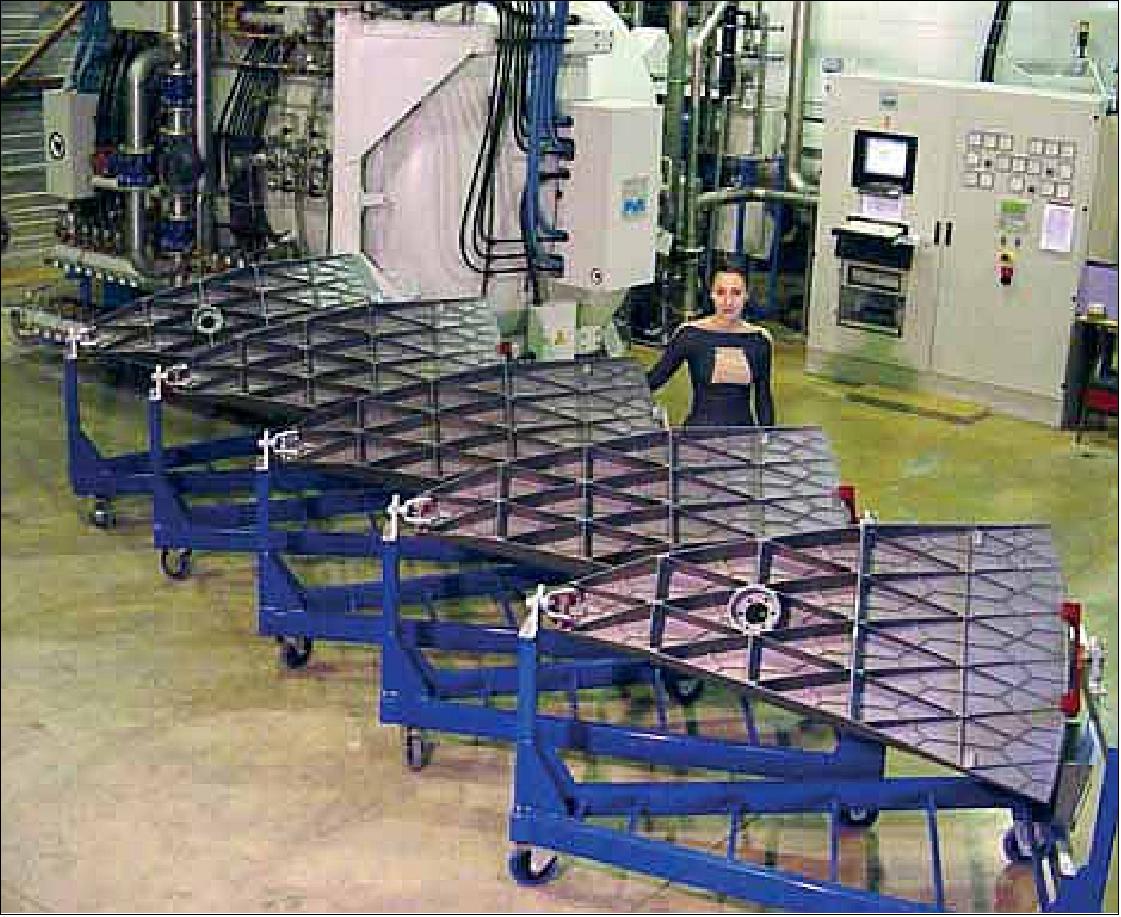
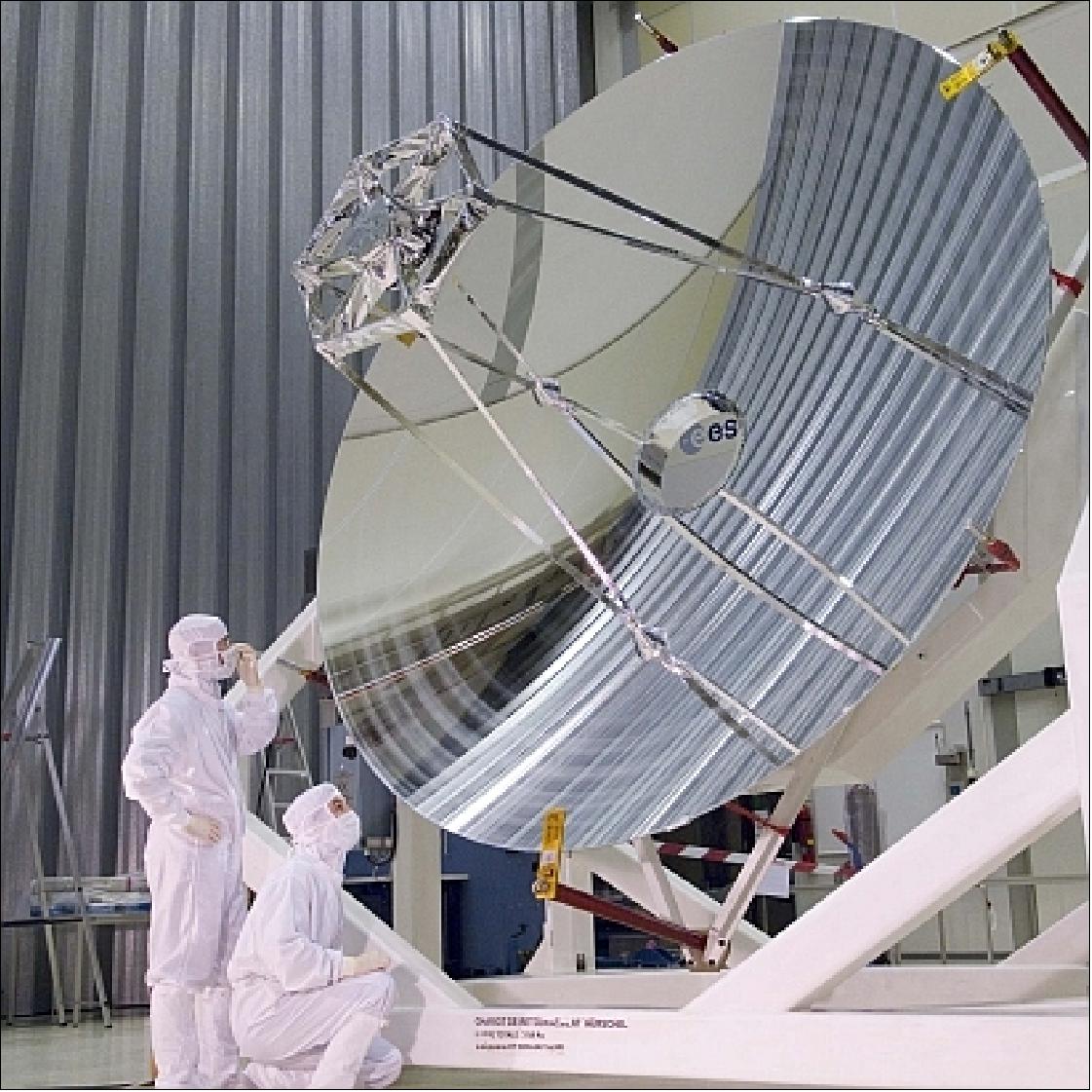
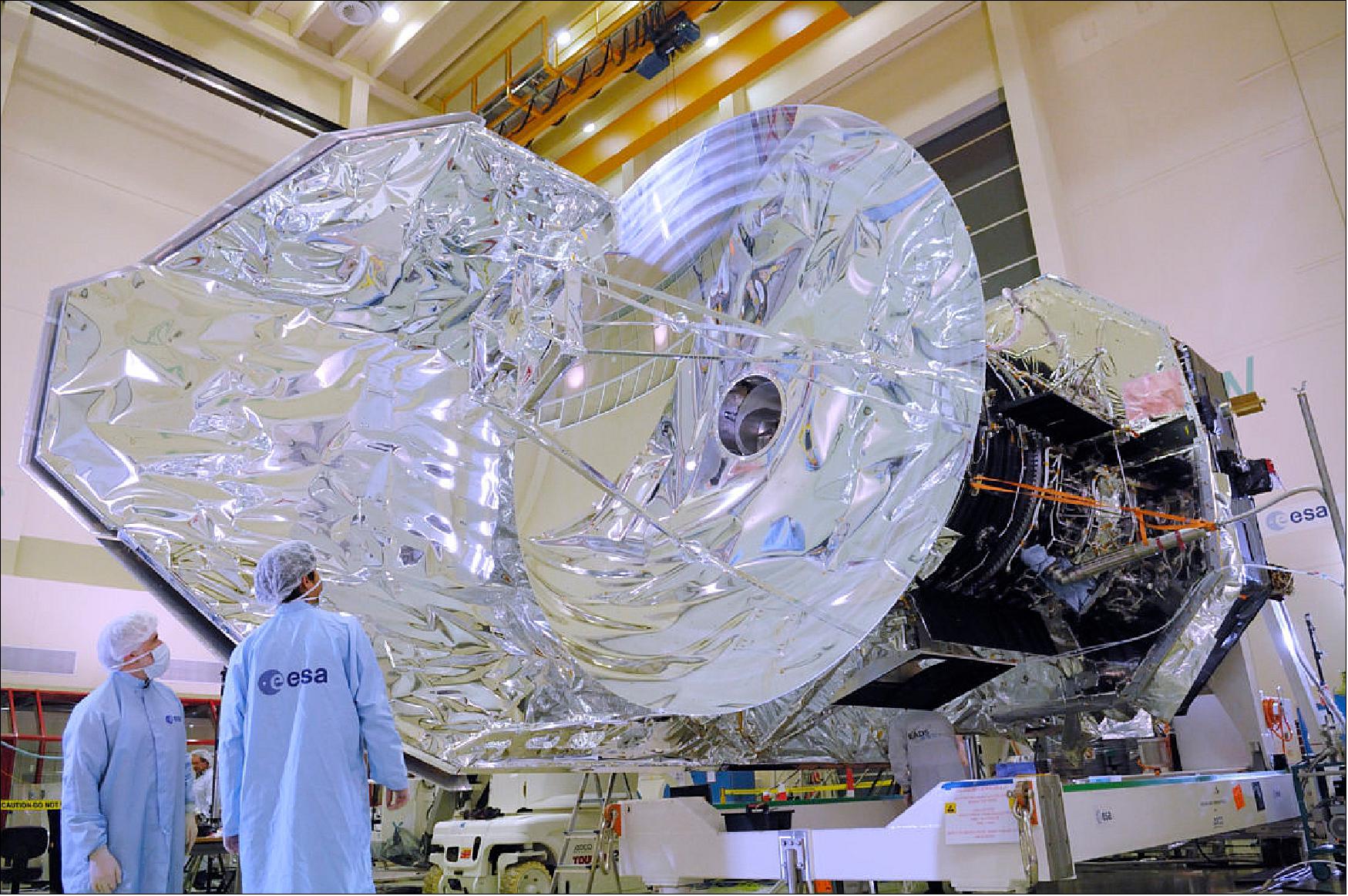
Launch
The Herschel spacecraft was launched in tandem with the Planck spacecraft of ESA on May 14, 2009. The launch site was Kourou and launch vehicle was Ariane-5 ECA.
Orbit: The two spacecraft separated after launch and were directly injected towards the second Lagrange point of the Sun-Earth system, L2. About 60 days after launch, Herschel will be injected into a large Lissajous orbit around the L2 point at a distance of around 1.5 million km from Earth, on Earth's nightside (Figure 11).
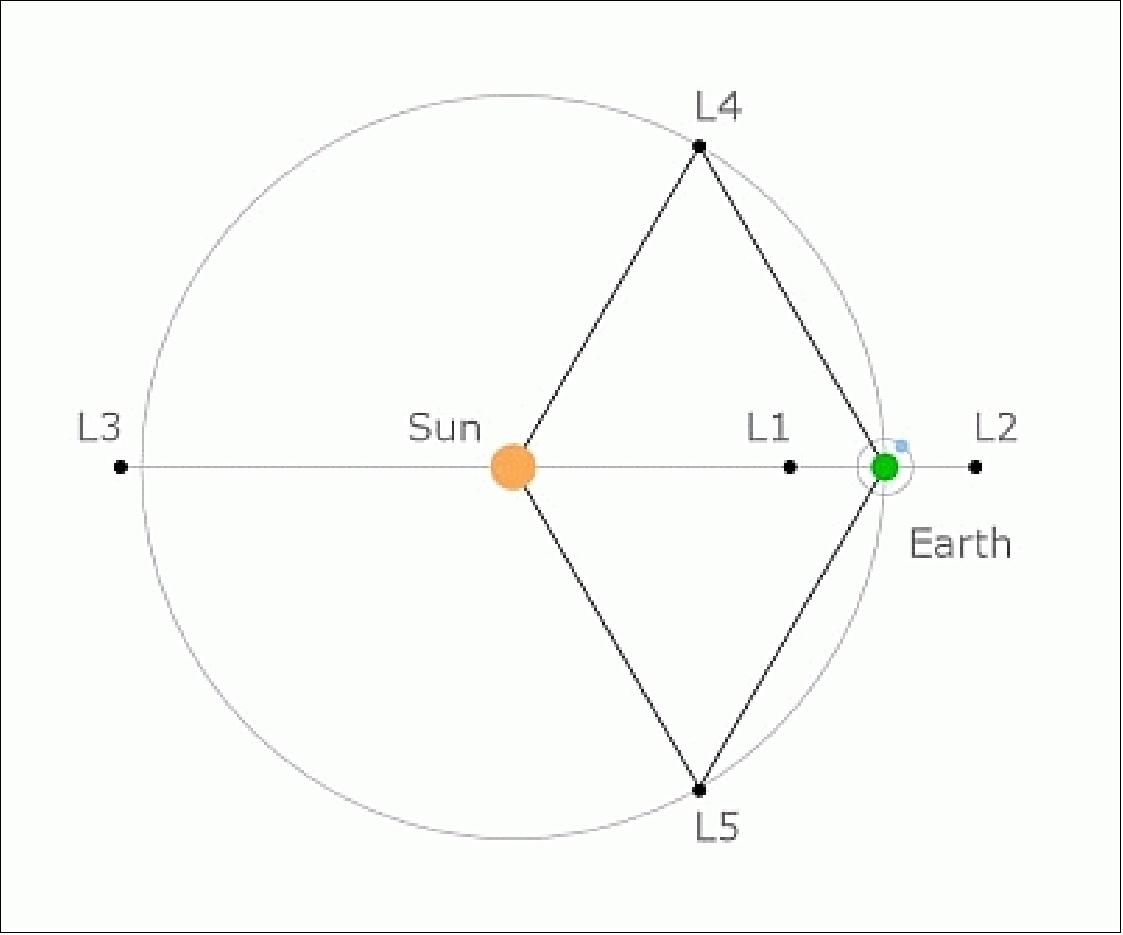
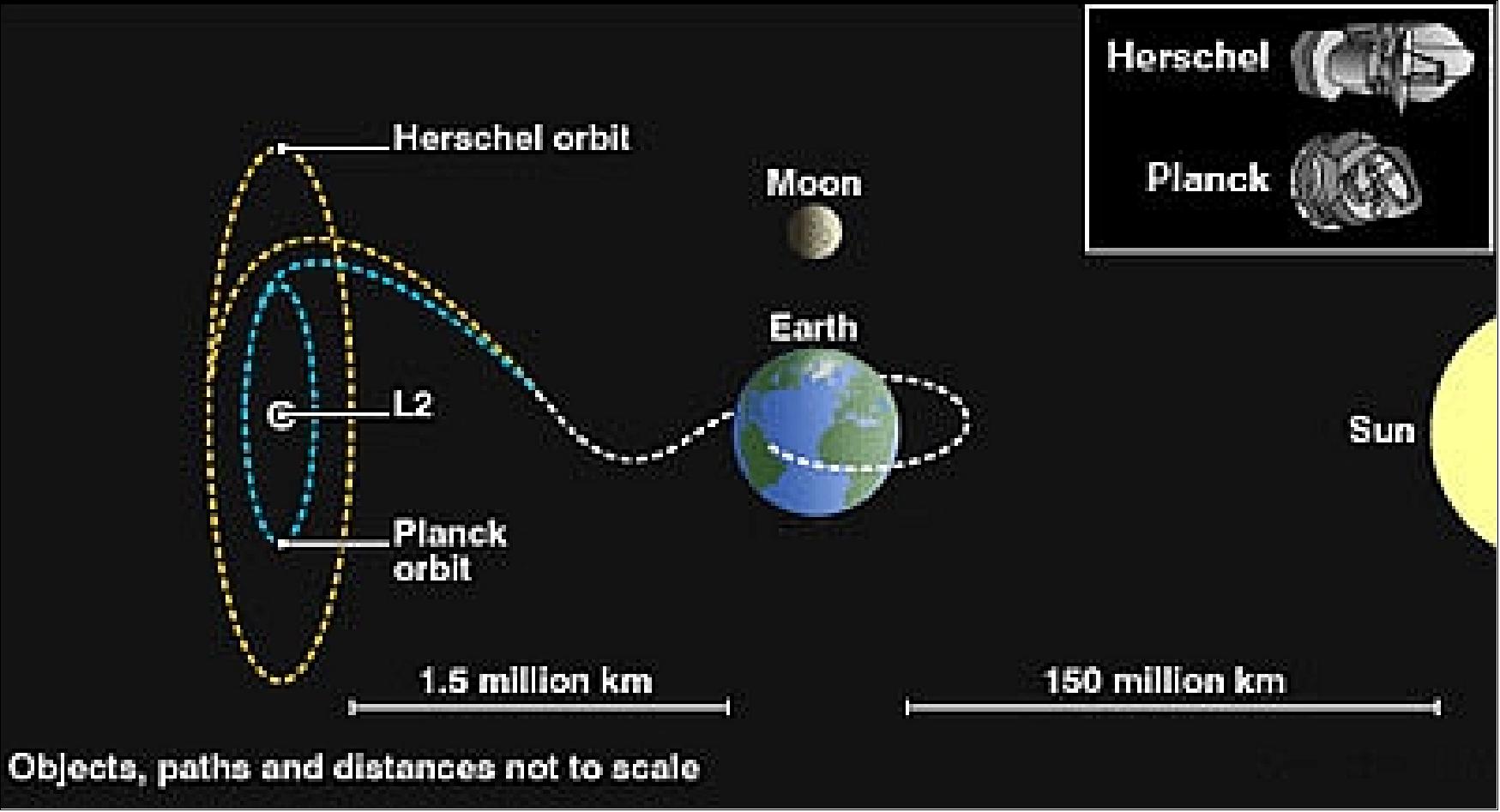
Lissajous orbits are the natural motion of a satellite around a collinear libration point in a two-body system and require less momentum change to be expended for station keeping than halo orbits, where the satellite follows a simple circular or elliptical path about the libration point.
The chosen orbit will take Herschel about 500 000 km above and below the plane of the ecliptic with a maximum azimuthal excursion of around 800 000 km to either side of L2. The Earth to spacecraft distance will vary from approximately 1.2 to 1.8 million km. No insertion maneuver is needed to achieve this orbit.
The L1 and L2 libration points of the Sun-Earth system offer the particular quality of providing stable thermal as well as illumination environments (solar aspect angle: 60-120º). Hence, the vicinity of L2 is considered as a very attractive region for solving astronomy problems with an unobstructed view into the universe. Spacecraft flown to either L1 or to L2 are generally considered to be in the class of “deep-space” missions.
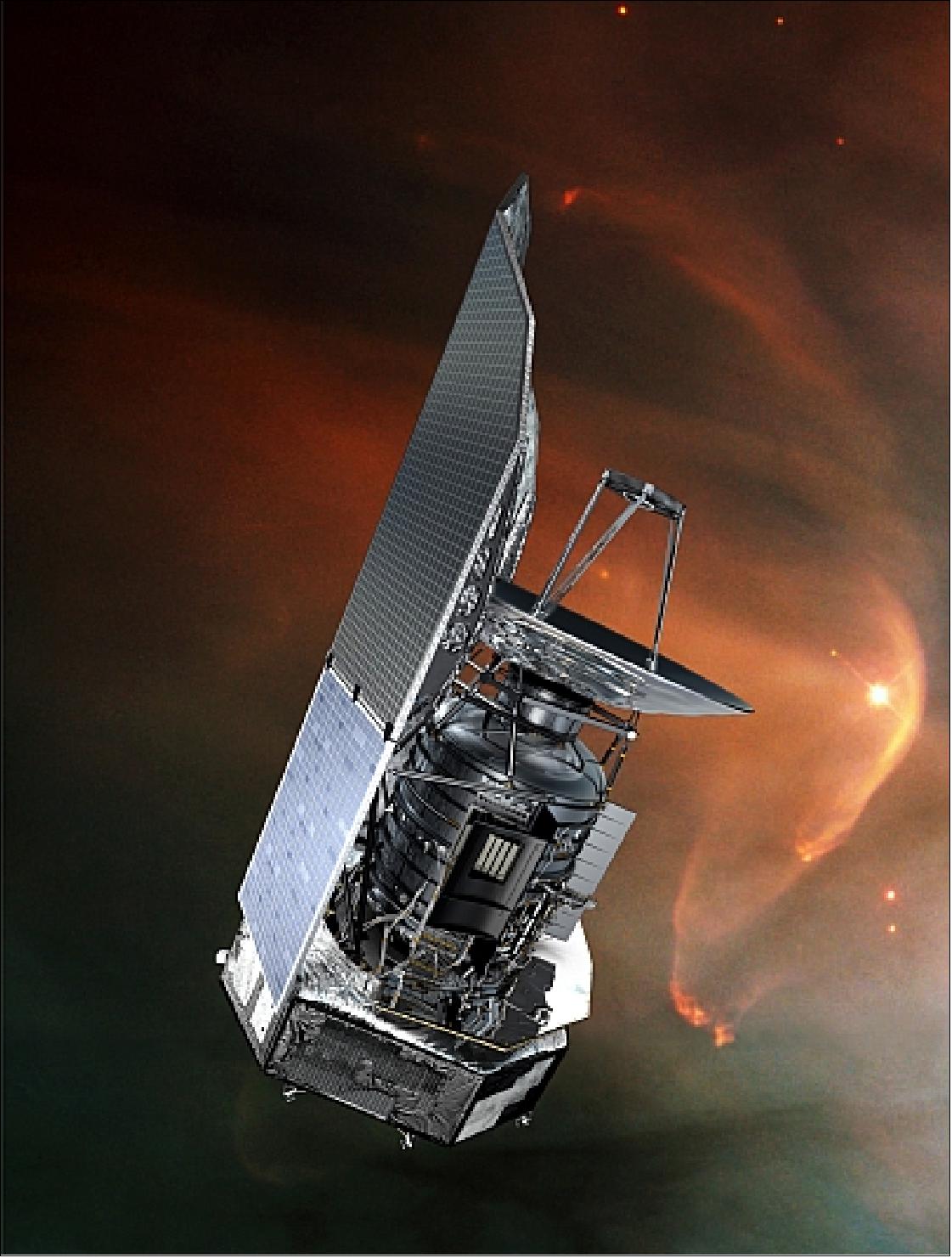
Mission Status
Note: Herschel was launched on 14 May 2009 and completed science observations on 29 April 201322)
• June 16, 2022: The stunning perspectives show four of our galactic neighbors in a different light. 22)
- New images using data from ESA (European Space Agency) and NASA missions showcase the dust that fills the space between stars in four of the galaxies closest to our own Milky Way. More than striking, the snapshots are also a scientific trove, lending insight into how dramatically the density of dust clouds can vary within a galaxy.
- With a consistency similar to smoke, dust is created by dying stars and is one of the materials that forms new stars. The dust clouds observed by space telescopes are constantly shaped and molded by exploding stars, stellar winds, and the effects of gravity. Almost half of all the starlight in the universe is absorbed by dust. Many of the heavy chemical elements essential to forming planets like Earth are locked up in dust grains in interstellar space. So understanding dust is an essential part of understanding our universe.
- The new observations were made possible through the work of ESA’s Herschel Space Observatory (HSO), which operated from 2009 to 2013. NASA’s Jet Propulsion Laboratory in Southern California contributed key parts of two instruments on the spacecraft. Herschel’s supercold instruments were able to detect the thermal glow of dust, which is emitted as far-infrared light, a range of wavelengths longer than what human eyes can detect.
- Herschel’s images of interstellar dust provide high-resolution views of fine details in these clouds, revealing intricate substructures. But the way the space telescope was designed meant that it often couldn’t detect light from more spread out and diffuse clouds, especially in the outer regions of galaxies, where the gas and dust become sparse and thus fainter.
- For some nearby galaxies, that meant Herschel missed up to 30% of all the light given off by dust. With such a significant gap, astronomers struggled to use the Herschel data to understand how dust and gas behaved in these environments. To fill out the Herschel dust maps, the new images combine data from three other missions: ESA’s retired Planck observatory, along with two retired NASA missions, the Infrared Astronomical Satellite (IRAS) and Cosmic Background Explorer (COBE).
- The images show the Andromeda galaxy, also known as M31; the Triangulum galaxy, or M33; and the Large and Small Magellanic Clouds – dwarf galaxies orbiting the Milky Way that do not have the spiral structure of the Andromeda and Triangulum galaxies. All four are within 3 million light-years of Earth.
![Figure 14: The Large Magellanic Cloud (LMC) is a satellite of the Milky Way, containing about 30 billion stars. Seen here in a far-infrared and radio view, the LMC’s cool and warm dust are shown in green and blue, respectively, with hydrogen gas in red [image credit: ESA/NASA/JPL-Caltech/CSIRO/C. Clark (STScI)]](https://www.eoportal.org/ftp/satellite-missions/h/HSO_170622/HSO_Auto64.jpeg)
- In the images, red indicates hydrogen gas, the most common element in the universe. This data was collected using multiple radio telescopes located around the globe. The image of the Large Magellanic Cloud shows a red tail coming off the bottom left of the galaxy that was likely created when it collided with the Small Magellanic Cloud about 100 million years ago. Bubbles of empty space indicate regions where stars have recently formed, because intense winds from the newborn stars blow away the surrounding dust and gas. The green light around the edges of those bubbles indicates the presence of cold dust that has piled up as a result of those winds. Warmer dust, shown in blue, indicates where stars are forming or other processes have heated the dust.
- Many heavy elements in nature – including carbon, oxygen, and iron – can get stuck to dust grains, and the presence of different elements changes the way dust absorbs starlight. This, in turn, affects the view astronomers get of events like star formation.
- In the densest dust clouds, almost all the heavy elements can get locked up in dust grains, which increases the dust-to-gas ratio. But in less dense regions, the destructive radiation from newborn stars or shockwaves from exploding stars will smash the dust grains and return some of those locked-up heavy elements back into the gas, changing the ratio once again. Scientists who study interstellar space and star formation want to better understand this ongoing cycle. The Herschel images show that the dust-to-gas ratio can vary within a single galaxy by up to a factor of 20, far more than previously estimated.
![Figure 15: The Andromeda galaxy, or M31, is shown here in far-infrared and radio wavelengths of light. Some of the hydrogen gas (red) that traces the edge of Andromeda’s disc was pulled in from intergalactic space, and some was torn away from galaxies that merged with Andromeda far in the past [image credit: ESA/NASA/JPL-Caltech/GBT/WSRT/IRAM/C. Clark (STScI)]](https://www.eoportal.org/ftp/satellite-missions/h/HSO_170622/HSO_Auto63.jpeg)
![Figure 16: The Small Magellanic Cloud is a satellite of the Milky Way, containing about 3 billion stars. This far-infrared and radio view of it shows the cool (green) and warm (blue) dust, as well as the hydrogen gas (red) [image credit: ESA/NASA/JPL-Caltech/CSIRO/NANTEN2/C. Clark (STScI)]](https://www.eoportal.org/ftp/satellite-missions/h/HSO_170622/HSO_Auto62.jpeg)
![Figure 17: The Triangulum galaxy, or M33, is shown here in far-infrared and radio wavelengths of light. Some of the hydrogen gas (red) that traces the edge of the Triangulum’s disc was pulled in from intergalactic space, and some was torn away from galaxies that... [image credit: ESA/NASA/JPL-Caltech/GBT/VLA/IRAM/C. Clark (STScI)]](https://www.eoportal.org/ftp/satellite-missions/h/HSO_170622/HSO_Auto61.jpeg)
- “These improved Herschel images show us that the dust ‘ecosystems’ in these galaxies are very dynamic,” said Christopher Clark, an astronomer at the Space Science Telescope Institute in Maryland, who led the work to create the new images.
More About the Missions
- NASA’s Herschel Project Office was based at JPL. The NASA Herschel Science Center was based at IPAC at Caltech in Pasadena, California. Caltech manages JPL for NASA.
- Launched in 1983, NASA’s IRAS was the first space telescope to detect infrared light, setting the stage for future observatories like the agency’s Spitzer Space Telescope and James Webb Space Telescope. IRAS was a joint project of NASA, the Netherlands Agency for Aerospace Programmes, and the United Kingdom's Science and Engineering Research Council. JPL and NASA’s Ames Research Center managed the telescope development. IPAC provided expertise and support for the processing and analysis of data from IRAS, and NASA’s Infrared Science Archive (IRSA) at IPAC manages the IRAS archive.
- The Planck observatory, launched in 2009, and COBE, launched in 1989, both studied the cosmic microwave background, or light left over from the big bang. The COBE satellite was developed by NASA’s Goddard Space Flight Center. NASA’s Planck Project Office was based at JPL, which also contributed mission-enabling technology for both of Planck’s science instruments. European, Canadian, and U.S. Planck scientists work together to analyze the Planck data. IPAC serves as the U.S. Planck Data Center, hosted at IRSA.
• July 5, 2020: A collection of intriguing images based on data from ESA’s Herschel and Planck space telescopes show the influence of magnetic fields on the clouds of gas and dust where stars are forming. 23)
- The images are part of a study by astronomer Juan D. Soler of the Max Planck Institute for Astronomy in Heidelberg, Germany, who used data gathered during Planck’s all-sky observations and Herschel’s ‘Gould Belt Survey’. Both Herschel and Planck were instrumental in exploring the cool Universe, and shed light on the many complexities of the interstellar medium – the mix of gas and dust that fills the space between the stars in a galaxy. Both telescopes ended their operational lifetime in 2013, but new discoveries continue to be made from their treasure trove of data.
- Herschel revealed in unprecedented detail the filaments of dense material in molecular clouds across our Milky Way galaxy, and their key role in the process of star formation. Filaments can fragment into clumps which eventually collapse into stars. The results from Herschel show a close link between filament structure and the presence of dense clumps.
- Herschel observed the sky in far-infrared and sub-millimeter wavelengths, and the data is seen in these images as a mixture of different colors, with light emitted by interstellar dust grains mixed within the gas. The texture of faint grey bands stretching across the images like a drapery pattern, is based on Planck’s measurements of the direction of the polarized light emitted by the dust and show the orientation of the magnetic field.
- The study explored several nearby molecular clouds all within 1500 light years from the Sun including Taurus, Ophiuchus, Lupus, Corona Australis, Chamaeleon-Musca, Aquila Rift, Perseus, and Orion.
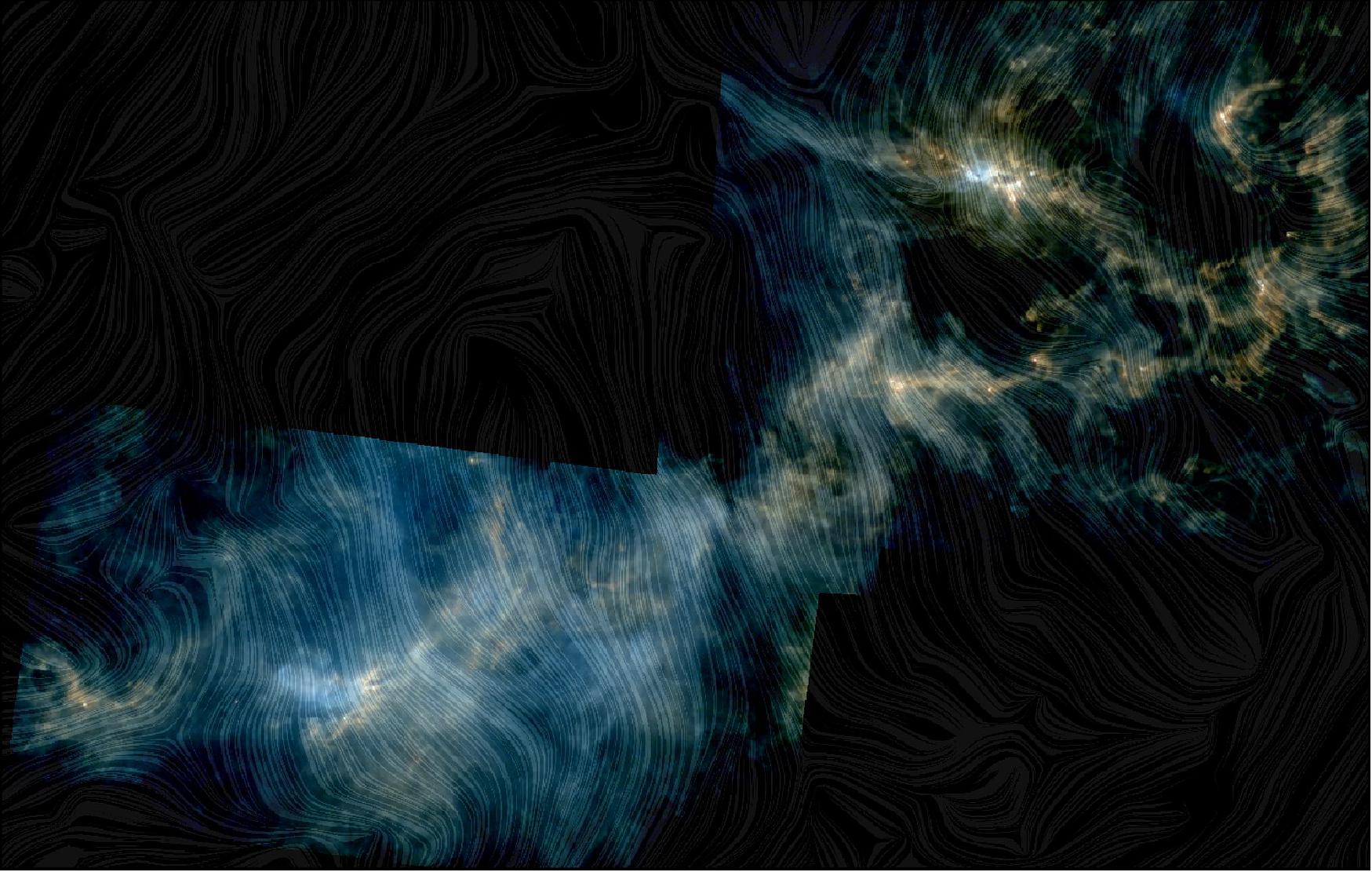
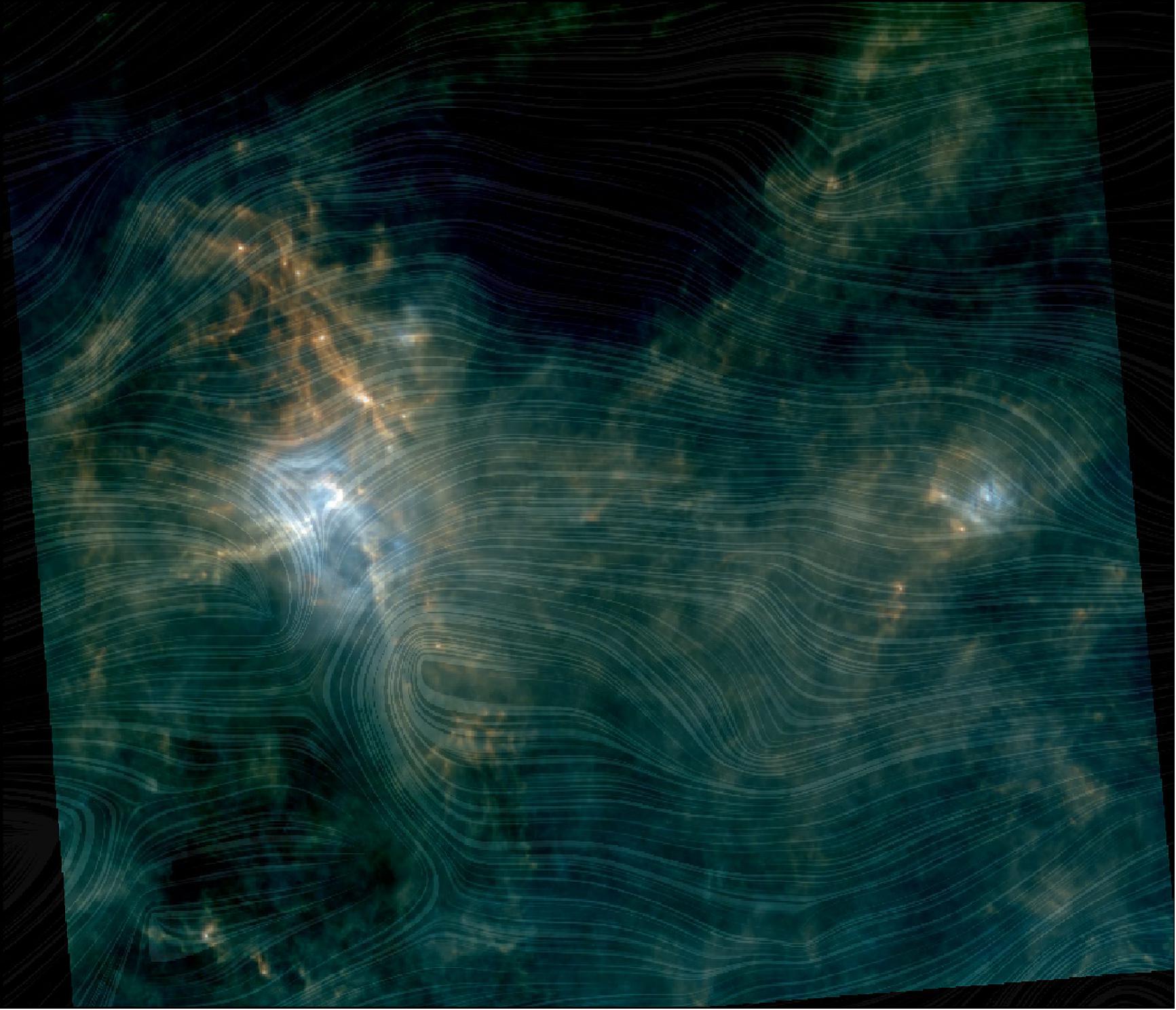
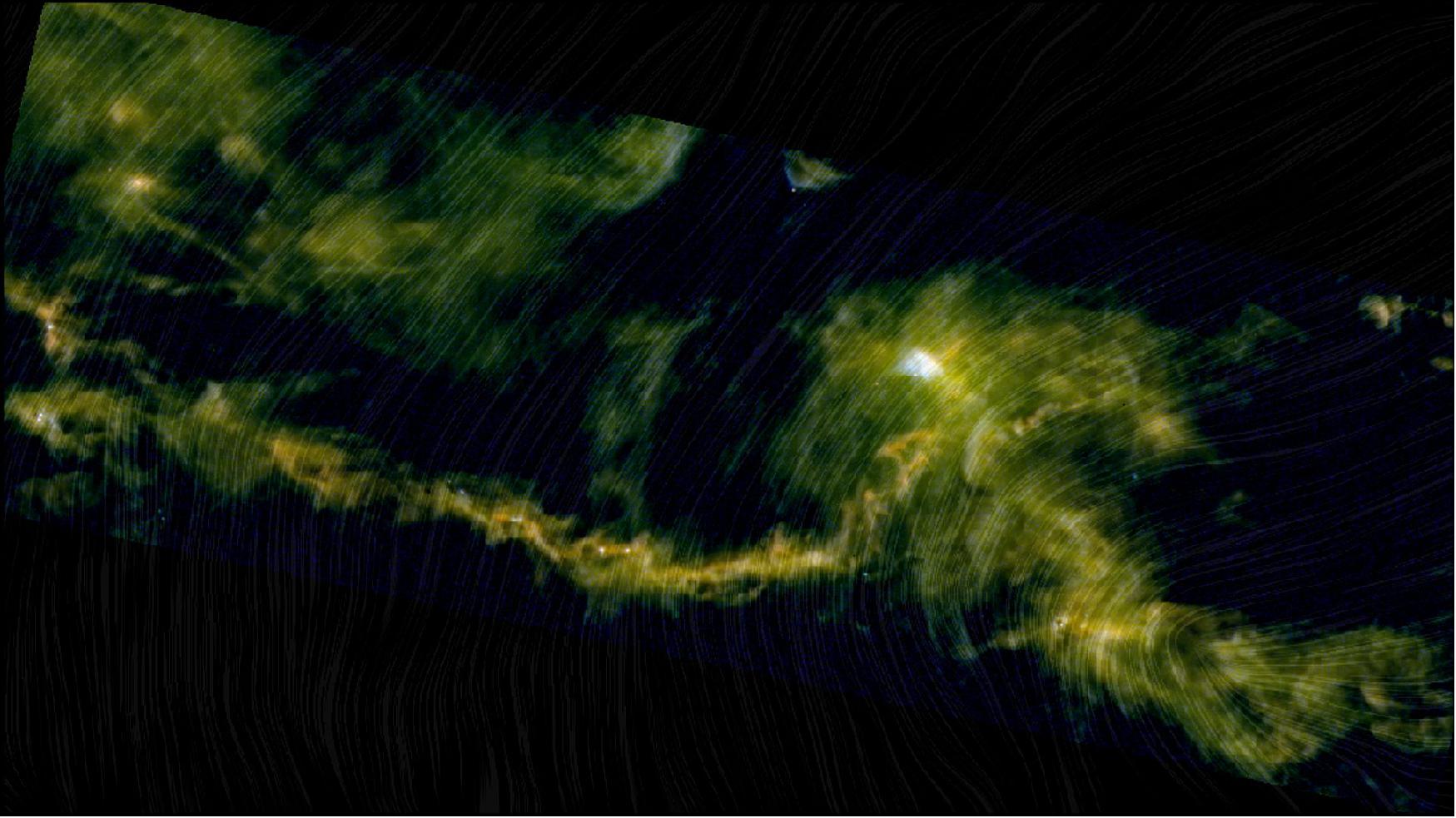
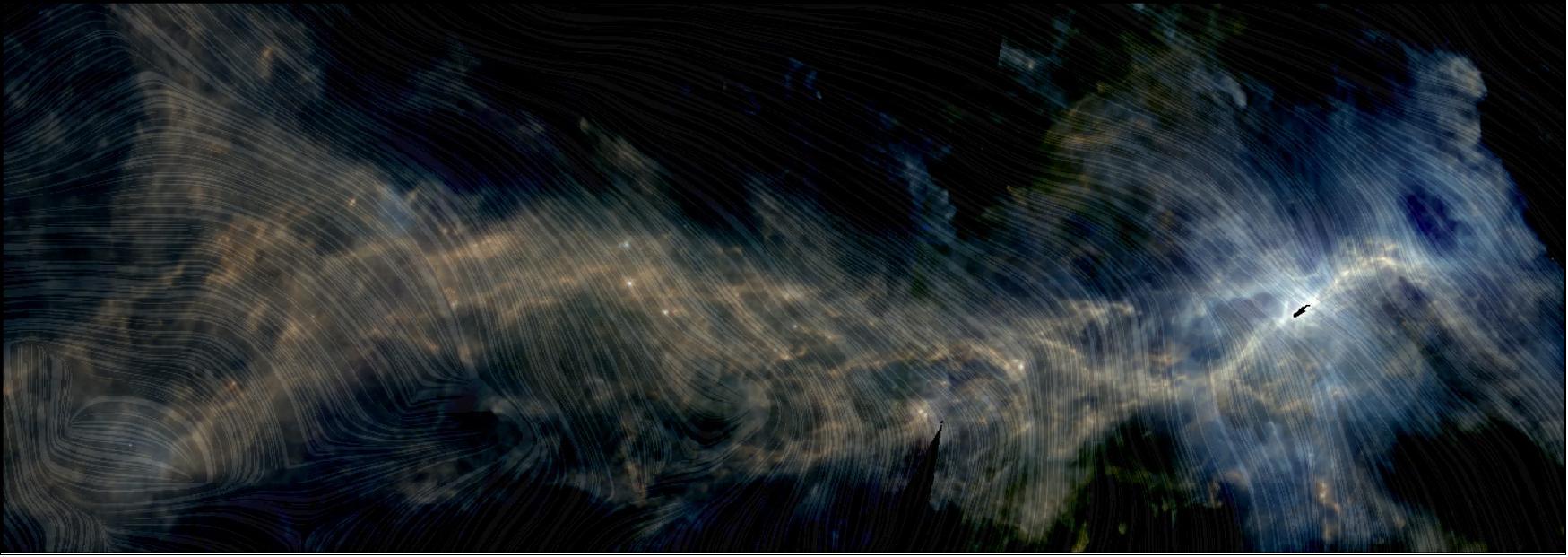
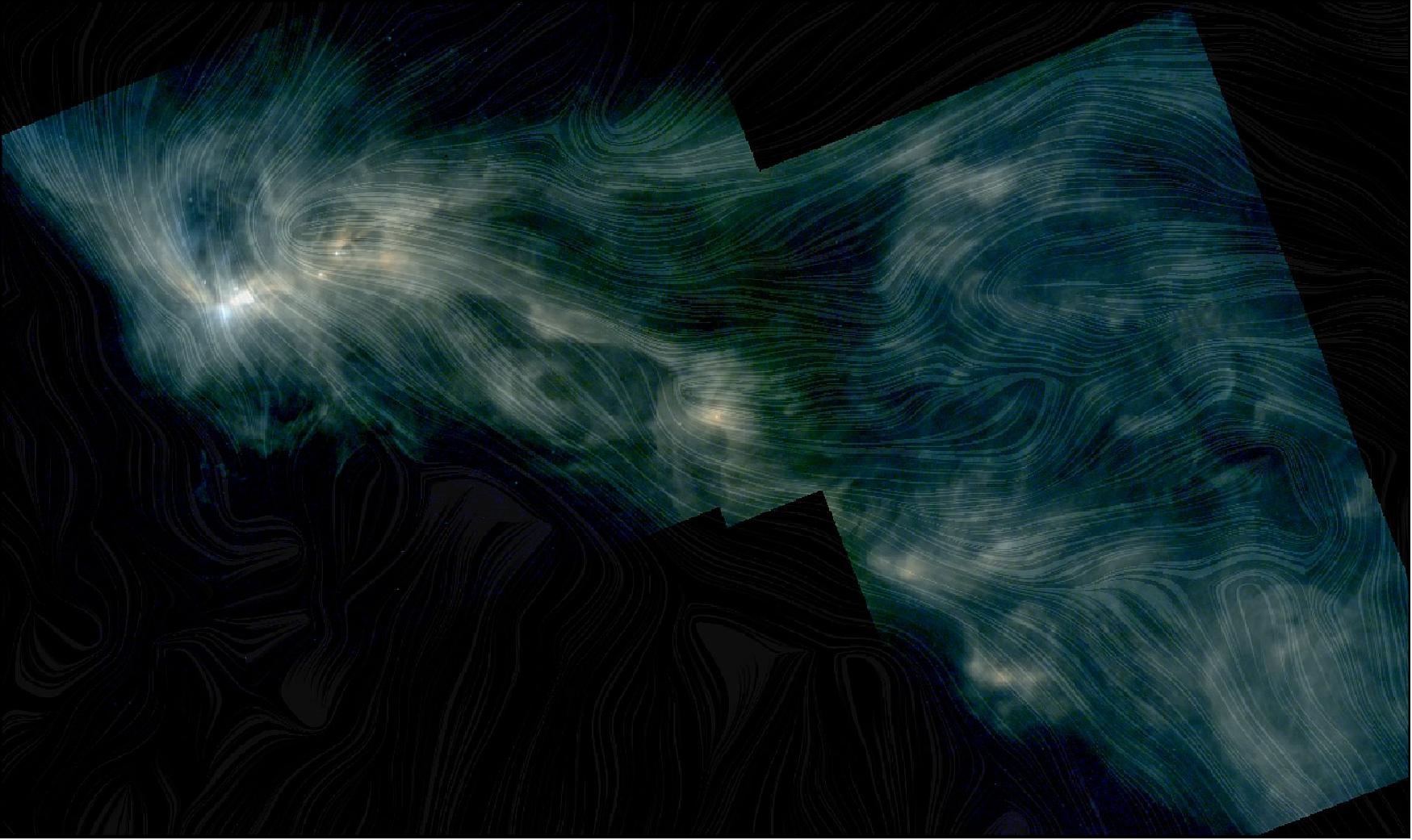
- In this study, published last year in Astronomy & Astrophysics, the Herschel data were used to calculate the density of the molecular clouds along our line of sight to investigate how the interstellar medium interacts with surrounding magnetic fields. 24)
- Astronomers have long thought magnetic fields play a role in star formation, along with other factors such as gas pressure, turbulence, and gravity. However, observations of the magnetic fields in and around nearby star-forming clouds have been limited until the advent of Planck.
- The paper builds upon previous studies by the Planck collaboration to investigate how interstellar matter is likely coupled to these magnetic field lines, moving along them until multiple ‘conveyor belts’ of matter converge to form an area of high density. This can be seen in some images in the form of ‘striations’, which is material that appears perpendicular to the filament. These regions continue to receive matter along the magnetic lines until they collapse under their own gravity, becoming cooler and dense enough to create stellar newborns.
- While the magnetic field is preferentially orientated perpendicular to the densest filaments, it appears that the orientation of the magnetic field changes from parallel to perpendicular with increasing density. However, there appears to be no correlation between the star formation rate and the orientation between filaments and magnetic fields, although the study also finds a correlation between the distribution of projected densities.
• May 28, 2020: Today, 13.8 billion years after the Big Bang, most galaxies are kept together by gravity into groups or larger clusters, but how and when exactly these cosmic structures first started to form is still an open question. Looking far back in time, astronomers observed collections of galaxies that they believe could be bound together by gravity. If they are right, this image could be showing us the birth of over 200 future galaxy clusters, at a time when the Universe was only three billion years old. 25)
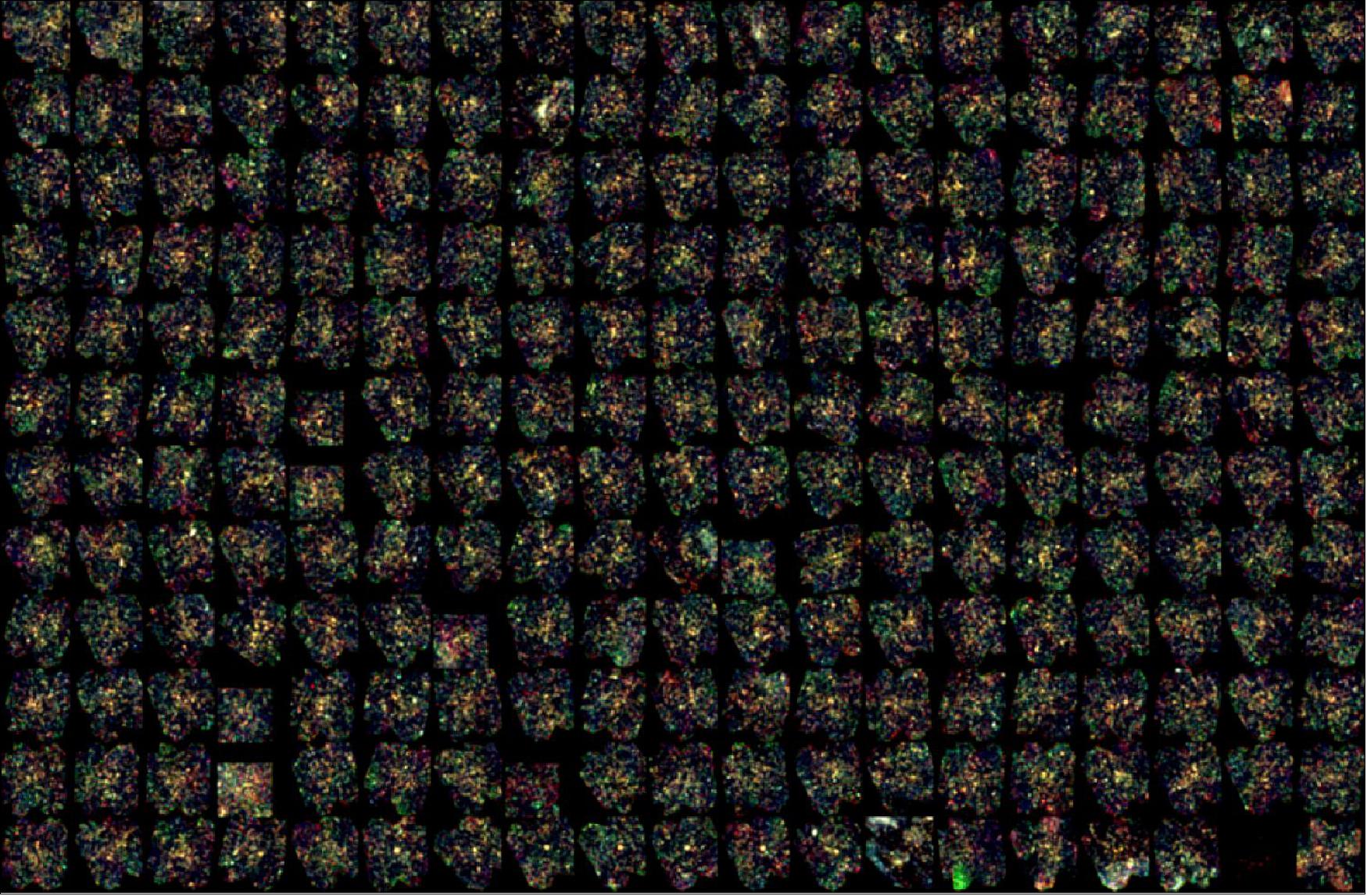
- This science feat was possible by combining the powers of Planck and Herschel, two ESA space telescopes that were launched together on an Ariane 5 rocket eleven years ago, on 14 May 2009.
- The Planck mission spent more than four years scanning the sky to collect and study the remnant radiation left over after the Big Bang, the cosmic microwave background. The Herschel space observatory, which also operated until 2013, performed detailed observations of a multitude of regions across the sky from the far infrared to the submillimeter part of the electromagnetic spectrum.
- This image is part of a study published in 2015, in which a team of astronomers used Planck data to identify more than 2000 rare and very distant sources shining brightly in submillimeter wavelengths. One tenth of these sources were then observed using the SPIRE instrument on Herschel at three different wavelengths – 250, 350 and 500 µm – and combined with existing similar observations.
- Unleashing the powers of Herschel, the team was able to ‘zoom in’ into the 228 most promising sources spotted with Planck to find clues about their nature. The evidence pointed to the vast majority of them being infant clusters of galaxies. The Herschel observations revealed in particular that the galaxies were forming stars at an astonishing rate – about 700 solar-mass stars per year, roughly 700 times more intensely than our Milky Way does today.
- A few years later, astronomers used NASA’s Spitzer Space Telescope, which completed its mission earlier this year, to scrutinize 82 of the previously spotted candidates in detail at near-infrared wavelengths. The new data showed without ambiguity that most of these objects consist of far-away galaxies in large concentrations. But some mysteries remain: what is the origin of such a prolific star-formation activity? Are these structures real proto-clusters? These questions will keep astronomers busy for a while.
• November 18, 2019: Stars form within giant clouds of gas and dust that pervade galaxies like our own Milky Way. This image depicts one such cloud, known as Orion A, as seen by ESA’s Herschel and Planck space observatories. 26)
- At 1350 light years away, Orion A is the nearest heavyweight stellar nursery to us. The cloud is packed full of gas – it contains so much material, in fact, that it would be capable of producing tens of thousands of Suns. Along with its sibling, Orion B, the cloud makes up the Orion Molecular Cloud Complex, a vast star-forming region within the constellation of Orion, which is most prominent in the night sky during northern hemisphere winter and southern hemisphere summer.
- As evident from images like this, the space that sits between stars is not empty but is instead filled with a cool substance known as the interstellar medium (ISM) – a mix of gas and dust that often clumps together. When these clumps become dense enough they start to collapse under their own gravity and become hotter and hotter and denser and denser until they spark something exciting: the creation of new stars.
![Figure 24: The data comprising this image were gathered during Planck’s all-sky observations and Herschel’s ‘Gould Belt Survey’. Operational until 2013, both Herschel and Planck were instrumental in exploring the cool and the distant Universe, shedding light on many cosmic phenomena, from the formation of stars in our Milky Way galaxy to the expansion history of the entire Universe [image credit: ESA/Herschel/Planck J. D. Soler, Max Planck Institute for Astronomy (Heidelberg, Germany)]](https://www.eoportal.org/ftp/satellite-missions/h/HSO_170622/HSO_Auto5A.jpeg)
- Magnetism is an important component of the ISM. Magnetic fields permeate the Universe, and are involved in helping clouds of matter maintain the delicate balance between pressure and gravity that eventually lead to the birth of stars. The mechanisms that oppose the gravitational collapse of star-forming clouds remain somewhat unclear, but a recent study suggests that interstellar magnetic fields play a significant role in guiding the flows of matter in the ISM, and may be a key player in preventing inter-stellar cloud collapse.
- The study finds that matter within the ISM is coupled to the surrounding magnetic field and can only move along its lines, creating a sort of ‘conveyor belts’ of field-aligned matter, as expected from the effect of electromagnetic forces. When these interact with an external source of energy – such as an exploding star, or other material moving through the galaxy – these flows along the magnetic field lines converge. The process creates a compressed pocket of higher density that appears to be perpendicular to the field itself. As more and more matter streams inwards, this region becomes increasingly dense, until it eventually reaches the critical density for gravitational collapse and crumples in on itself, leading to the formation of stars.
• January 7, 2019: New Year’s Eve may be past, but we are not done with fireworks just yet. This image, which includes data from ESA’s Herschel Space Observatory, shows the remnants of an explosion – not of the colorful type ignited during celebrations, but of the stellar kind. 27)
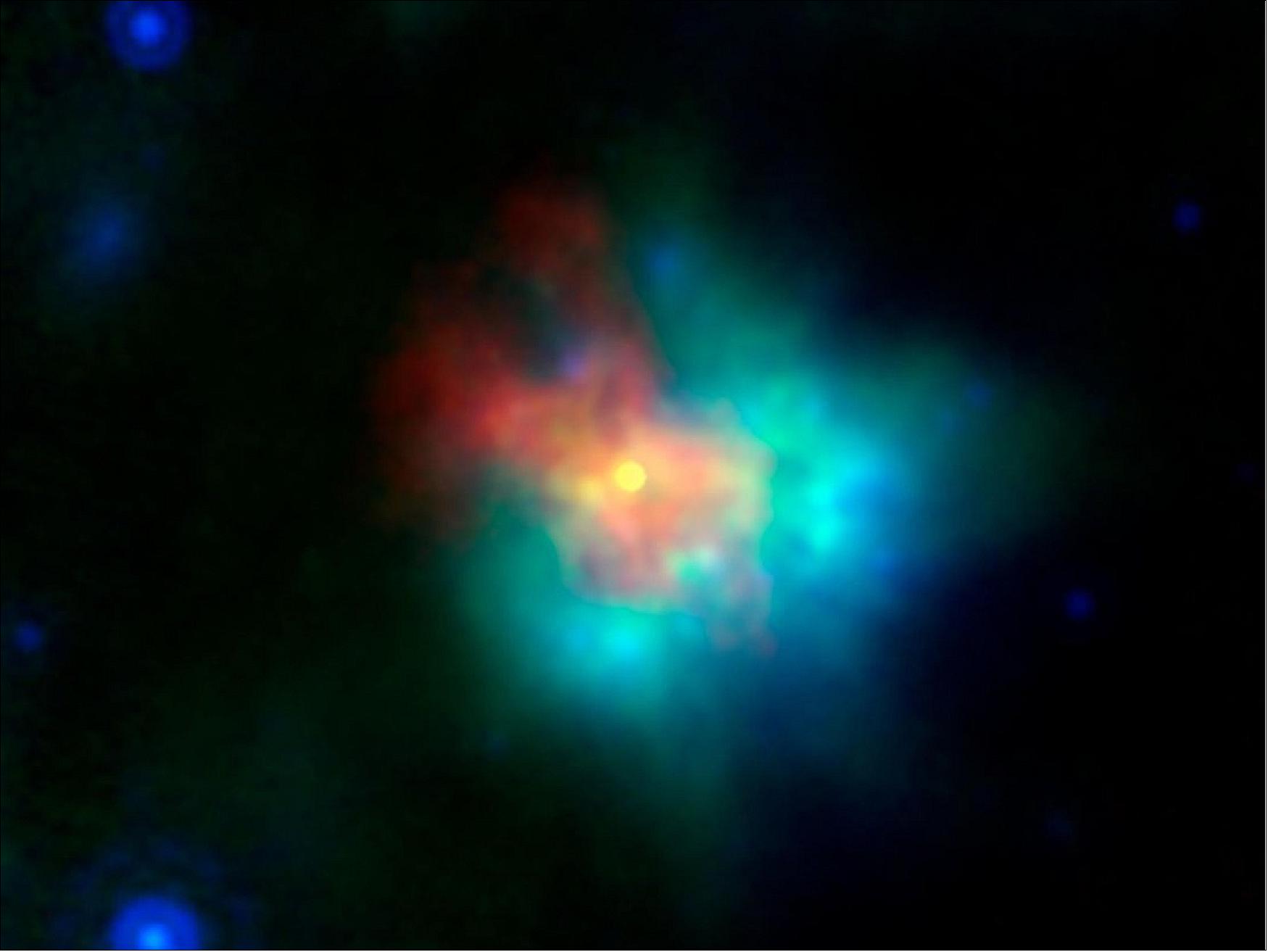
- The object in the image, dubbed G54.1+0.3, is a supernova remnant, the leftovers of a massive star that died a violent death. It is located about 20,000 light-years away from us, in the northern constellation of Sagitta, the arrow.
- As the star ran out of fuel, it shed its outer layers in a powerful explosion while its core collapsed due to gravity, eventually forming an extremely dense neutron star. The remnant of this particular explosion is a pulsar, a fast-rotating neutron star that shines brightly in the radio and X-ray parts of the electromagnetic spectrum.
- Besides the stellar remnant, the dust and gas in the surrounding envelope are also quite remarkable. According to a recent study by J. Rho and collaborators, these layers contain silica – also known as silicon dioxide, or SiO2 – a major component of many types of rocks on Earth, making up about 60 percent of our planet’s crust. The study is the first to show that this key ingredient of everyday materials like glass and sand can be formed in supernova explosions.
- The image of Figure 25 combines infrared and X-ray data collected by three space observatories and radio observations obtained from the ground.
- The data from Herschel, shown in green hues in this view and corresponding to the far-infrared wavelength of 70 µm, played a key part in helping astronomers detect silica in the dusty envelope of this supernova remnant, along with mid-infrared observations from NASA’s Spitzer Space Telescope, corresponding to 24 µm and shown in blue.
- The radio data, obtained with the Karl G. Jansky Very Large Array in New Mexico, USA, are shown in red, while yellow hues show the X-ray data from NASA’s Chandra X-ray Observatory.
- Operating between 2009 and 2013, Herschel left a legacy of treasured data that are still producing a multitude of scientific results every year. The study of supernova remnant G54.1+0.3 is based on archival data from one of the observatory’s key programs, the Herschel infrared Galactic Plane Survey (Hi-GAL).
• September 24, 2018: An odd-shaped formation of gas and dust at the center of the Milky Way, captured by the far-infrared cameras on board ESA’s Herschel Space Observatory. The nearly continuous strip of dense and cold clumps of material forms an infinity symbol, or sideways figure 8, that is a few hundred light years across. In this image, the strip twists around an invisible axis running roughly from the top left to the bottom right. 28)
- The infinity-shaped loop, estimated to have a whopping 30 million solar masses, is made up of dense gas and dust at a temperature of just 15 degrees above absolute zero. Displayed in yellow in the image of Figure 26, it contrasts with warmer, less dense gas and dust from the center of the Galaxy that appears inside the strip and is colored in blue. Surrounding the loop is cool gas, painted in red-brownish tones.
- The ring and its surroundings harbor a number of star-forming regions and young stars, which stand out in bright-blue color in the image. The area is part of the Central Molecular Zone, a region at the center of the Milky Way permeated with molecular clouds, which are ideal sites for star formation.
- The Galactic Center is located almost 30,000 light years away from the Sun, in the direction of the Sagittarius constellation. It is a complex and dynamic place, with emission nebulae and supernova remnants – in addition to star-forming molecular clouds – surrounding the supermassive black hole that sits at our Galaxy’s core. The gas and dust in this region appears mostly dark when viewed through an optical telescope, but it can be seen clearly with Herschel’s instruments.
- This image was captured by the Herschel’s PACS (Photodetector Array Camera and Spectrometer) and SPIRE (Spectral and Photometric Imaging REceiver) far-infrared cameras, and it was first published in 2011. Obtained as part of Hi-GAL, the Herschel infrared Galactic Plane Survey, it combines observations at three different wavelengths: 70 µm (blue), 160 µm (green) and 250 µm (red).
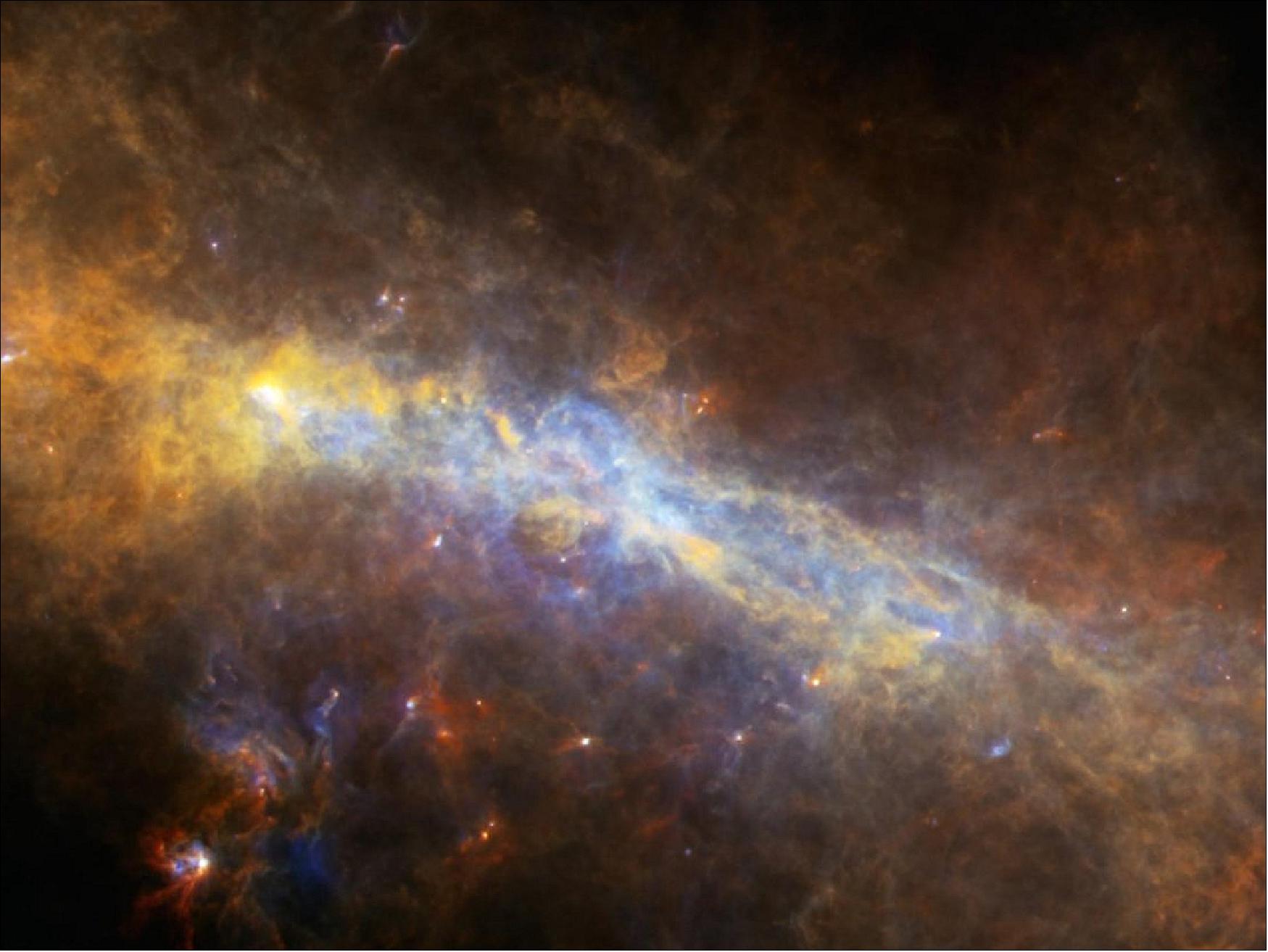
• July 16, 2018: At first glance this frame is flooded with salt-and-pepper static – but don’t adjust your set! Rather than being tiny grains or pixels of TV noise, every single point of light in this image is actually a distant galaxy as observed by ESA’s Herschel Space Observatory(Figure 27). Each of these minute marks represents the ‘heat’ emanating from dust grains lying between the stars of each galaxy. This radiation has taken many billions of years to reach us, and in most cases was emitted well before the Solar System and the Earth had even formed. 29)
- This frame shows a map of the North Galactic Pole as imaged by Herschel’s Spectral and Photometric Imaging Receiver, SPIRE. As on Earth, astronomers define locations on a cosmic scale using a coordinate system. For the Milky Way galaxy, this coordinate system is spherical with the Sun at its center, and provides values for longitude and latitude on the sky with respect to our Galaxy.
- The North Galactic Pole lies far from the cluttered disc of the Milky Way, and offers a clean, clear view of the distant Universe beyond our home galaxy. In the sky, it is located somewhere in the northern constellation of Coma Berenices (Berenice’s Hair), a region that also contains an especially rich galaxy cluster known as the Coma Cluster. Serendipitously, the Coma Cluster is included in this map, adding over 1000 points of light to the tally of individual galaxies.
- Herschel was active from 2009 to 2013, and used its instruments to study the sky in the far infrared. SPIRE was particularly well-suited to mapping large areas of sky, and observed the North Galactic Pole in three different filters simultaneously – such observations can be used to produce multicolored images.
- The image shown is a single-filter map obtained at a wavelength of 250 µm as part of the Herschel Astrophysical Terahertz Large Area Survey (H-ATLAS), and covers some 180.1º x 180.1º of sky. This used both SPIRE and another Herschel instrument, the Photodetector Array Camera and Spectrometer (PACS), to survey some 660º x 660º of sky in five wavelength bands and produce the largest far infrared surveys ever made of the sky lying outside our galaxy.
- The North Galactic Pole imaged by PACS.
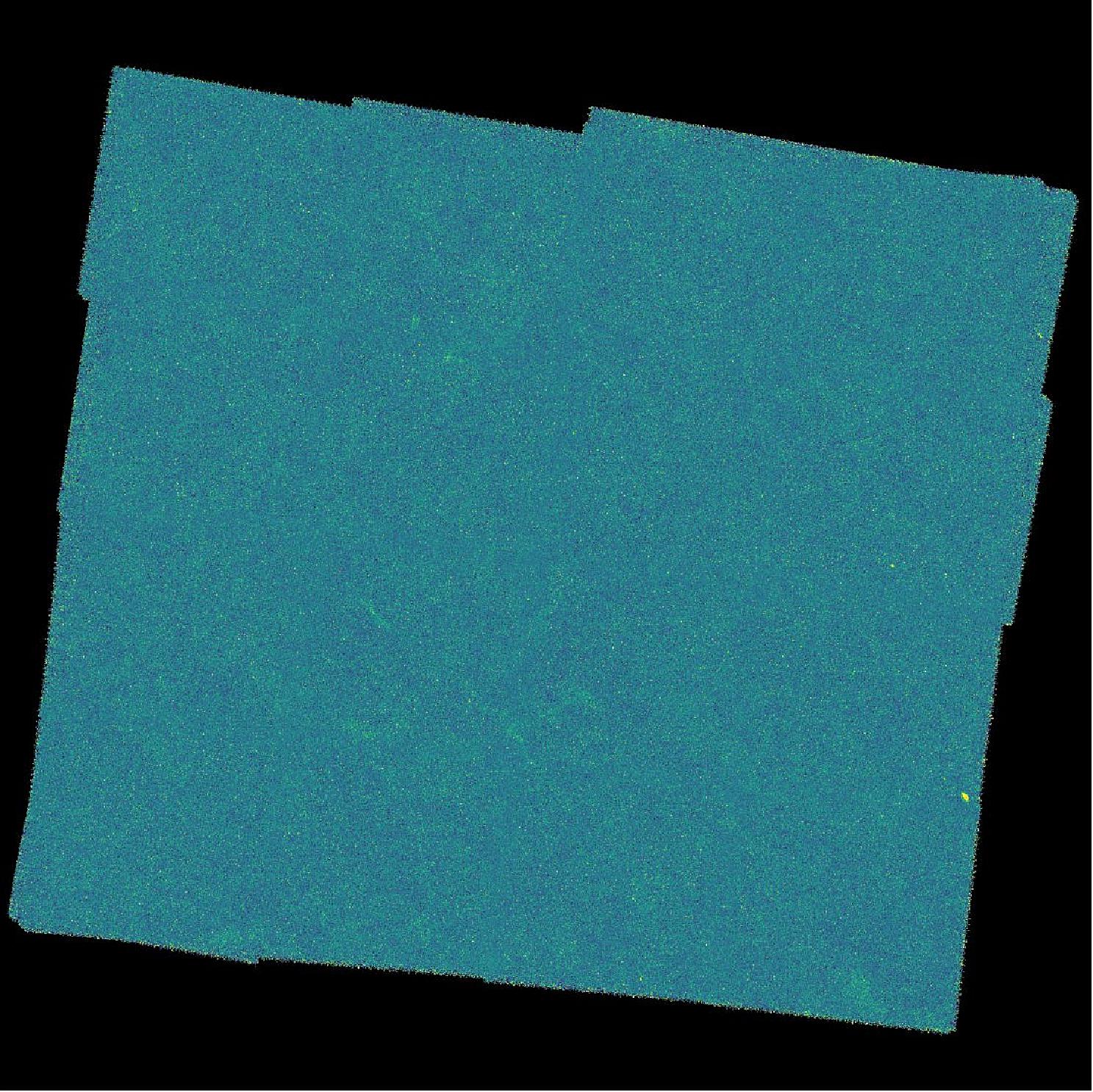
• May 21, 2018: Stellar nurseries are cloudy and dusty places that shine brightly in infrared light. The G305 star-forming complex is no exception. It features a number of bright, intricate gas clouds heated by infant stars in their midst. In this spectacular image by ESA’s Herschel space observatory, these star-forming hotspots stand out in a blue tone that contrasts with the red-brownish color of cooler regions. 30)
- While there are several star-formation sites dotted throughout this scene (Figure 28), the most striking ones surround the dark, heart-shaped area in the top right of the image. Hidden at the center of the dark region lie the massive star WR48a and its two neighbors, stellar clusters Danks 1 and 2. All three play an important role in triggering the formation of new stars, even if they themselves are relatively young objects no older than a few million years (for comparison, the Sun is around 4.6 billion years old).
- Strong winds and radiation from WR48a and the high-mass stars in the two clusters have pushed away the gas remnants from the cloud where they originated. The swept-away gas, gathered together at the edge of the heart-shaped bubble, is now forming new stars.
- Using Herschel, astronomers have identified 16 sites where high-mass stars are forming in this stellar nursery. The region is one of the brightest and most plentiful star-forming complexes in the Milky Way, and an ideal ground to observe and study massive stars at different stages of formation and evolution.
- The G305 complex is about 12 000 light-years away and gets its name from its location at around 305º longitude in the plane of our Galaxy. In the night sky, it appears near the Coalsack Nebula, a large interstellar cloud of dust visible to the naked eye and located in the constellation of Crux, the Southern Cross. A very prominent dark nebula, Coalsack shows up in the southern skies as a black patch against the bright, starry backdrop of the Milky Way.
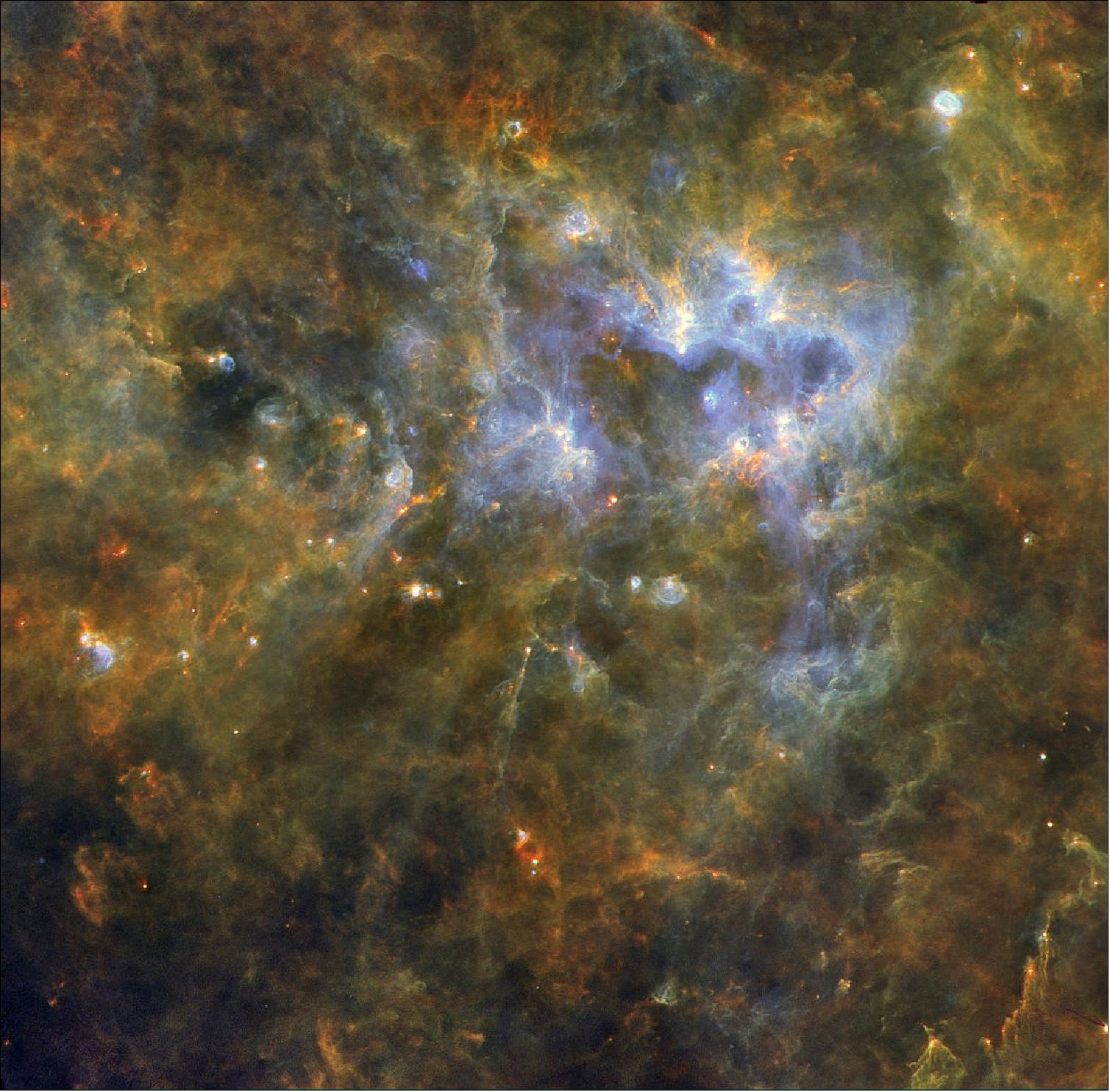
• May 16, 2018: A rare phenomenon connected to the death of a star has been discovered in observations made by ESA’s Herschel space observatory: an unusual laser emission from the spectacular Ant Nebula, which suggests the presence of a double star system hidden at its heart. 31)
- When low mass to middle mass stars like our Sun approach the end of their lives they eventually become dense, white dwarf stars. In the process, they cast off their outer layers of gas and dust into space, creating a kaleidoscope of intricate patterns known as a planetary nebula.
- The infrared Herschel observations have shown that the dramatic demise of the central star in the core of the Ant Nebula is even more theatrical than implied by its colorful appearance in visible images – such as those taken by the NASA/ESA Hubble Space Telescope. As revealed by the new data, the Ant Nebula also beams intense laser emission from its core.
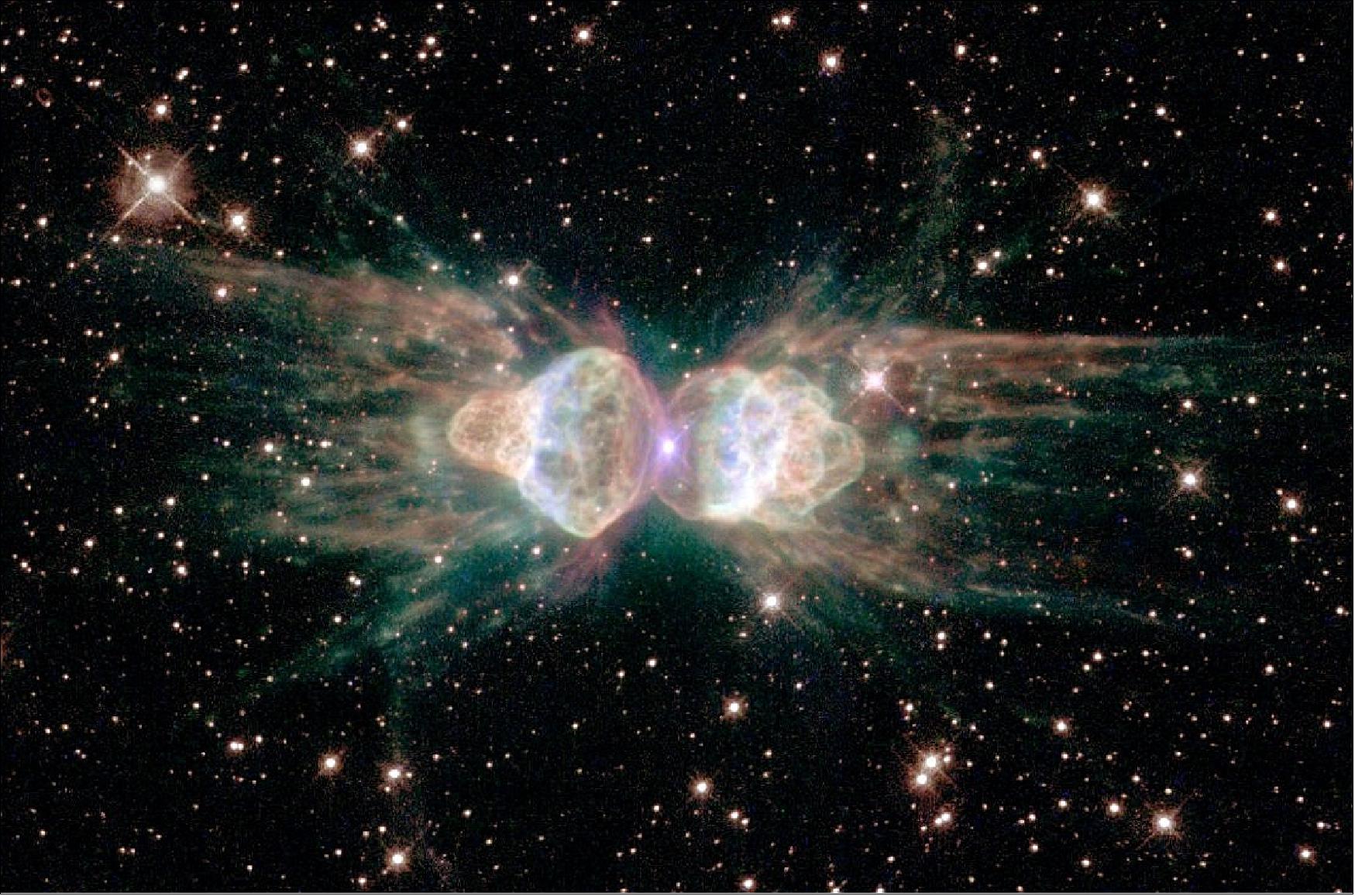
- While lasers in everyday life today might mean special visual effects in music concerts, in space, focused emission is detected at different wavelengths under specific conditions. Only a few of these space infrared lasers are known.
- By coincidence, astronomer Donald Menzel, who first observed and classified this particular planetary nebula in the 1920s (it is officially known as Menzel 3 after him), was also one of the first to suggest that in certain conditions natural ‘light amplification by stimulated emission of radiation’ – from which the acronym ‘laser’ derives – could occur in gaseous nebulae. This was well before the discovery and first successful operation of lasers in laboratories in 1960, an occasion which is now celebrated annually on 16 May as International Day of Light.
- “When we observe Menzel 3, we see an amazingly intricate structure made up of ionized gas, but we cannot see the object in its center producing this pattern,” says Isabel Aleman, lead author of a paper describing the new results.
- “Thanks to the sensitivity and wide wavelength range of the Herschel observatory, we detected a very rare type of emission called hydrogen recombination line laser emission, which provided a way to reveal the nebula’s structure and physical conditions.”
- This kind of laser emission needs very dense gas close to the star. Comparison of the observations with models found that the density of the laser-emitting gas is around ten thousand times higher than that of the gas seen in typical planetary nebulae and in the lobes of the Ant Nebula itself.
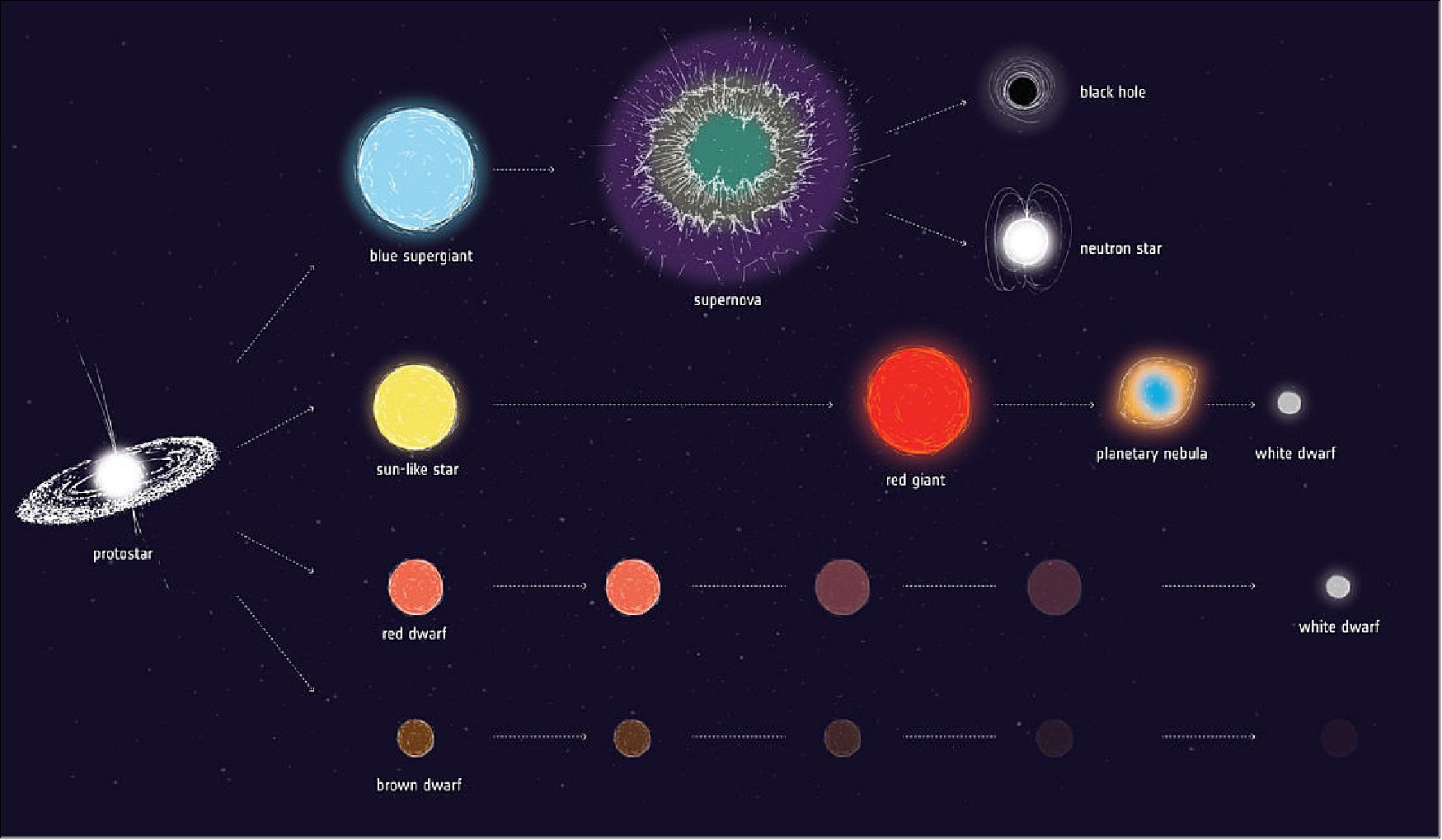
- Normally, the region close to the dead star – close in this case being about the distance of Saturn from the Sun – is quite empty, because most of its material is ejected outwards. Any lingering gas would soon fall back onto it.
- “The only way to keep gas close to the star is if it is orbiting around it in a disc,” says co-author Albert Zijlstra. “In this case, we have actually observed a dense disc in the very center that is seen approximately edge-on. This orientation helps to amplify the laser signal. The disc suggests the white dwarf has a binary companion, because it is hard to get the ejected gas to go into orbit unless a companion star deflects it in the right direction.”
- Astronomers have not yet seen the expected second star, but they think that the mass from the dying companion star is being ejected and then captured by the compact central star of the original planetary nebula, producing the disc where the laser emission is produced.
- “We used Herschel to characterize various components of gas and dust in nebula around old stars, but we were not necessarily looking for a laser phenomenon,” adds Toshiya Ueta, principal investigator of the Herschel Planetary Nebula Survey project. “Such emission has only been identified in a handful of objects before; this was a remarkable discovery that we did not anticipate. There is certainly more to stellar nebulae than meets the eye!”
- “This study suggests that the distinctive Ant Nebula, as we see it today, was created by the complex nature of a binary star system, which influences the shape, chemical properties, and evolution in these final stages of a star’s life,” says Göran Pilbratt, ESA’s Herschel project scientist.
- “Herschel offered the perfect observing capabilities to detect this extraordinary laser in the Ant Nebula. The findings will help constrain the conditions under which this phenomenon occurs, and help us to refine our models of stellar evolution. It is also a happy conclusion that the Herschel mission was able to connect together Menzel’s two discoveries from almost a century ago.”
• March 26, 2018: The plane of the Milky Way is rich in star-forming regions, such as the one pictured in this stunning scene by ESA’s Herschel space observatory. To the far-infrared eye of Herschel, this region reveals an intricate network of gas filaments and dark bubbles interspersed by bright hotspots where new stars come to life. 33)
- The cooler regions, which emit light at longer wavelengths, are displayed in a red-brownish color. Hotter areas, where star formation is more intense, shine in blue and white tones. Some areas are particularly bright, suggesting a number of luminous, massive stars are forming there.
- Particularly striking is the chaotic web of gas filaments we see in this scene. Astronomers think there is a link between star formation and the filamentary structures in the interstellar medium. In the densest strands, the gas that makes up the filaments becomes unstable and forms clumps of material bound together by gravity. If dense enough, these collapsed blobs of gas eventually go on to become newborn stars.
- Observations by Herschel showed the filamentary complexity to be ubiquitous in the plane of our Galaxy, from a few to hundreds of light-years. In nearby star-forming clouds, within 1500 light-years of the Sun, these filaments seem to be roughly all the same width – about a third of a light-year. This suggests a common physical mechanism in their origin, possibly linked to the turbulent nature of interstellar gas clouds.
- The star-formation region in this image, centered around –70º longitude in galactic coordinates, is located in the Carina neighborhood, home to the glorious Carina Nebula. Located some 7500 light-years away, Carina is one of the largest clouds of gas and dust in the plane of the Milky Way. It hosts the famous Eta Carinae, one of the most luminous and massive stellar systems in our galaxy.
- Herschel, which operated from 2009 until 2013, was a large space telescope observing in the far-infrared and submillimeter parts of the spectrum. This spectral range is ideal to observe the glow from cool dust in the regions where stars form. As part of Hi-GAL, the Herschel infrared Galactic Plane Survey, the observatory surveyed the plane of our Galaxy, exploring the Milky Way’s star-formation regions in unprecedented detail. This image, a product of Hi-GAL, combines observations at three different wavelengths: 70 µm (blue), 160 µm (green) and 250 µm (red).
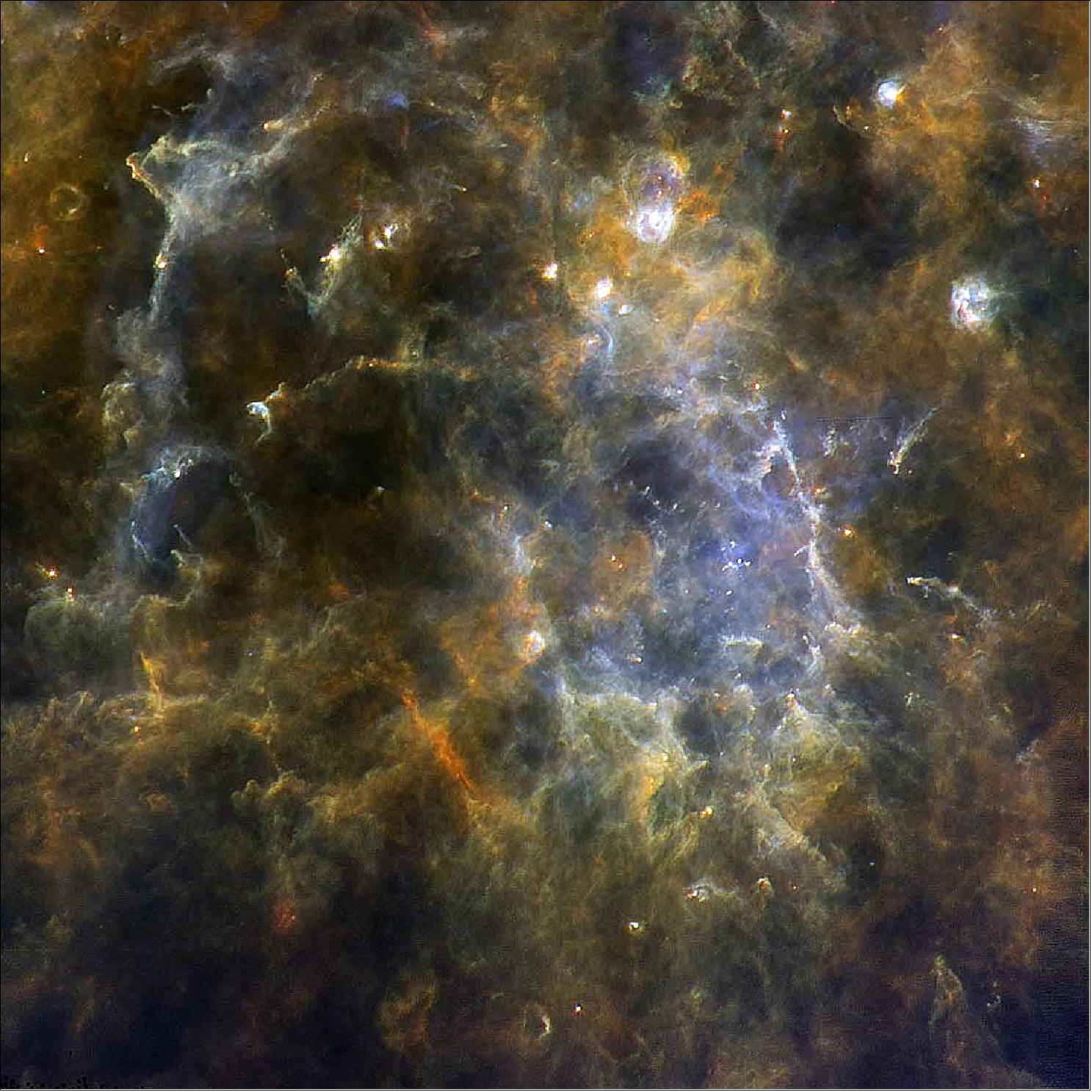
• December 7, 2017: Astronomers have used ESA's Herschel Space Observatory to solve a decades-old mystery about the origin of powerful cool gas winds in the hot environs of quasars. The evidence linking these powerful winds to star formation in the quasar host galaxies may also help resolve the mystery of why the size of galaxies in the Universe appears to be capped. 34) 35)
- Since their discovery in the 1960s, quasars have provided a treasure trove of questions for astronomers to answer. These energetic sources – up to 10 000 times brighter than the Milky Way – are the nuclei of distant galaxies with supermassive black holes at their heart. As gas is pulled into an accretion disc towards the black hole it heats to very high temperatures and radiates energy across the electromagnetic spectrum from radio to X-rays – in this way the signature luminosity of the quasar is born.
- For five decades, astronomers have studied the spectra of quasars to uncover the origin of the electromagnetic radiation they emit and to trace the path the light has traversed to reach us.
- A valuable tool in understanding this journey are the absorption lines in the quasars' radiation spectra. These lines indicate the wavelength ranges which have been absorbed as the radiation travelled from source to observer, giving clues to the material it passed through. Over time, the study of these lines has traced the composition of galaxies and gas clouds that lie between us and these distant luminous objects, but one set of absorption lines has remained unexplained.
- Astronomers have observed absorption lines in many quasars that are indicative of absorption en route by cool gas with heavy metal elements like carbon, magnesium and silicon. The lines signal that the light has travelled through winds of cold gas travelling at speeds of thousands of km/s within the quasars' host galaxies. Whilst knowledge that these winds exist is nothing new their origin, and why they are able to reach such impressive speeds, has remained an unknown.
- Now, astronomer Peter Barthel and his PhD student Pece Podigachoski, both from the Groningen University Kapteyn Institute, together with colleagues Belinda Wilkes from the Harvard-Smithsonian Center for Astrophysics (USA) and Martin Haas at Ruhr-Universität Bochum (Germany) have shed light on the cold winds' origins. Using data obtained with ESA's Herschel Space Observatory, the astronomers have shown, for the first time, that the strength of the metal absorption lines associated with these mysterious gas winds is directly linked to the rate of star formation within the quasar host galaxies. In finding this trend the astronomers are able to say with some confidence that prodigious star formation within the host galaxy may be the mechanism driving these mysterious and powerful winds.
- "Identifying this tendency for prolific star formation to be closely related to powerful quasar winds is an exciting find for us," explains Pece Podigachoski. "A natural explanation for this is that the winds are starburst driven and produced by supernovas – which are known to occur with great frequency during periods of extreme star formation."
- This new connection not only solves one puzzle about quasars but may also contribute to unravelling an even bigger mystery: why does the size of galaxies observed in our Universe appear to be capped in practice, although not in theory.
- "Aside from the question of which processes are responsible for the gas winds, their net effect is a very important topic in today's astrophysics," explains Peter Barthel. "Although theories predict that galaxies can grow very large, ultra-massive galaxies have not been observed. It appears that there is a process which acts as a brake on the formation of such galaxies: internal gas winds for example could be responsible for this so-called negative feedback."
- Theory predicts that galaxies should be able to grow to masses a hundred times larger than any ever observed. The fact that there is a deficit of behemoths in the Universe implies that there is a process depleting galaxies' gas reserves before they are able to reach their full potential. There are two mechanisms likely to lead to this depletion of gas: the first is the supernova winds associated with starbursts, the second, the winds associated with the supermassive black hole at the heart of every quasar. Although both mechanisms are likely to play a role, the evidence of correlation between cold gas winds and star formation rate found by this team suggests that in the case of quasars, star formation, which requires a steady supply of cold gas, may be the key culprit in sapping the galaxy of gas and suppressing its ability to grow the next generation of stars.
- "This is an important result for quasar science, and one that relied on the unique capabilities of Herschel," explains Göran Pilbratt, Herschel Project Scientist at ESA. "Herschel observes light in the far infrared and submillimeter enabling the detailed knowledge of the star formation rate in the galaxies observed that was needed to make this discovery."
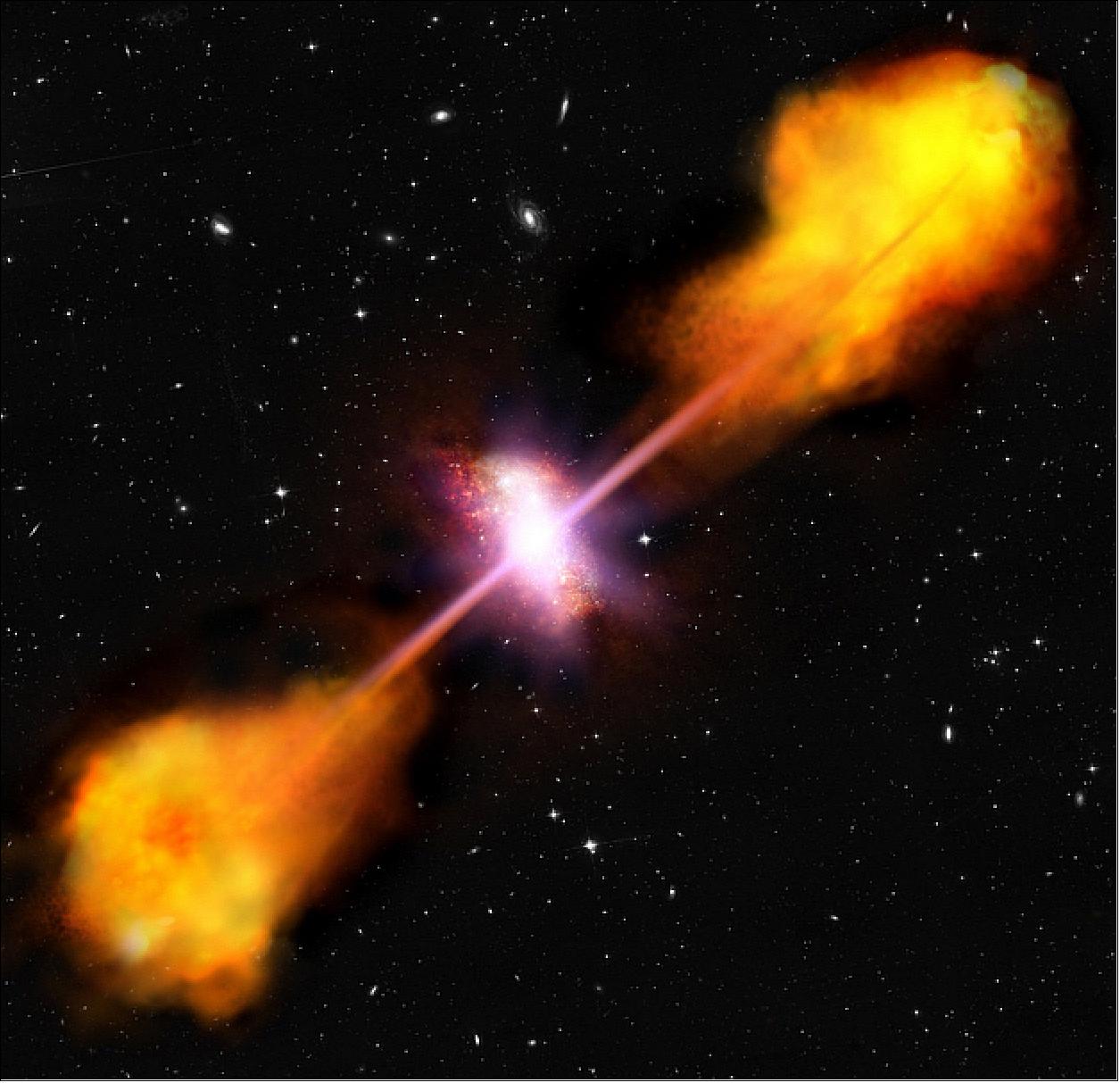
Legend to Figure 32: The quasar is powered by the supermassive black hole at the galaxy's center. As gas is drawn into an accretion disc around the black hole it heats to very high temperatures and radiates energy across the electromagnetic spectrum, preferentially in the direction of two powerful jets. In addition, the galaxy is making stars at a prolific rate of hundreds per year. For comparison, our Milky Way Galaxy makes 1-2 stars per year.
• November 27, 2017: A dark cloud when observed with optical telescopes, the Chamaeleon (Chameleon) I region reveals itself as an active hub of star formation in this far-infrared image from ESA’s Herschel space observatory. Only around 550 light-years away in the southern constellation of Chamaeleon, it is one of the closest areas where stars are bursting into life. 36)
- Herschel’s extraordinary scans uncovered a vast and intricate network of filamentary structures everywhere in the Galaxy, confirming that filaments are crucial elements in the process of star formation.
- After a filamentary web arises from turbulent motions of gas in the interstellar material, gravity takes over, but only in the densest filaments, which become unstable and fragment into compact objects – the seeds of future stars.
- Chamaeleon I is no exception, with several elongated structures weaving their way through the cloud. Most of the star-forming activity is taking place at the convergence of filaments – in the bright area towards the top right and in the vaster region just left of the image center, sprinkled with newborn stars that are heating up the material in their surroundings.
- Analysing images like this, astronomers have identified more than 200 young stars in this two million year-old cloud. Most of these stars are still surrounded by a disc of leftover material from the formation process, which may evolve and later give rise to planets.
- Owing to its relative vicinity, Chamaeleon I is an ideal laboratory to explore protoplanetary discs and their properties using Herschel data.
- This image was first published in a paper by Á. Ribas et al. (2013), which presents a study of protoplanetary discs in this region. It was also shared as a #HerschelMoment during a public campaign on Twitter to celebrate the legacy of ESA's observatory in September 2017.
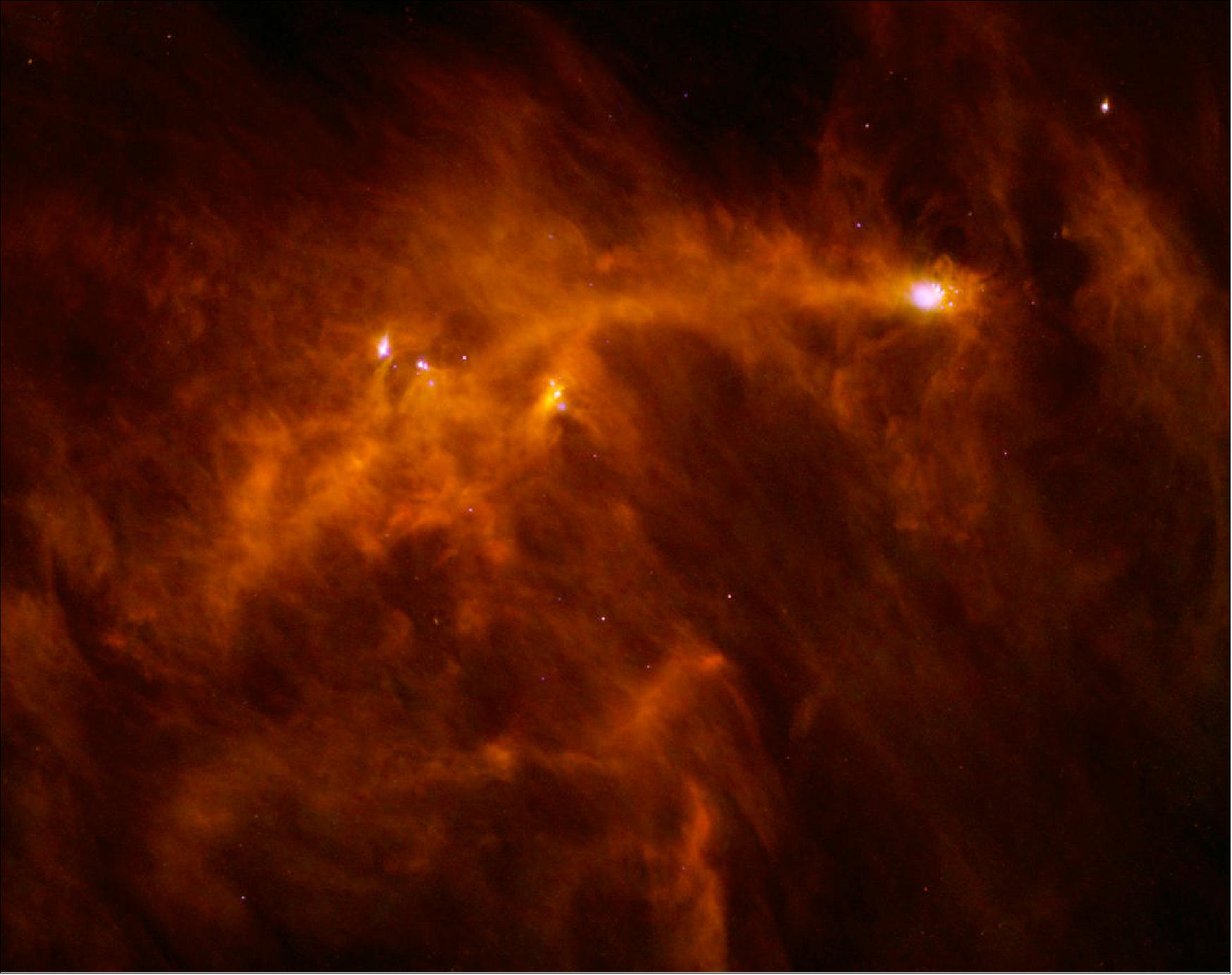
• November 13, 2017: What seemed at first like a rare instance of a huge, ancient galaxy revealed itself to be an even rarer pair of extremely massive galaxies, seen on the brink of merging when the Universe was only a billion years old. 37)
- This outstanding source was first identified by ESA’s Herschel space observatory, and later exposed in greater detail with the ground-based ALMA (Atacama Large Millimeter/submillimeter Array) in Chile.
- The earliest galaxies in the 13.8 billion-year history of our cosmos started to take shape a few hundred million years after the Big Bang, as matter flowed towards increasingly denser spots and as the first stars were igniting into life.
- Primordial galaxies, however, were not like the ones we are familiar with today. They started out much smaller than our Milky Way galaxy, which is now home to hundreds of billions of stars, and slowly grew more massive over billions of years.
- In this scenario, astronomers could not easily explain the observation of massive galaxies populated by ageing stars at relatively early epochs in cosmic history, when the Universe was only a few billion years old. — How did such massive galaxies assemble in this relatively short time?
- The recent discovery of possible progenitors to such galaxies – massive galaxies observed at even earlier cosmic times – has brought new clarity to these investigations.
- “Scrutinizing several hundred thousand galaxies observed by Herschel, we identified a very rare instance of a massive object in the very early Universe,” says Dominik Riechers from Cornell University, USA, who is the lead author of the new study. 38)
- The wide range of infrared and submillimeter wavelengths probed by Herschel, which scanned the sky between 2009 and 2013, was key to finding this source.
- Galaxies that are forming stars shine brightly in the infrared. This is due to cosmic dust present in the dense clouds where stars are born, which absorbs part of the starlight and radiates it again at longer wavelengths.
- In addition, because the Universe is expanding, the wavelength of light emitted by distant galaxies is stretched even longer along its cosmic journey, up to the submillimeter in the case of the most distant galaxies, whose light was released in the first few billion years of cosmic history.
- It was 2012 when Dominik and colleagues singled out this source as potentially interesting and worthy of follow-up observations. After they looked at it at even longer submillimeter wavelengths with Europe’s APEX (Atacama Pathfinder Experiment), also located in Chile, it stood out as the ‘reddest’ in this galaxy sample, appearing consistently brighter at increasingly longer wavelengths, up to 870 µm.
- This suggested that the galaxy is ripe with star formation and located at a great distance from us, in the depth of the very early Universe.
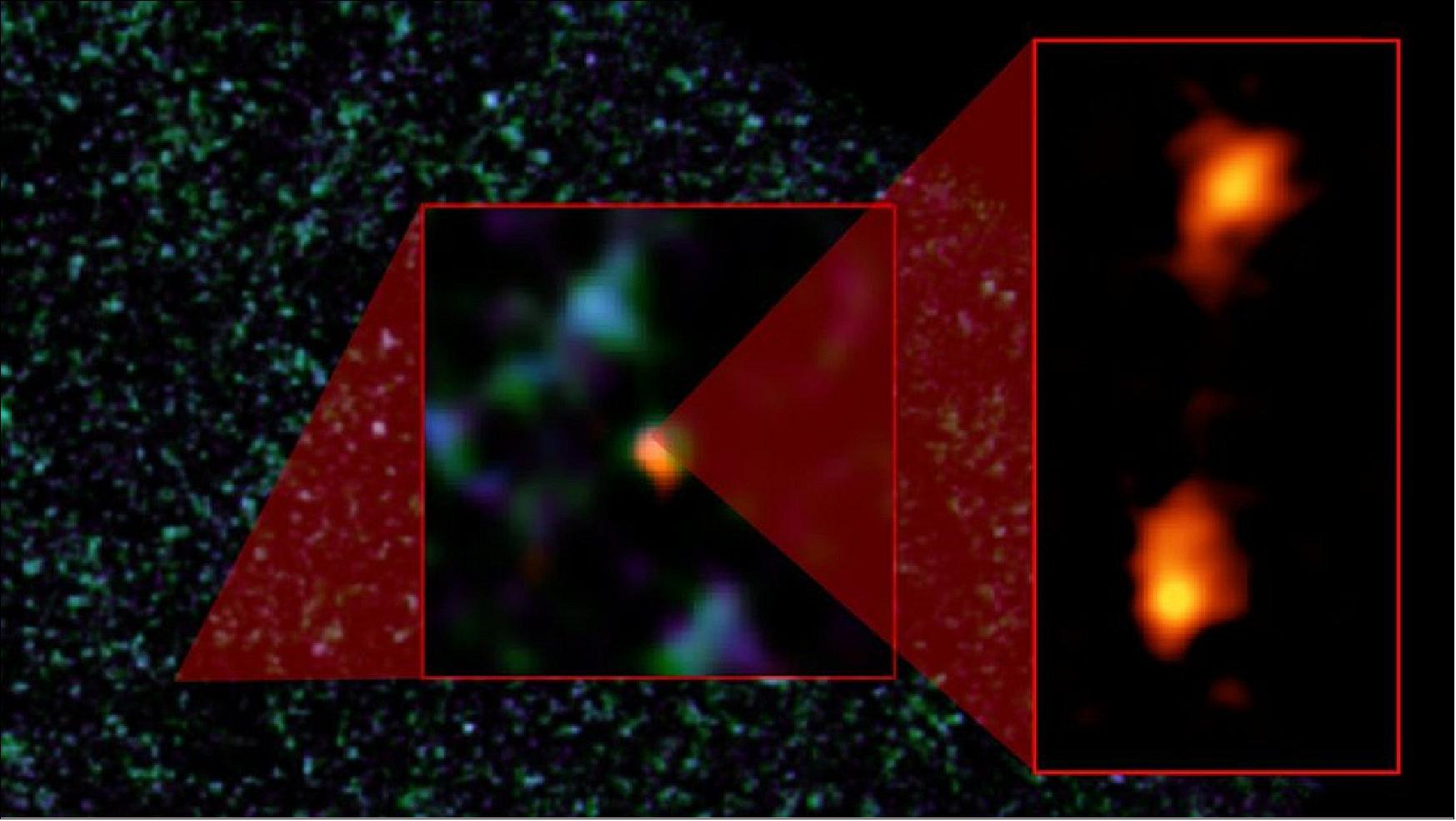
Legend to Figure 34: The Herschel survey is shown in the background, combining data collected at 350 µm (blue) and 500 µm (green). The inset at the center shows a zoom around the potentially interesting source, combining the Herschel view with follow-up observations performed at 870 µm with the Atacama Pathfinder Experiment (APEX; red). — Further observations obtained with ALMA (Atacama Large Millimeter/submillimeter Array) at higher resolution (right inset) revealed that the source consists not just of one ancient, massive galaxy, but of a pair of distinct massive galaxies about to merge. — These two galaxies, each roughly as massive as our Milky Way, were informally dubbed the ‘Horse’ and the ‘Dragon’.
- Using further observations obtained with ALMA, the astronomers spotted carbon monoxide and water vapor in this object, and used these emissions to estimate how far away it is from us. This confirmed that they were observing the source as it was only a billion years after the Big Bang.
- The high-resolution observations performed with ALMA had an extra surprise in store. “On closer inspection, this unique object was even more exciting than we could expect, consisting not just of one ancient, massive galaxy, but of a pair of distinct massive galaxies about to merge,” explains Dominik.
- Teeming with star formation, they are 10 to 100 times more massive than most galaxies at the same epoch in the Universe’s history. The Horse and the Dragon will eventually come together, giving rise to an even more massive galaxy in a few hundred million years’ time.
- The finding demonstrates that giant galaxies, albeit rare, did exist at very early cosmic epochs and could well be the progenitors of the massive ones harboring ageing stars that are observed at slightly later times, when the Universe’s age was only a couple billions of years.
- The team is now busy investigating this extreme merging system in even greater detail, studying the properties of its stellar population and dust with ALMA as well as with the European Southern Observatory’s Very Large Telescope.
- “We are also looking for possible satellites, smaller galaxies that might have been caught in the gravitational field of the two behemoths, as we would expect from theory,” says Dominik.
- In the near future, observations with the NASA/ESA/CSA JWST (James Webb Space Telescope), to be launched in 2019, will allow astronomers to delve deeper into the secrets of this system.
- Further into the future, there will be an additional tool to investigate the early Universe through galactic mergers – though only those at a much more advanced stage than the Horse and the Dragon, when the supermassive black holes at the center of each galaxy are about to coalesce. Such cosmic collisions release gravitational waves – fluctuations in the fabric of spacetime – that can be observed by ESA’s future gravitational wave observatory, LISA (Laser Interferometer Space Antenna).
- In the meantime, it is unlikely that many more systems like the one recognized by Dominik and his collaborators will be uncovered. If current theories about galaxy formation are correct, such beasts are extremely rare. Nevertheless, the team will keep investigating data from the Herschel archive for possible evidence of other interesting sources.
- “This exciting result, obtained by thoroughly combing through Herschel’s surveys combined with extensive follow-up observations, demonstrates the powerful legacy and long-term impact of the data now, several years after the observing was done,” says Göran Pilbratt, Herschel project scientist at ESA. “This will continue to be the case for many years.”
• September 20, 2017: Delving deep into the history of our cosmos, the Herschel Space Observatory scrutinized hundreds of thousands of star-forming galaxies, peering back in time to when the Universe was less than one billion years old. These observations probed the peak epoch of stellar production, about ten billion years ago, when galaxies were forming stars roughly ten times faster than their present counterparts. 40)
Note: This entry is part of ”Herschel Week”, 18-22 September, 2017.
- Looking at the starry spectacle of the night sky, we might be tricked by its seemingly timeless beauty to think that the multitude of distant suns have been there since the beginning of time. But, if our eyes could peer back into cosmic history up to the first few seconds of our Universe, almost 14 billion years ago, they would be treated to a very different view.
- Shortly after the Big Bang – the hot and dense phase that sets our cosmic tale into motion – the Universe was very different from what we can observe nowadays, and it took a few hundred million years for stars and galaxies to start to emerge from the primordial 'soup' that filled the early cosmos.
- Piecing together how galaxies formed and evolved, giving birth to stars at different paces throughout the history of the Universe, is one of the most intriguing and challenging topics in present day astrophysics and cosmology research.
- Infrared is the key: In their quest to investigate how galaxies differ at various cosmic epochs, astronomers have been collecting increasingly larger samples, searching for the light that was emitted by galaxies many billions of years ago and that has been travelling across the Universe ever since. These studies greatly benefit from combining observations at different wavelengths of light, with the infrared band being crucial to pinpoint galaxies that are fiercely forming stars.
- Star formation in galaxies takes place within dense clouds of gas that, for most of cosmic history, also contain small amounts of dust. Newborn stars shine brightly in ultraviolet and visible wavelengths, but only about half of this starlight, on average, leaves a galaxy unhindered; neighboring dust grains absorb the other half, radiating it again but, this time, at longer wavelengths.
- As a result of the dust interspersed in the interstellar material, galaxies emit roughly 50 percent of their total light at mid-infrared, far-infrared, and sub-millimeter wavelengths –between 8 µm and 1 mm – with a peak in the far-infrared, around 50-200 µm. For this reason, observations in this spectral range are fundamental for quantifying a galaxy's star formation activity.
- In addition, the expansion of the Universe stretches the wavelengths of light emitted by distant objects. This effect, known as redshift, becomes increasingly more significant the farther a galaxy is from us.
- This causes the peak of dust emission to move from the far-infrared to sub-millimeter wavelengths. Therefore observations that cover these two portions of the electromagnetic spectrum complement each other, capturing dusty emission from star formation in both nearby and distant galaxies.
- Performing observations at infrared wavelengths with telescopes on the ground, however, is generally difficult – if not impossible – because of the presence of Earth's atmosphere, so astronomers turned to space.
- In the early 1980s, the US-Dutch-British IRAS (Infrared Astronomical Satellite) was the first space mission to map the sky in the far-infrared, followed by ESA's ISO (Infrared Space Observatory) in the late 1990s, NASA's Spitzer Space Telescope, launched in 2003, and JAXA's Akari (ASTRO-F), which operated between 2006 and 2011.
- With mid-infrared observations from ISO and Spitzer, astronomers started to perceive the glow of warm dust from individual star-forming galaxies sprinkled across the Universe's history. But it was only with ESA's Herschel Space Observatory, launched in 2009 and operational until 2013, that these investigations unleashed their full potential.
- The observatory's broad spectral coverage, including the far-infrared and sub-millimeter range, extended to longer wavelengths than those probed by Spitzer, ISO, and Akari. As a result, astronomers could sense cooler dust than that which had been detected by its predecessors. -With its unprecedented angular resolution, Herschel could also spot galaxies that had been missed by these earlier observatories at the wavelengths they had in common.
- In addition, and perhaps most importantly, its particular spectral range made it possible to catch galaxies whose light had been redshifted to longer wavelengths than those probed by its predecessors, tracing out star formation to greater distances and thus earlier times in cosmic history.
- With a 3.5 m primary mirror, Herschel sported the largest infrared telescope flown to date, granting astronomers unprecedented sensitivity that was crucial to observe star-forming galaxies across the Universe.
- Scrutinizing the evolution of galaxies was the focus of various Key Programs that dedicated over 2000 hours to these observations – among them, the Herschel Multi-tiered Extragalactic Survey (HerMES), the PACS Evolutionary Probe (PEP), and the Herschel Astrophysical Terahertz Large Area Survey (H-ATLAS).
- Following in the footsteps of previous studies based on Spitzer data, Herschel allowed astronomers to resolve the diffuse 'fog' known as the cosmic infrared background radiation into hundreds of thousands of individual, actively star-forming galaxies, seen as they were at a variety of past epochs. Herschel's contribution was crucial to push the observations up to the time when the Universe was less than one billion years old, probing the full period when star formation peaked and even beyond.
- This result, which has opened new avenues to study the evolution of galaxies, is somewhat suggestive of the revolutionary observations by Galileo who, just over four centuries before, had pointed the newly invented telescope at the diffuse white glow of the Milky Way, breaking it down into a myriad of individual stars.
- Making sense of it all: To get to the bottom of how differently galaxies evolved across the history of the Universe, observations are compared with the predictions from computer simulations, which attempt to reproduce the build-up of cosmic structures on very large scales. Many new simulations have also embraced the very challenging task of including a number of small-scale processes to account for the feedback effects caused by star formation or the activity of supermassive black holes.
- As for Herschel's survey of over 12 billion years of star formation, a comparison with the simulated cosmos showed that some processes underlying galaxy evolution seem to be well understood, but many details remain unclear. Simulations are still far from reproducing the complex and diverse properties recorded by surveys of galaxies, especially concerning the link between feedback and star formation, and there is still much work to do before all pieces of this cosmic puzzle fall into place.
- Nevertheless, Herschel's unprecedented observations are greatly helping astronomers in their ambitious endeavour of assembling the complex history of how stars and galaxies formed and evolved in the cosmos. Pushing the experimental boundaries farther than any of its predecessors, the mission has revealed a number of previously hidden gems, near and far, that have been crucial to piecing together this intriguing tale, while at the same time it also uncovered new mysteries that will keep astronomers busy for the foreseeable future.
• September 18, 2017: The bubbles and wisps portrayed in this image of Figure 35 by ESA's HSO (Herschel Space Observatory) reveal great turmoil in the W3/W4/W5 complex of molecular clouds and star-forming regions. Located over 6000 light-years away, in the northern constellation Cassiopeia, it is one of the best regions in which to study the life and death of massive stars in our Milky Way galaxy. 41) 42)
Note: This entry is part of ”Herschel Week”, 18-22 September, 2017.
- Observing the sky at far-infrared and sub-millimeter wavelengths from 2009 to 2013, Herschel could catch the faint glow of dust grains interspersed in these clouds. Astronomers can use this glow to trace the otherwise dark gas where star formation unfolds.
- The three regions that make up the complex – W3, W4, and W5 – owe their name to astronomer Gart Westerhout, who first identified them in the 1950s as the third, fourth and fifth sources of his survey of the Galaxy at radio wavelengths.
- The bright, white region towards the top right of the image, hosting three brilliant spots, is W3, a giant molecular cloud containing one of the most active factories of massive stars in the outer Milky Way. For its star-making activity, the cloud draws from a total reservoir of raw material equivalent to several hundred thousand times the mass of our Sun.
- The large, blue-greenish cavity to the lower left of W3 is W4, a bubble carved by winds and supernova explosions of the massive stars in IC1805, the star-forming region at its core.
![Figure 35: Space Science Image of the Week: HSO image of the W3/W4/W5 complex in the Milky Way. This two-color image combines Herschel observations at 70 µm (cyan) and 100 µm (orange), and spans about 8.4º by 2.9º; north is up and east to the left. [image credit: ESA/Herschel/NASA/JPL-Caltech, CC BY-SA 3.0 IGO; Acknowledgement: R. Hurt (JPL-Caltech)]](https://www.eoportal.org/ftp/satellite-missions/h/HSO_170622/HSO_Auto4F.jpeg)
- The other large cavity, on the left side of the image, is W5, consisting of two adjacent bubbles powered by intense winds and explosions of the massive stars that are coming to life in several stellar nurseries nestled within this region.
- Many seeds of new stars in this complex, especially in W3 and W5, have been observed along pillars, edges, and other features that are being sculpted in the cloud material by the mighty effects of nearby massive stars. This suggests that each generation of stars is triggering the formation of the next one.
- While these regions are prime locations to study the poorly understood processes that lead to the formation of massive stars, they also host large amounts of young, low-mass stars, providing astronomers with an extraordinary laboratory to investigate the full complexity of star formation in the Milky Way.
ESA's HSO has provided astronomers with an unprecedented glimpse into the stellar cradles of our Galaxy. As a result, giant strides have been taken in our understanding of the physical processes that lead to the birth of stars and their planetary systems. 43)
In September 2017, ESA is celebrating the marvelous science that it has achieved and takes stock of the legacy that Herschel leaves behind.
• One of the areas where Herschel has made substantial contributions concerns the processes that lead to the formation of stars, surveying a large number of stellar nurseries like the W3/W4/W5 complex portrayed in the image of Figure 35.
• "We are made of star stuff," the astronomer Carl Sagan famously said, as the atoms that make us – our bodies, our homes, our planet – come largely from previous generations of stars.
• Indeed, stars and planets are continually born in the densest and coldest pockets of molecular clouds, where they take shape from a mixture that consists largely of gas but also contains small amounts of dust mixed in.
• As part of a cosmic recycling process, stars also return their re-processed material after their demise, enriching this interstellar medium that pervades all galaxies, including our Milky Way, with heavy elements produced in their nuclear furnaces and during the violent explosions that end the lives of the most massive stars.
• Among many other exciting findings, Herschel’s observations have also traced the trail of water across the cosmos, and pieced together the evolution of galaxies throughout 14 billion years of the Universe’s history.
• Astronomers have long been aware that stars take shape as interstellar material comes together and condenses, then breaks up into fragments – the seeds of future stars – but many details of this complex process remained unclear until not so long ago.
• What turned the tables in the understanding of how stars are born was ESA's Herschel Space Observatory, a trailblazing mission that was launched in 2009 and operated until 2013.
• July 31, 2017: Hidden from our sight, the Westerhout 43 star-forming region is revealed in full glory in this far-infrared image from ESA’s Herschel space observatory. This giant cloud, where a multitude of massive stars come to life in the billowing gas and dust, is almost 20,000 light-years away from the Sun, in the constellation of Aquila, the Eagle. 44)
- Massing more than seven million Suns, this region is home to over 20 stellar nurseries, which are being heated by the powerful light from newborn stars within. These hubs of star formation stand out in blue hue against the cooler yellow and red surroundings.
- Nestled in the glowing blue bubble of gas at the center of the image is a cluster of extremely hot and massive Wolf-Rayet and OB stars, which together are over a million times brighter than our Sun. This bubble, hosting the seeds that will grow into several new stellar clusters, is one of the most prolific birthplaces of stars in our Galaxy.
- A less extreme but still very active stellar factory is the large complex of blue bubbles visible in the image towards the right. Scrutinizing the Herschel images, astronomers have found evidence of what appears like a network of filaments linking these two intense hubs of star formation.
- Investigating star-forming regions across our Galaxy in unprecedented detail was one of the main goals of Herschel, which was launched in 2009 and operated for almost four years, observing the sky at far-infrared and submillimeter wavelengths. Sensitive to the heat from the small fraction of cold dust mixed in with the clouds of gas where stars form, imaging such regions points astronomers to dense areas of gas where new stars are being born, enabling them to study the action in detail, just as in this image (Figure 36).
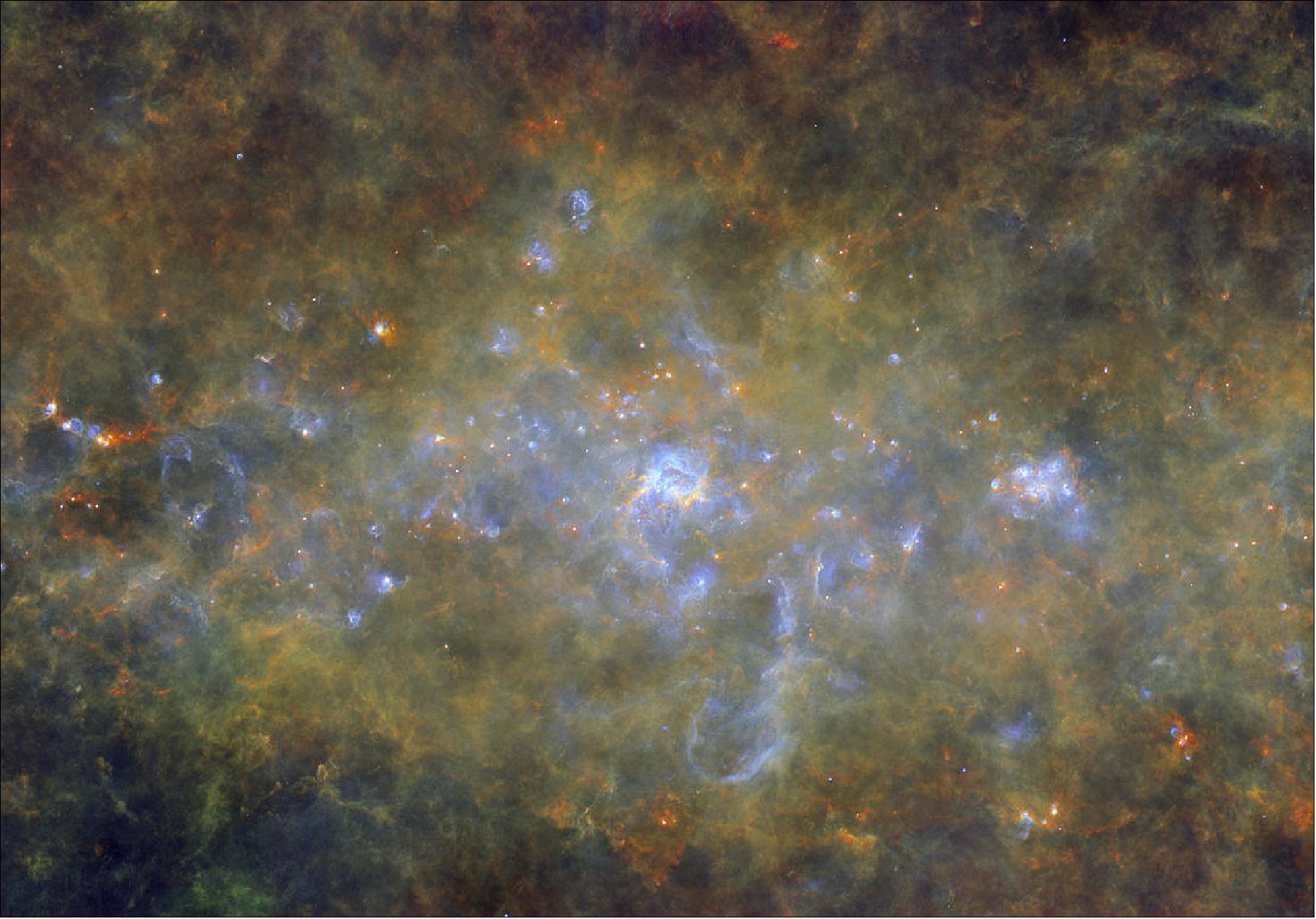
Legend to Figure 36: This three-color image combines Herschel observations at 70 µm (blue), 160 µm (green) and 250 µm (red), and spans about 3º on the long side; north is up and east to the left. The image was obtained as part of Herschel’s Hi-GAL key-project, which imaged the entire plane of the Milky Way in five different infrared bands. A video panorama compiling all Hi-GAL observations was published in April 2016.
• February 20, 2017: Cosmic dust, a minor but crucial ingredient in the interstellar material that pervades our Milky Way galaxy, shines brightly at infrared wavelengths (Figure 37). By tracing the glow of dust with the infrared eye of Herschel, astronomers can explore stellar nurseries in great detail. 45)
- Sprinkled across the image are dense concentrations of the interstellar mixture of gas and dust where stars are being born. The brightest portions, with a blue hue, are being heated by the powerful light from newborn stars within them, while the redder regions are cooler. The delicate shapes visible throughout the image are the result of radiation and mighty winds from the young stars carving bubbles and other cavities in the surrounding interstellar material.
- Out of the various bright, blue regions, the one furthest to the left is known as G333.6-0.2 and is one of the most luminous portions of the infrared sky. It owes its brightness to a stellar cluster, home to at least a dozen young and very bright stars that are heating up the gas and dust around them. Elongated and thin structures, or filaments, stand out in the tangle of gas and dust, tracing the densest portions of this star-forming cloud. It is largely along these filaments, dotted with many bright, compact cores, that new stars are taking shape.
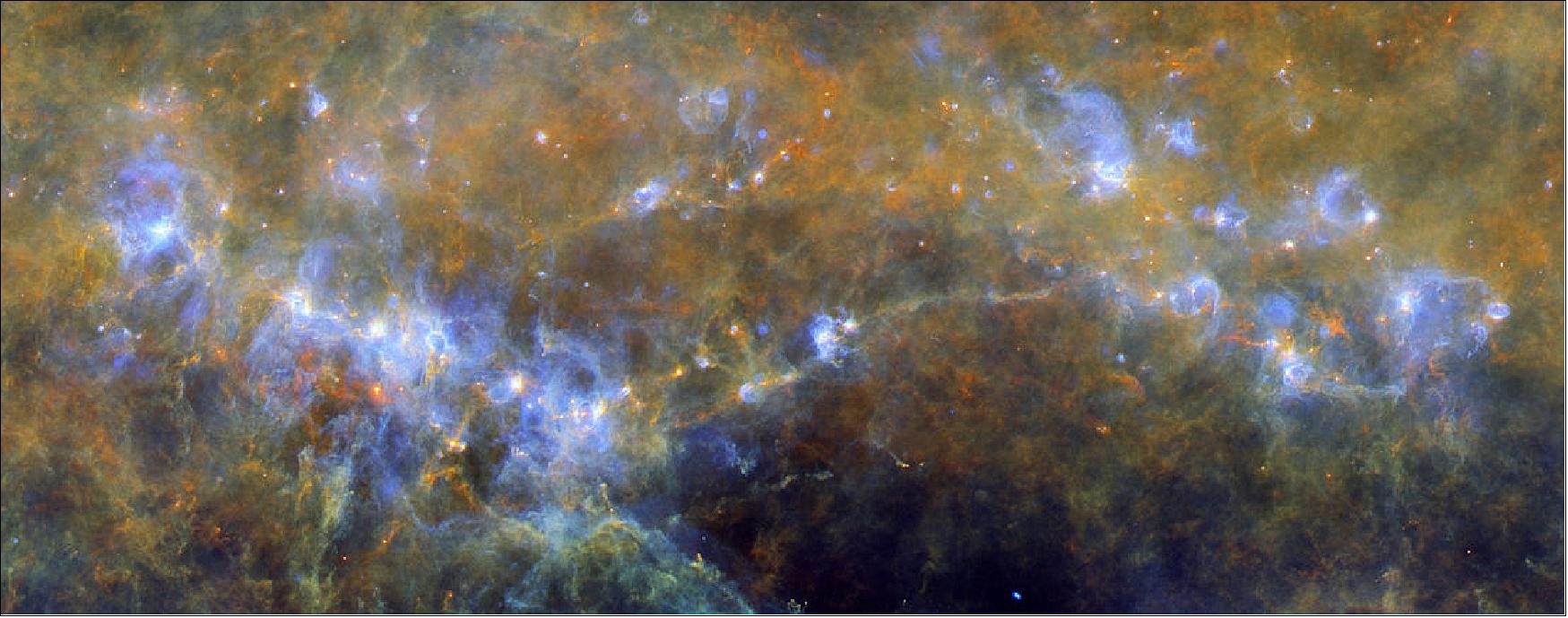
Legend to Figure 37: This three-color image combines Herschel observations at 70 µm (blue), 160 µm (green) and 250 µm (red), and spans over 1º on the long side; north is up and east to the left. The image was obtained as part of Herschel’s Hi-GAL key-project, which imaged the entire plane of the Milky Way in five different infrared bands.
• January 03. 2017: Just as the new calendar year begins, and with it a feeling of new beginnings, so this network of dust and gas shows a portion of the sky where star birth is yet to take hold. The image of Figure 38 shows several tens of tangled interstellar filaments. Such filaments can stretch for tens of light-years through space and can precede the onset of star formation, with newborn stars often found in the densest parts. 46)
- Embedded within the filaments are a number of denser patches of material, but hardly any currently appear to be the seeds of future stars. As they are now, the filaments are simply not massive enough to support star formation. — Whether or not this currently calm region becomes a stellar nursery in the future remains to be seen.
- The region was imaged by Herschel’s PACS (Photodetector Array Camera and Spectrometer) and SPIRE (Spectral and Photometric Imaging Receiver) at infrared wavelengths of 250, 350 and 500 µm.
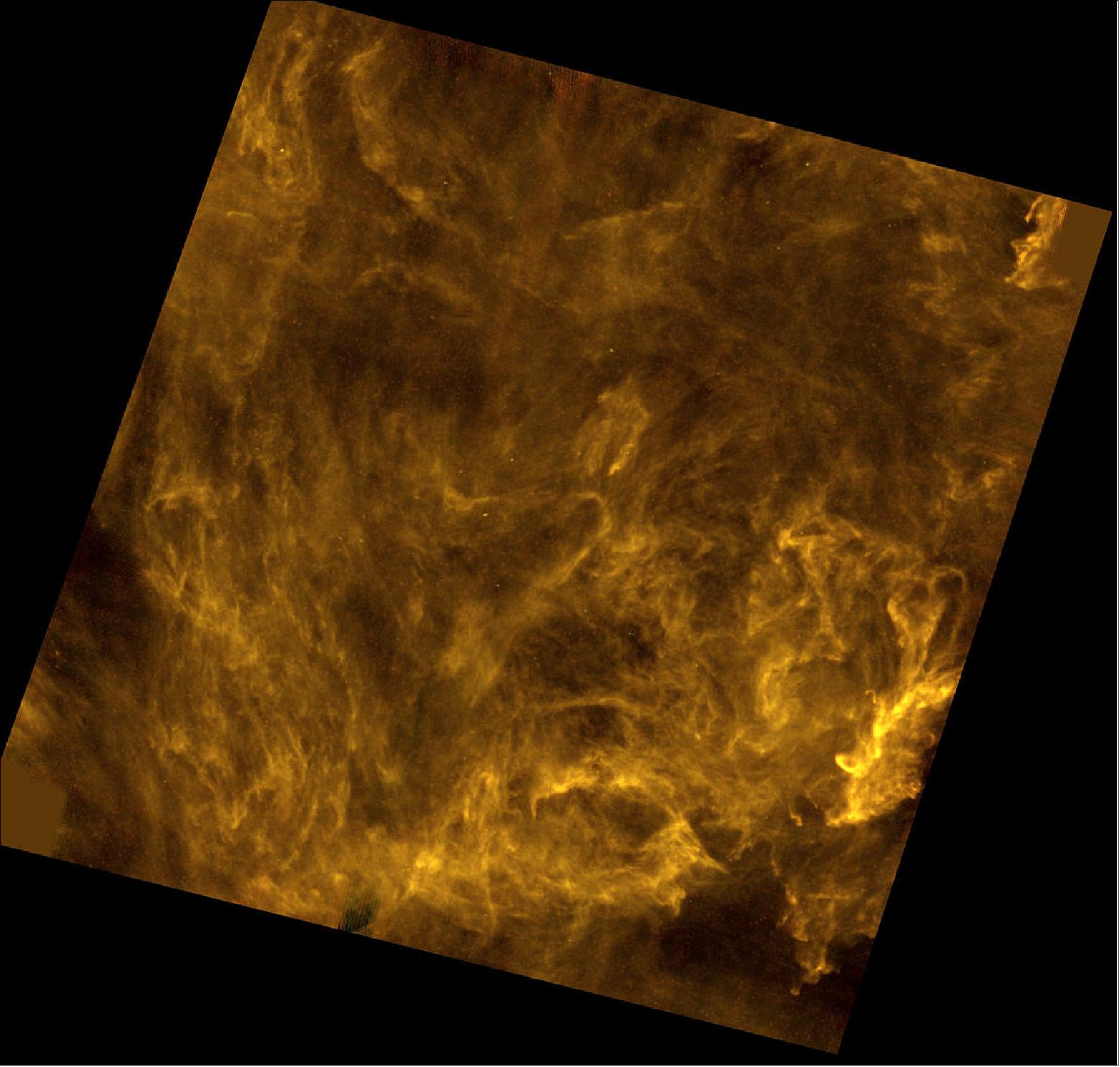
• May 23, 2016: New stars are the lifeblood of our Galaxy, and there is enough material revealed by this Herschel infrared image to build stars for millions of years to come (Figure 39). Situated some 8000 light-years away in the constellation Vulpecula – latin for little fox – the region in the image is known as Vulpecula OB1 (note: massive O and B type stars are sometimes referred to as OB stars). It is a ‘stellar association’ in which a batch of truly giant ‘OB’ stars is being born. 47)
- The vast quantities of ultraviolet and other radiation emitted by these stars is compressing the surrounding cloud, causing nearby regions of dust and gas to begin the collapse into more new stars. In time, this process will ‘eat’ its way through the cloud, transforming some of the raw material into shining new stars.
- At visual wavelengths, the OB association is linked to a star cluster catalogued as NGC 6823. It was discovered by William Herschel in 1785 and contains 50–100 stars. A nebula emitting visible light, catalogued as NGC 6820, is also part of this multi-faceted star-forming region.
- The giant stars at the heart of Vulpecula OB1 are some of the biggest in the Galaxy. Containing dozens of times the mass of the Sun, they have short lives, astronomically speaking, because they burn their fuel so quickly.
- At an estimated age of two million years, they are already well through their lifespans. When their fuel runs out, they will collapse and explode as supernovas. The shock this will send through the surrounding cloud will trigger the birth of even more stars, and the cycle will begin again.
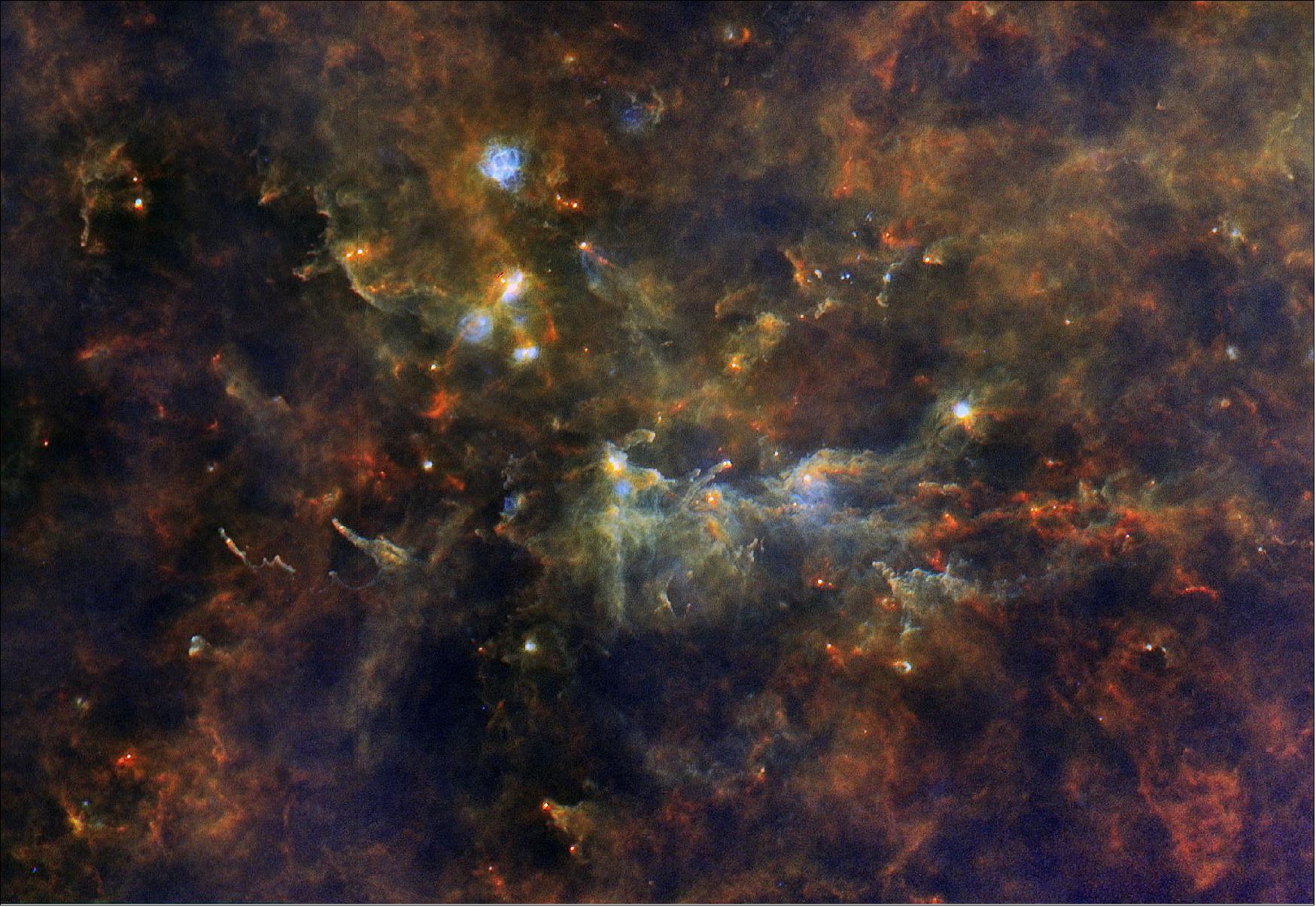
• April 22, 2016: ESA's Herschel mission releases today a series of unprecedented maps of star-forming hubs in the plane of our Milky Way galaxy. This is accompanied by a set of catalogues listing hundreds of thousands of compact sources that span all phases leading to the birth of stars in our Galaxy. These maps and catalogues will be very valuable resources for astronomers, to exploit scientifically and for planning follow-up studies of particularly interesting regions in the Galactic Plane. 48) 49)
During its four years of operations (2009-2013), the Herschel space observatory scanned the sky at far-infrared and sub-millimeter wavelengths. Observations in this portion of the electromagnetic spectrum are sensitive to some of the coldest objects in the Universe, including cosmic dust, a minor but crucial component of the interstellar material from which stars are born.
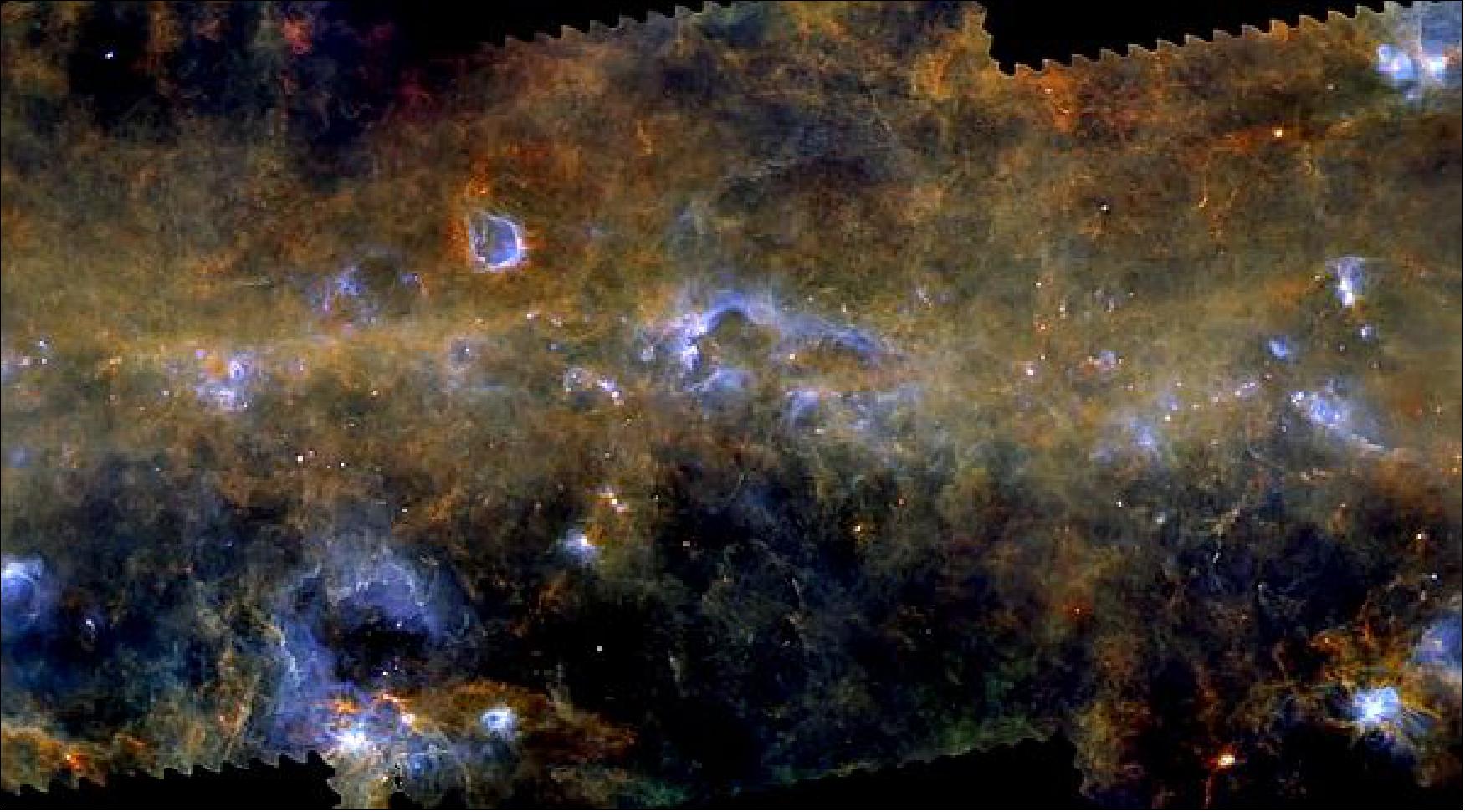
- The Hi-GAL (Herschel infrared Galactic Plane Survey ) is the largest of all observing programs carried out with Herschel, in terms of both observing time – over 900 hours of total observations, equivalent to almost 40 days – and sky coverage – about 800 square degrees, or two percent of the entire sky. Its aim was to map the entire disc of the Milky Way, where most of its stars form and reside, in five of Herschel's wavelength channels: 70, 160, 250, 350 and 500 µm.
- Over the past two years, the Hi-GAL team has processed the data to obtain a series of calibrated maps of extraordinary quality and resolution. With a dynamical range of at least two orders of magnitude, these maps reveal the emission by diffuse material as well as huge filamentary structures and individual, point-like sources scattered across the images.
- The images provide an unprecedented view of the Galactic Plane, ranging from diffuse interstellar material to denser filamentary structures of gas and dust that fragment into clumps where star formation sets in. They include pre-stellar clumps, protostars in various evolutionary stages and compact cores on the verge of turning into stars, as well as fully-fledged stars and the bubbles carved by their highly energetic radiation.
- Today, the team released the first part of this data set, consisting of 70 maps, each measuring 2º x 2º, and provided in the five surveyed wavelengths. "These maps are not only stunning from an aesthetic point of view, but they represent a rich data set for astronomers to investigate the different phases of star formation in our Galaxy," explains Sergio Molinari from IAPS/INAF, Italy, Principal Investigator for the Hi-GAL Project.
- Astronomers have been able to avail of data from Hi-GAL from the very beginning of the observing program since the team agreed to waive their right to a proprietary period. The observations have been made available through the ESA Herschel Science Archive, including raw data as well as data products generated by systematic pipeline processing. The data has regularly been reprocessed to gradually higher quality and fidelity products.
- The present release represents an extra step in the data processing. The newly released maps are accompanied by source catalogues in each of the five bands, which can be directly used by the community to study a variety of subjects, including the distribution of diffuse dust and of star-forming regions across the Galactic Plane.
- The maps cover the inner part of the Milky Way, towards the Galactic Center as seen from the Sun, with Galactic longitudes between +68° and -70°. A second release, with the remaining part of the survey, is foreseen for the end of 2016.
- "It is not straightforward to extract compact sources from far-infrared images, where pre-stellar clumps and other proto-stellar objects are embedded in the diffuse interstellar medium that also shines brightly at the same wavelengths," explains Molinari. "For this reason, we developed a special technique to extract individual sources from the maps, maximizing the contrast in order to amplify the compact objects with respect to the background." The result is a set of five catalogues, one for each of the surveyed wavelengths, listing the source position, flux, size, signal-to-noise ratio and other parameters related to their emission. The largest catalogue is the one compiled from the 160 µm maps, with over 300 000 sources.
- "The Hi-GAL maps and catalogs provide a complete census of stellar nurseries in the inner Galaxy," says Göran Pilbratt, Herschel Project Scientist at ESA. "These will be an extremely useful resource for studies of star formation across the Milky Way, helping astronomers to delve into the Galactic Plane and also to identify targets for follow-up observations with other facilities."
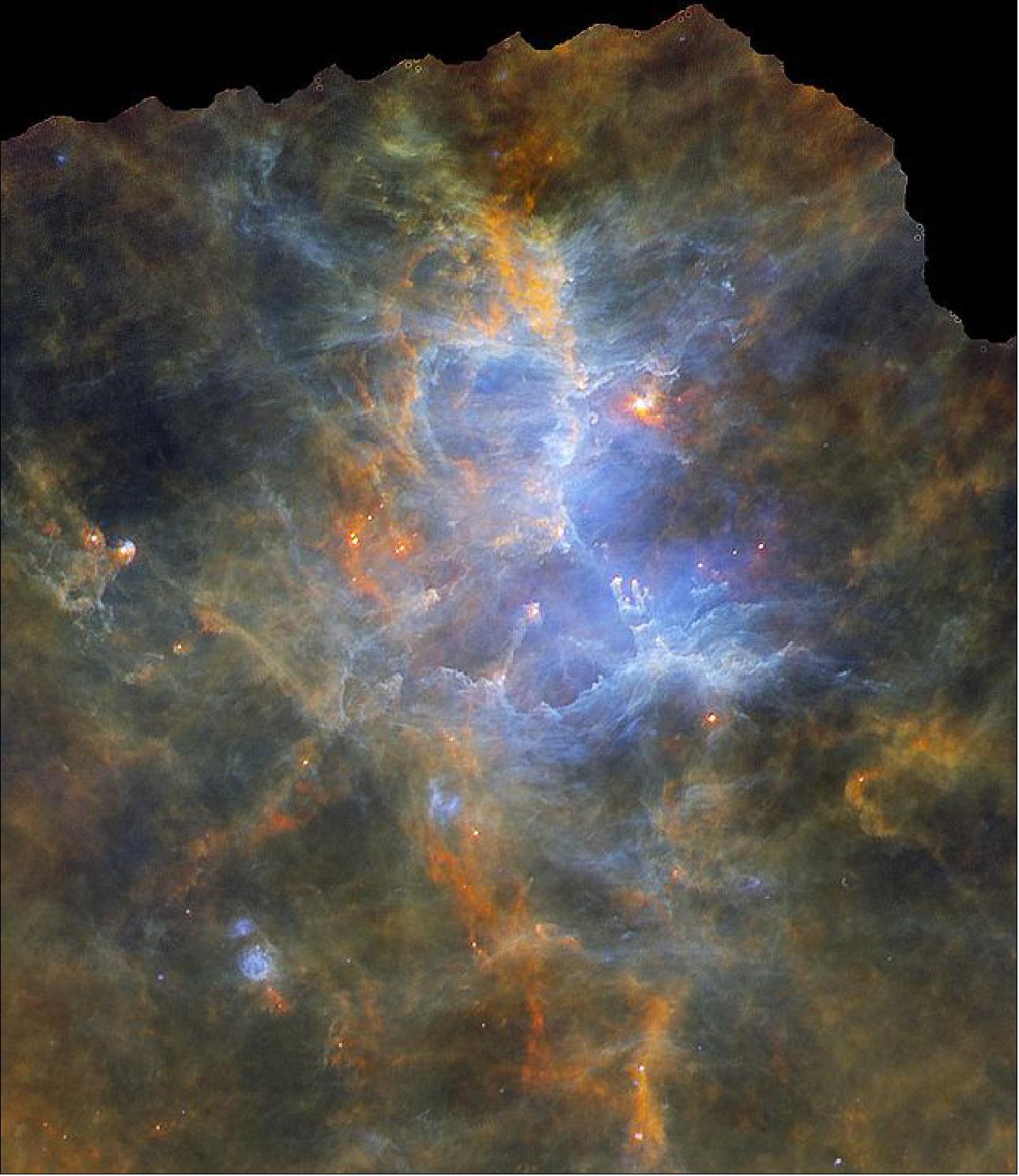
Legend to Figure 41: A group of young, bright stars, not visible at these infrared wavelengths, are located near the center of the image. The powerful light emitted by these stars is setting the surrounding gas ablaze, causing it to shine; the stars also drive mighty winds that are carving the giant cavities in the cloud. At the borders of these cavities, the interstellar mixture of gas and dust becomes denser, eventually collapsing and giving rise to a new generation of stars. The image is a composite of the wavelengths of 70 µm (blue), 160 µm (green) and 350 µm (red).
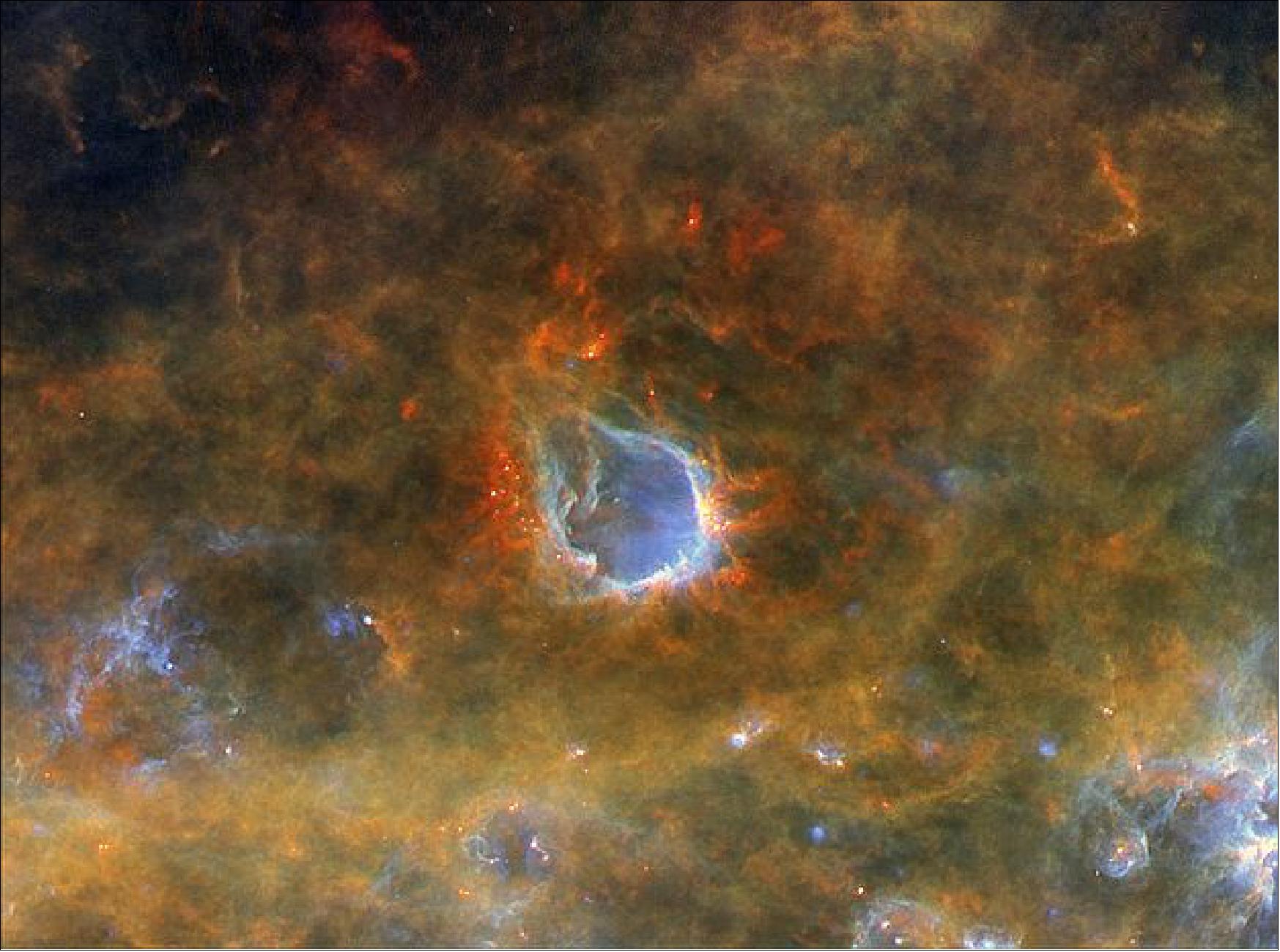
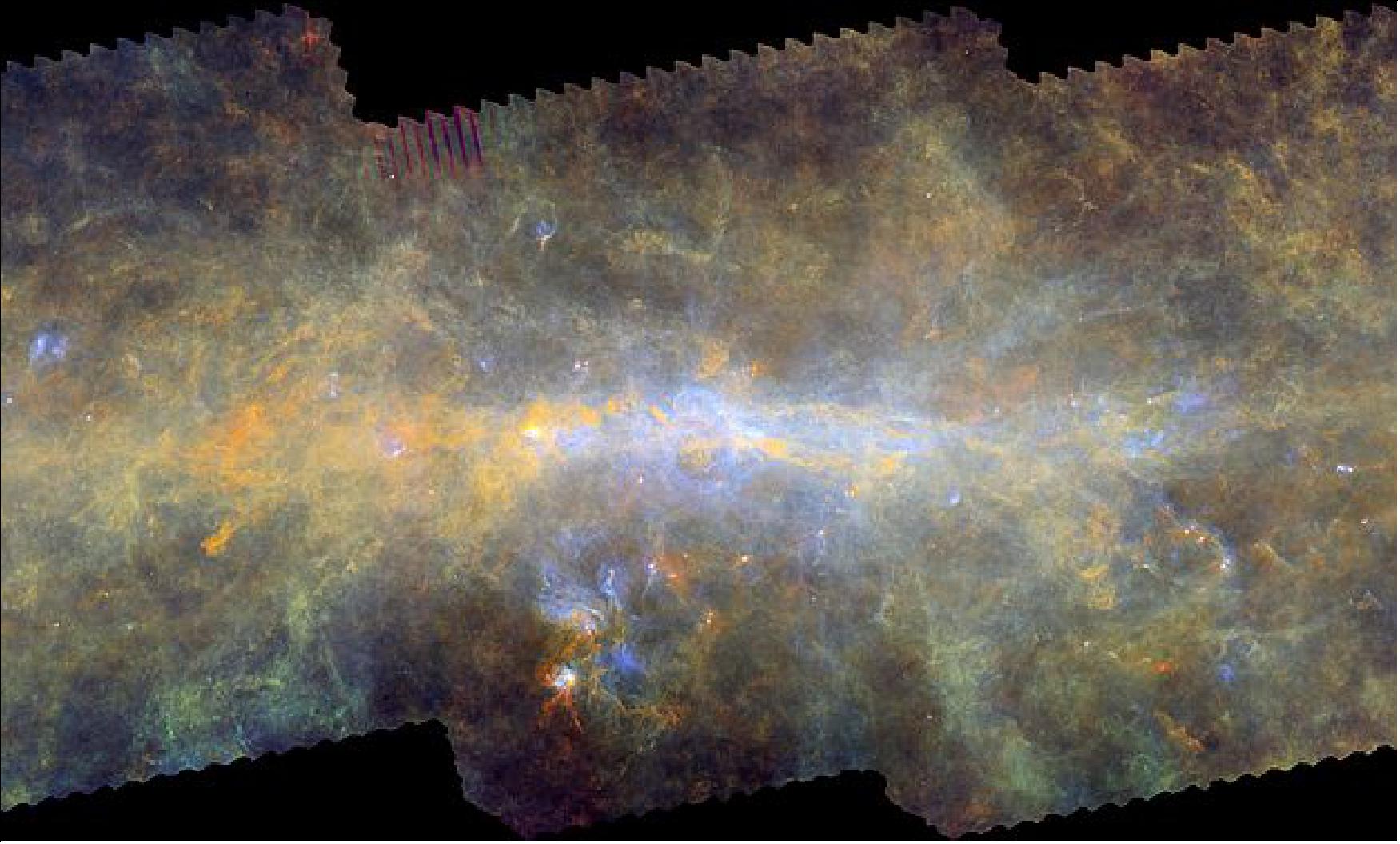

• March 29,2016: Star formation is taking place all around us. The Milky Way is laced with clouds of dust and gas that could become the nursery of the next generation of stars. Thanks to ESA's HSO (Herschel Space Observatory), we can now look inside these clouds and see what is truly going on. 50)
- It may seem ironic but when searching for sites of future star formation, astronomers look for the coldest spots in the Milky Way. This is because before the stars ignite the gas that will form their bulk must collapse together. To do that, it has to be cold and sluggish, so that it cannot resist gravity. - As well as gas, there is also dust. This too is extremely cold, perhaps just 10–20 K above absolute zero. To optical telescopes it appears completely dark, but the dust reveals itself at far-infrared wavelengths.
- One of the surprises is that the coldest parts of the cloud form filaments that stretch across the warmer parts of the cloud. This image shows a cold cloud filament, known to astronomers as G82.65-2.00. The blue filament is the coldest part of the cloud and contains 800 times as much mass as the Sun. The dust in this filament has a temperature of –259ºC. At this low temperature, if the filament contains enough mass it is likely that this section will collapse into stars.
- The image of Figure 45 is color-coded so that the longest infrared wavelength, corresponding to the coldest region, is shown in blue, and the shortest wavelength, corresponding to slightly warmer dust, is shown in red.
- The field of view on display here is a little more than two times the width of the full Moon. It is one of 116 regions of space observed by Herschel as part of the Galactic Cold Cores project. Each field was chosen because ESA's cosmic microwave background mapper, Planck, showed that these regions of the galaxy possessed extremely cold dust.
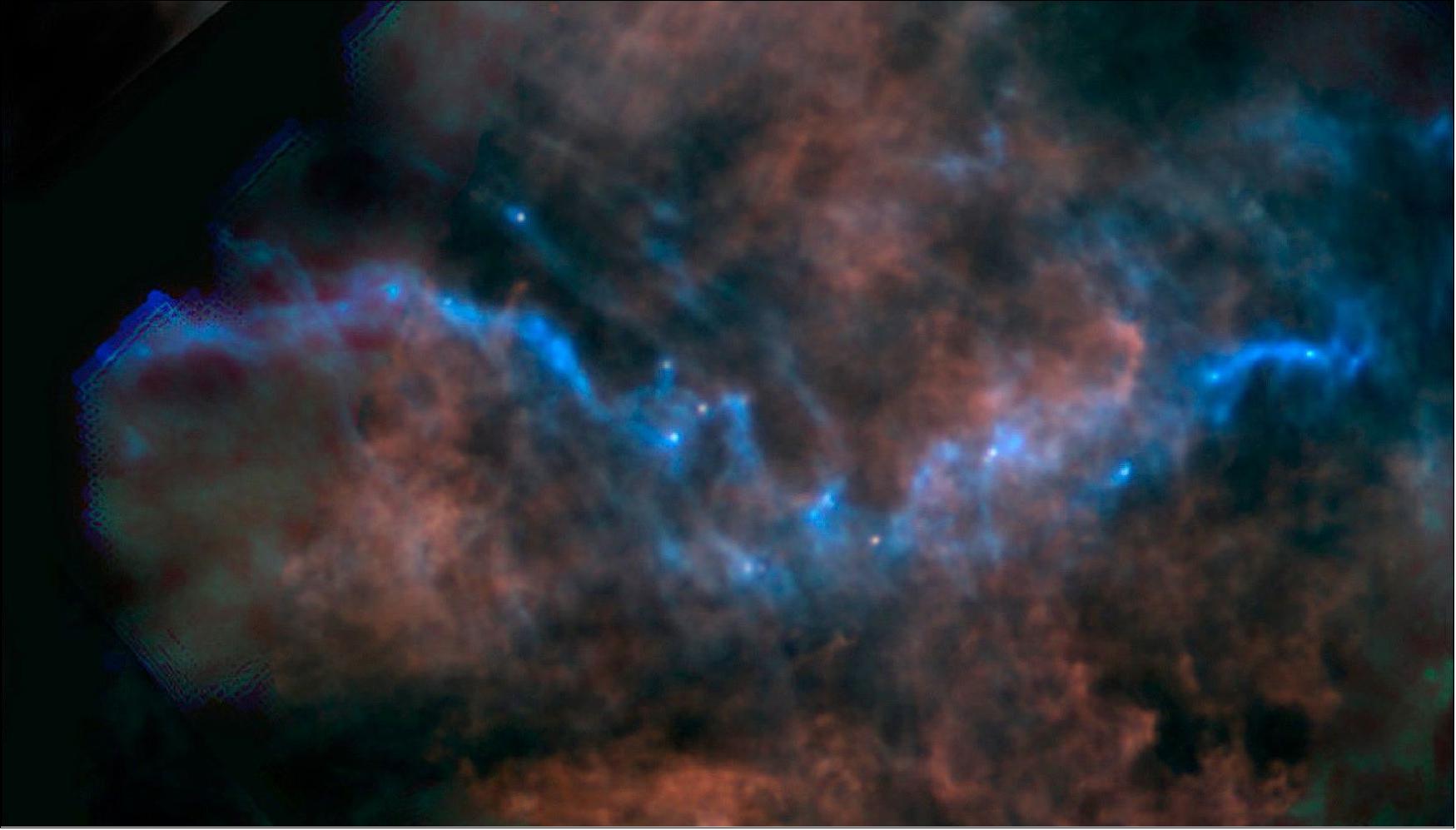
• January 18, 2016: The interstellar medium fills the ‘empty' space between the stars in our galaxy. It is a mix of molecular clouds, cold and warm gases, regions of electrically charged hydrogen, and more. Molecular clouds are the densest part of the interstellar medium, holding most of its mass in the form of hydrogen gas. ESA's Herschel space observatory has revealed that many are built around filaments, with dense threads snaking throughout each cloud. These filaments potentially transport material, and, when massive enough, are known to form new stars. 51)
- The Herschel image (Figure 46) shows the Serpens Core, the heart of a giant molecular cloud. The Core is the bright clump towards the upper right, with a more diffuse secondary cluster, named Ser G3-G6, shown at the bottom right. Also visible as a faint yellow glow towards the upper left of the frame is a region known as LDN 583 that shines brightly in the far-infrared.
- Giant molecular clouds contain up to 10 million times the mass of the Sun, and can stretch for hundreds of light-years. Compared to the rest of space they are dense, holding up to a thousand atoms per cubic centimeter – and even more in star-forming regions. However, these properties are relative: even at their densest, these clouds are more than 10 times emptier than the best laboratory vacuums we can produce on Earth.
- These giant clouds are complex formations, most often made up of filaments mixed with clumpy and irregular folds, sheets and bubble-like structures. A typical spiral galaxy like the Milky Way can contain thousands of them, accompanied by many of their smaller relatives.
- Serpens is an ideal target for scientists wanting to know more about giant molecular clouds, because it lies just 1400 light-years from us. Scientists compared Herschel's observations of this cloud to a state-of-the-art simulation to find out more about the cloud's properties, and to test the accuracy of their model.
- They discovered a radial network of filaments stretching throughout the Serpens Core, filaments that are predicted to break and fragment to form the cores of new stars. These filaments resemble the spokes of a wheel, with the Core forming the hub.
![Figure 46: Herschel reveals filaments in the Serpens Core [image credit: ESA/Herschel/PACS/SPIRE/V. Roccatagliata (University of Munich, Germany)]](https://www.eoportal.org/ftp/satellite-missions/h/HSO_170622/HSO_Auto44.jpeg)
Legend to Figure 46: This three-color image is made from observations with Herschel's PACS camera (blue and green) and SPIRE camera (red). The size of the region shown is 1.7º x 1.9º on the sky, where 1º corresponds to about 25 light years.
• December 21, 2015: Stephan's Quintet of galaxies was discovered by astronomer Édouard Stephan in 1877 (French astronomer, 1831-1923). At the time, however, he reported the discovery of ‘new nebulae', as the concept of other galaxies beyond our Milky Way was only formalized in the 1920s.The image of Stephan's Quintet (Figure 47) combines observations performed at three different wavelengths, with ESA's Herschel and XMM-Newton space observatories as well as with ground-based telescopes, to reveal the different components of the five galaxies. 52)
- Stephan's Quintet is one of the most spectacular galactic groups known, but only four galaxies from the originally discovered quintet are physically linked – the other was later discovered to be much closer to us. NGC 7320, the galaxy in the lower part the image, lies about 40 million light-years from us, rather than the 300 million light-years of the others. One of them is the bright source above NGC 7320 in this view, two are the intertwined galaxies immediately to the right of image center, and the fourth is the round patch towards the lower-right corner.
- Later, it was discovered that an additional galaxy, hidden beyond the left edge of this image, sits at a similar distance to these four galaxies, reinstating the group as a quintet.
- By observing these galaxies in infrared light with Herschel – shown in red and yellow – astronomers can trace the glow of cosmic dust. Dust is a minor but crucial ingredient of the interstellar matter in galaxies, which consists mainly of gas and provides the raw material for the birth of new generations of stars. One galaxy stands out in the infrared light: the nearby NGC 7320, a spiral galaxy busy building new stars.
- Shown in white, the optical light observed from ground-based telescopes reveals the shapes of the four distant galaxies, which exhibit tails and loops of stars and gas. These intricate features are an effect of their mutual gravitational attraction. The intense dynamic activity of the distant group is also portrayed in the distribution of diffuse hot gas, which shines brightly in X-rays and was detected by XMM-Newton.
- Represented in blue, the hot gas appears to sit mostly between the four colliding galaxies. It is likely a mixture of primordial gas predating the formation of the galaxies and intergalactic gas that has been stripped off the galaxies or expelled during their interactions.
- A hint of a shockwave from the interaction of these four galaxies is visible as an almost vertical blue structure on the right of the image center. This structure of hot gas also seems to trace a filament of infrared-bright dust that might have been heated by the shock. - At the top end of the shock, the infrared view reveals stars forming both within and outside the galaxies.
- A faint tail of stars, gas and dust extends towards the left, leading to a dwarf galaxy glowing in infrared – the red and yellow object at the tip of the tail. Further to the left, a dense concentration of hot gas is also visible in blue at the end of the tail, although it is unclear whether it belongs to the galactic group or is a foreground source.
![Figure 47: A multicolor view of the galaxies in Stephan's Quintet as revealed by Herschel, XMM-Newton and ground observatories [image credit: ESA/XMM-Newton (X-rays); ESA/Herschel/PACS, SPIRE (infrared); SDSS (optical)]](https://www.eoportal.org/ftp/satellite-missions/h/HSO_170622/HSO_Auto43.jpeg)
• August 24, 2015: Fierce flashes of light ripple through delicate tendrils of gas in this new image (Figure 48), from ESA's HSO (Herschel Space Observatory), which shows the dramatic heart of a large and dense cosmic cloud known as Mon R2. This cloud lies some 2700 light-years away and is studded with hot, newly-formed stars. 53)
- Packed into the bright center of this region are several hot ‘bubbles' of ionized hydrogen, associated with newborn stars situated nearby. Here, gas heated to a temperature of 10 000 °C quickly expands outwards, inflating and enlarging over time. Herschel has explored the bubbles in Mon R2, finding them to have grown over the course of 100 000 to 350 000 years.
- This process forms bubble-like cavities that lie within the larger Mon R2 cloud. These are known as HII regions and Mon R2 hosts four of them, clustered together in the central blue-white haze of bright light — one at the very center, two stretching out like butterfly wings to the top left and bottom right, and another sitting just above the center. Each is associated with a different hot and luminous B-type star. These stars can be many times the mass of the Sun and usually appear with a blue hue due to their high temperature.
- Astronomers have found that the hot bubbles in Mon R2 are enveloped by vast clouds of cold, dense gas, sitting within the filaments that stretch across the frame. In stark contrast to the gas in the hot bubbles, these clouds can be at temperatures as low as –260 °C, just above absolute zero.
- This particular cluster of HII regions has been studied as part of the Herschel imaging survey of OB young stellar objects, or HOBYS, program. This image combines multiple Herschel observations obtained with the PACS and SPIRE cameras and has been processed to highlight the cloud's clumpy complex of filaments, visible here in great and dramatic detail.
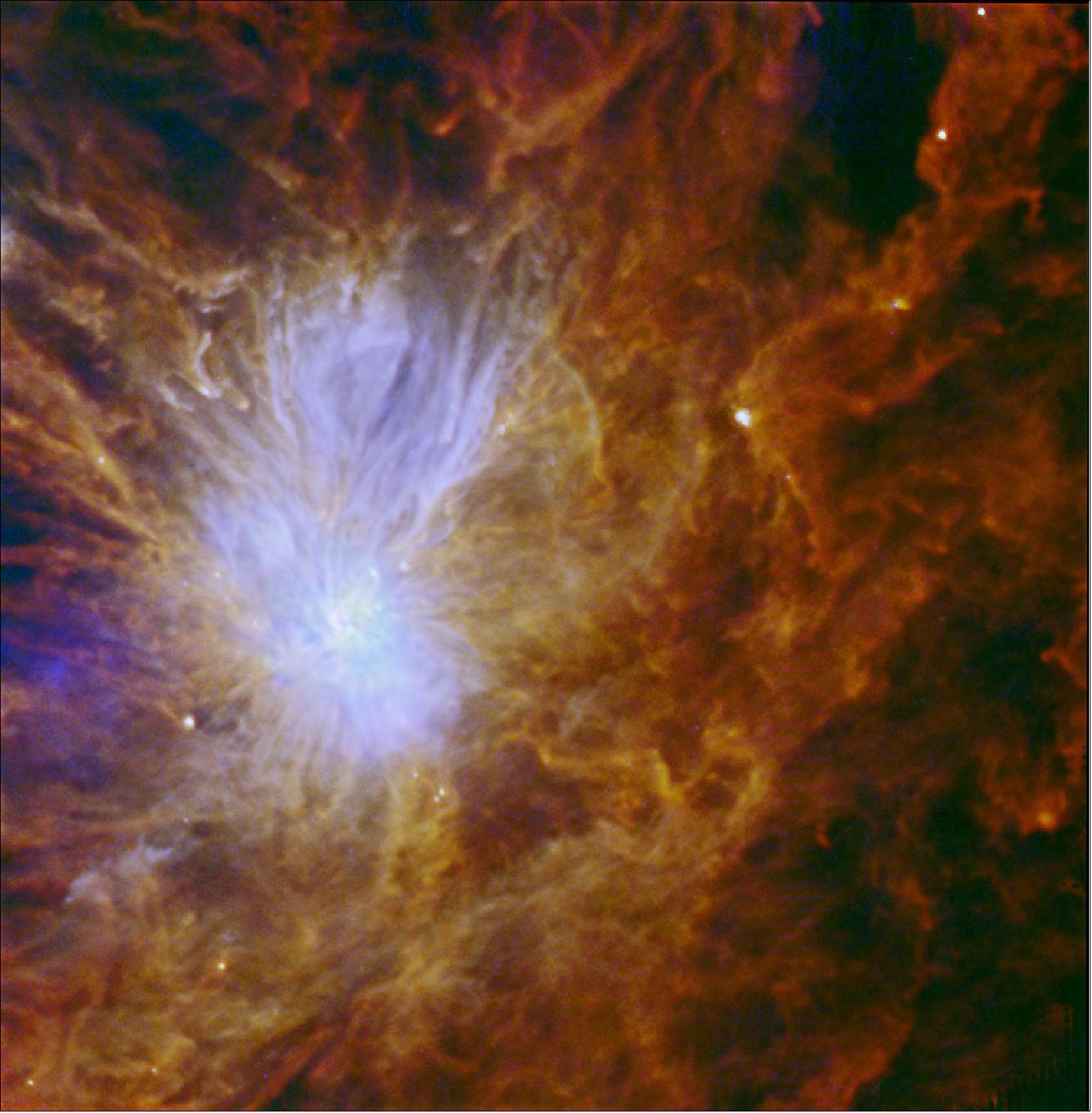
• May 28, 2015: Observations with ESA's Herschel space observatory have revealed that our Galaxy is threaded with filamentary structures on every length scale. From nearby clouds hosting tangles of filaments a few light-years long to gigantic structures stretching hundreds of light-years across the Milky Way's spiral arms, they appear to be truly ubiquitous. The Herschel data have rekindled the interest of astronomers in studying filaments, emphasizing the crucial role of these structures in the process of star formation. 54)
- Stars are born in the densest pockets of the interstellar medium, a diffuse mixture of gas and dust that pervades galaxies, including our Milky Way. One of the most intriguing questions in astrophysics concerns understanding how this material, which is typically characterized by very low density, can come together, creating denser concentrations that later evolve into compact cores and, finally, give birth to stars. — In the search for answers, astronomers observe giant molecular clouds, the cosmic incubators where gas and dust are transformed into stars. While these studies are performed using a variety of techniques, one crucial approach is the observation of infrared light, since the interstellar material shines brightly at these long wavelengths.
- In this context, ESA's Herschel space observatory has been a true game changer. Probing the portion of the electromagnetic spectrum that ranges from the far-infrared to sub-mm wavelengths, it has collected unprecedented data during its three and a half years of observing. One of the key aspects that emerged from these observations is the presence of a filamentary network nearly everywhere in our Galaxy's interstellar medium. The picture that is emerging is that these structures are closely linked to the formation of stars.
- Prior to Herschel, astronomers had already identified several filaments in interstellar clouds and recognized their potential importance for star formation. However, only with the increased sensitivity and spatial resolution granted by this observatory, combined with its large-scale surveys, could they reveal the full extent of filamentary patterns in the Milky Way.
- One of the surveys performed with Herschel – the Gould Belt Survey – focussed on a giant ring of star-forming regions, all located no more than 1500 light-years away from the Sun. The vicinity of these clouds allowed astronomers to obtain exceptionally detailed images using Herschel, unearthing intricate webs of filaments in each region that they examined. — "The greatest surprise was the ubiquity of filaments in these nearby clouds and their intimate connection with star formation," explains Philippe André from CEA/IRFU, France, Principal Investigator for the Herschel Gould Belt Survey. "But there is more: these observations revealed that filaments, which may extend to several light-years in length, appear to have a universal width of about one third of a light year. This suggests that something fundamental is lurking underneath."
- The astronomers are still trying to understand the details of the star formation processes taking place in these clouds, aided by the abundance and variety of data collected with Herschel. While most filaments are dotted with compact cores, suggesting that stars are readily taking shape in these dense 'fibers' of the interstellar medium, there are also regions that exhibit complex tangles of filaments but no signs of on-going star formation. A study of the most spectacular example of this phenomenon, the Polaris Flare, indicates that filaments must somehow precede the onset of star formation.
- The scenario that has emerged from the new Herschel data suggests that star formation proceeds in two steps: first, turbulent motions of the interstellar gas and dust create an intricate web of filamentary structures; then, gravity takes over, causing only the densest filaments to contract and fragment, eventually leading to the formation of stars. — Indeed, the universal width of filaments seems to correspond, at least in the nearby clouds of the Gould Belt Survey, to the scale at which interstellar material undergoes the transition from supersonic to subsonic state.
- In addition, the material along filaments is not at all static: astronomers have detected what appear to be accretion flows, with the most prominent filaments drawing matter from their surroundings through a network of smaller filaments. A striking example of such processes is seen in the Taurus Molecular Cloud, where the B211/B213 filament exhibits a series of so-called 'striations' perpendicular to the main filament. This pattern is very similar to that predicted from numerical simulations that model the process of star formation in molecular clouds. According to these simulations, interstellar material flows towards dense filaments along routes that are parallel to the direction of the local magnetic field, as was observed, so the new data indicate the importance of interstellar magnetic fields in shaping these structures.
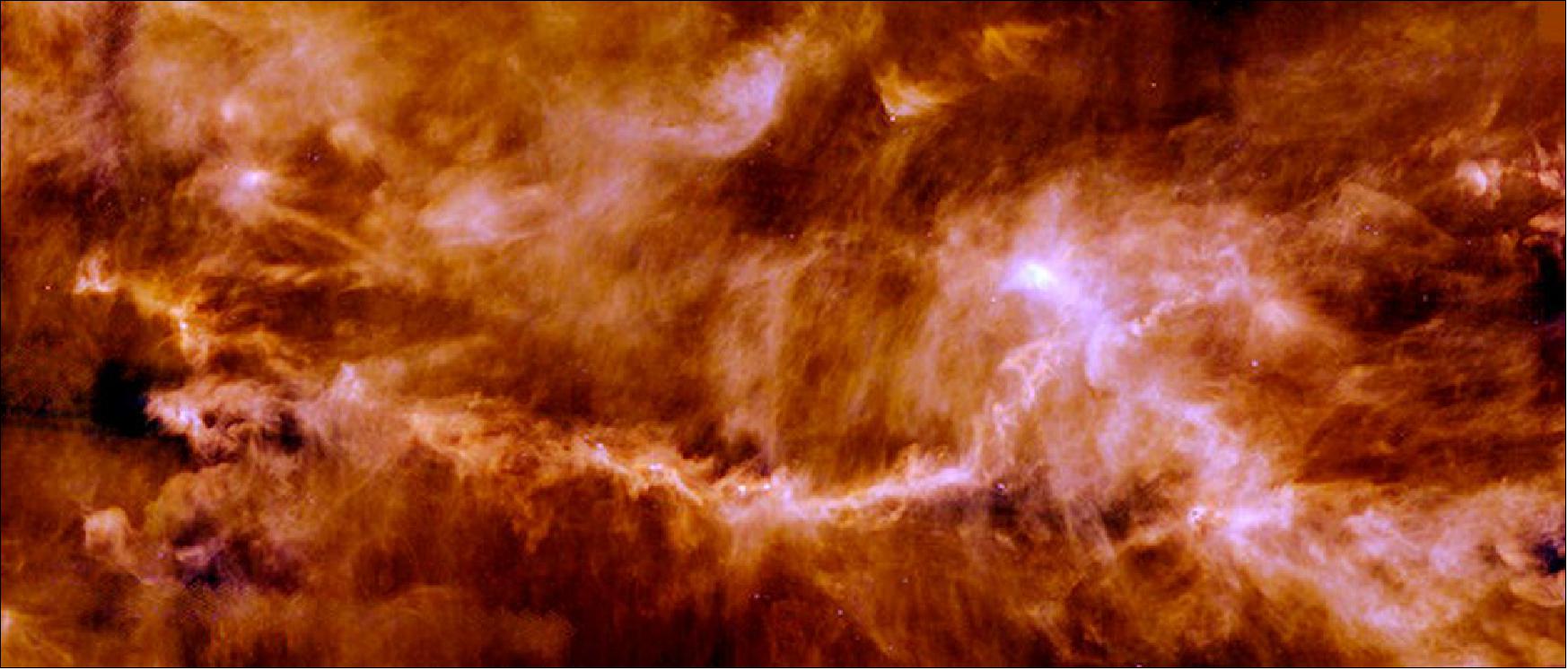
Legend to Figure 49: The three-color image of the B211/B213 filament in the Taurus Molecular Cloud combines Herschel bands at 160 µm (blue), 250 µm (green) and 500 µm (red). The image spans about 2 x 5 degrees.
Taurus is a star-forming region about 450 light-years away. This image shows the glow of cosmic dust in the interstellar material that pervades the cloud, revealing an intricate pattern of filaments dotted with a few compact, bright cores: the seeds of future stars. The B211/B213 filament is an example of how the material along filaments is not at all static: astronomers have detected what appear to be accretion flows, with the most prominent filaments drawing matter from their surroundings through a network of smaller filaments, or 'striations', perpendicular to the main filament.
- However, star formation does not appear to take place only in filaments. While these structures seem to be the preferred sites for stellar birth, the extraordinary data from Herschel confirmed that a small fraction of stars may also form far away from dense filaments. — In particular, a detailed study of the L1641 molecular clouds in the Orion A complex suggests that star formation along filaments is the preferential channel to produce typical solar-type stars, while stars that are born away from these dense, elongated structures tend to have lower masses. This dichotomy could be a result of the greater availability of raw material to protostars that are forming on a filament compared to those that take shape in less dense environments.
- Another of Herschel's key findings is that the presence and abundance of filaments are not limited to our immediate neighborhood. In fact, these structures appear everywhere also in the Herschel infrared Galactic Plane Survey (Hi-GAL), which scanned the distribution of the interstellar medium in the huge disc – about 100 000 light-years across – where most of the Milky Way's stars form and reside.

- Further investigation of the Hi-GAL survey has revealed new and even more prominent filaments, extending over hundreds of light-years and weaving their way through the spiral arms of the Milky Way. The study revealed nine filaments in some very dense, inner regions of the Galactic Plane, detecting these for the first time through the direct emission of dust within them, allowing an accurate determination of their mass, size and physical characteristics. Astronomers believe that almost a hundred similar, gigantic structures are still hiding in the data.
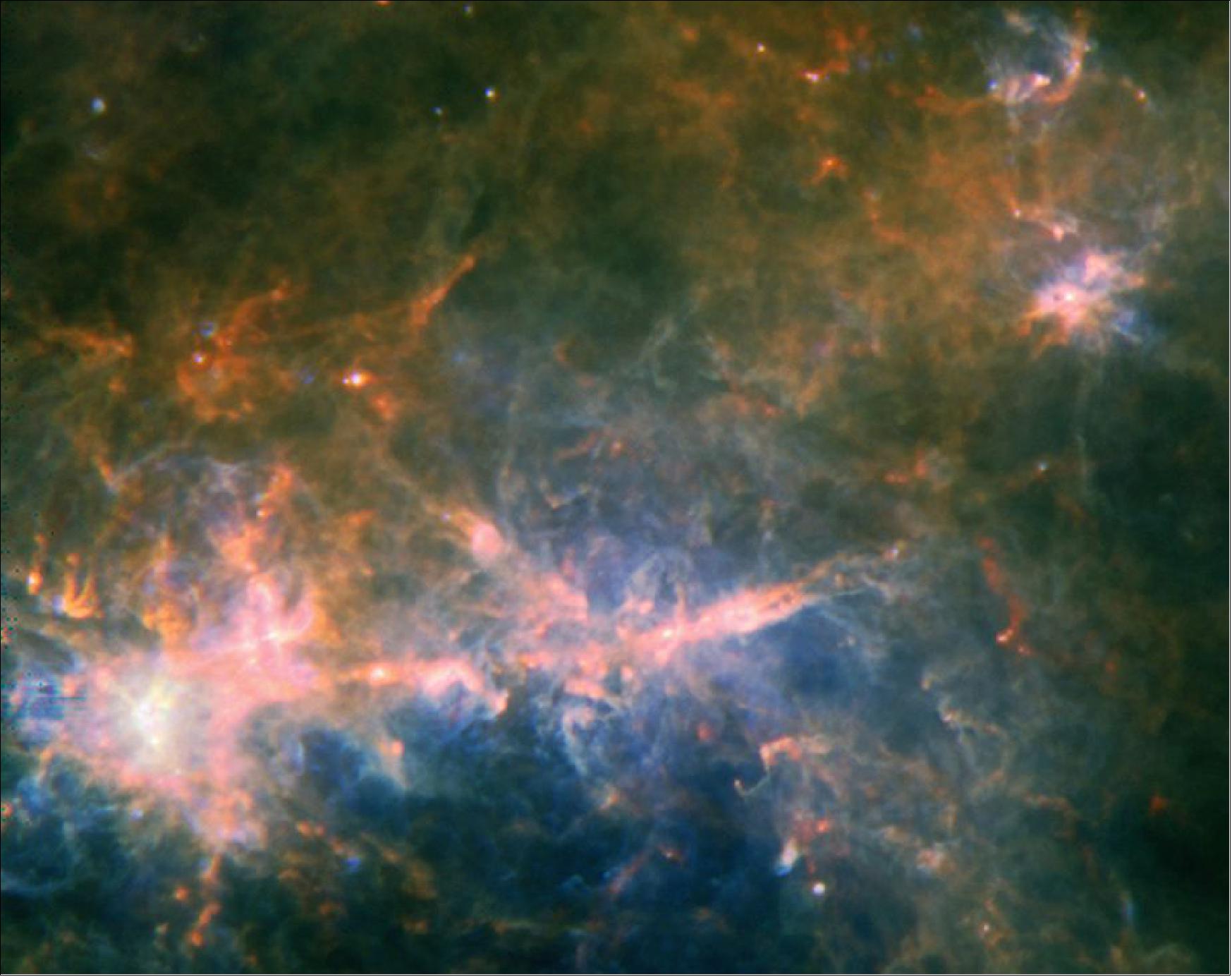
Legend to Figure 51: Cooler gas and dust is seen in red and yellow, with temperatures as low as 21 K. In the densest and coolest clumps, the seeds of new generations of stars are taking shape. A brighter clump of matter is visible at the left tip of the wispy thread. This filament is about 18 000 light-years away. - The image is a composite of the wavelengths of 70 µm (blue), 160 µm (green) and 350 µm (red) and spans about 1.17 x 0.93º. The image is oriented with northeast towards the left of the image and southwest towards the right.
• March 25, 2015: Astronomers using ESA's Herschel space observatory have found that the winds blowing from a huge black hole are sweeping away its host galaxy's reservoir of raw star-building material. Found at the hearts of most galaxies, supermassive black holes are extremely dense and compact objects with masses between millions and billions of times that of our Sun. Many are relatively passive, like the one sitting at the center of our Milky Way. However, some of them are devouring their surroundings with a great appetite. 56)
- Until now, it had not been possible to capture a complete view of this process. While astronomers were able to detect winds very close to black holes using X-ray telescopes, and to trace much larger galactic outflows of gas molecules through infrared observations, they had not succeeded at finding both in the same galaxy. A new study has changed the scene, detecting winds driven by one particular black hole from the smallest to largest scales. The study is based on observations performed with the PACS (Photoconductor Array Camera and Spectrometer) instrument on ESA's Herschel space observatory, as well as on data from the Japanese/US Suzaku mission. 57)
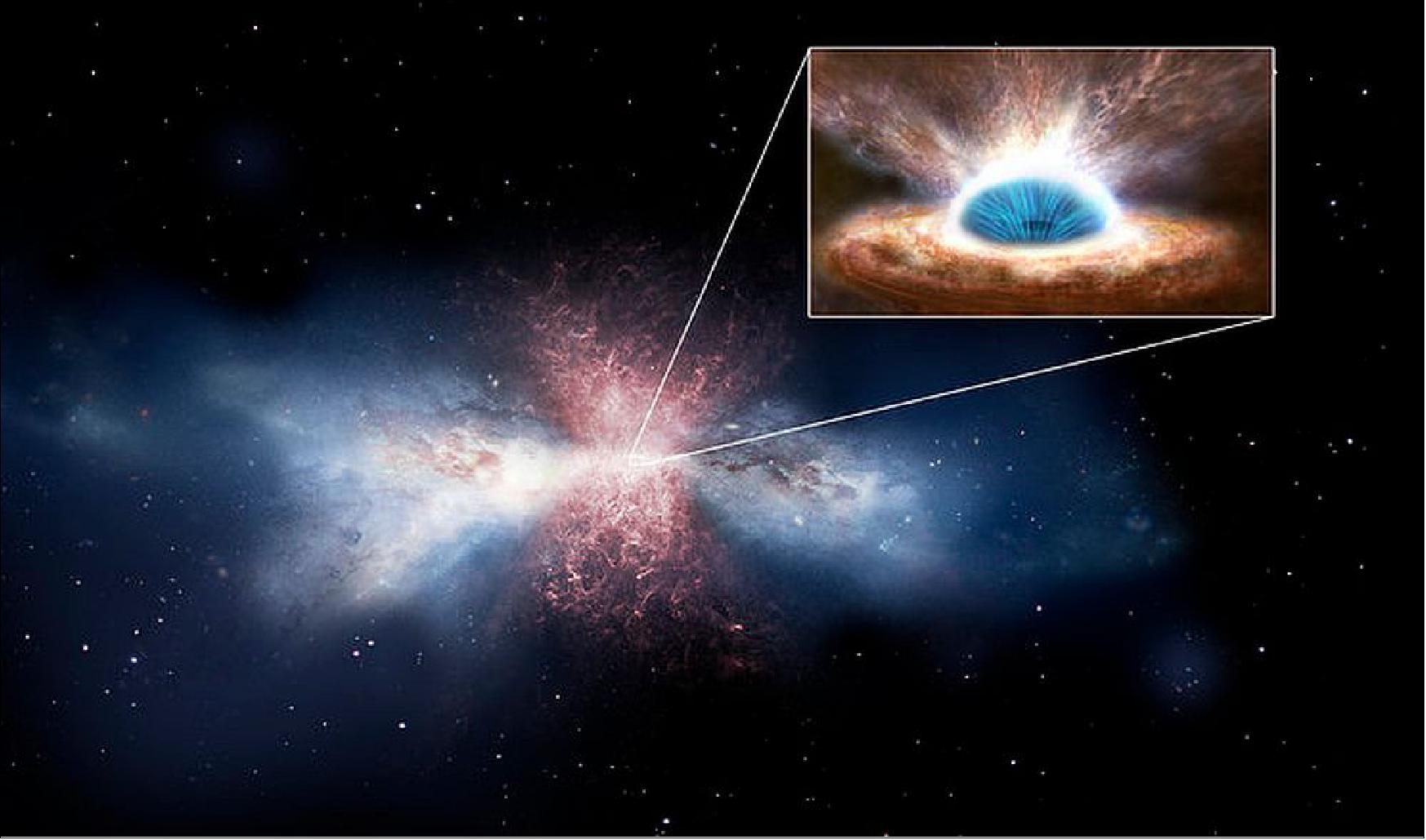
Legend to Figure 52: Astronomers studying the supermassive black hole at the center of the galaxy IRAS F11119+3257 have found proof that the winds blowing from the black hole are sweeping away the host galaxy's reservoir of raw star-building material. - The finding was made using ESA's Herschel space observatory, together with the Suzaku X-ray astronomy satellite (ASTRO-EII of JAXA, launch July 10, 2005). Combining these data, the astronomers detected the winds being driven by the central black hole in X-rays, and their global effect, pushing the galactic gas away, at infrared wavelengths.
The winds start small and fast, gusting at about 25% the speed of light in the vicinity of the black hole and blowing away about the equivalent of one solar mass of gas every year. As they progress outwards, the winds slow but sweep up an additional 800 solar masses of molecular gas per year and push it out of the galaxy. This is the first solid proof that black-hole winds are depriving their host galaxies of molecular gas and might ultimately stop their star formation activity.
• Feb. 23, 2015: The image of Figure 53 is a collaboration of ESA's HSO (Herschel Space Observatory) and NASA's Spitzer Space Telescope missions; it is an picture of the Small Magellanic Cloud, one of our nearest extragalactic neighbors in the infrared spectrum. The Large and Small Magellanic Clouds are the two biggest satellite galaxies of our home galaxy, the Milky Way, though they are still considered dwarf galaxies compared to the big spiral of the Milky Way. 58) 59)
In combined data from Herschel and Spitzer, the irregular distribution of dust in the Small Magellanic Cloud becomes clear. A stream of dust extends to the left in this image, known as the galaxy's "wing," and a bar of star formation appears on the right.
The colors in Figure 53 indicate temperatures in the dust that permeates the Cloud. Colder regions show where star formation is at its earliest stages or is shut off, while warm expanses point to new stars heating surrounding dust. The coolest areas and objects appear in red, corresponding to infrared light taken up by Herschel's SPIRE (Spectral and Photometric Imaging Receiver) at 250 µm. Herschel's PACS (Photodetector Array Camera and Spectrometer) fills out the mid-temperature bands, shown here in green, at 100 and 160 µm. The warmest spots appear in blue, data from Spitzer's MIPS (Multiband Imaging Photometer) at 24 and 70 µm.
The slight green tint stretching towards the left of the frame and the red hue of the main body of the galaxy are from the Herschel observations, which highlight cold material, down to a chilly –260ºC. The brighter patches of blue were captured by Spitzer. These regions are made up of ‘warmer' —about –150º C — gas and dust, and within some of these areas new stars are being born. These newborn stars in turn warm up their surroundings, resulting in intense clumps of heated gas and dust within the galaxy.
These clumps show up brightly in this image, tracing the shape of the galaxy clearly — the SMC (Small Magellanic Cloud) is made up of a central ‘bar' of star formation, visible on the right hand side, and then a more extended ‘wing', stretching out towards the left of the frame.
Overall, the Small Magellanic Cloud is about 1/20th of the size of the Milky Way. It can be seen shining in the night sky of the southern hemisphere, and its brightest regions are easily visible to the naked eye.
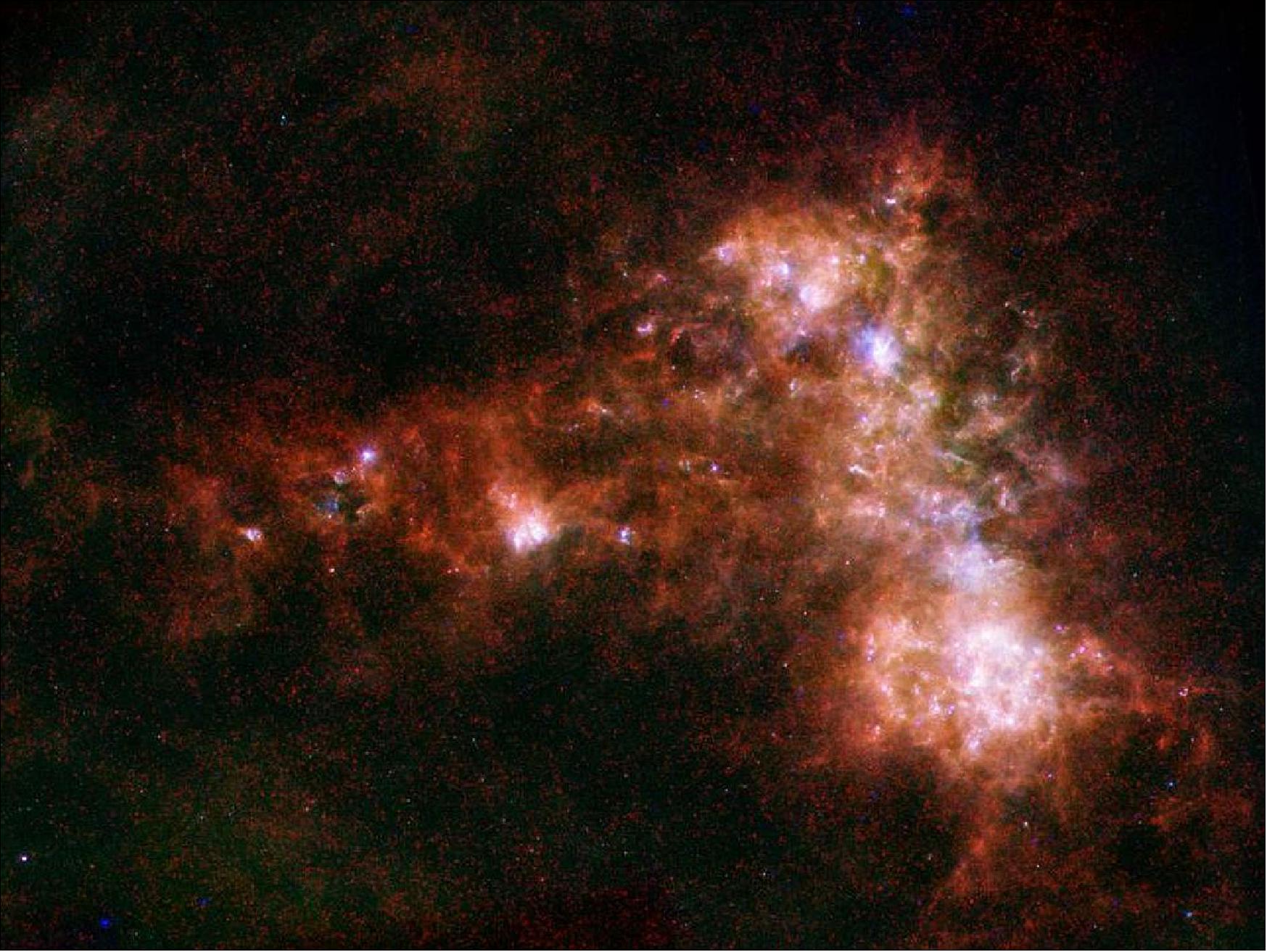
• Dec. 18, 2014: Astronomers using ESA's Herschel space observatory have found, for the first time, fireworks of star birth within galaxies at the dense core of a massive early Universe galaxy cluster. This frenzy of star formation reveals the young lives of now "red and dead" elliptical galaxies and gives new clues to the evolution of some of the largest structures in the Universe. 60) 61)
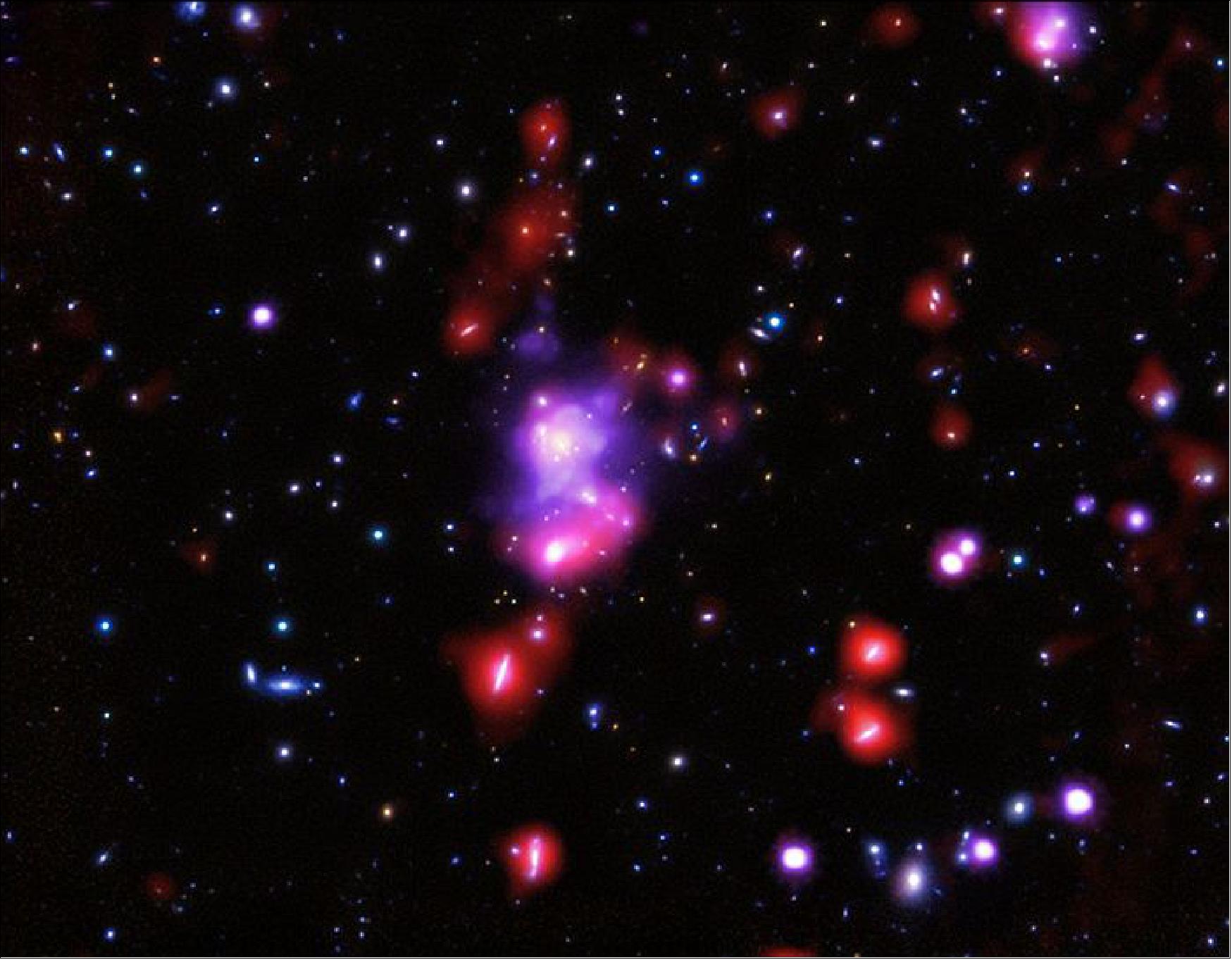
Legend to Figure 54: The purple/pink in the image corresponds to infrared emission measured by Herschel and X-ray emission detected with NASA's Chandra telescope. The infrared data from ESA's Herschel telescope has revealed where interstellar dust in the cluster's core is being heated by young, hot, stars. This is the first time that star formation has been found in the core of a cluster of this size and age. The X-ray data were used to map the mass of this giant cluster. — These data have been combined with optical and near-infrared images of the cluster captured by the National Astronomical Observatory of Japan's Subaru telescope and the ESO (European Southern Observatory) VLT (Very Large Telescope), the data from which are colored red, green and blue in this image.
XDCPJ0044.0-2033 is a massive galaxy cluster with an estimated mass of about four hundred thousand billion times that of our Sun. It lies at a redshift of almost 1.6, meaning that we see it as it was 9.6 billion years ago.
- Among the biggest questions faced by today's astronomers are how and where galaxies form their stars and how this has changed over cosmic time. The answers are likely to lie in the Universe's galaxy clusters, gravitationally bound groups of hundreds, or even thousands, of galaxies which provide a valuable laboratory to explore the birth of stars and how galaxies evolve.
- The galaxy clusters we observe in the local Universe exist more or less in the present; 13.8 billion years after the Big Bang. Observing clusters in this late epoch of the Universe's history means we are seeing them after a long period of evolution, and it shows.
- The red and dead elliptical galaxies concentrated in the densely packed and aging cores of these local clusters are devoid of bright blue stars, making them appear "red" and, for the most part, they also lack the gas reservoirs needed to create new stars. This makes these galaxies, for all intents and purposes, "dead", and means that star formation in the present day is limited to the cluster outskirts, or in the regions outside these giant clusters, taking place only in low density environments.
- Using Herschel, the team searched XDCPJ0044.0-2033 for the far-infrared radiation that would reveal interstellar dust was being heated by young, hot, stars. They found clear signs of vigorous star formation within the cluster's galaxies. Because the clues to quantifying star formation lie in a cluster's infrared signature Herschel is the perfect telescope for the job. Herschel has allowed astronomers to map the star formation in these clusters by measuring the far-infrared emission from the particles of dust that are mixed in with the gas associated with star birth.
- By mapping the infrared radiation from the galaxies the team was able to work out how hot the gas and dust within the galaxies was and what amount of star birth would be needed to heat it to this level. By doing this for galaxies in the inner region of the cluster, an area measuring over one and half million light years across, the team found that the cluster has a star formation rate of almost two thousand solar masses per year, four times the rate found in its outer regions.
- The detection of such an unprecedented level of star formation in the cluster makes the discovery a first for clusters of this mass and tells us that we are witnessing a very early stage in galaxy cluster evolution. These, potentially fleeting, fireworks will form huge numbers of stars before, at some stage, the process halts and the cluster's core becomes like those we see in our local Universe – filled with aging elliptical galaxies.
- The true significance of this prolificacy of star formation is evident when compared to other clusters of a similar mass. The cluster XMMU J2235.3-2557, for example, has a very similar mass and lies only a little more than half a billion years later in cosmic history at 4.8 billion years after the Big Bang and yet shows no signs of star formation in its inner regions. Nor does a significant amount of star formation take place in the inner regions of any massive cluster found between us and XDCPJ0044.0-2033. Finding star birth in the core of XDCPJ0044.0-2033 is an important step towards establishing at what period in cosmic history the star formation preference changed from the high density environments in cluster cores, as with XDCPJ0044.0-2033 just 4.1 billion years after the Big Bang, to the low density settings outside clusters, like the star formation we see in our local Universe. To better determine the epoch in which this change occurred astronomers will need to find and study other massive clusters at these large look-back times and search for signs of star birth in their cores.
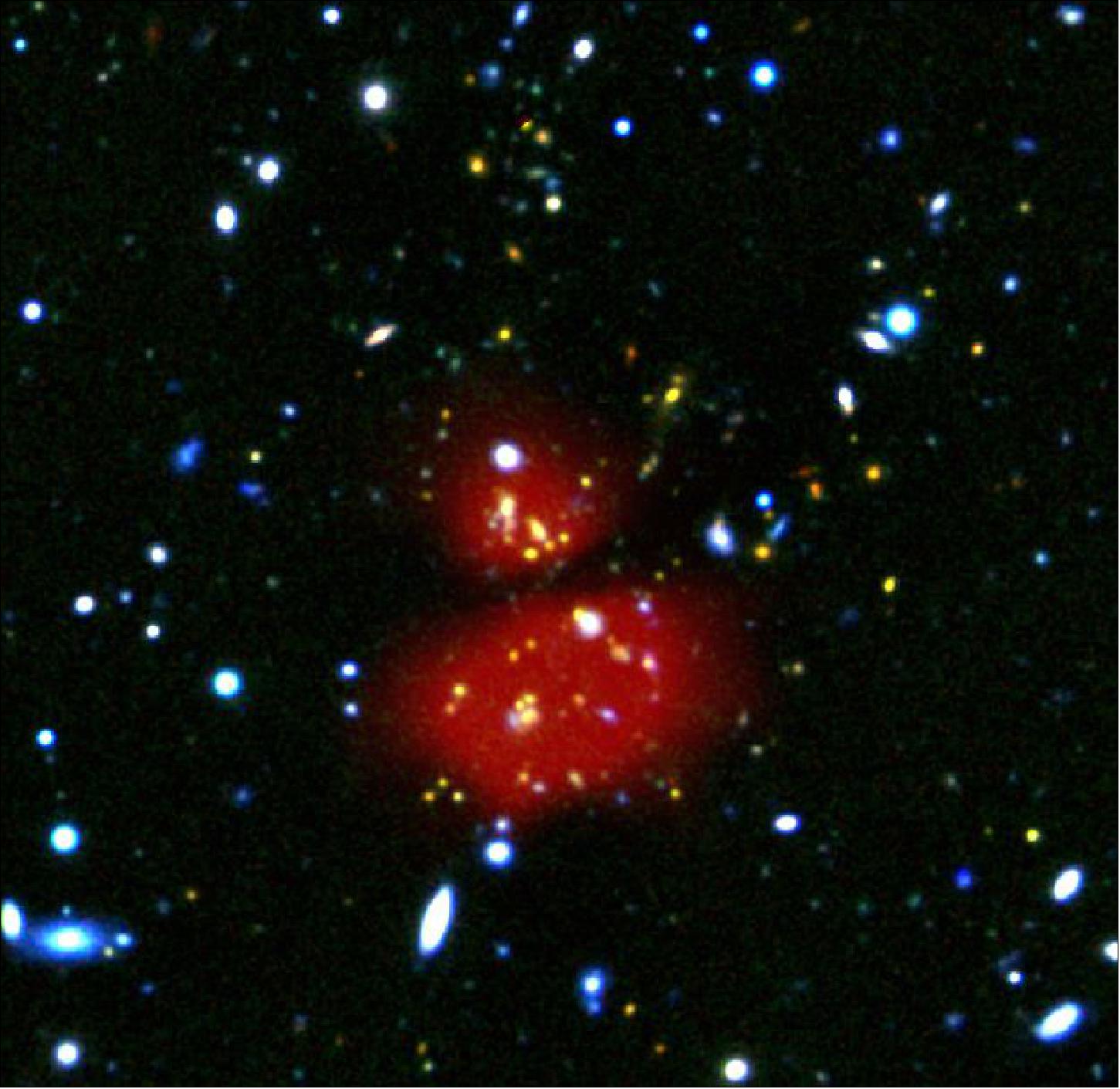
Legend to Figure 55: The image is constructed from Ks (mapped to the red channel), J (green channel) and I (blue channel) band images obtained with the VLT and Subaru telescopes. The red glow at the center of the image represents far-infrared emission (at 100 µm) from the galaxies located in the cluster core as measured by Herschel's PACS instrument; it has been heavily smoothed in this image.
• Figure 56 was released on July 28, 2014 by ESA showing the nearby M33 galaxy blossoming with star birth. The spiral galaxy M33, also known as the Triangulum Galaxy, is one of our closest cosmic neighbors, just three million light years away. Home to some forty billion stars, it is the third largest in the Local Group of galaxies after the Andromeda Galaxy (M31) and our own Milky Way. 62)
M33 is popular with astrophotographers and from exceptionally dark sites it can even be seen with the naked eye. Thanks to its orientation, we can enjoy a face-on view of the beautiful spiral structure of the galaxy's disc.
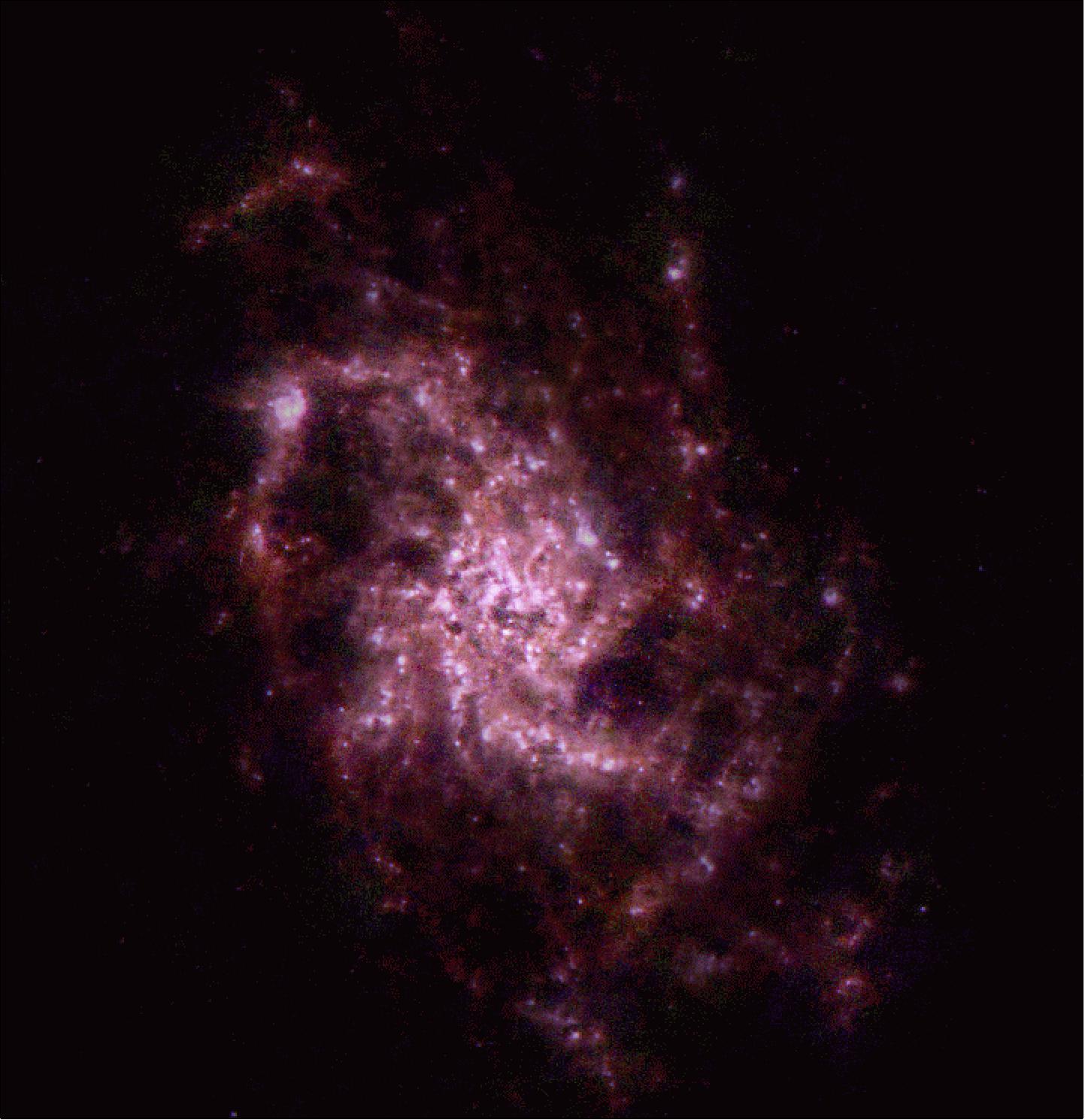
Legend to Figure 56: The Herschel image shows M33 in far-infrared light, revealing the glow of cosmic dust in the interstellar medium that permeates the galaxy. The patchy, disorganized structure of M33's spiral arms resembles a tuft of wool, leading astronomers to classify it as a flocculent spiral galaxy. The brightest spots sprinkled along the spiral arms are dense pockets of gas and dust where massive stars are born. The most prominent of these is NGC604, visible in the upper left spiral arm. This is an enormous star-forming region where hundreds of thousands of stars are taking shape.
The image is a composite of the wavelengths: 70 µm (blue), 100 µm (green) and 160 µm (red). At the shortest wavelengths, astronomers trace warmer dust, revealing individual regions of star formation and parent clouds. At longer wavelengths, they detect emission from colder dust, outlining some of the cool dust reservoir along the galaxy's winding spiral arms. This is where stars may be born in the future.
The image spans about one degree on each side; north is up and east is to the left. The data were collected with Herschel's PACS instrument as part of the Herschel M33 extended survey (HerM33es) Key Program to study the star formation in the Triangulum Galaxy.
• July 1, 2014: Astronomers using data from ESA's HSO (Herschel Space Observatory) to probe the turbulent beginnings of a Sun-like star have found evidence of mighty stellar winds that could solve a puzzling meteorite mystery in our own back yard. 63)
In spite of their tranquil appearance in the night sky, stars are scorching furnaces that spring to life through tumultuous processes – and our 4.5 billion-year-old Sun is no exception. To glimpse its harsh early days, astronomers gather clues not only in the Solar System but also by studying young stars elsewhere in our Galaxy.
Using Herschel to survey the chemical composition of regions where stars are being born today, a team of astronomers has noticed that one object in particular is different. The unusual source is a prolific stellar nursery called OMC2 FIR4, a clump of new stars embedded in a gaseous and dusty cloud near to the famous Orion Nebula (Figure 57).
The Herschel research team found evidence that the proportion of two chemical species, one based on carbon and oxygen and the other on nitrogen, is much smaller in this object than in any other protostar known. In an extremely cold environment, the measured proportion could arise by one of the two compounds freezing onto dust grains and becoming undetectable. However, at the relatively 'high' temperature of about –200°C found in star-forming regions like OMC2 FIR4, this should not occur. The most likely cause in this environment is a violent wind of very energetic particles, released by at least one of the embryonic stars taking shape in this proto-stellar cocoon. 64)
The most abundant molecule in star-forming clouds, hydrogen, can be broken apart by cosmic rays, energetic particles that permeate the entire Galaxy. The hydrogen ions then combine with other elements that are present – albeit only in trace amounts – in these clouds: carbon and oxygen, or nitrogen.
Normally, the nitrogen compound is also quickly destroyed, yielding more hydrogen for the carbon and oxygen compound. As a result, the latter is far more abundant in all known stellar nurseries. Strangely enough, though, this was not the case for OMC2 FIR4, suggesting that an additional wind of energetic particles is destroying both chemical species, keeping their abundances more similar.
Astronomers think that a similarly violent wind of particles also gusted through the early Solar System, and this discovery might finally point to an explanation for the origin of a particular chemical element seen in meteorites. - Meteorites are the remains of interplanetary debris that survived the trip through our planet's atmosphere. These cosmic messengers are one of the few tools we have to directly probe the elements in our Solar System.
The formation of the isotope – beryllium-10 – in the Universe is an intricate puzzle of its own. Astronomers know that it is not produced in the interior of stars, like some other elements, nor in the supernova explosion that happens at the end of a massive star's life. The majority of beryllium-10 was formed in collisions of very energetic particles with heavier elements like oxygen. But since this isotope decays very quickly into other elements, it must have been produced just before it was incorporated in the rocks that would later appear on Earth as meteorites. In order to trigger these reactions and produce an amount of beryllium matching that recorded in meteorites, our own Sun must have blown a violent wind in its youth.
These new observations of OMC2 FIR4 give a very strong hint that it is possible for a young star to do this. The study is based on observations performed with HIFI (Heterodyne Instrument for the Far-Infrared) on Herschel, as part of the Herschel Guaranteed Time Key Program CHESS (Chemical HErschel Surveys of Star forming regions).
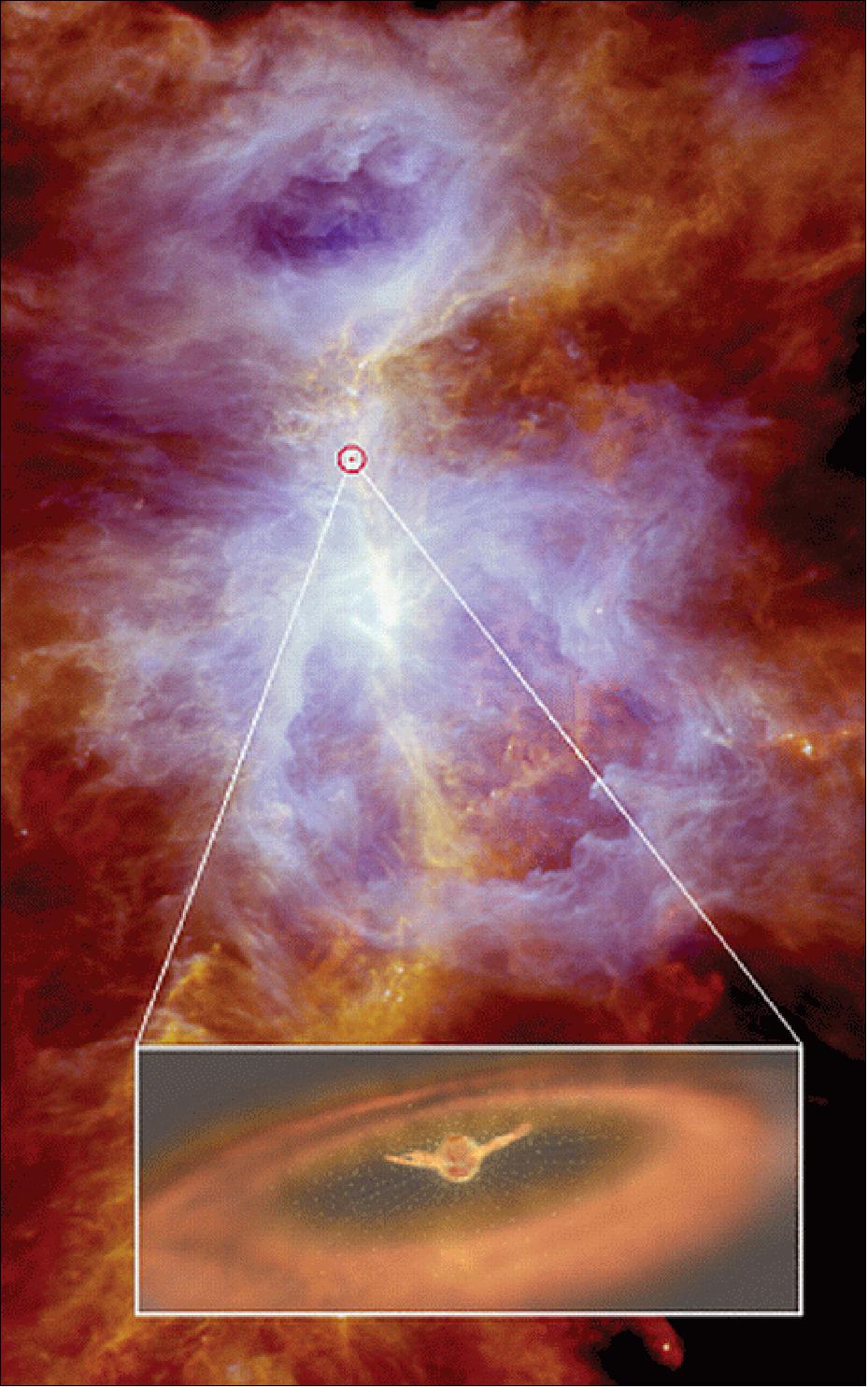
• June 17, 2014: Using data from ESA's HSO, astronomers have discovered that a molecule vital for creating water exists in the burning embers of dying Sun-like stars. When low- to middle-mass stars like our Sun approach the end of their lives, they eventually become dense, white dwarf stars. In doing so, they cast off their outer layers of dust and gas into space, creating a kaleidoscope of intricate patterns known as planetary nebulas. 65)
These actually have nothing to do with planets, but were named in the late 18th century by astronomer William Herschel, because they appeared as fuzzy circular objects through his telescope, somewhat like the planets in our Solar System. — Over two centuries later, planetary nebulas studied with William Herschel's namesake, the HSO (Herschel Space Observatory), have yielded a surprising discovery.
Like the dramatic supernova explosions of greater mass stars, the death cries of the stars responsible for planetary nebulas also enrich the local interstellar environment with elements from which the next generations of stars are born.
While supernovas are capable of forging the heaviest elements, planetary nebulas contain a large proportion of the lighter 'elements of life' such as carbon, nitrogen, and oxygen, made by nuclear fusion in the parent star.
A star like the Sun steadily burns hydrogen in its core for billions of years. But once the fuel begins to run out, the central star swells into a red giant, becoming unstable and shedding its outer layers to form a planetary nebula. The remaining core of the star eventually becomes a hot white dwarf pouring out ultraviolet radiation into its surroundings.
This intense radiation may destroy molecules that had previously been ejected by the star and that are bound up in the clumps or rings of material seen in the periphery of planetary nebulas. The harsh radiation was also assumed to restrict the formation of new molecules in those regions.
But in two separate studies using Herschel astronomers have discovered that a molecule vital to the formation of water seems to rather like this harsh environment, and perhaps even depends upon it to form. The molecule, known as OH+, is a positively charged combination of single oxygen and hydrogen atoms.
In one study, led by Dr. Isabel Aleman of the University of Leiden, the Netherlands, 11 planetary nebulas were analyzed and the molecule was found in just three. 66) - What links the three is that they host the hottest stars, with temperatures exceeding 100 000°C. The study team thinks, that a critical clue is in the presence of the dense clumps of gas and dust, which are illuminated by UV and X-ray radiation emitted by the hot central star. This high-energy radiation interacts with the clumps to trigger chemical reactions that leads to the formation of the molecules.
Another study, led by Dr. Mireya Etxaluze of the Instituto de Ciencia de los Materiales de Madrid, Spain, focused on the Helix Nebula, one of the nearest planetary nebulas to our Solar System, at a distance of 700 light years. 67)
The central star is about half the mass of our Sun, but has a far higher temperature of about 120 000°C. The expelled shells of the star, which in optical images appear reminiscent of a human eye, are known to contain a rich variety of molecules. Herschel mapped the presence of the crucial molecule across the Helix Nebula, and found it to be most abundant in locations where carbon monoxide molecules, previously ejected by the star, are most likely to be destroyed by the strong UV radiation.
Once oxygen atoms have been liberated from the carbon monoxide, they are available to make the oxygen–hydrogen molecules, further bolstering the hypothesis that the UV radiation may be promoting their creation.
![Figure 58: Water-building molecule in the Helix Nebula [image credit: Hubble image: NASA/ESA/C. R. O'Dell (Vanderbilt University), M. Meixner & P. McCullough (STScI); Herschel data: ESA/Herschel/SPIRE/MESS Consortium/M. Etxaluze et al.]](https://www.eoportal.org/ftp/satellite-missions/h/HSO_170622/HSO_Auto38.jpeg)
• June 9, 2014: ESA's HSO (Herschel Space Observatory) has observed 132 of the known 1400 cold worlds that inhabit a region of the Solar System beyond the orbit of Neptune, some 4.5–7.5 billion km from the Sun. These TNOs (Trans-Neptunian Objects) include worlds such as Pluto, Eris, Haumea and Makemake, and make up a vast population of such objects, thought to occupy these far-flung reaches of the Solar System. TNOs are particularly cold, at around –230ºC, but these low temperatures lend themselves to observations by the PACS and SPIRE instruments of Herschel, which observe at far-infrared to sub-mm wavelengths. Indeed, the space observatory observed the thermal emission from 132 such objects during its nearly four-year lifetime. 68) 69) 70)
- These measurements provided their sizes and albedos (the fraction of visible light reflected from the surface), properties that are not otherwise easily accessible. The graphic presented here shows a sample of the population of TNOs observed with Herschel, arranged to showcase these properties. What is most striking is their diversity. They range from just below 50 km to almost 2400 km in diameter; Pluto and Eris are the largest. Two worlds have distinctly elongated shapes: Haumea (seen in white) and Varuna (brown). Some even host their own moons (not shown). The albedo measurement implies a variety of surface compositions: low albedo (brown) is an indication of dark surface materials, such as organic material, while higher albedo (white) suggests pure ices.
- TNOs are thought to be some of the most primitive remnants of the planet-forming era. Thus the results of the Herschel "TNOs are cool: A survey of the trans-Neptunian region" open key time program are being used to test different models of Solar System formation and evolution.
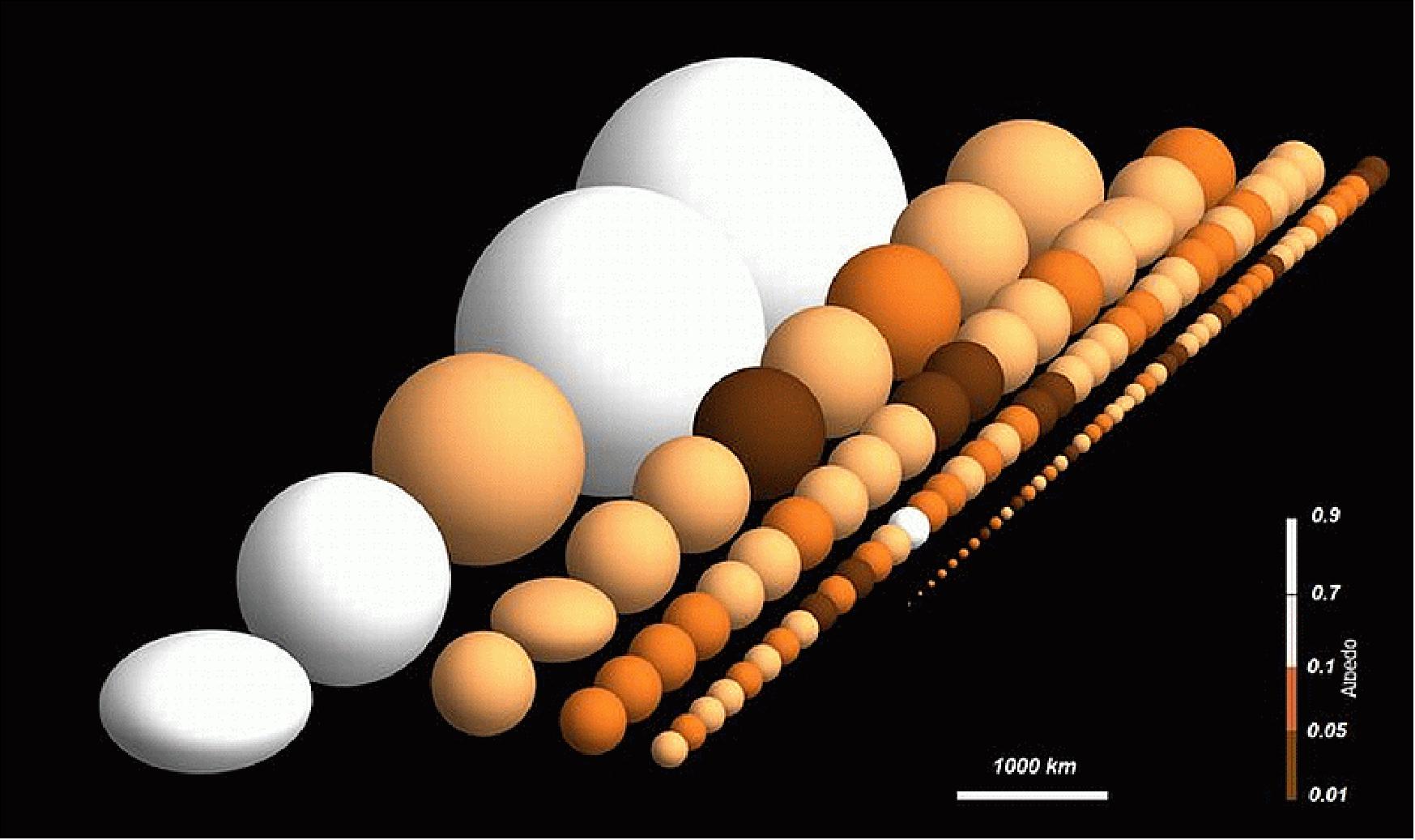
• March 18. 2014: Before concluding its observations in April 2013, Herschel provided the largest survey of cosmic dust, spanning a wide range of nearby galaxies located 50–80 million light-years from Earth. The catalog contains 323 galaxies with varying star formation activity and different chemical compositions, observed by Herschel's instruments across far-infrared and submillimeter wavelengths.
This census of dust in local galaxies has been completed using data from ESA's HSO (Herschel Space Observatory), providing a huge legacy to the scientific community. Cosmic dust grains are a minor but fundamental ingredient in the recipe of gas and dust for creating stars and planets. But despite its importance, there is an incomplete picture of the dust properties in galaxies beyond our own Milky Way. 71)
![Figure 60: Herschel completes the largest survey in the infrared and visible range of cosmic dust in the local universe [image credit: ESA/Herschel/HRS-SAG2 and HeViCS (Herschel Virgo Cluster Survey) Key Programs/Sloan Digital Sky Survey/ L. Cortese (Swinburne University)]](https://www.eoportal.org/ftp/satellite-missions/h/HSO_170622/HSO_Auto36.jpeg)
Legend to Figure 60: A sample collage of galaxies in the Herschel Reference Survey at infrared/submillimeter wavelengths by Herschel (left) and at visible wavelengths from the Sloan Digital Sky Survey (SDSS, right). The Herschel image is colored with blue, representing cold dust, and red representing warm dust; the SDSS image shows young stars in blue and old stars in red. Together, the observations plot young, dust-rich spiral/irregular galaxies in the top left, with giant dust-poor elliptical galaxies in the bottom right.
• March 3, 2014: The billowing clouds portrayed in Figure 61 from ESA's Herschel observatory are part of NGC 7538, a stellar nursery for massive stars. Located around 9000 light-years away, this is one of the few regions of massive-star formation that are relatively close to us, allowing astronomers to investigate this process in great detail. 72) 73)
Star factories like NGC 7538 consist mainly of hydrogen gas, but they also contain small amounts of cosmic dust. It was through this minor – but crucial – component that Herschel could image these star-forming regions, because dust shines brightly at the far-infrared wavelengths that were probed by the observatory.
With a total mass of almost 400 000 Suns, NGC 7538 is an active factory where stars come to life – especially huge ones that are over eight times more massive than the Sun. Hundreds of seeds of future stellar generations nestle in the mixture of surrounding gas and dust scattered across the image. Once they reach a critical mass, they will ignite as stars. Thirteen of these proto-stars have masses greater than 40 Suns, and are also extremely cold, less than –250ºC.
One group of stellar seeds seem to trace a ring-like structure, visible in the left part of the image. The ring may be the edge of a bubble carved by previous stellar explosions – as stars reach the end of their lives and explode as dramatic supernovas – but astronomers are still investigating the origin of this peculiar arrangement.
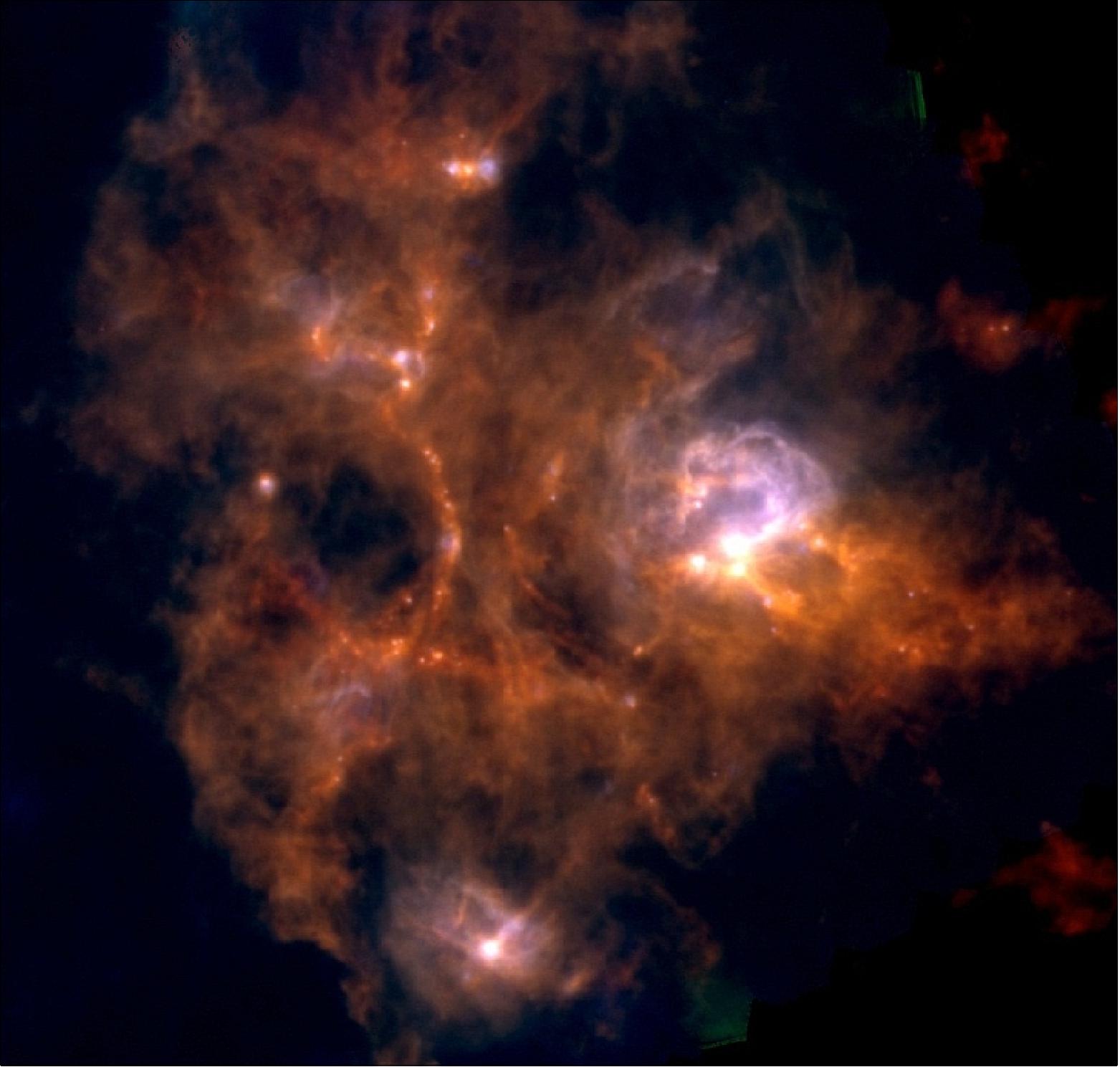
Legend to Figure 61: The image is a composite of the wavelengths of 70 µm (blue), 160 µm (green) and 250 µm (red) and spans about 50 x 50 arc minutes. North is up and east is to the left.
• January 22, 2014: The Herschel team of researchers has discovered water vapor around Ceres in the spacecraft data, the first unambiguous detection of water vapor around an object in the asteroid belt. With a diameter of 950 km, Ceres is the largest object in the asteroid belt, which lies between the orbits of Mars and Jupiter. But unlike most asteroids, Ceres is almost spherical and belongs to the category of ‘dwarf planets', which also includes Pluto. 74) 75) 76)
It is theorized that Ceres is layered, perhaps with a rocky core and an icy outer mantle. This is important, because the water-ice content of the asteroid belt has significant implications for our understanding of the evolution of the Solar System.
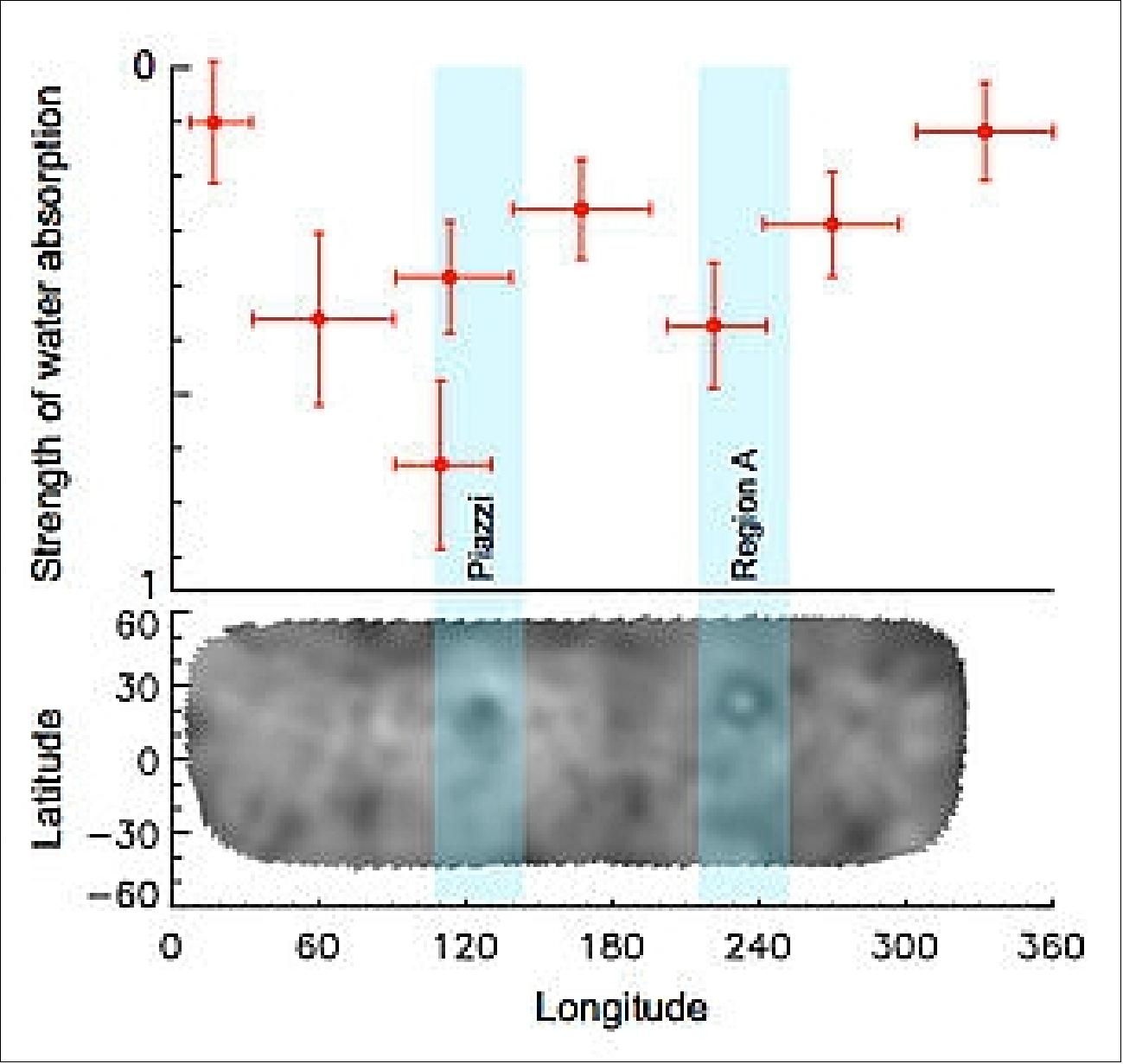
Legend to Figure 62: This graph shows variability in the intensity of the water absorption signal detected at Ceres by the HIFI (Heterodyne Instrument for the Far-Infrared) instrument of HSO on March 6, 2013. The most intense readings correspond to two dark regions on the surface known as Piazzi and Region A, identified in the ground-based image of Ceres by the W. M. Keck Observatory on Mauna Kea, Hawaii. The two data points at 110º longitude were taken in a time interval of about 9 hours — equal to the Ceres rotation period — showing that variability in the water vapor production is possible even over short periods (Ref. 75).
Although Herschel was not able to make a resolved image of Ceres, the astronomers were able to derive the distribution of water sources on the surface by observing variations in the water signal during the dwarf planet's 9-hour rotation period. Almost all of the water vapor was seen to be coming from just two spots on the surface.
The strength of the signal also varied over hours, weeks and months, because of the water vapor plumes rotating in and out of Herschel's views as the object spun on its axis. This enabled the scientists to localize the source of water to two darker spots on the surface of Ceres, previously seen by NASA's Hubble Space Telescope and ground-based telescopes. The dark spots might be more likely to outgas because dark material warms faster than light material. When NASA's Dawn spacecraft arrives at Ceres in 2015, it will be able to investigate these features.
Here is what scientists think is happening: when Ceres swings through the part of its orbit that is closer to the sun, a portion of its icy surface becomes warm enough to cause water vapor to escape in plumes at a rate of about 6 kg/s. When Ceres is in the colder part of its orbit, no water escapes.
• December 2013: Using ESA's Herschel Space Observatory, a team of astronomers has found first evidence of a noble-gas based molecule in space. A compound of argon, the molecule was detected in the gaseous filaments of the Crab Nebula, one of the most famous supernova remnants in our Galaxy. While argon is a product of supernova explosions, the formation and survival of argon-based molecules in the harsh environment of a supernova remnant is an unforeseen surprise. 77) 78)
Figure 63 shows the Crab Nebula, an iconic supernova remnant in our Galaxy, as viewed by ESA's HSO (Herschel Space Observatory). A wispy and filamentary cloud of gas and dust, the Crab Nebula is the remnant of a supernova explosion that was observed by Chinese astronomers in the year 1054.
A new study, led by Michael Barlow from UCL (University College London), UK, and based on data from ESA's Herschel Space Observatory, has found the first evidence of such a compound in space. The results are published in the journal Science. 79)
Argon hydride is produced when ions of argon (Ar+) react with hydrogen molecules (H2), but these two species are usually found in different regions of a nebula. While ions form in the most energetic regions, where radiation from a star or stellar remnant ionizes the gas, molecules take shape in the denser, colder pockets of gas that are shielded from this powerful radiation.
But soon, the study team realized that even in the Crab Nebula, there are places where the conditions are just right for a noble gas to react and combine with other elements. There, in the transition regions between ionized and molecular gas, argon hydride can form and survive.
This new picture was supported by the comparison of the Herschel data with observations of the Crab Nebula performed at other wavelengths, which revealed that the regions where they had found ArH+ also exhibit higher concentrations of both Ar+ and H2. There, argon ions can react with hydrogen molecules forming argon hydride and atomic hydrogen.
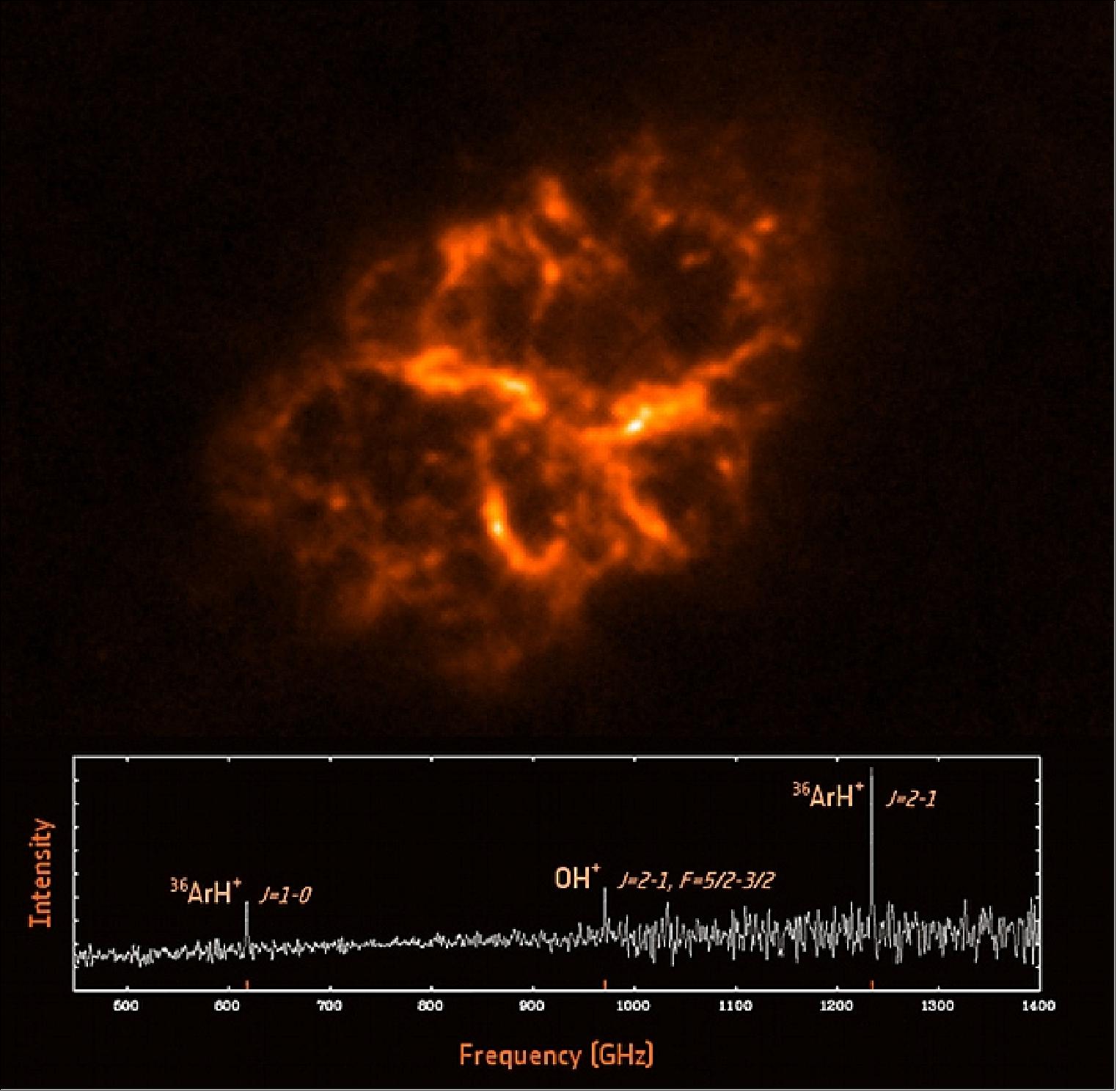
Legend to Figure 63: This image is based on data taken with the PACS instrument on board Herschel, at a wavelength of 70 µm. At these long wavelengths, astronomers can detect the glow from cosmic dust present in the nebula.
Below the image, a spectrum of the far-infrared light from the Crab Nebula is shown. The spectrum was taken with the SPIRE instrument on board Herschel at frequencies ranging from 450 GHz (corresponding to a wavelength of about 660 µm) to 1400 GHz (corresponding to a wavelength of about 200 µm).
The spectrum, which was originally taken to study the dust content of this supernova remnant, enabled the serendipitous discovery of the first noble-gas based compound found in space: argon hydride (ArH+).
On top of the emission from dust, which dominates the continuum emission seen in the spectrum, the team of astronomers found two emission lines that had never been seen before. These are the two lines seen at the left-hand and right-hand side of the spectrum.
The astronomers identified these lines as the first two rotational transitions of ArH+ at frequencies of 617.5 GHz and 1234.6 GHz, respectively. The investigation was performed with the help of two extensive databases of molecular spectra, and through comparison with another, well studied emission line that was found in the Crab Nebula's spectrum – that from the molecular ion OH+, visible near the center of the spectrum, at a frequency of 971.8 GHz.
![Figure 64: Herschel and Hubble composite image of the Crab Nebula [image credit: ESA/Herschel/PACS/MESS Key Program Supernova Remnant Team; NASA, ESA and Allison Loll/Jeff Hester (Arizona State University)] 80)](https://www.eoportal.org/ftp/satellite-missions/h/HSO_170622/HSO_Auto32.jpeg)
Legend to Figure 64: The image combines Hubble's view of the nebula at visible wavelengths, which was obtained using three different filters sensitive to the emission from oxygen and sulphur ions and is shown here in blue, with Herschel's far-infrared image, which reveals the emission from dust in the nebula and is shown here in red. The Hubble image is based on archival data from the Wide Field and Planetary Camera 2 (WFPC2).
• June 2013: A survey from Herschel has revealed that the reservoir of molecular gas in the Milky Way is hugely underestimated - almost by one third - when it is traced with traditional methods. Monitoring the emission from ionized carbon, the new study identified molecular gas in the intermediate evolutionary stage between diffuse, atomic gas and the densest star-forming molecular clouds. The discovery not only indicates that there is more raw material for the formation of new stars in the Galaxy, but also that it extends farther than astronomers knew. 81)
In the Milky Way, as well as in other galaxies, stars are born from the collapse of the densest and coldest clumps of matter in a molecular cloud. These clouds are gigantic star-forming complexes consisting mainly of molecular hydrogen (H2), a gas that does not emit any light at the low temperatures found in molecular clouds.
Astronomers investigating the early stages of star formation are not only interested in how molecular clouds fragment to form stars, but also in the processes that take place even earlier and initially cause molecular clouds to take shape from diffuse, atomic hydrogen gas. For this purpose, astronomers study the distribution and properties of H2 across the Galaxy – but without the benefit of direct observations, they must resort to alternative methods to trace it.
The most widely used proxy to track down molecular gas in star-forming regions is carbon monoxide (CO). A mere contaminant in molecular clouds, CO radiates much more efficiently than H2 and can be detected easily. However, such indirect tracers can be biased, since there is no guarantee that all portions of a cloud containing H2 also contain CO, in which case observations of CO would miss these regions entirely.
To achieve a more complete picture of the Milky Way's molecular content, astronomers in the past decades have combined observations of CO with other tracers of H2. These include the emission from dust – another contaminant in molecular clouds – and the gamma rays that are produced when cosmic ray particles interact with atomic and molecular hydrogen in the ISM (Interstellar Medium).
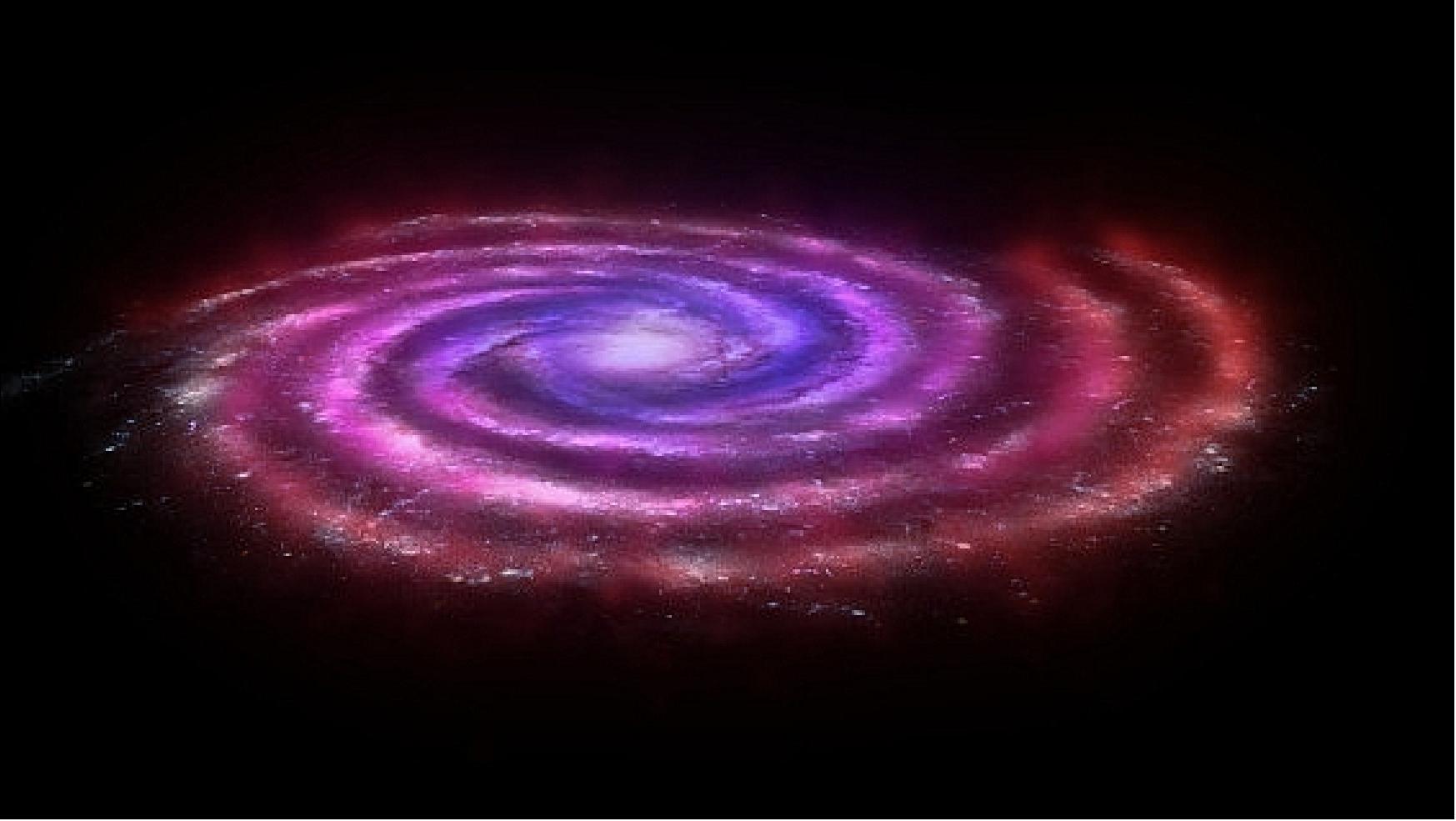
The [C II] 158 µm line is an important tool for understanding the life cycle of interstellar matter. Ionized carbon is present in a variety of phases of the ISM (Interstellar Medium), including the diffuse ionized medium, warm and cold atomic clouds, clouds in transition from atomic to molecular, and dense and warm PDRs (Photon Dominated Regions). 82)
The study is based on observations performed with the HIFI (Heterodyne Instrument for the Far-Infrared) on board ESA's Herschel Space Observatory. The observations were performed within the Herschel Open Time Key Program "State of the Diffuse ISM: Galactic Observations of the THz CII Line – GOT C+" (Principal Investigator: William D. Langer, JPL, Caltech, USA).
• On June 17, 2013 mission controllers sent the final command to the Herschel spacecraft marking the end of operations for ESA's hugely successful space observatory. Herschel's science mission had already ended in April upon exhaustion of the crucial liquid helium that cooled the observatory's instruments close to absolute zero. However, the spacecraft had to be kept active for a few more weeks, during which the final maneuvers and passivation activities were to be performed. 83)
Almost immediately after helium exhaustion, engineers at ESA/ESOC in Darmstadt also seized the rare opportunity to conduct a series of technology tests on the satellite, which remained fully functional although no longer capable of scientific observation. A series of thruster burns moved the spacecraft from its orbit around the L2 point 1.5 million km from the Earth, and into a heliocentric orbit. Finally, in June, the spacecraft was switched off. Herschel's new orbit will send it around the Sun, coming back into Earth's neighbourhood around 13 years from now.
• April 29, 2013: ESA's Herschel space observatory has exhausted its supply of liquid helium coolant, ending more than three years of pioneering observations of the cool Universe. The confirmation that the helium was finally exhausted came at the beginning of the spacecraft's daily communication session on April 29 with its ground station in Western Australia. A clear rise in temperatures was measured in all of Herschel's instruments.
The event was not unexpected: the mission began with over 2300 liter of liquid helium (a mass of 335 kg), which has been slowly evaporating since the final top-up the day before Herschel's launch on 14 May 2009. The liquid helium was essential to cool the observatory's instruments close to absolute zero, allowing Herschel to make highly sensitive observations of the cold Universe until today. 84)
An overview and some comments at the end of a pioneering mission 85) 86)
The ESA mission collected unprecedented data of the cool as well as of the distant Universe. Herschel's observations have exceeded expectations, enabling scientists to learn more about how stars form, about the rates of star formation in galaxies across the cosmos, and about the origin and presence of water in different celestial bodies.
"Herschel's observations have revealed the cosmos in unprecedented detail at these wavelengths," comments Göran Pilbratt, Herschel Project Scientist at ESA. "We have very exciting results from the observatory's first few years and we are looking forward to many more exciting discoveries."
ESA's Herschel space observatory is the most powerful infrared telescope ever flown in space, Herschel operated at far-infrared and sub-millimeter wavelengths, being sensitive to a wide range of low temperatures from a few hundred to less than ten degrees above absolute zero. Herschel's detectors were designed to pick up the glow from celestial objects with infrared wavelengths as long as 625 µm, which is 1,000 times longer than what we can see with our eyes.
Herschel has executed over 35 000 scientific observations, amassing more than 25 000 hours worth of science data from about 600 observing programs. A further 2000 hours of calibration observations also contribute to the rich dataset.
Herschel will continue communicating with its ground stations for a few weeks after the helium is exhausted, during which a range of technical tests will be performed. Finally, in May 2013, it will be propelled from its observation location at the L2 Lagrangian Point into its long-term stable orbit around the Sun, where it will remain indefinitely, and safe from Earth impact for several hundreds of years.
Göran Pilbratt: "Most of Herschel's data are publicly available already. We will continue supporting the community exploiting the data, collecting and producing the best possible data products in the form of maps, spectra, and various catalogs to benefit all astronomers working with Herschel. We are looking forward to the multitude of great discoveries that are still ahead of us."
• April 23, 2013: Astronomers have finally found direct proof that almost all water present in Jupiter's stratosphere was delivered by comet Shoemaker-Levy 9, which struck the planet in 1994. The result is based on new data from Herschel that revealed more water in Jupiter's southern hemisphere, where the impacts occurred, than in the north as well as probing the vertical distribution of water in the planet's stratosphere. 87) 88)
Herschel's observations found that there was 2–3 times more water in the southern hemisphere of Jupiter than in the northern hemisphere, with most of it concentrated around the sites of the 1994 comet impact. Additionally, it is only found at high altitudes. Herschel has a unique combination of instruments that allowed the project team to perform a three-dimensional reconstruction of water in Jupiter's stratosphere: using PACS, the team could map the distribution of water across the entire disc of the planet; the vertical profile of water in the stratosphere was observed using HIFI. The combination of both data sets was crucial to linking the source of water to the famous cometary impact of almost 19 years ago.
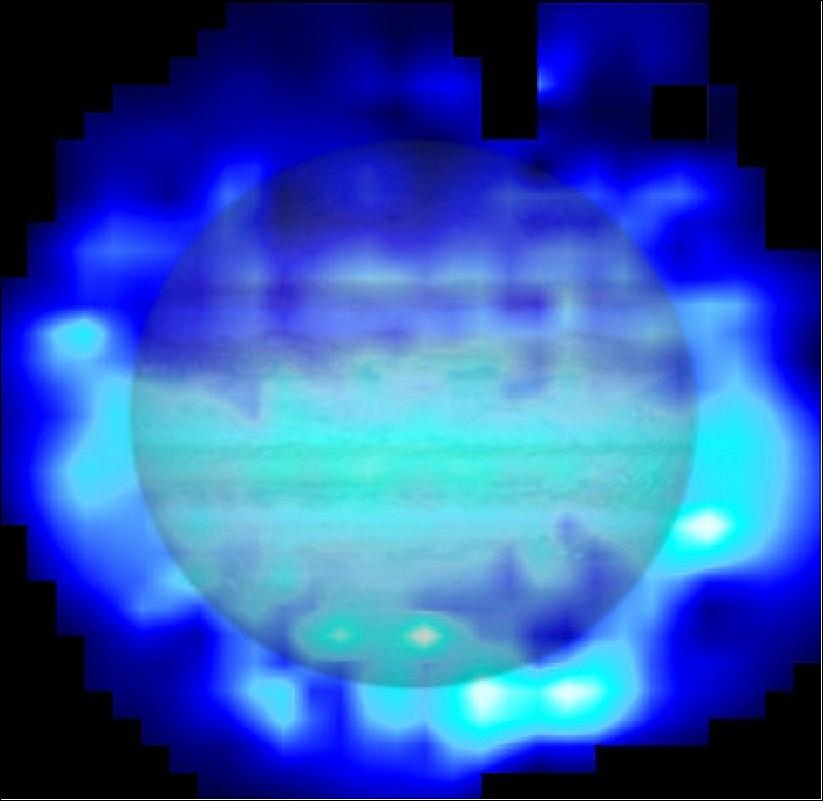
Legend to Figure 66: This map shows the distribution of water in the stratosphere of Jupiter as measured with ESA's Herschel space observatory. White and cyan indicate highest concentration of water, and blue indicates lesser amounts. The map has been superimposed over an image of Jupiter taken at visible wavelengths with the NASA/ESA Hubble Space Telescope.
The distribution of water clearly shows an asymmetric distribution across the planet's disc: water is more abundant in the southern hemisphere. Based on this and other clues collected with Herschel, astronomers have established that at least 95 per cent of the water currently present in Jupiter's stratosphere has been supplied by comet Shoemaker-Levy 9, which famously impacted the planet at intermediate southern latitudes in 1994.
Note: Shoemaker-Levy 9 was a comet that broke apart and collided with Jupiter from July 16-24, 1994, providing the first direct observation of an extraterrestrial collision of Solar System objects. The effects of the comet impacts on Jupiter's atmosphere have been simply spectacular and beyond expectations. Comet Shoemaker-Levy 9 consisted of at least 21 discernable fragments with diameters estimated at up to 2 km. The fragments pounded into the southern hemisphere of Jupiter, leaving dark scars in the planet's atmosphere that persisted for several weeks.
The map is based on spectrometric data collected with the PACS (Photodetector Array Camera and Spectrometer) and HIFI (Heterodyne Instrument for the Far Infrared) instruments on board Herschel around 66.4 µm (PACS), a wavelength that corresponds to one of water's many spectral signatures. The HIFI observations were around 179.5 µm.
• April 19, 2013: New views of the Horsehead Nebula and its turbulent environment have been unveiled by ESA's Herschel space observatory and the NASA/ESA Hubble space telescope. The Horsehead Nebula lies in the constellation Orion, about 1300 light years away, and is a popular target for amateur and professional astronomers alike. It sits just to the south of star Alnitak, the easternmost of Orion's famous three-star belt, and is part of the vast Orion Molecular Cloud complex. 89)
The new far-infrared Herschel view shows in spectacular detail the scene playing out around the Horsehead Nebula at the right-hand side of the image, where it seems to surf like a ‘white horse' in the waves of turbulent star-forming clouds.
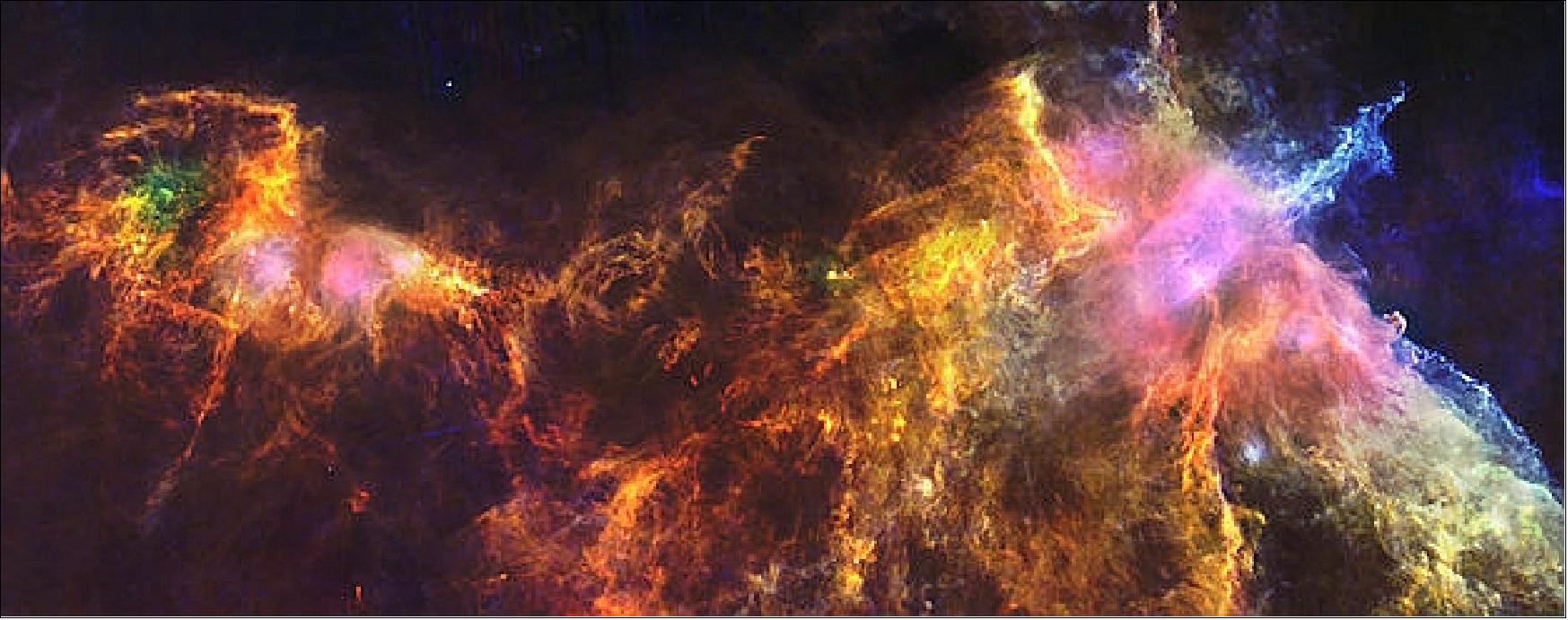
Legend of Figure 67: A stunning new view from ESA's Herschel space observatory of the iconic Horsehead Nebula in the context of its surroundings. The image is a composite of the wavelengths of 70 µm (blue), 160 µm (green) and 250 µm (red), and covers 4.5º x 1.5º . The image is oriented with northeast towards the left of the image and southwest towards the right.
The Horsehead appears to rise above the surrounding gas and dust in the far right-hand side of this scene, and points towards the bright Flame Nebula. Intense radiation streaming away from newborn stars heats up the surrounding dust and gas, making it shine brightly to Herschel's infrared-sensitive eyes (shown in pink and white in this image).
To the left, the panoramic view also covers two other prominent sites where massive stars are forming, NGC 2068 and NGC 2071. Extensive networks of cool gas and dust weave throughout the scene in the form of red and yellow filaments, some of which may host newly forming low-mass stars.
- April 19, 2013: Astronomers have used NASA's Hubble Space Telescope to photograph the iconic Horsehead Nebula in a new, infrared light to mark the 23rd anniversary of the famous observatory's launch aboard the space shuttle Discovery on April 24, 1990.
Hubble has been producing ground-breaking science for two decades. During that time, it has benefited from a slew of upgrades from space shuttle missions, including the 2009 addition of a new imaging workhorse, the high-resolution Wide Field Camera 3 that took the new portrait of the Horsehead. 91)
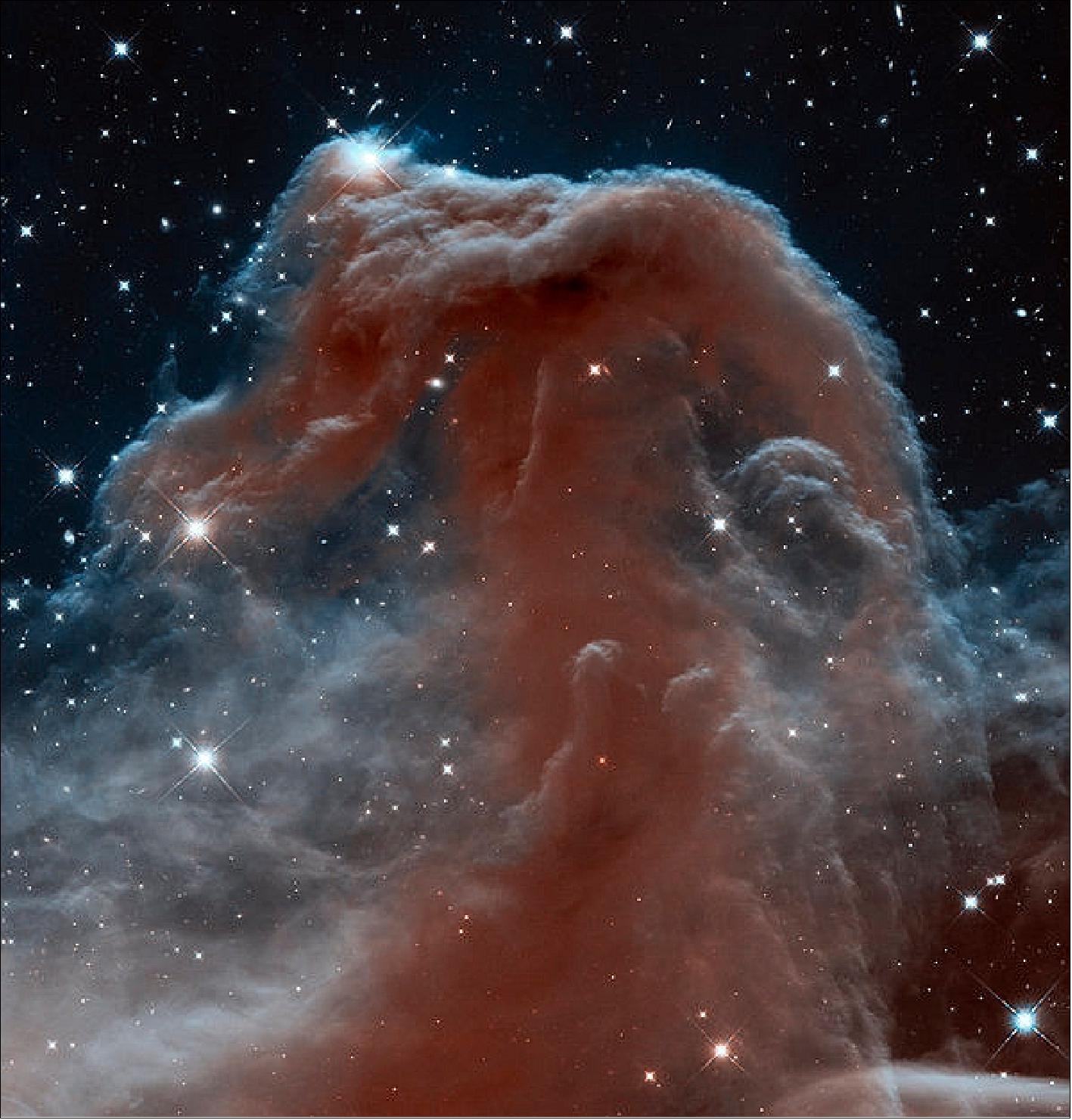
Legend to Figure 68: The Horsehead Nebula as viewed at near-infrared wavelengths [1.1 µm (blue/cyan) and 1.6 µm (red/orange)] with the Wide Field Camera 3 on the NASA/ESA Hubble Space Telescope. The image is approximately 6 arcmin across and is oriented with north to the left and east down.
This thick pillar of gas and dust is sculpted by powerful stellar winds blowing from clusters of massive stars located beyond the field of this image. The bright source at the top left edge of the nebula is a young star whose radiation is already eroding the surrounding interstellar material.
• March 27, 2013: In this new view of a vast star-forming cloud called W3 (Figure 69), ESA's Herschel space observatory tells the story of how massive stars are born. W3 is a giant molecular cloud containing an enormous stellar nursery, some 6200 light-years away in the Perseus Arm, one of our Milky Way Galaxy's main spiral arms. Spanning almost 200 light-years, W3 is one of the largest star-formation complexes in the outer Milky Way, hosting the formation of both low- and high-mass stars. The distinction is drawn at eight times the mass of our own Sun: above this limit, stars end their lives as supernovas.
Dense, bright blue knots of hot dust marking massive star formation dominate the upper left of the image in the two youngest regions in the scene: W3 Main and W3 (OH). Intense radiation streaming away from the stellar infants heats up the surrounding dust and gas, making it shine brightly in Herschel's infrared-sensitive eyes. Older high-mass stars are also seen to be heating up dust in their environments, appearing as the blue regions labelled AFGL 333 in the lower left of the annotated version of the image, and the loop of KR 140, at bottom right. 92)
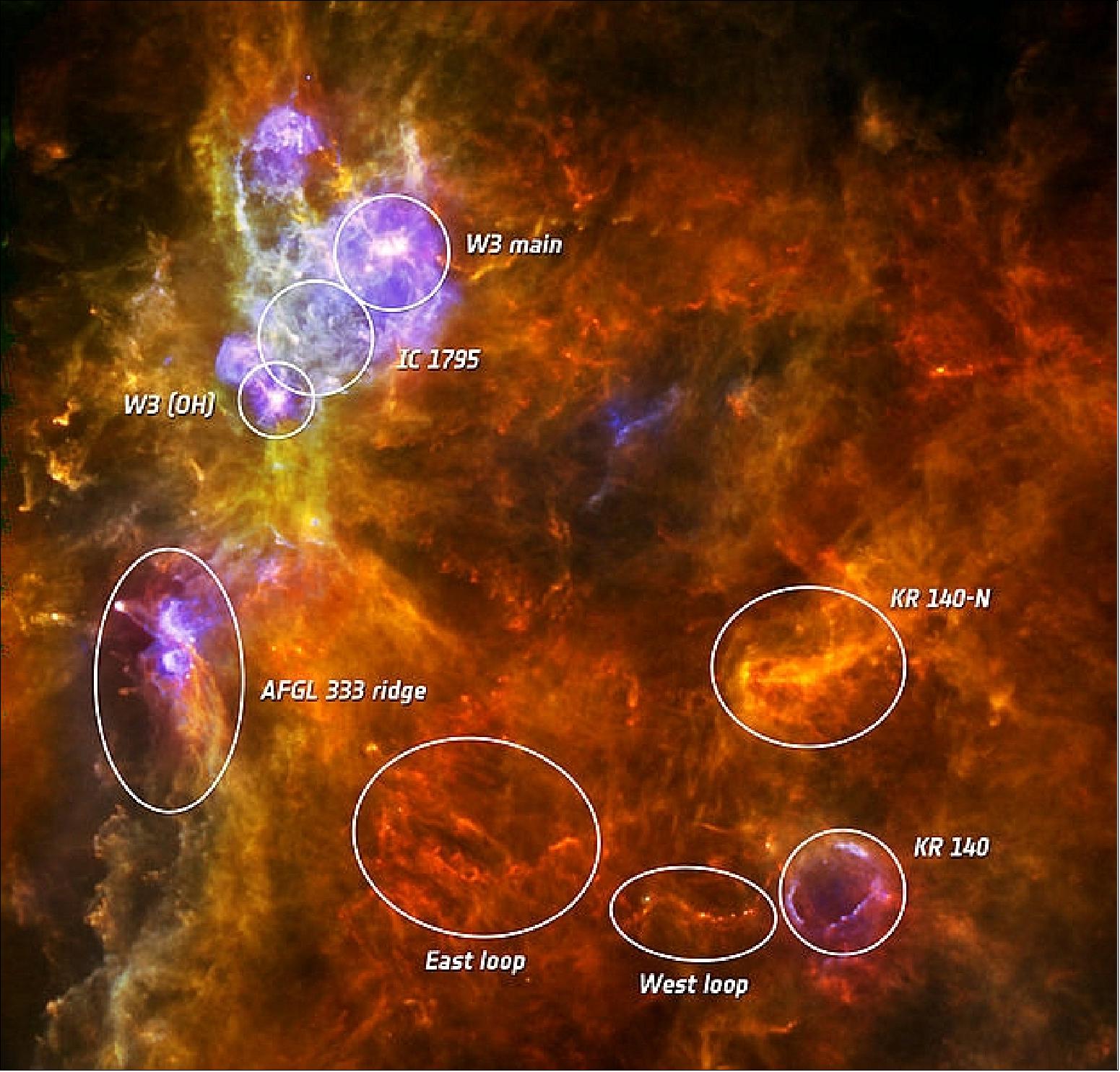
• March 2013: ESA's Herschel space observatory is expected to exhaust its supply of liquid helium coolant in the coming weeks after spending more than three exciting years studying the cool Universe. 93)
A pioneering mission, it is the first to cover the entire wavelength range from the far-infrared to submillimeter, making it possible to study previously invisible cool regions of gas and dust in the cosmos, and providing new insights into the origin and evolution of stars and galaxies. - To make such sensitive far-infrared observations, the detectors of the three science instruments – two cameras/imaging spectrometers and a very high-resolution spectrometer – must be cooled to a frigid -271°C, close to absolute zero. They sit on top of a tank filled with superfluid liquid helium, inside a giant thermos flask known as a cryostat.
• December 2012: By combining the observing powers of ESA's Herschel space observatory and the ground-based Keck telescopes, astronomers have characterized hundreds of previously unseen starburst galaxies, revealing extraordinary high star-formation rates across the history of the Universe. 94)
Many of the brightest, most actively star-forming galaxies in the Universe were actually undetectable by Earth-based observatories, hidden from view by thick clouds of opaque dust and gas. Thanks to ESA's Herschel space observatory, which views the Universe in infrared, an enormous amount of these "starburst" galaxies have recently been uncovered, allowing astronomers to measure their distances with the twin telescopes of Hawaii's W. M. Keck Observatory (on the summit of Mauna Kea) . What they found is quite surprising: at least 767 previously unknown galaxies, many of them generating new stars at incredible rates. 95)
By gathering literally hundreds of hours of spectral data (redshifts) on the galaxies with the Keck telescopes, estimates of their distances could be determined as well as their temperatures and how often new stars are born within them. - The galaxies, many of them observed as they were during the early stages of their formation, are producing new stars at a rate of 100 to 500 a year — with a mass equivalent of several thousand Suns — hence the moniker "starburst" galaxy. By comparison the Milky Way galaxy only births one or two Sun-mass stars per year. 96)
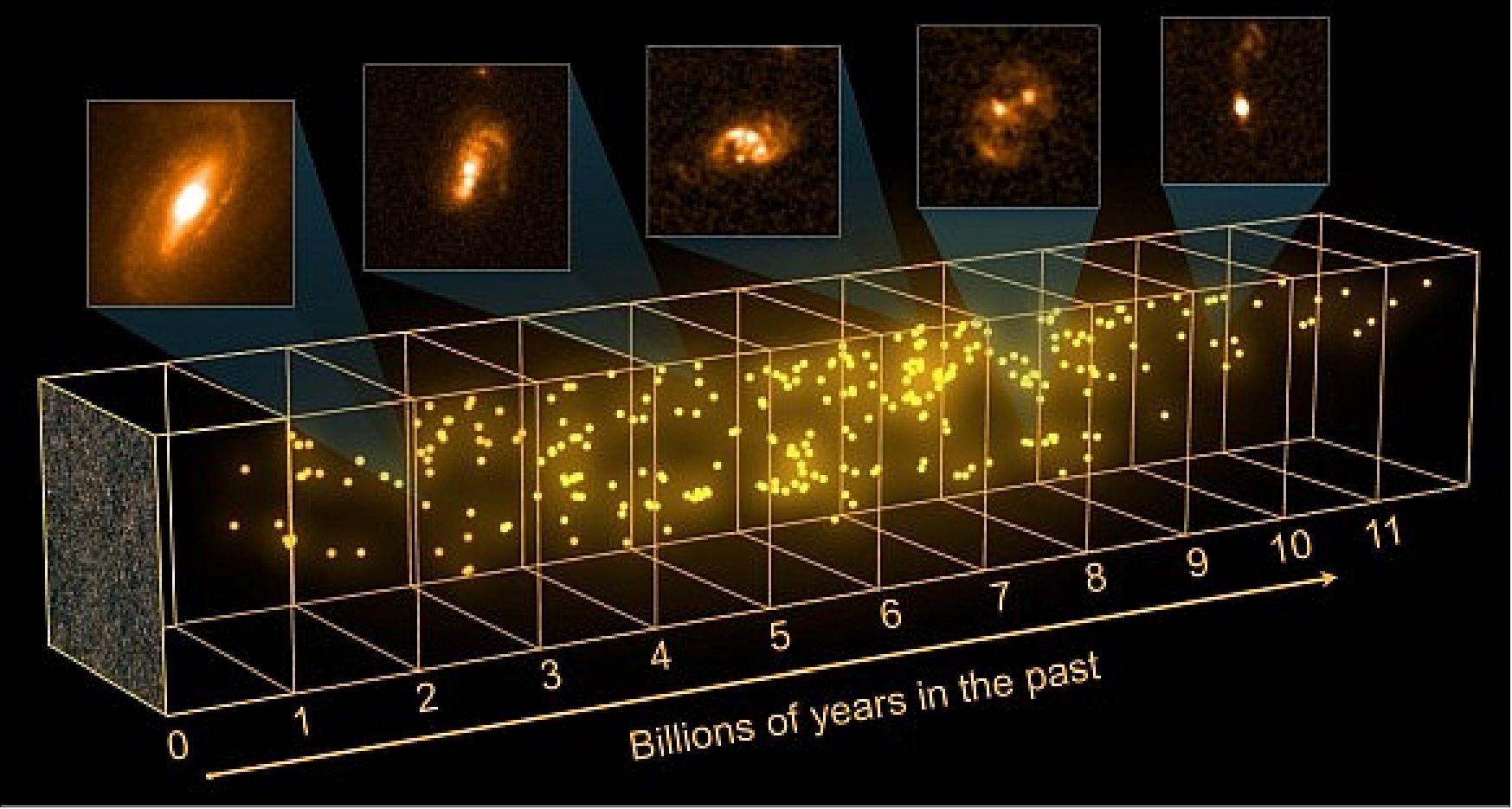
Legend to Figure 70: This 3D projection of almost 300 galaxies in the census in the same part of the sky. The third dimension shows how many billions of years back in time we are seeing each galaxy, determined by observations from the Keck Observatory. At top are images from the Hubble Space Telescope of five galaxies in the census.
• November 2012: Astronomers using ESA's Herschel Space Observatory have detected massive debris discs around 61 Virginis (28 light years away) and M-type Gliese 581 (20 light years away), two nearby stars that are known to host super-Earth planets. The study also reveals that debris discs are preferentially found in planetary systems with low-mass planets rather than in those hosting high-mass planets. This suggests that debris discs may survive more easily in the absence of very massive planets, and highlights the importance of debris discs in the study of planet formation. 97) 98) 99)
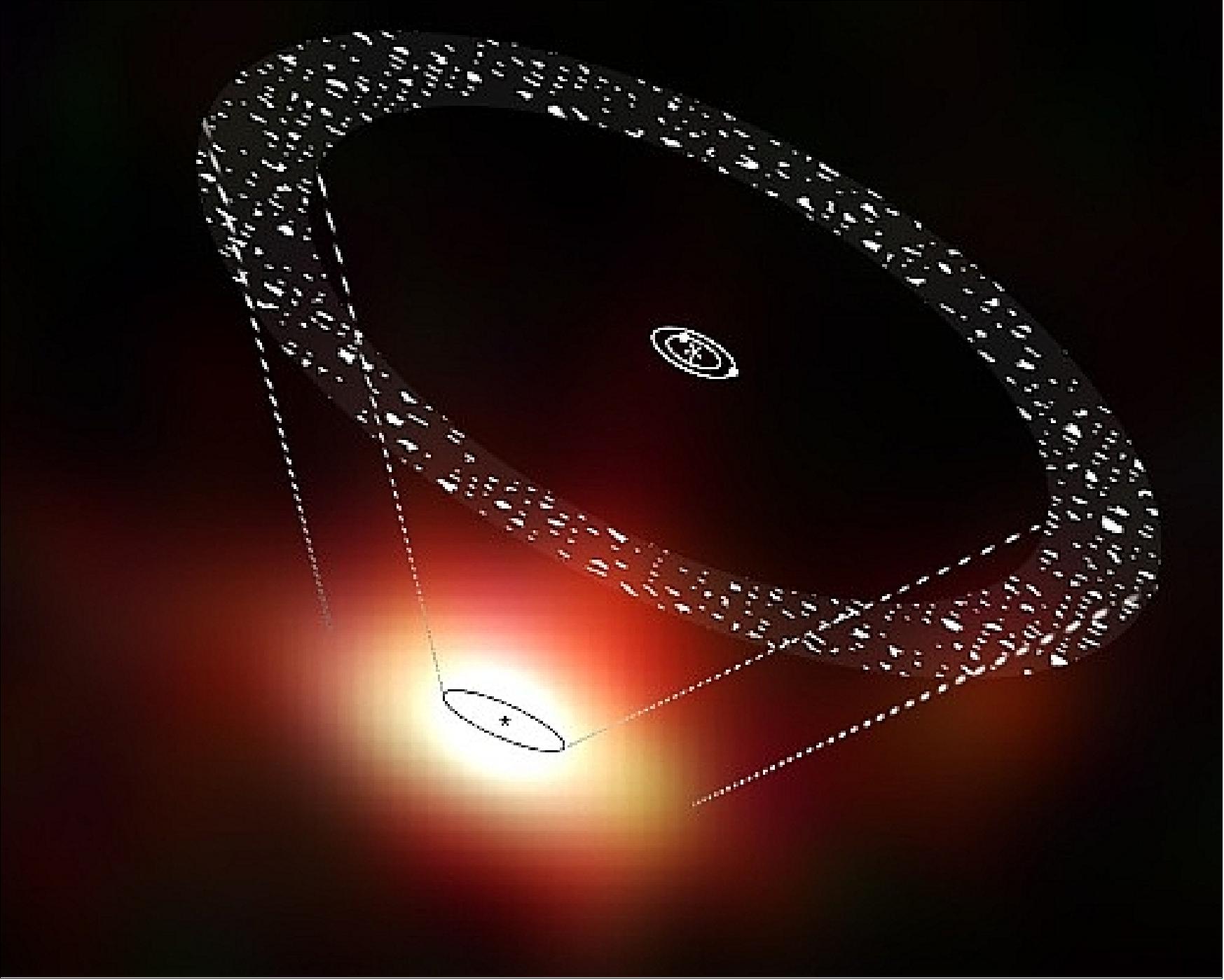
Legend to Figure 71: 61 Virginis is a G-type star that is known to host at least two planets, which have masses equivalent to about five and 18 times the mass of Earth and orbit their parent star at 0.05 and 0.22 AU, respectively, – much closer than Mercury is to the Sun. The debris disc discovered with Herschel extends between 30 and 100 AU from the star – well beyond the orbits of its known planets.
A sketch of the debris disc and the orbits of the two known planets is superimposed on the image. The relative sizes of the disc and planetary orbits are not drawn to scale: the disc is about 100 times larger than the orbit of the outermost planet.
The data for this study were gathered as part of the DEBRIS (Disc Emission via a Bias-free Reconnaissance in the Infrared/Submillimeter) Open Time Key Program, a volume-limited survey to detect and characterize dusty debris discs around nearby main-sequence stars with the PACS and SPIRE instruments on board Herschel. The survey targets the nearest ~90 stars to the Sun of each of the following spectral types: A, F, G, K, M. — DEBRIS is an international collaboration of over 30 researchers from Canada, the USA, the UK., Spain, Germany, France, Switzerland, and Chile. The project is led by Brenda Matthews (Herzberg Institute of Astrophysics, National Research Council of Canada, and Department of Physics & Astronomy, University of Victoria, Victoria, BC, Canada).
• August 2012: The prediction for ‘end-of-helium' date is regularly refined and has been updated to March 2013, providing a couple of more weeks of observing. 100)
• July 2012: Mission operations of the Herschel space observatory and of the payload continued nominally. 101)
• The Herschel spacecraft and its payload are operating nominally in early 2012. The end of the mission is expected sometime in late 2012 when the coolant (helium) will be depleted. Once boil off has occurred Herschel's instruments will no longer operate. 102)
Herschel is well into what is expected to be its last year of observing. In-flight operations will continue until all superfluid helium has been exhausted, which is predicted to occur around February 2013. All Key program observations and the vast majority of the observations selected in late 2010 in the first in-flight call for observing proposals have been performed. Current observing is dominated by programs selected in late 2011. The spacecraft and ground segment are working well. 103)
• In January 2012, a new composite image of the Eagle Nebula (Figure 73), observed by Herschel and XMM Newton, was released by ESA. — In 1995, the Hubble Space Telescope's 'Pillars of Creation' image of the Eagle Nebula (Figure 72) became one of the most iconic images of the 20th century. Now (January 2012), two of ESA's orbiting observatories have shed new light on this enigmatic star-forming region. 104)
The Eagle Nebula is 6500 light-years away from Earth in the constellation of Serpens. It contains a young hot star cluster, NGC6611, visible with modest back-garden telescopes, that is sculpting and illuminating the surrounding gas and dust, resulting in a huge hollowed-out cavity and pillars, each several light-years long. - The Hubble image hinted at new stars being born within the pillars, deeply inside small clumps known as 'evaporating gaseous globules' or EGGs. Owing to obscuring dust, Hubble's visible light picture was unable to see inside and prove that young stars were indeed forming.
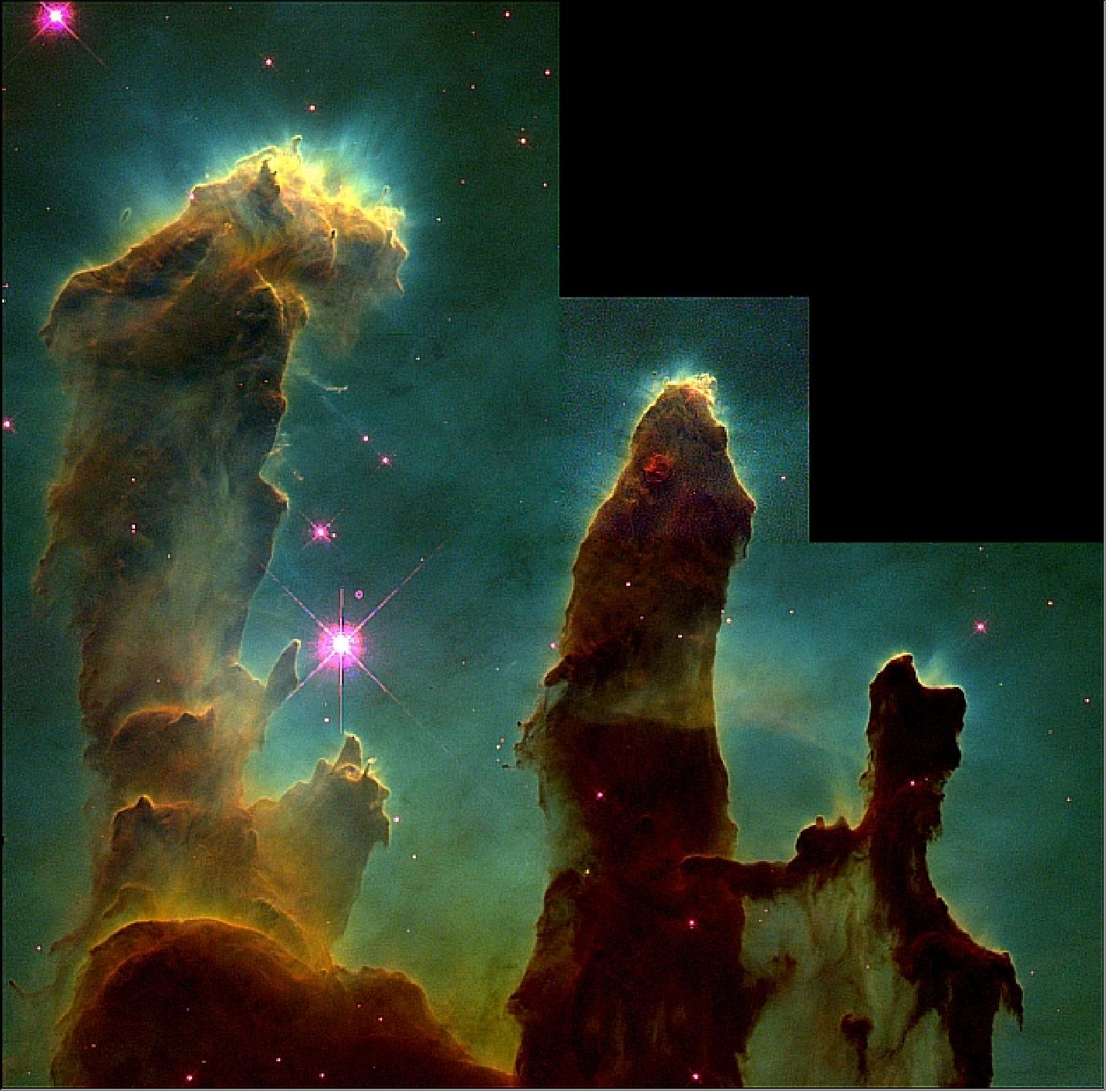
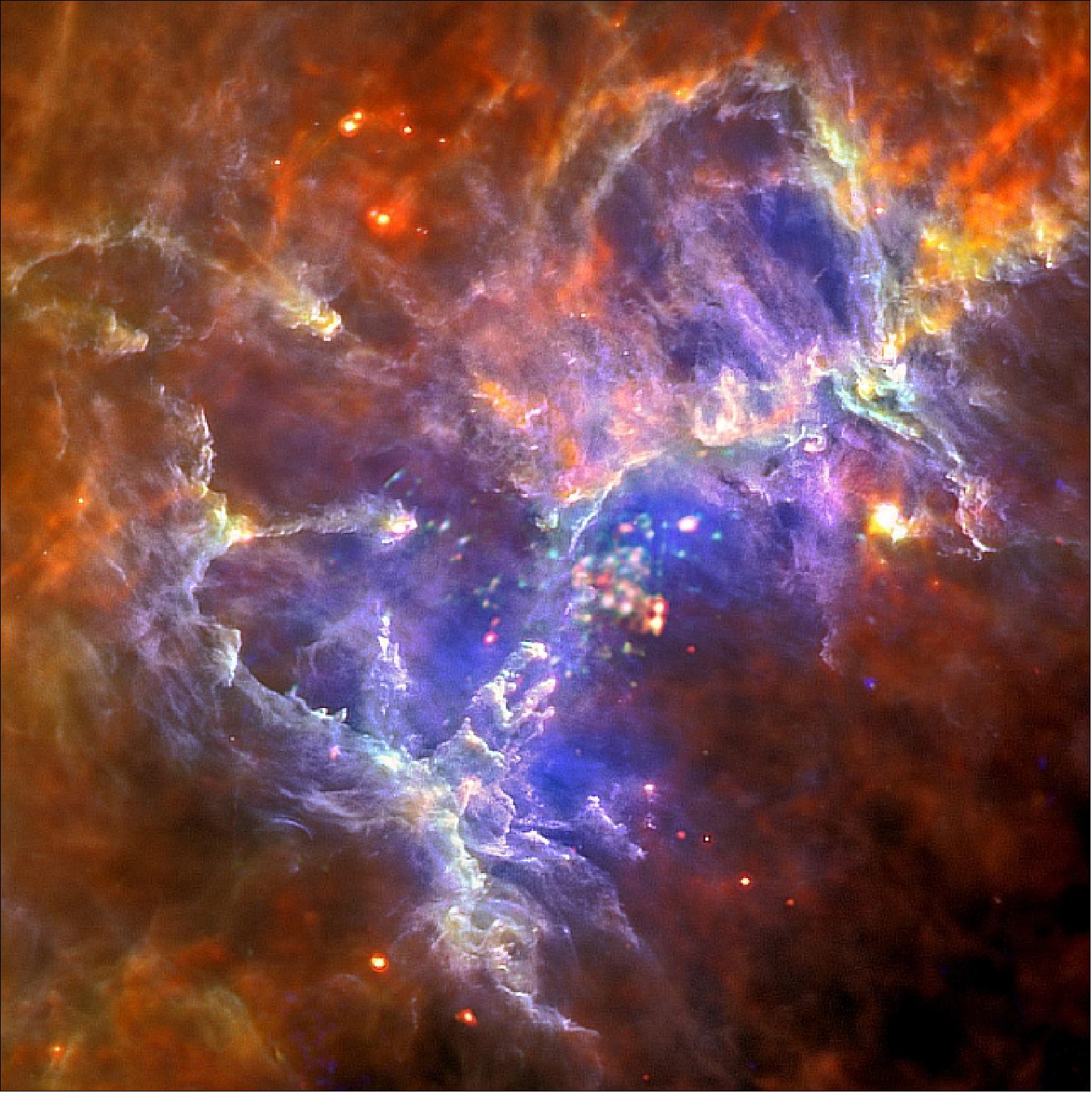
Legend to Figure 73: Combining almost opposite ends of the electromagnetic spectrum, this composite of the Herschel in far-infrared and XMM-Newton's X-ray images shows how the hot young stars detected by the X-ray observations are sculpting and interacting with the surrounding ultra-cool gas and dust, which, at only a few degrees above absolute zero, is the critical material for star formation itself. Both wavelengths would be blocked by Earth's atmosphere, so are critical to our understanding of the lifecycle of stars.
The ESA Herschel Space Observatory's new image shows the pillars and the wide field of gas and dust around them. Captured in far-infrared wavelengths, the image allows astronomers to see inside the pillars and structures in the region. - In parallel, a new multi-energy X-ray image from ESA's XMM-Newton telescope shows those hot young stars responsible for carving the pillars.
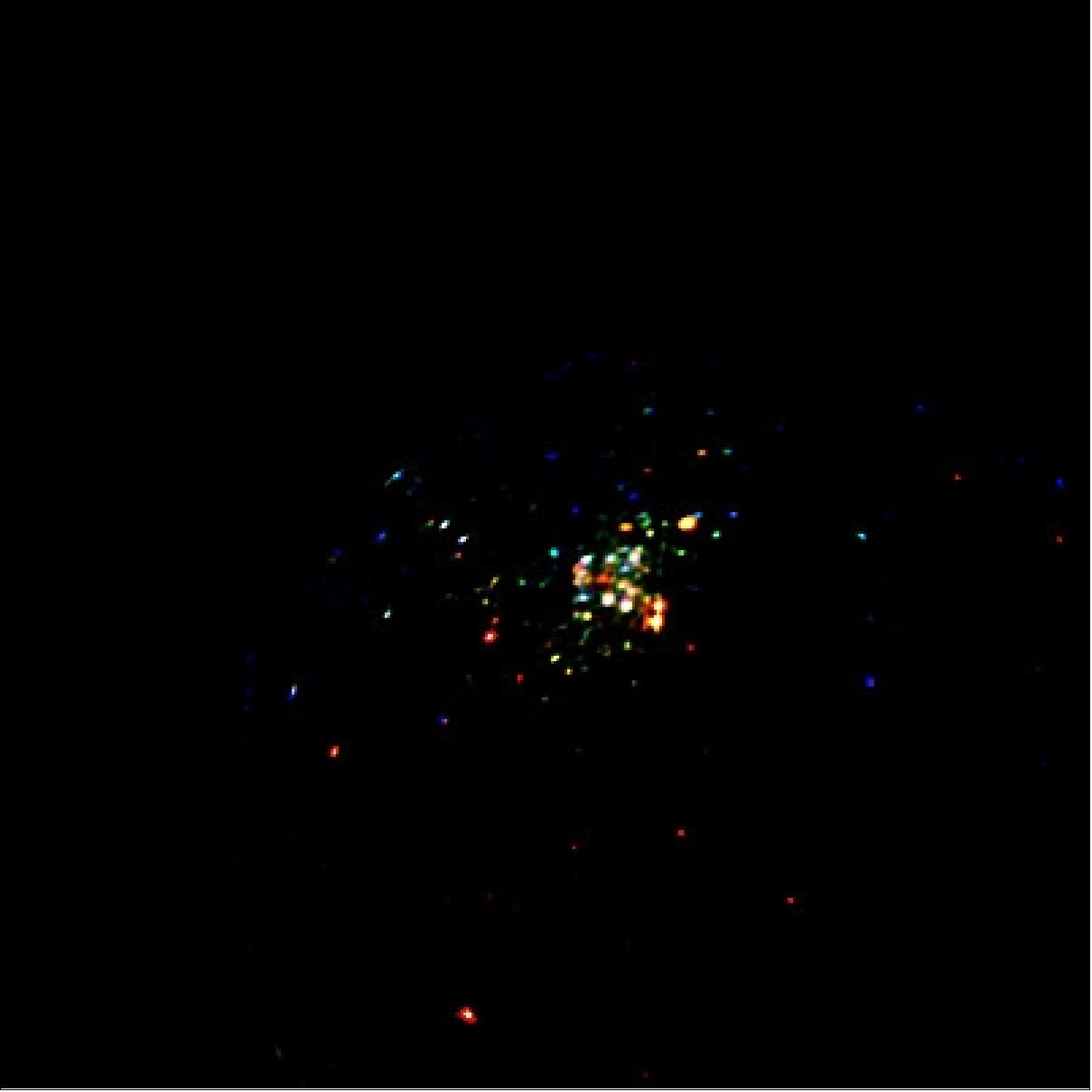
XMM-Newton's images of the Eagle Nebula region in X-rays, which here is color-coded to show different energy levels (red: 0.3–1 keV, green: 1–2 keV and blue: 2–8 keV) is helping astronomers to investigate a theory that the Eagle Nebula is being powered by a hidden supernova remnant. The researchers are looking for signs of very diffuse emission and how far this extends around the region. They believe that an absence of this X-ray emission beyond that found by previous orbiting space telescopes (Chandra and Spitzer) would support the supernova remnant theory. The work on this is continuing (Ref. 104).
• July 2011: New data from HSO have revealed surprisingly large amounts of cold dust in the remnant of the famous supernova SN1987A, which exploded 24 years ago (1987) in the Large Magellanic Cloud, a neighboring galaxy of the Milky Way. With this discovery, the astronomers confirm that supernovae are able to produce significant quantities of dust over very short time scales. This may help explain previous observations, by Herschel and other observatories, of abundant dust in the early Universe as seen in high-redshift galaxies. The results are published online today in Science Express. 105) 106)
• Herschel continues to work well, which was the main conclusion from the 2nd In-Orbit Performance Review carried out in ESOC on 26 May, 2011. The review was preceded by the third measurement of the remaining superfluid helium in the cryostat. The measurements to date together with modelling indicate that Herschel could continue performing observations until some time in the spring of 2013. 107)
• The image of Figure 75 was acquired by Herschel in 2011 and released by ESA on April 28, 2014. The majority of the stars in our Galaxy, the Milky Way, reside in a single huge disc, known as the Galactic Plane, spanning 100 000 light-years across. The Sun also resides in this crowded stellar hub, lying roughly halfway between its center and its outer edges. 108)
This disc is filled with a diffuse mixture of gas and dust – the interstellar medium – that pervades space, filling the large gaps found between stars. Occasionally, these clouds of gas and dust cool, becoming denser and denser until they spark star formation, giving rise to new generations of stars.
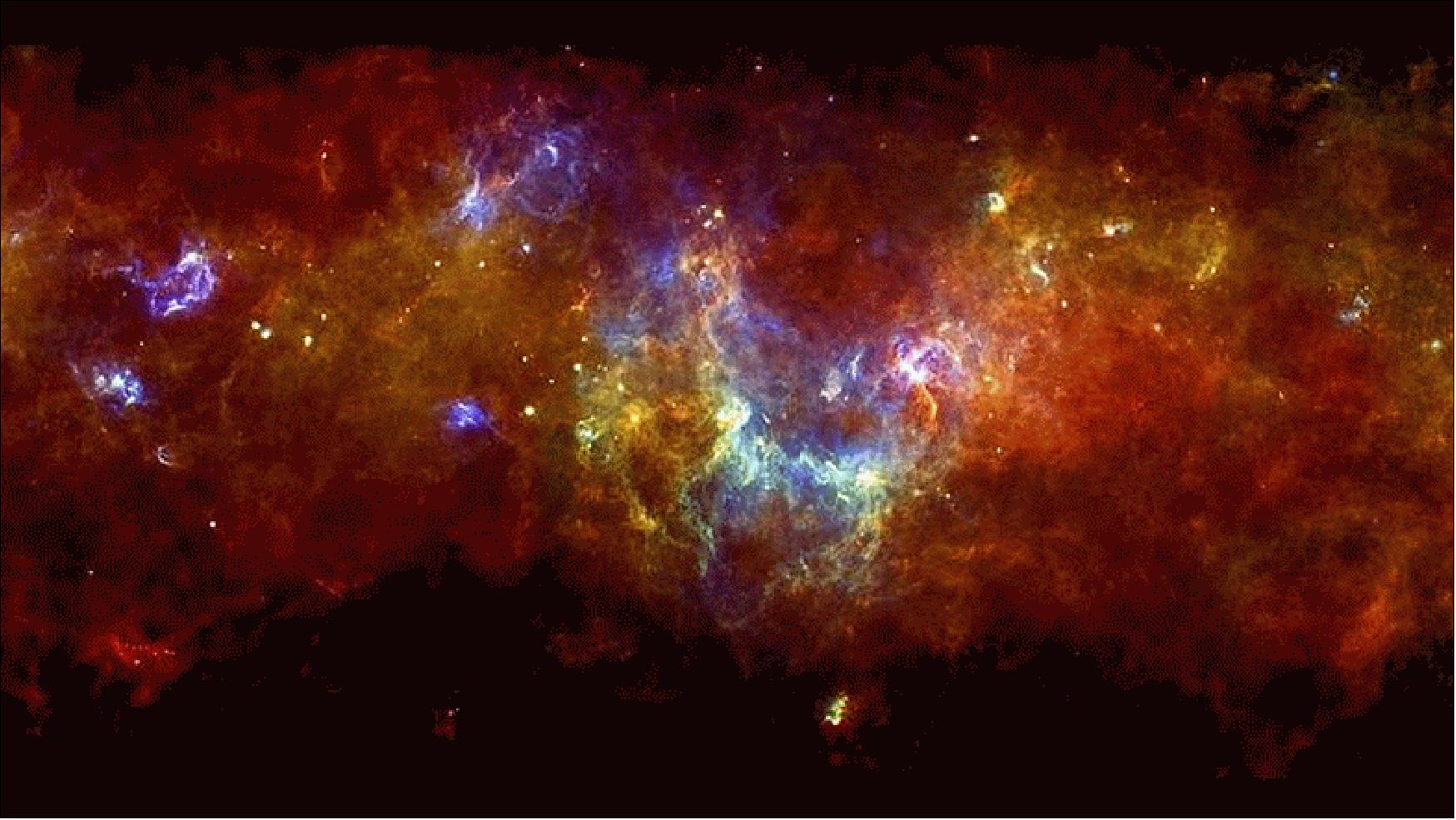
Legend to Figure 75: The image combines observations from the PACS and SPIRE instruments on Herschel. It spans about 12º on the longer side, corresponding to some 24 times the diameter of the full Moon. This is 1/30th of the entire Galactic Plane survey.
The image is part of Hi-GAL, a survey of the Galactic Plane completed with ESA's Herschel Space Observatory. Peering at the sky in infrared light, Herschel could detect the glow of dust particles dispersed between stars. This minor – but crucial – component of the interstellar medium allows astronomers to investigate how stars are born in the Milky Way, and how they affect their environment as they age.
Nestled in the Milky Way's disc are pockets of gas and dust that have been heated by nearby newborn stars, causing them to glow brightly like cosmic gems. Through their higher temperatures, these regions glow at shorter infrared wavelengths and are depicted in violet and green, while the colder material in the surroundings – only a few tens of degrees above absolute zero – appears redder.
Laced amongst the stars is an intricate network of filaments sprinkled with tiny white spots: these are denser clumps of gas and dust that will likely evolve and give birth to new stars (Ref. 108).
• The Herschel spacecraft and its payload are operating nominally in 2011. Herschel is carrying out routine science observations with its three instruments (PACS, SPIRE and HIFI) and continues to generate excellent science data. Well over half of the observing time allocated to the 42 Key Programs before the launch has been used. In the first ‘in-flight' call to the worldwide astronomical community for open time proposals, 241 proposals were given observing time on the recommendation of the Herschel Observing Time Allocation Committee in October 2010. 109) 110) 111)
• During the Christmas holidays 2010, ESA's Herschel and XMM-Newton space observatories have combined forces to show the Andromeda Galaxy in a new light. Herschel sees rings of star formation in this, the most detailed image of the Andromeda Galaxy ever taken at infrared wavelengths, and XMM-Newton shows dying stars shining X-rays into space. 112)
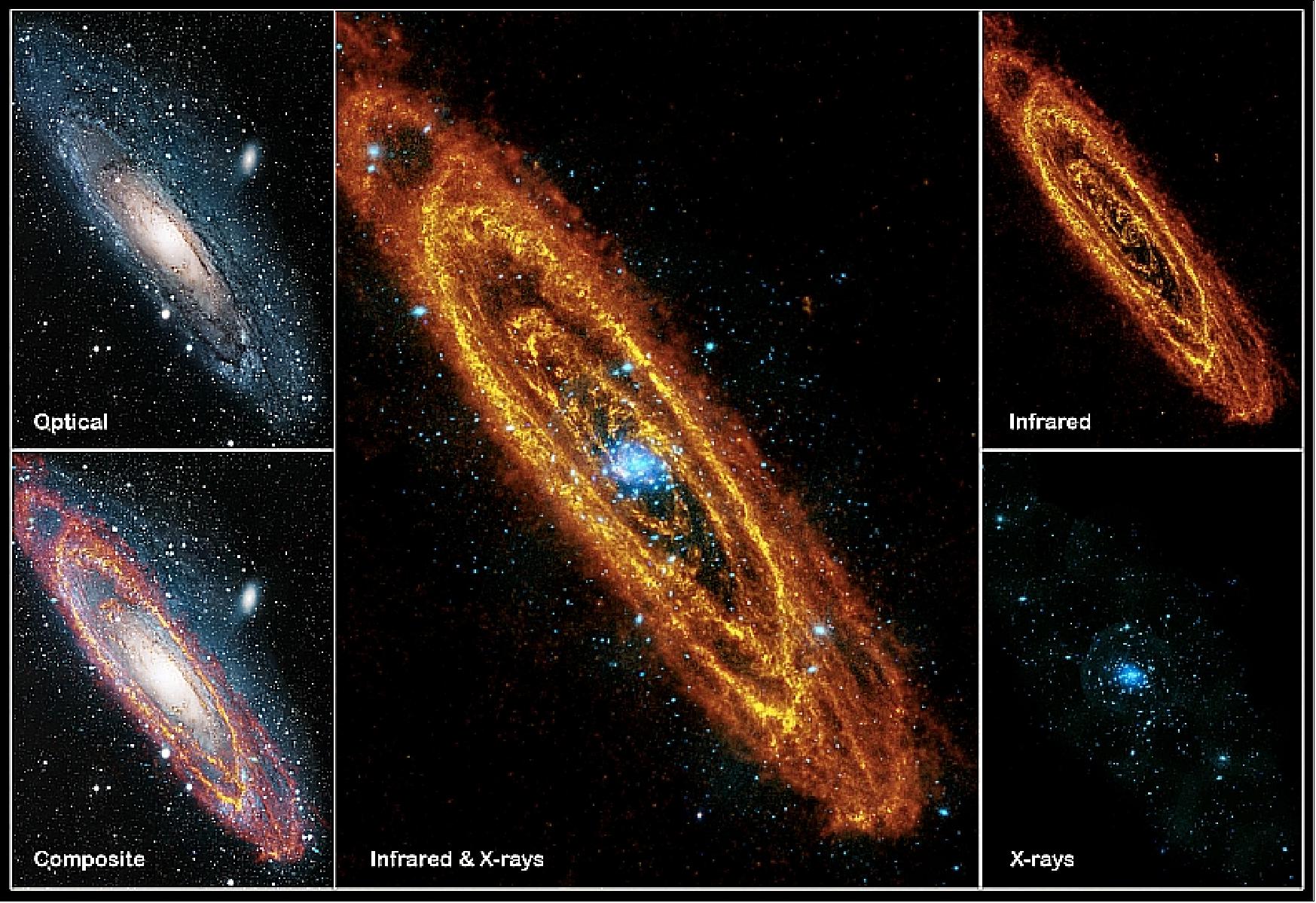
Legend to Figure 76: The Andromeda Galaxy is our nearest large galactic neighbor (at ~ 2.1 million light years away from the Milky Way), containing several hundred billion stars (some estimates are up to 1012 stars). Combined, these images (Figure 76) show all stages of the stellar life cycle. The infrared image from Herschel shows areas of cool dust that trace reservoirs of gas in which forming stars are embedded. The optical image shows adult stars. XMM-Newton's X-ray image shows the violent endpoints of stellar evolution, in which individual stars explode or pairs of stars pull each other to pieces. - The images Herschel instruments were from PACS and SPIRE, while the EPIC instrument was used on XMM-Newton.
• Some performance results of the Herschel spacecraft and its subsystems in the summer/fall of 2010: 113) 114) 115)
- Attitude and orbit control: Herschel is a 3-axis stabilized platform with pointing accuracy in the arcsec range: 3.7 arcsec for APE (Absolute Pointing Error), 0.3 arcsec for RPE (Relative Pointing Error). The scientific mode of observation is based on attitude determination by a Star Tracker (STR) and a high precision gyro, while control is performed by reaction wheels. The in-orbit determination of attitude control performance shows that the requirements are met.
Parameter | Specification | In-orbit performance |
RPE (Relative Pointing Error) | 0.3 arcsec | < 0.3 arcsec |
APE (Absolute Pointing Error) | 3.7 arcsec | < 2 arcsec |
To achieve the required scientific observations, Herschel attitude control allows performing preprogrammed pointing modes such as: a) Raster pointing: matrix of fixed pointing; b) Line-scanning: scanning of a portion of the sky by a series of lines; c) Tracking of solar system objects.
- The satellite data handling is performed in the CDMU (Command and Data Management Unit) which communicates with the instruments and with the ACMS (Attitude Control and Measurement Subsystem) via 2 separate 1553 buses. It also includes a 32 Gbit mass memory able to store 48 hours of instrument data.
Since beginning of mission, the only CDMU reconfiguration was a PM reset which occurred on Herschel: this was due to an HIFI anomaly which saturated the 1553 bus and led to PM reset and bus reconfiguration in-accordance with the onboard FDIR (Failure Detection Isolation and Recovery).
- Propulsion subsystem: The propulsion subsystem is based on a monopropellant system. The hydrazine stored in 2 bladder tanks is fed to 20 N thrusters (2 branches of 6 thrusters) and to 1N thrusters.

- TT&C (Telemetry Tracking & Command): The subsystem is a full X-X band link with the ground stations. It allows a high telemetry data rate of 1.5 Mbit/s at L2 to download the scientific data during the 3 hours daily telecommunication period. A fixed medium gain antenna is used for high rate data transmission while low gain antennas ensure omnidirectional coverage for emergency cases. - For this high data rate, GMSK (Gaussian Minimum Shift Keying) modulation was used to limit the bandwidth occupation. This is the first application of GMSK in space and was fully successful. For the time being, 100% data return has been achieved.
- PLM (Payload Module): Figure 78 shows the in-flight cool-down of the Herschel cryostat exterior part. An anti-contamination phase of 15 days has been implemented directly after launch during which the telescope primary and secondary mirrors were maintained at 170 K. This was to prevent outgassing products of the satellite from contaminating these sensitive surfaces. A slightly higher than predicted cryostat outer vessel temperature has been found in orbit with a difference of 9 K w.r.t. prediction. This has an influence on the cryogenic lifetime: however the 3.5 years specification can still be met.
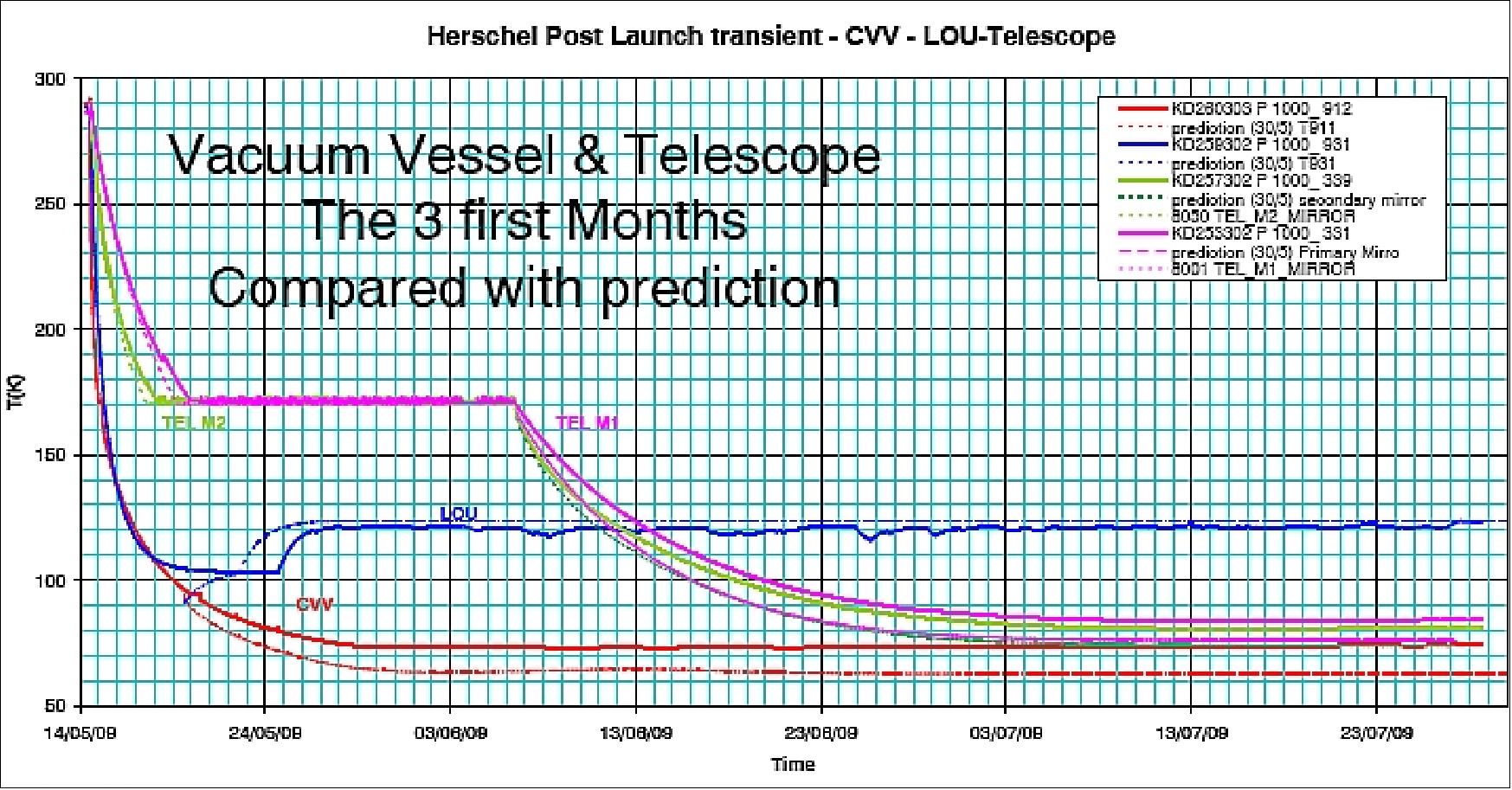
Figure 79 shows the cool-down profile for the cryostat interior: the red curve represents the temperature of the He II bath. The temperature peak corresponds to the cool-down of the cryostat in the early phase after launch when the exterior is cooling down but it still at high temperature with high energy input into the He tank. The maximum temperature of the He II is 1.97 K, remaining well below the transition temperature to superfluid Helium at 2.1 K.
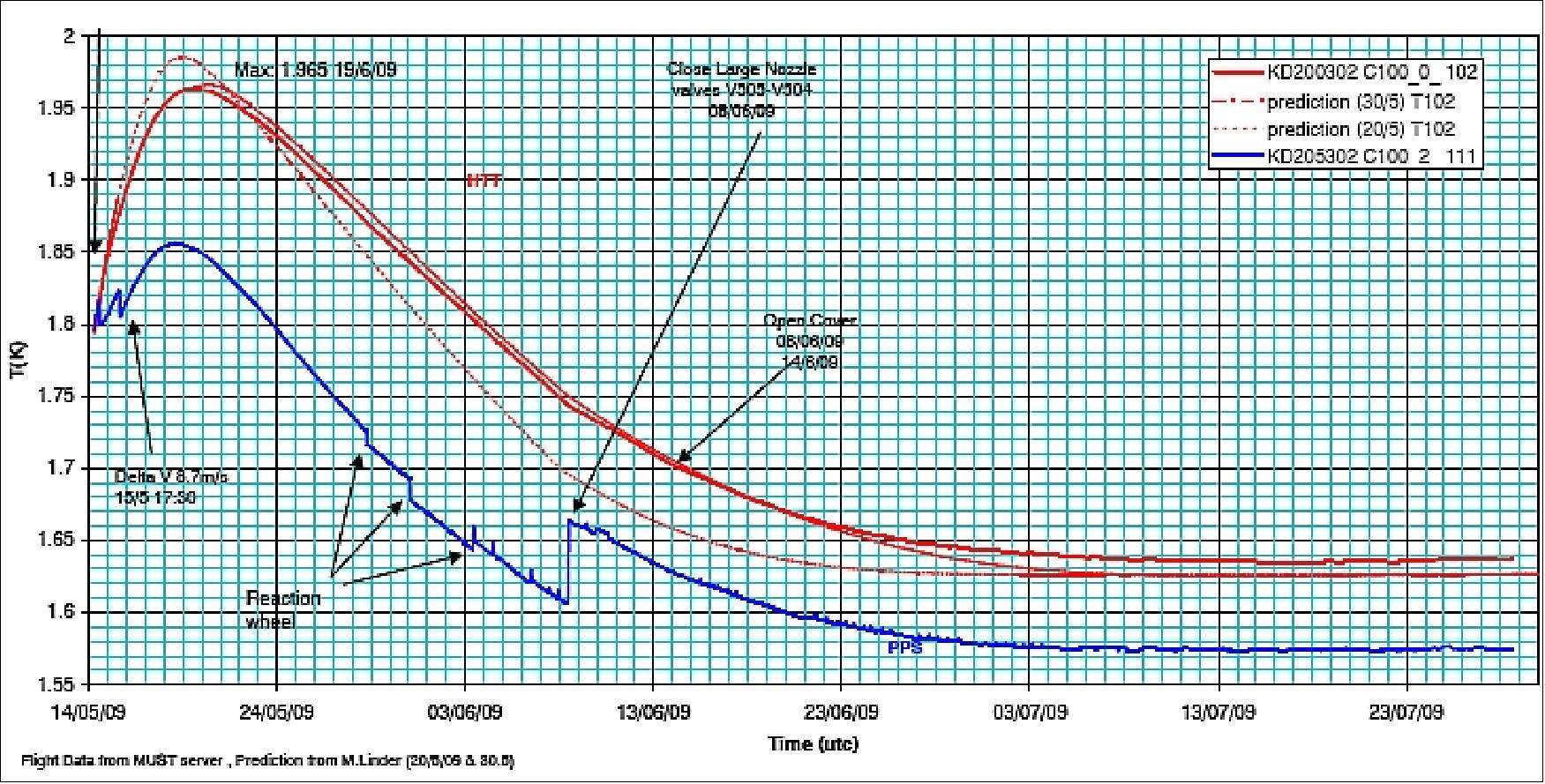
Figure 80 shows the helium temperature for the first year of mission. The temperature has remained stable. The variations are due to instrument activities including PACS and SPIRE sorption cooler recycling.
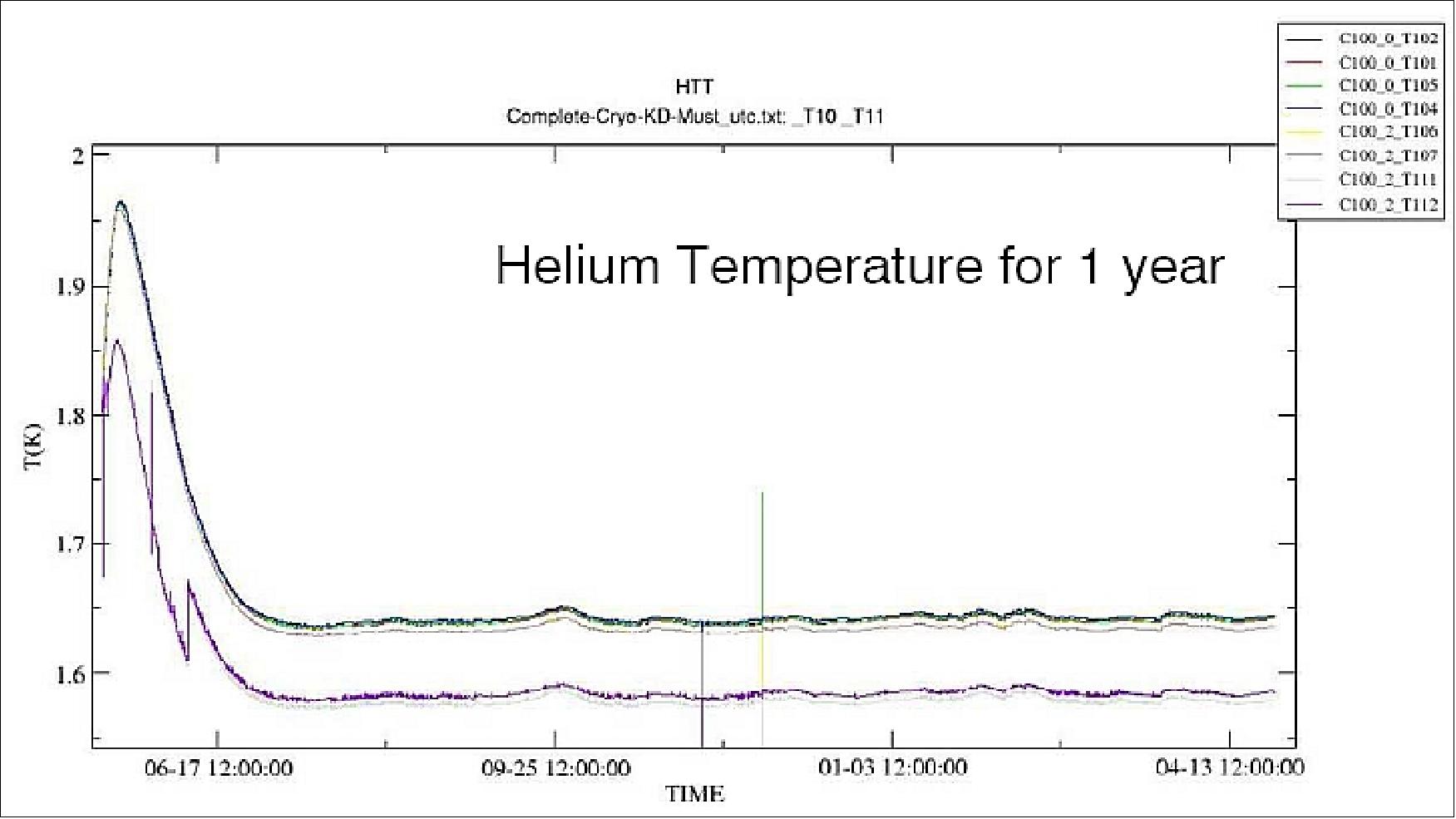
- The Herschel 1st results symposium took place in ESTEC on May 4-6 2010. This corresponds to 8 months of observation, as Herschel instruments are operational since September 2009. The overall performances by far meet the astronomer expectations. In particular, the telescope size allows performing nice and sharp images in the far infrared range.
The first year in-orbit has been extremely successful with almost flawless operations of the Herschel satellite and performances as expected. This has allowed to already bring a wealth of scientific results. It proves that the complex development, mainly in the fields of cryogenics and optics at IR and submilimetric wave lengths, has been rigorously conducted (Ref. 113).
• On May 14, 2010, Herschel has achieved one years in space - and shown some stunning results. 116) 117)
• On January 19, 2010, ESA's Herschel observatory is back to full operation following the reactivation of its HIFI instrument. 118)
• The HSO officially entered the Routine Science Phase (RSP) in January 2010 that was preceded by a Science Demonstration Phase (SDP) in late 2009. 119) 120) 121) 122) 123)
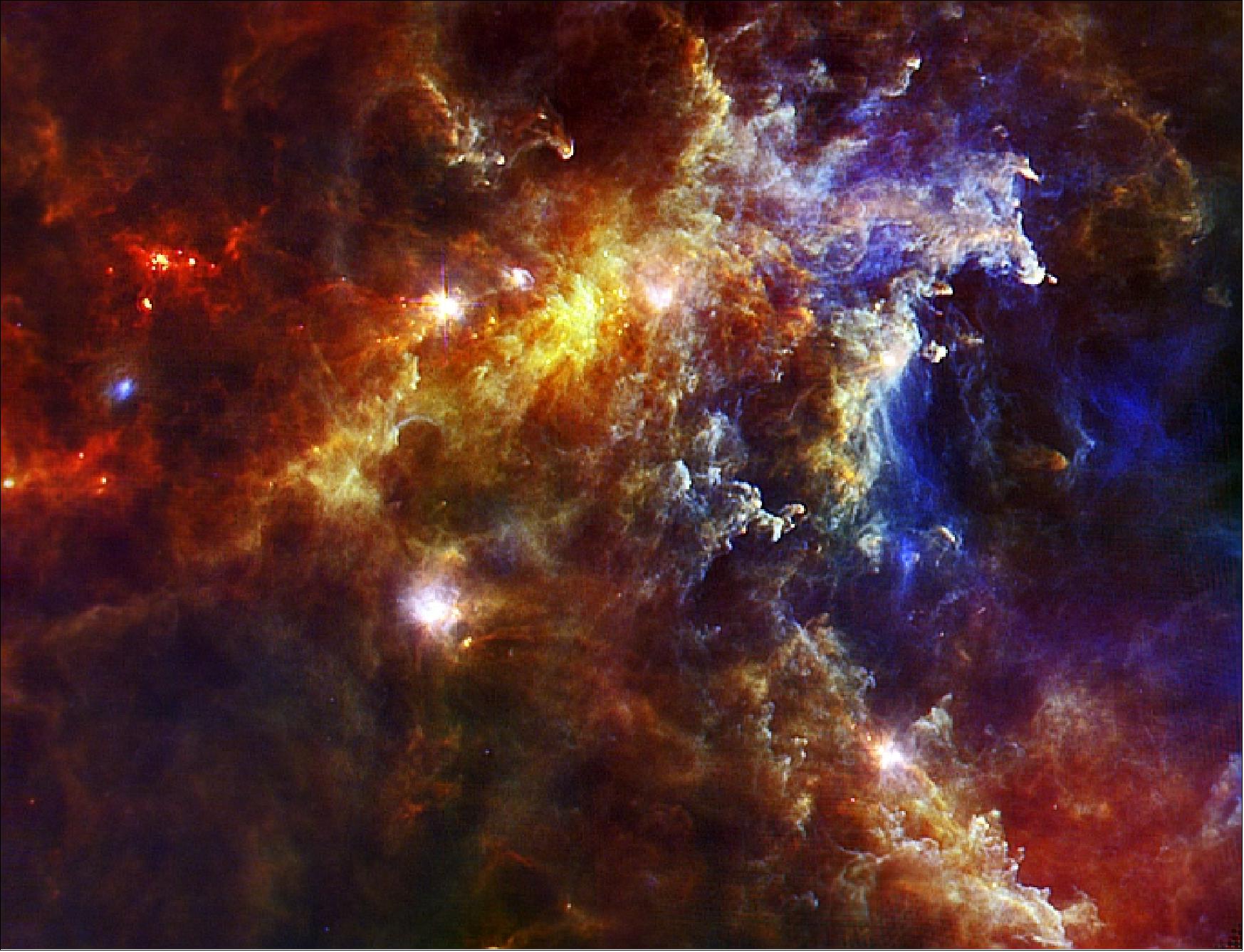
• In mid-January 2010, the HIFI instrument has been successfully switched on, after being inactive for more than 160 days due to an unexpected anomaly in the electronic system. This achievement brings Herschel back to its full observing capacity. HIFI was built specifically to observe water in a variety of celestial objects. Over the next three years HIFI spectra will be used to probe stellar environments and to study the role of gas and dust in the formation of stars and planets and the evolution of galaxies. 125)
On 3 August 2009, early in the performance verification phase, it was discovered that HIFI was no longer operating normally. This was later traced to an unexpected voltage peak in the electronics of HIFI's LCU (Local Oscillator Control Unit) having shut it down.
• On Sept. 28, 2009, Herschel reached another important milestone: the first set of observations corresponding to the so-called 'Science Demonstration Phase' were made available to their owners. This delivery took place several weeks ahead of the originally planned schedule and marks the start of the transition from the Performance Verification Phase to the Routine Phase of operations. 126)
• In early September 2009, during the Herschel performance verification phase, the SPIRE and PACS photometers were used in 'parallel mode' to observe a 2º x 2º field in an area near the Galactic Plane, 60º from the Galactic Center of the Milky Way, in the constellation of the Southern Cross. This region is considered to be a good test case for verification and demonstration purposes as it is typical of crowded fields where there may be many molecular clouds along the line-of-sight. Studying the earliest phases of star formation in molecular clouds is an area of scientific investigation to which Herschel is particularly well-suited, and the ability of the SPIRE and PACS instruments to map regions of massive cloud complexes provides the capability to detect stages of star formation which have not been found with previous infrared missions. 127) 128)
• HIFI anomaly: On August 3, 2009, HIFI was found with an unknown LO status '14' (Ref. 123).
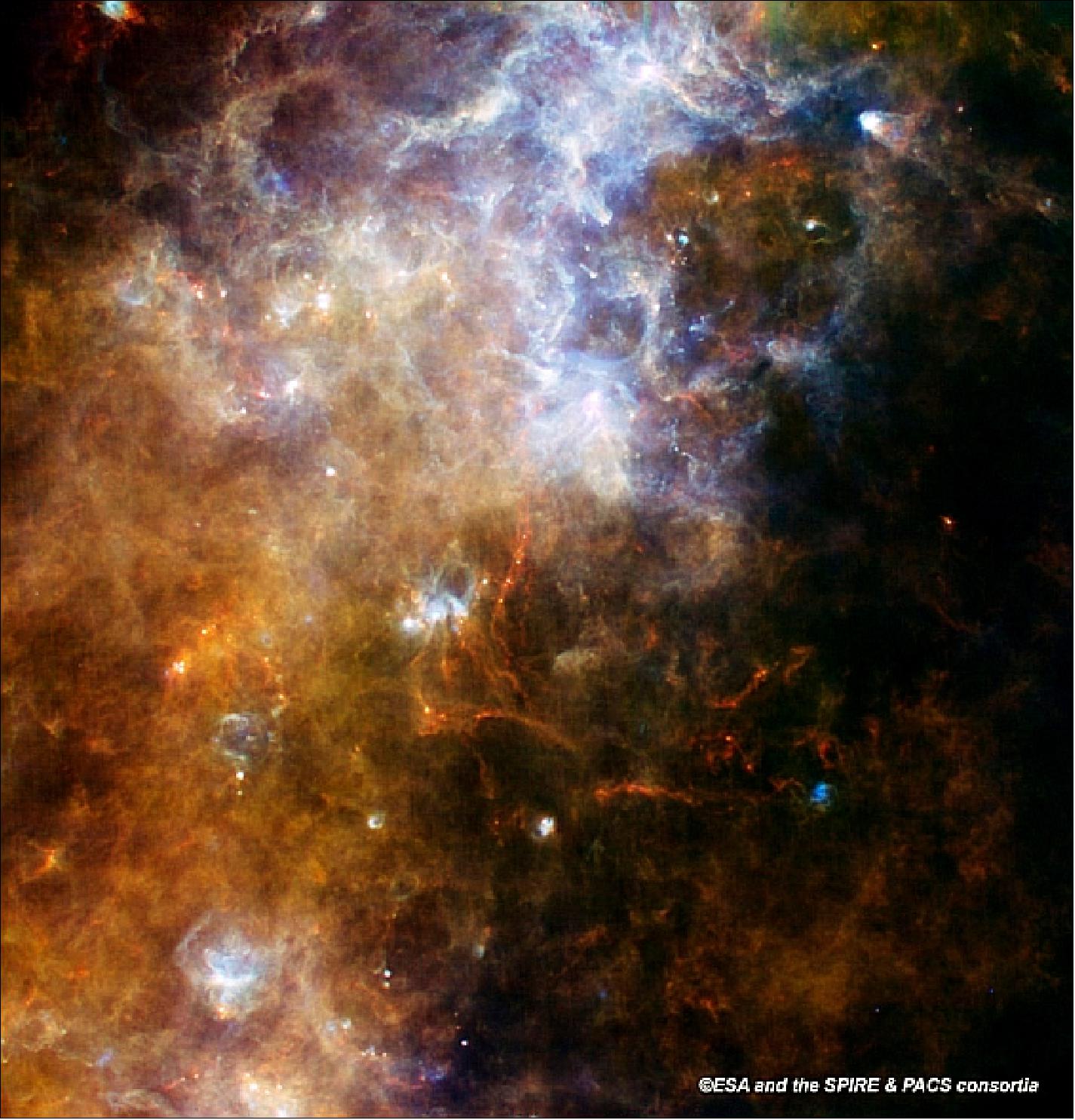
• On July 24, 2009, Herschel has successfully completed its in-orbit commissioning review. The spacecraft is in excellent condition, and its instruments have been fully commissioned and checked out. Herschel is now certified ready to begin the performance verification phase. This is where the scientists will "tweak" the observatory to attain optimum performance for scientific observations. 129) 130)
• On June 14, 2009, Herschel opened its 'eyes' and the PACS (Photodetector Array Camera and Spectrometer) obtained images of M51, ('the whirlpool galaxy', first observed by Charles Messier in 1773, who provided the designation Messier 51) for a first test observation. Scientists obtained images in three colors which clearly demonstrate the superiority of Herschel, the largest infrared space telescope ever flown. The image is a composite of three observations taken at 70, 100 and 160 µm with PACS on June 14 and 15, immediately after the the satellite's cryocover was opened on June 14, 2009. The objective was to produce a very early image that gives a glimpse of things to come. 131)
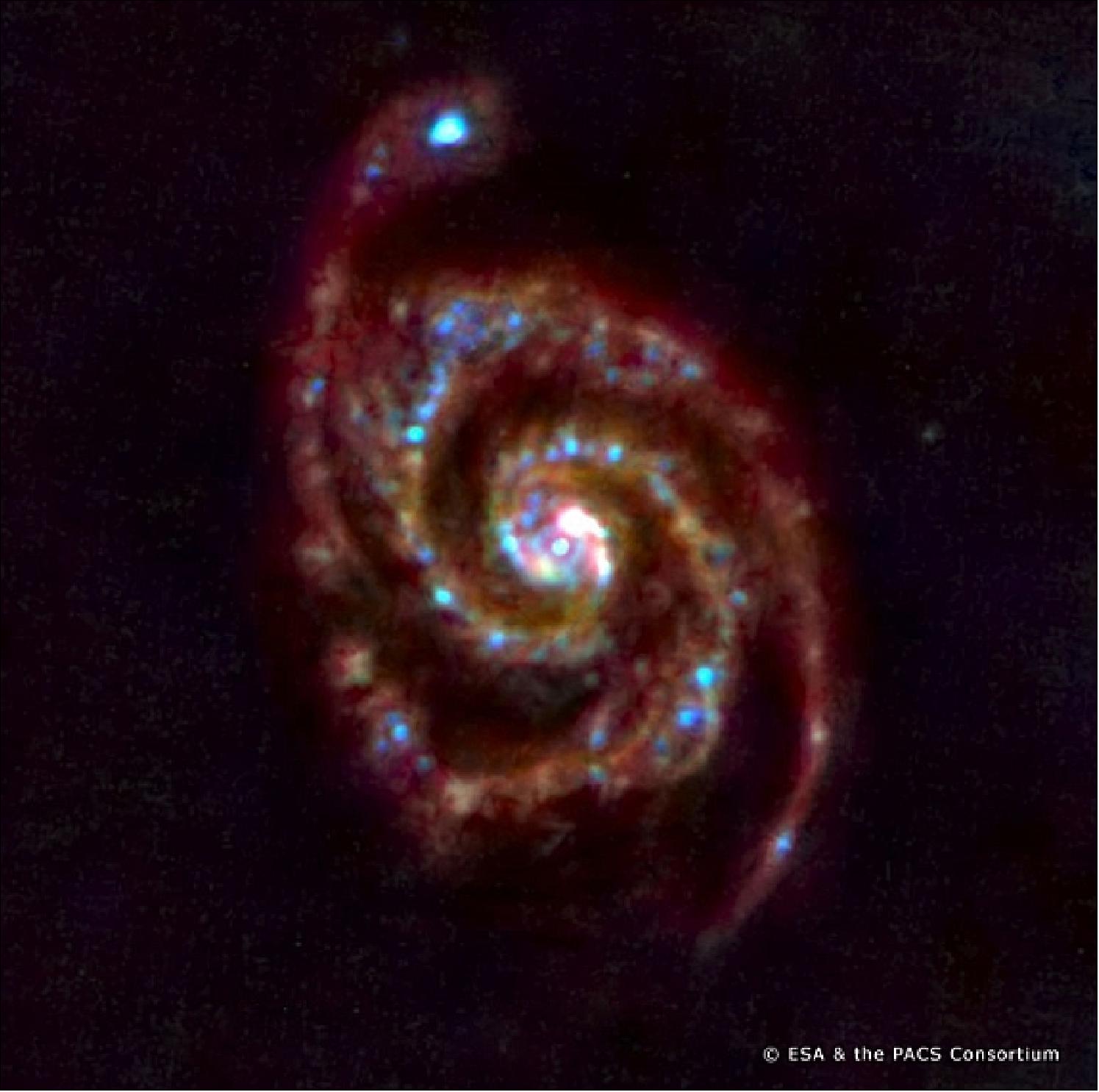
• A few days after the perfect injection of the Herschel spacecraft, ESA/ESOC concluded the LEOP phase coverage (releasing the additional ground stations that enabled near-continuous contact between mission controllers and Herschel). The nominally assigned stations are now New Norcia (Australia) and Cebreros (Spain). The commissioning activities of the spacecraft's service module began on May 15, 2009. All of the satellite's subsystems have shown nominal performance, and commissioning continues. 132)
• On May 16, 2009, two days after launch, the Herschel spacecraft used its mobile phone technology (the GMSK-modulated High Data Rate downlink) to radio back to Earth. Herschel was using the same technology implemented in GSM (Global System for Mobile communications) mobile phone networks to send test data to ESA's deep space tracking station. Herschel's 1.5 Mbit/s test transmission - roughly the same data rate provided by a home broadband Internet connection - was picked up at ESA's ESTRACK (ESA Tracking stations network) station at New Norcia, Australia, as the satellite was travelling some 280,000 km from Earth.
This event marks the first-ever use of GMSK (Gaussian Minimum Shift Keying) modulation in a spaceborne mission. GMSK is commonly used in GSM mobile phone networks due to its very efficient use of bandwidth and power. During the mission, the GMSK-based radio links will be used by the spacecraft to transfer data gathered by the scientific instruments and on-board subsystems, providing information on flight status and overall health. 133) 134)
Sensor Complement
With the biggest mirror yet flown in space, Europe's new Herschel Space Observatory will peer through a new wavelength window at the cool and diffuse regions, such as interstellar and circumstellar dust and gas, in the Galaxy as well as in extragalactic objects. With the wide wavelength coverage of its scientific instruments and highly sensitive detectors Herschel will provide crucial data for understanding the formation of galaxies and stars and the dynamics of late stages of stellar evolution. (Ref. 7). 135) 136) 137)
The Science Team was formed in 1998, its composition is derived from ESA, the instrument consortia, and a number of Mission Scientists representing the astronomical community `at large'. In 2001 the Herschel Optical System Scientist was added. It is chaired by the Herschel Project Scientist.
The Herschel science payload comprises three instruments which have been conceived and optimized with the prime science goals in mind. The instruments offer a wide range of capabilities to cater for a wide and diverse range of observing programs. The instruments were selected from the response to an Announcement of Opportunity (AO) issued in October 1997.
The science instruments are 'nationally' funded by the ESA member states. In addition, there is international collaboration with NASA, CSA (Canadian Space Agency), and Poland.
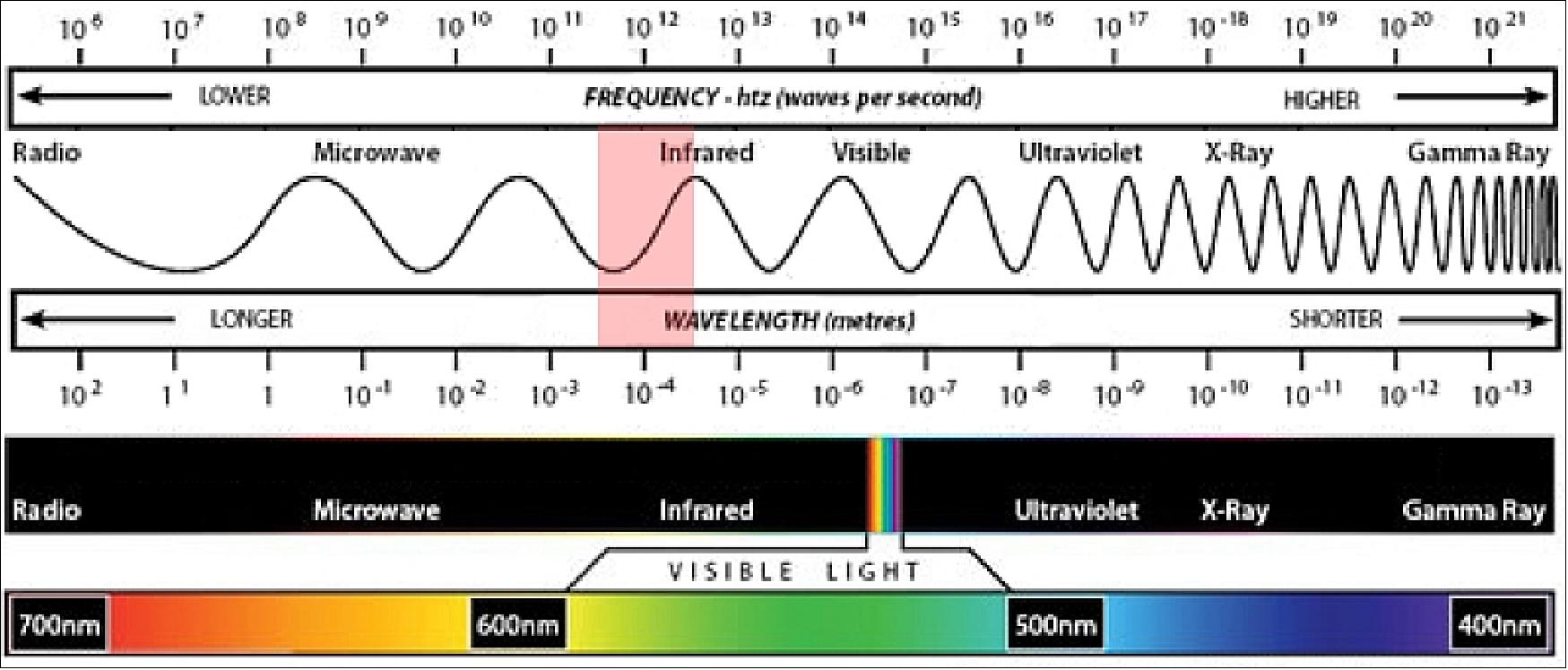
Instrument | Wavelength range |
HIFI (Heterodyne Instrument for the Far-Infrared) | 157 – 213 µm, 240 – 625 µm |
PACS (Photodetector Array Camera and Spectrometer) | 55 - 210 µm |
SPIRE (Spectral and Photometric Imaging REceiver) | 194 - 672 µm |
HIFI (Heterodyne Instrument for the Far-Infrared)
HIFI was designed and developed by an international consortium led by SRON. PI: Thijs de Graauw, SRON (Space Research Organization Netherlands), Groningen, The Netherlands. Co-PIs: Tom Phillips, Caltech, USA; Emmanuel Caux, CESR, France; Jürgen Stutzki, University of Cologne, Germany. Major funding of HIFI was provided by SRON (Netherlands), DLR (Germany), NASA (USA), CNES and CNRS (France). The consortium includes institutes from France, Germany, USA, Canada, Ireland, Italy, Poland, Russia, Spain, Sweden, Switzerland and Taiwan. 139) 140) 141) 142)
The main objectives of HIFI are:
- Probing the physics, kinematics, and energetics of star forming regions through their atomic and molecular cooling lines
- Surveying the molecular inventory of such diverse regions as shocked molecular clouds, PDRs, diffuse atomic clouds, hot cores, proto-planetary disks around new stars, winds of dying stars, and the toroids around AGNs (Active Galactic Nuclei)
- Measuring the out-gassing of comets and the vertical distribution in the giant planets of molecules such as H2O
- Measuring the mass loss regulating post main-sequence stellar evolution and the gas/dust ISM (Inter Stellar Medium) replenishment
- Measuring the intense galactic [CII] emission so as to probe the ionized and warm neutral components of the ISM.
The HIFI science objectives center around understanding the cyclic interrelation between the stars and the interstellar medium in galaxies. The goal is to detect many molecular rotational line transitions and fine-structure transitions of atoms, ions and isotopes as the cool ISM reprocesses essentially all central-source radiation to the FIR and sub-mm regime and gives clear indications of its composition and physical conditions.
HIFI instrument consists of five major subsystems, shown in the block diagram of Figure 86.
1) The FPU, located inside the cryostat, contains the relay optics, diplexers for LO injection, a focal-plane chopper, mixers, low-noise IF pre-amplifiers, and calibration sources. The FCU (FPU Control Unit), located at the SVM (Service Module), supplies the bias voltages for mixers and IF preamplifiers in the FPU and controls the LO diplexers, the focal plane chopper mechanism and the calibration source.
2) The local oscillator subsystem comprises the LOU (Local Oscillator Unit) mounted on the outside of the cryostat. The LOU contains 7 LOAs (Local Oscillator Assemblies), each contain two LO multiplier chains and their feeding power amplifiers/triplers. These chains are fed by a common LSU (LO Source Unit) and generate the LO signals which are coupled into the FPU via 7 windows in the cryostat wall. The LSU and a LCU (Local Oscillator Control Unit) are located SVM and contain the reference frequency source and the bias supplies and controls of the local oscillator.
3) The WBS (Wide-Band Spectrometer) consists of a pair of 4 GHz wide AOS (Acousto-Optical Spectrometers) with a frequency resolution of about 1 MHz and a bandwidth of 4 GHz for each of the two polarizations. They are located in the SVM.
4) A High-Resolution Spectrometer (HRS) [2] consists of a pair of auto-correlator spectrometers and will provide several combinations of bandwidth and frequency resolutions. The HRS is divided into 4 sub-bands, each of which can be placed anywhere within the full 4 GHz IF band. The HRS modules will also be located in the SVM.
5) An ICU (Instrument Control Unit) within the SVM interprets commands from the satellite telecommand system, controls the operation of the instrument, and returns science and housekeeping data to the satellite telemetry system.
The HIFI instrument combines the high spectral resolution of the radio heterodyne technique with the low noise detection. The FPU contains seven mixer units, each being equipped with two orthogonally polarized mixers. Five mixers, covering the lower frequency range from 480 GHz up to 1250 GHz, are realized in SIS (Superconductor-Insulator-Superconductor) technology, the remaining two use HEB (Hot Electron Bolometer) technology optimized to cover the range between 1.41 THz and 1.91 THz. One mixer at a time multiplies the optical signal seen through the Herschel telescope with a single frequency quasi-optical input signal, provided by the LOU.
Low noise pre-amplifiers, realized in HEMT (High Electron Mobility Transistor) technology, provide the required amplitudes for the IF (Intermediate Frequency) band, that is transmitted via coaxial cables to two pairs of spectrometers located on the service module panels: Two wide band spectrometers optimized to achieve 1 MHz resolution over 4 GHz bandwidth, and two high resolution spectrometers consisting of a pair of auto-correlator spectrometers with several combinations of resolution and bandwidth.
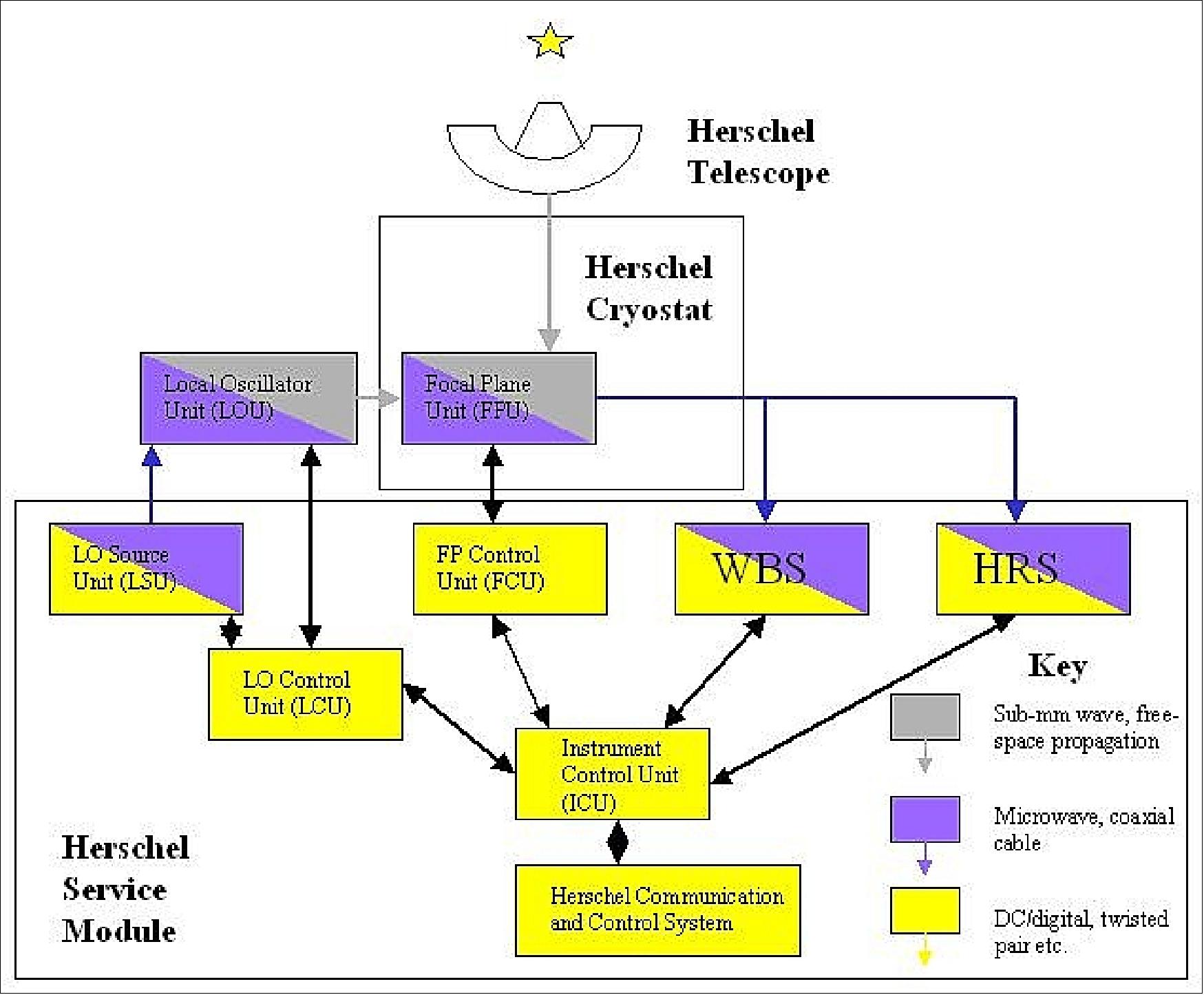
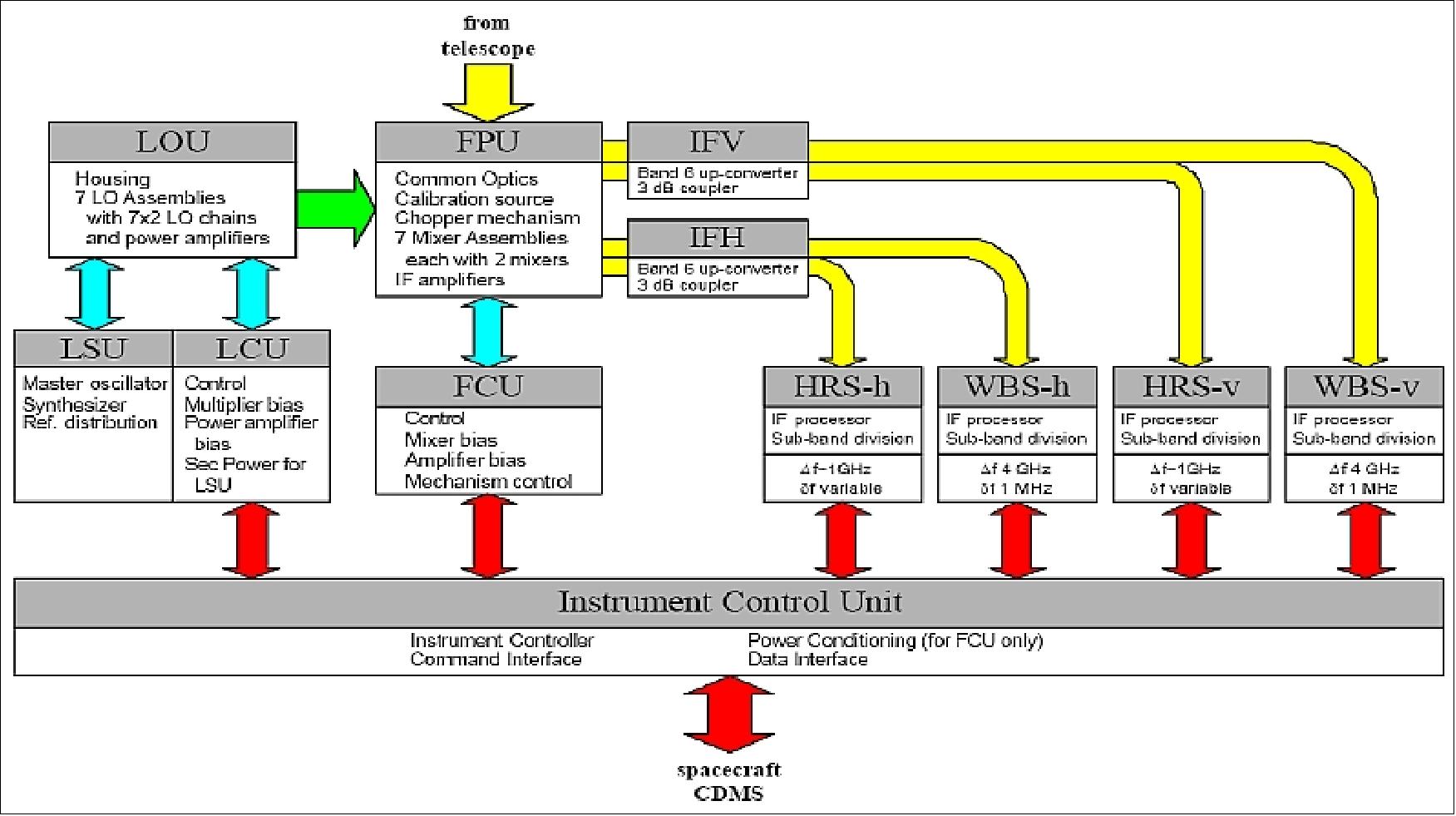
The ICU (also referred to as DPU) is the only HIFI subsystem that interfaces electrically with the spacecraft for telemetry and telecommand. It distributes electrical power to the FCU, it takes care of the command execution and synchronization, it packages the telemetry and provides the health-autonomous mode. The ICU electronics consists of a single box, positioned in the warm part of the S/C and as close as possible to the FCU, LCU, WBS-V, WBS-H, HRS-V and HRS-H subsystems.
The interface with the spacecraft handles the baseline data rate of ~100 kbit/s and is compliant with the MIL-STD-1553B bus standard. The ICU is acting as a Remote Terminal and the CDMS (Command and Data Management Subsystem) as the bus controller. The ICU design concept and hardware has a very high degree of commonality with the data processing units of PACS and SPIRE.


General instrument features:
• The HIFI instrument provides continuous frequency coverage over the range 480-1250 GHz (625-240 µm) in five bands with approximately equal tuning range. An additional pair of bands provide coverage of the frequency range 1410-1910 GHz (213-157 µm). The instrument operates at only one local oscillator frequency at a time.
• In all mixer bands two independent mixers receive both horizontal and vertical polarizations of the astronomical signal, although in some cases reduced bandwidth or use of a single polarization is required to stay within the data rate available to the instrument.
• The user has the choice of using only a single polarization if he/she chooses.
• The first 5 mixer bands use SIS (superconductor-insulator-superconductor) mixers; bands 6 and 7, use Hot-Electron Bolometers (HEBs).
• The instantaneous bandwidth of the instrument will be 4 GHz.
Band | Mixer type | LO Lower frequency | LO Upper frequency | Beam size (HPBW) | IF Bandwidth |
1 | SIS | 488.1 GHz | 628.1 GHz | 39 arcsec | 4.0 GHz |
2 | SIS | 642.3 GHz | 792.9 GHz | 30 arcsec | 4.0 GHz |
3 | SIS | 807.1 GHz | 952.9 GHz | 25 arcsec | 4.0 GHz |
4 | SIS | 967.1 GHz | 1112.8 GHz | 21 arcsec | 4.0 GHz |
5 | SIS | 1116.2 GHz | 1241.8 GHz | 19 arcsec | 4.0 GHz |
6+7 | HEB | 1412.2 GHz | 1907.8 GHz | 13 arcsec | 2.4 GHz |
In Table 8, the values presented are Local Oscillator frequencies. Each band is further split in two ("a" and "b") due to the use of two Local Oscillator chains for the lower and upper portions of the frequency range for each band. A further 8 GHz is available at each end of the frequency range due to the frequency placement of the upper and lower sidebands in HIFI.
The HIFI Focal Plane Subsystem consists of three hardware units: 143)
1) FPU (Focal Plane Unit) which is located on the optical bench in the Herschel cryostat
2) Up-converter and 3 dB Coupler, contained in the satellite's service module (SVM)
3) FCU (FPU Control Unit), also contained in the satellite's SVM.
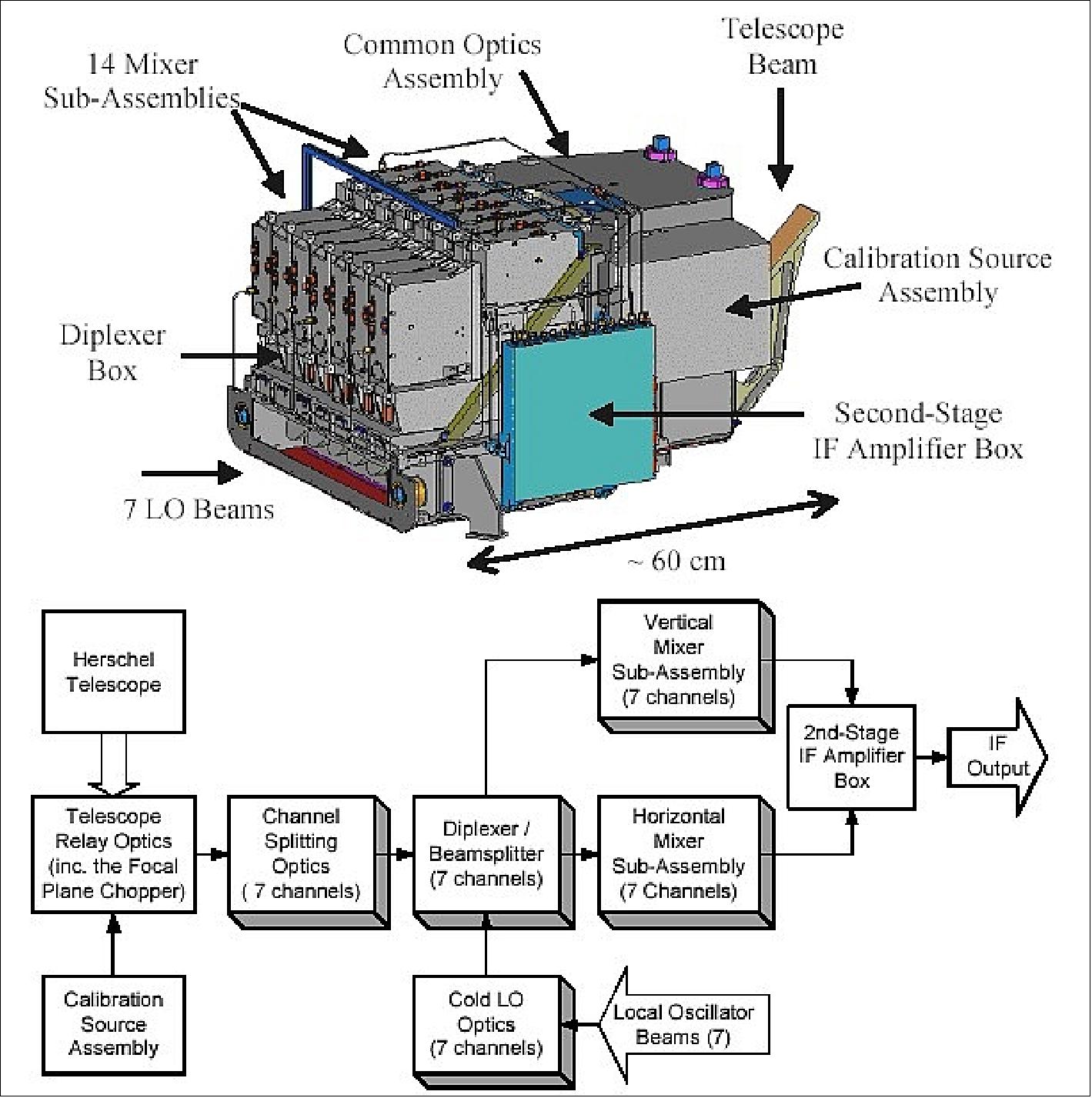
In reality, the HIFI signal chain is a virtual unit, since its elements are physically distributed throughout the FPU. The complexity of the FPU has necessitated a modular design in which the FPU is divided into six major assemblies: the Common Optics Assembly; the Diplexer (beam combiner) Assembly; the Mixer Sub-Assemblies (of which there are 14); the second-stage IF amplifier box; the Focal Plane Chopper; and the Calibration Source Assembly.
The optics assembly relay the instrument's 7 signal beams from the telescope's focal plane into a diplexer box. This is done with 6 common mirrors (the telescope relay optics (Figure 90) and 7 sets of 3 mirrors (the channel-splitting optics). Together, these optics have three primary functions:
• They produce an image of the telescope secondary on the fourth mirror in the chain after the secondary (M6), enabling the implementation of a Focal Plane Chopper.
• They produce an image of the telescope focal plane on the first mirrors in the Channel-Splitting Optics, allowing the beams to be split by seven mirrors with different orientations.
• In each channel, they create an image of the telescope secondary within the beam combiner assembly. This image has a large Gaussian beam waist, to minimize diffraction losses, and a frequency independent size, to simplify visible-light alignment.
The seven local oscillator beams from the LOU (Local Oscillator Unit) and enter the FPU through windows in the cryostat. Using 7 sets of five mirrors, the Cold Local Oscillator Optics re-image the LO beam waists at the FPU input to waists in the diplexer box that match those produced by the channel-splitting optics.
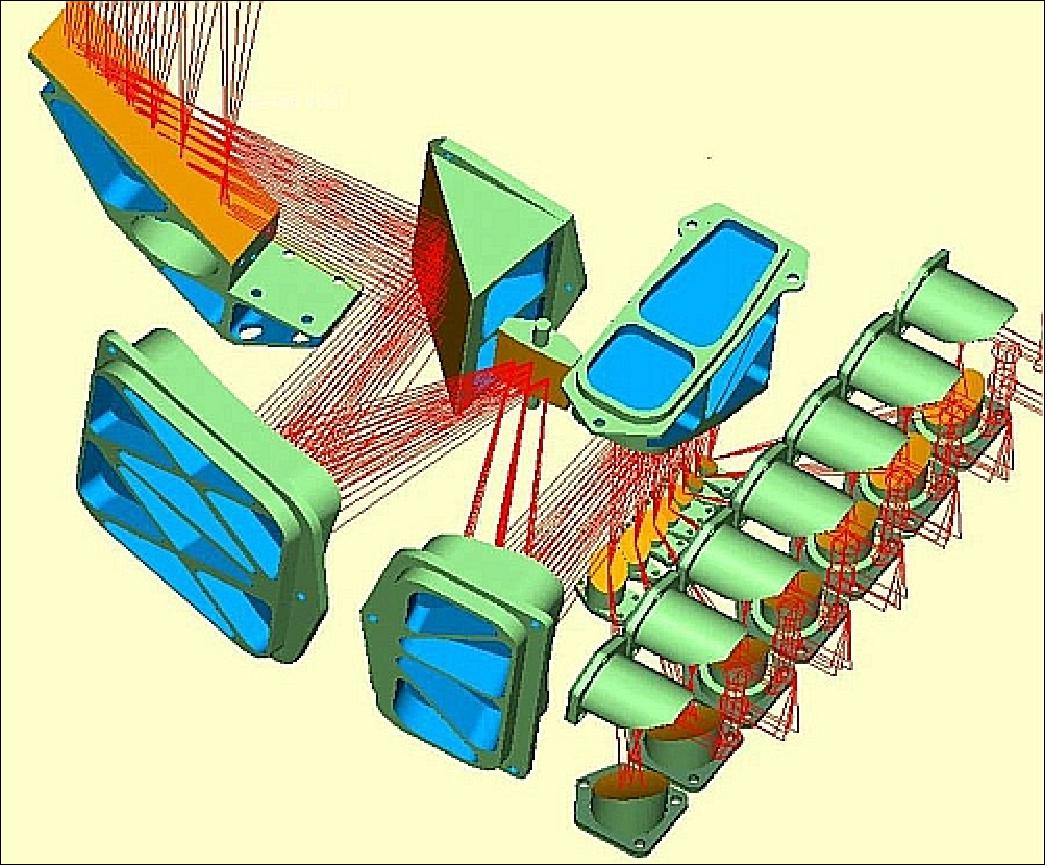
Within the beam combining assembly, each of the 7 signal beams is combined with its corresponding local oscillator beam, creating two linearly polarized beams per channel (referred to as Horizontal, H, and Vertical, V, beams). Each of these 14 beams is then directed into a Mixer Sub-Assembly. At low frequencies, where significant LO powers are available, the combining is done with polarizing beamsplitters (Figure 91).
At high frequencies, where LO power is scarcer, a Martin-Puplett diplexer is used for LO injection. As in the beamsplitter channels, the first beamsplitter creates two beams containing LO and signal power in orthogonal polarizations. However, in this case, the second beamsplitter is replaced with a polarizing Michelson interferometer that rotates the LO beam polarization relative to that of the signal beam, creating a linearly polarized output. In this manner, the coupling of both the LO and signal powers to the mixers is high (95%, or better), although diplexer scanning mechanisms are needed for frequency tuning.
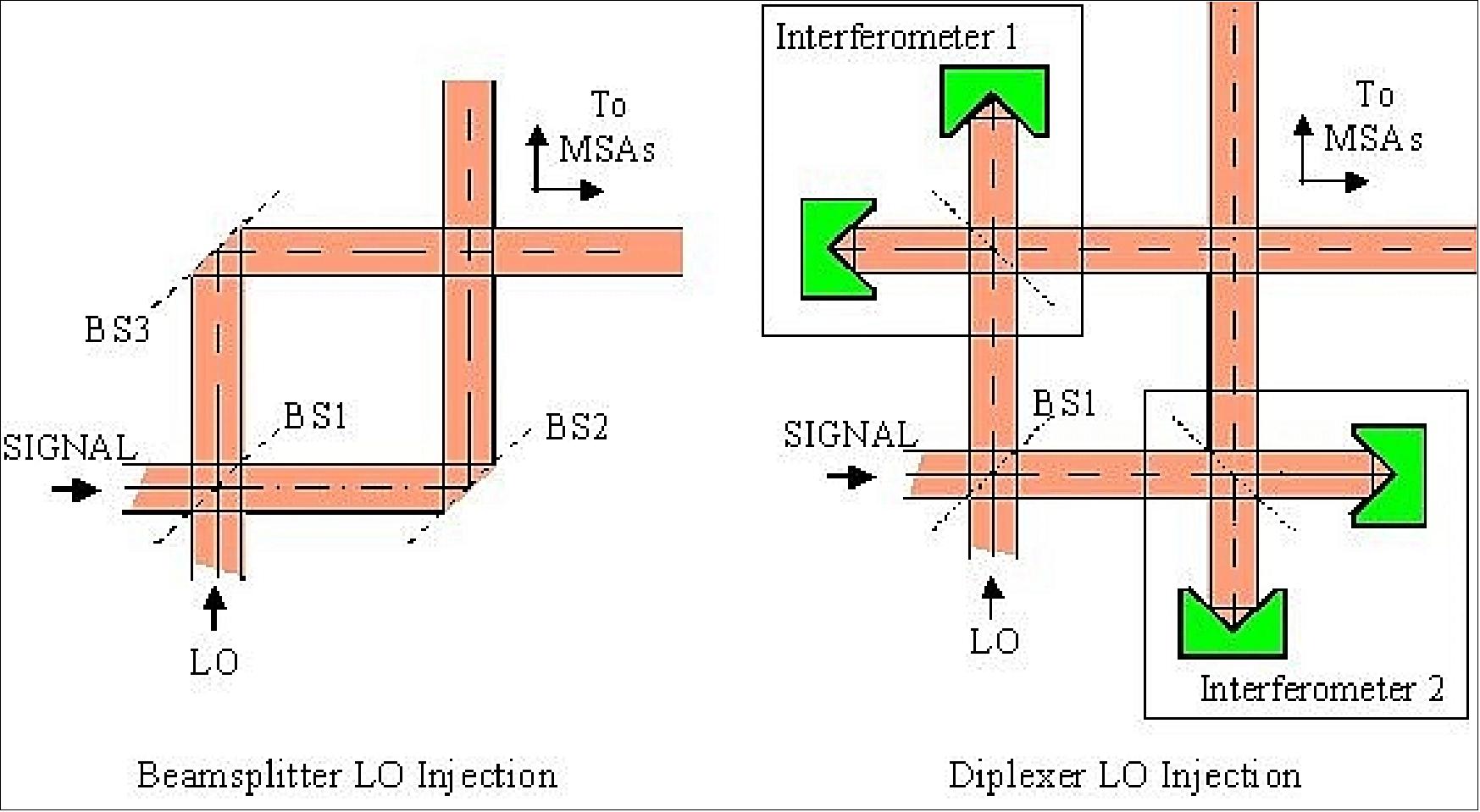
HIFI mixers: The mixers at the heart of the FPU largely determine the instrument's sensitivity. For this reason, the mixer technologies used in each band have been selected to yield the best possible sensitivity. In particular, a range of Superconductor-Insulator-Superconductor (SIS) mixer technologies are being used in the lowest 5 frequency bands (covering 480-1250 GHz) while the top two bands (covering 1410-1910 GHz) incorporate Hot Electron Bolometer mixers (HEB mixers).
Each of the 14 linearly polarized outputs from the diplexer/beam combiner box enters a Mixer Sub-Assembly (MSA) that includes:
- a set of three mirrors that focus the optical beam into the mixer
- a mixer unit where the incoming signal and LO signal are combined
- a low-noise IF amplifier (plus two IF isolators that suppress reflections in the cable between the mixer and the amplifier)
- low-frequency filtering for the mixers DC bias lines
- a mechanical structure that thermally isolates the mixer unit (at 2 K) from the FPU structure (at 10 K).
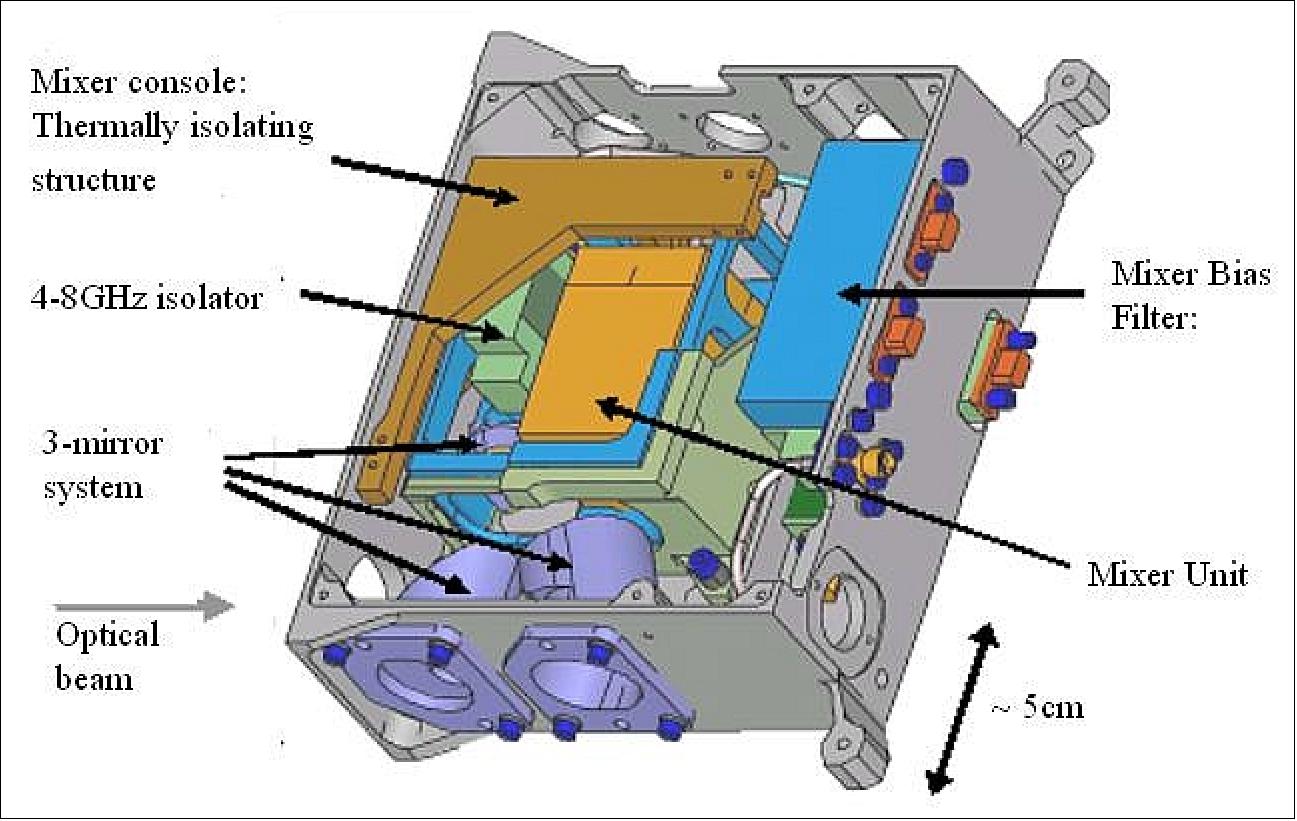
The FPC (Focal Plane Chopper) is the sixth mirror of the telescope relay optics. The chopper mirror is able to rotate (in one direction) around the center of its optical surface. Tilting the chopper is equivalent to tilting the telescope secondary, which moves the beam on the sky. The primary uses of the chopper are to steer the beam on the sky, and to redirect the instrument's optical beam into the on-board calibration sources.
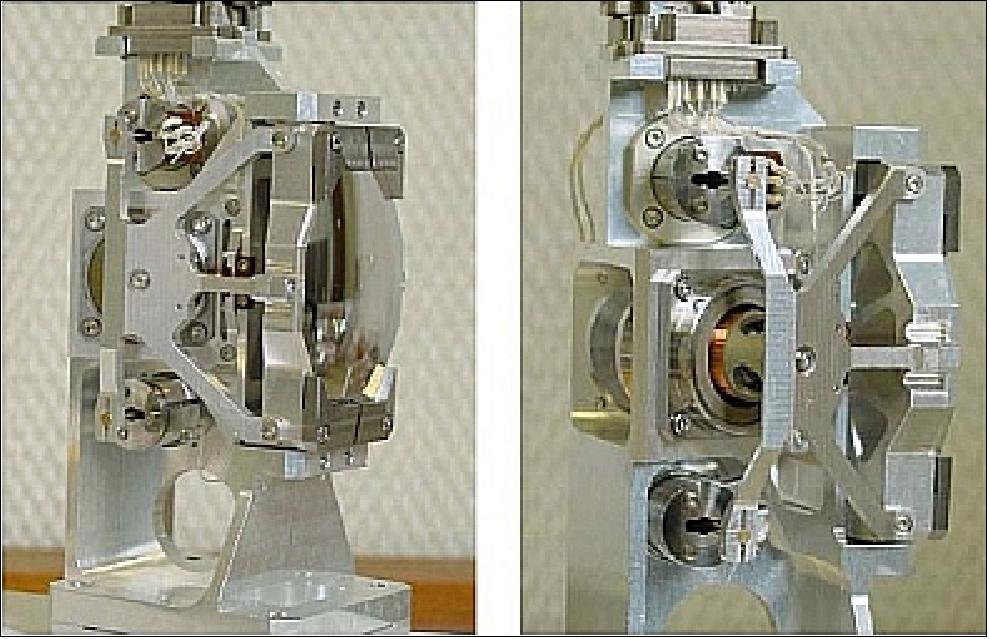
CSA (Calibration Source Assembly): Mounted on the side of the Common Optics Assembly, the CSA includes two blackbody signal loads that are used to calibrate the instrument's sensitivity (the first is an absorber at the FPU temperature around 10 K, while the second is a lightweight blackbody cavity that can be heated to 100 K), plus mirrors that focus the FPU's optical beam into the loads. Temperature sensors are available to read out the actual temperature of both calibration loads. The HIFI optical beam is steered towards the calibration sources by the use of extreme positions of the Focal Plane Chopper.
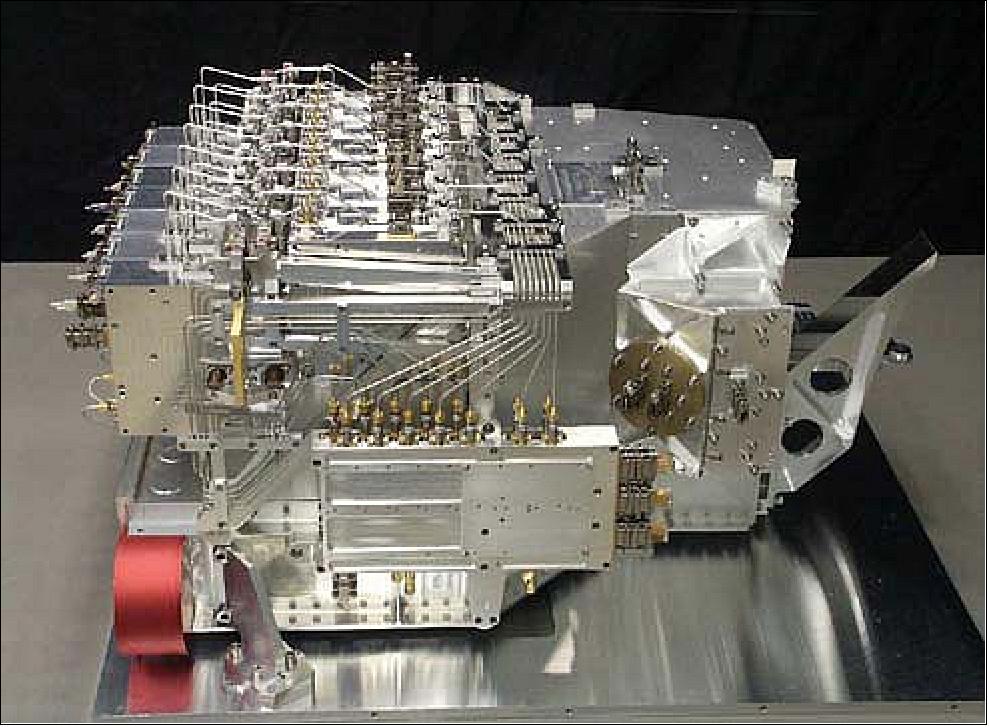
•Complete coverage of 480-1250 and 1410-1910 GHz (corresponding to 625-240 and 213-157 µm), to allow multiples lines of important molecules, such as H2O, to be sampled, and to allow broad, unbiased spectral surveys |
• A resolving power of up to 107, corresponding to a velocity resolution up to 0.03 km/s (requiring a narrow local oscillator line-width and an IF (Intermediate Frequency) spectrometer -- measuring the frequency difference between signal and local oscillator signals -- with a resolution of up to 125 kHz |
• A receiver sensitivity of 3-4 times the quantum limit, to make maximum use of the limited satellite lifetime (requiring low-noise mixers and IF amplifiers) |
• A large instantaneous bandwidth (4 GHz in each sideband) to increase spectral survey speeds, to minimize the risk of spectral coverage gaps, and to observe broad features (requiring mixers, amplifiers, and a spectrometer with 4 GHz of IF bandwidth) |
• Dual-polarization operation to make maximum use of the energy collected by the HIFI optical beam |
• At least 10% calibration accuracy (with a goal of 3%) |
Notes:
1) The time needed to observe a weak spectral line scales inversely with the square of the receiver noise temperature.
2) The bandwidth is only 2.4 GHz in bands 6 and 7 (due to a bandwidth limitation in the state-of-the-art HEB mixers that are used at these high frequencies).
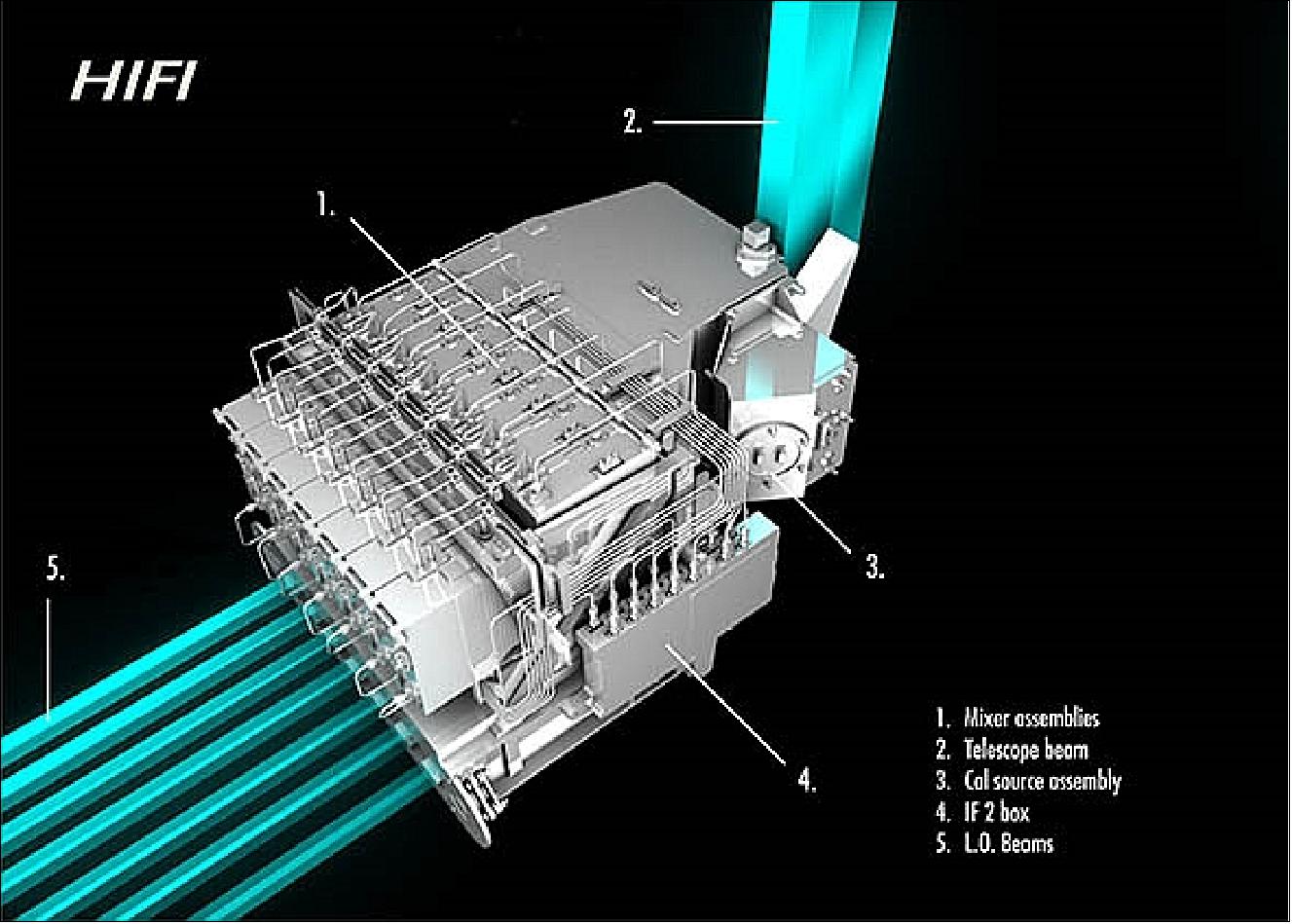
HIFI observing modes: For HIFI, three ATOs (Astronomical Observing Templates) are available:
• AOT I: Single Point, for observing science targets at one position on the sky
• AOT II: Mapping, for covering extended regions
• AOT III: Spectral Scanning, for surveying a single position on the sky over a continuous range of frequencies selected within the same LO band by the user.
Each AOT can be used in a variety of different modes of operation, providing the widest range of options for performing spectroscopic science observations in different astronomical that HIFI and the Observatory will allow, in terms of reference measurements and calibration. In other words, the three AOTs come with Observing Modes where the user may select from different calibration modes, choosing the mode best suited to the observing situation and science goals.
Observations created in one of the three AOTs may be performed in a number of different observing modes, which differ mainly in the selection of the reference measurements during the course of observing. All observations consist of source measurements, reference measurements and a set of calibration measurements that may be used to fully calibrate the spectra in both frequency and intensity. Observing mode design is intended to supply an optimum balance between observing efficiency and self-contained calibrations timed by instrumental performance and stability metrics. The currently designed observing modes and their relation to the AOTs is given in Figure 96.
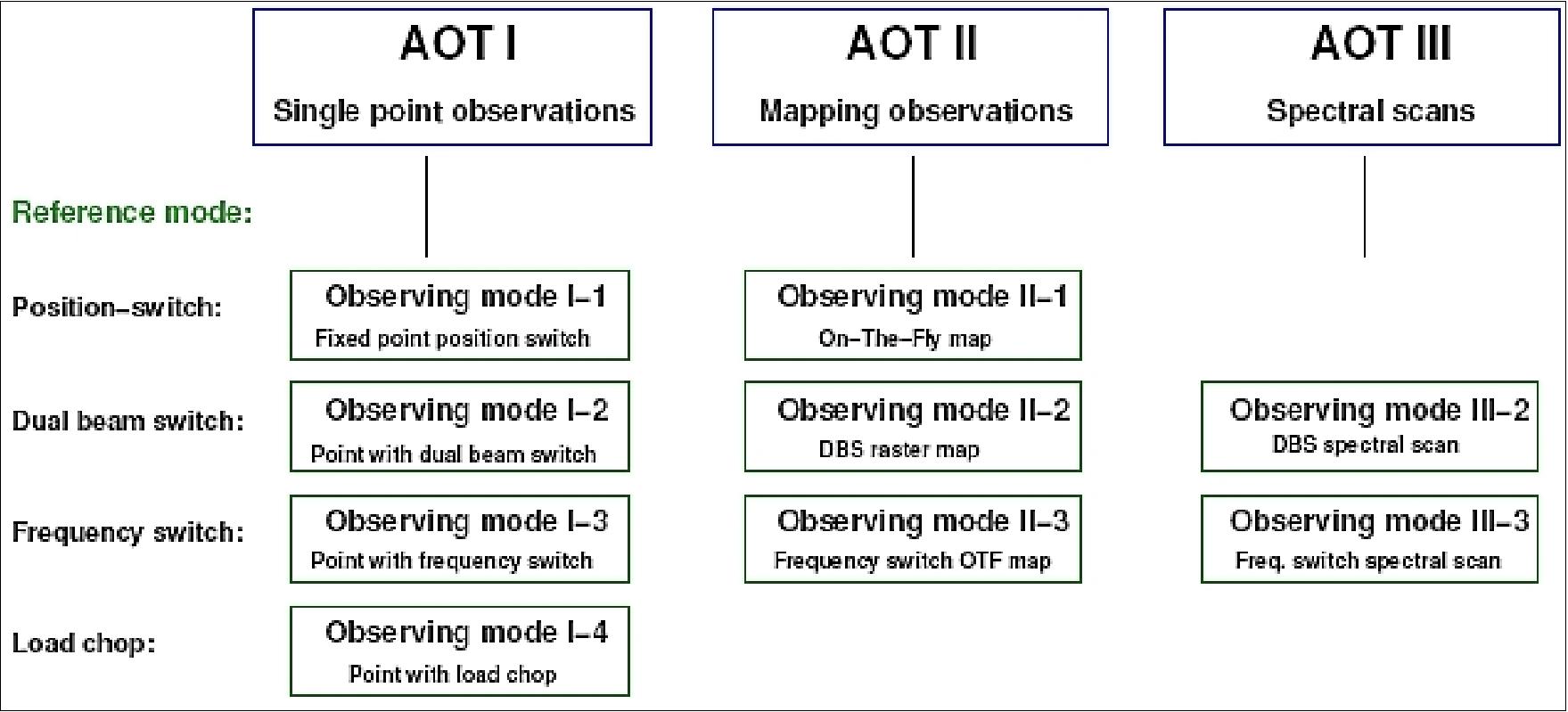
PACS (Photodetector Array Camera and Spectrometer)
The PACS instrumentation was designed and built by a consortium of institutes and university departments from across Europe under the leadership of Albrecht Poglitsch (PI: Principal Investigator) at MPE (Max-Planck-Institute for Extraterrestrial Physics), Garching, Germany. The Co-PI is Christoffel Waelkens of KU Leuven, Belgium. The consortium members are: Austria: UVIE (University of Vienna); Belgium: IMEC, KUL (Katholieke Universiteit Leuven), CSL (Centre Spatiale de Liege); France: CEA (Commissariat a l'Energie Atomique), OAMP; Germany: MPE, MPIA (Max-Planck-Institut für Astronomie); Italy: IFSI (Istituto di Fisica dello Spazio Interplanetario), OAP/OAT, OAA/CAISMI, LENS, SISSA; Spain: IAC (Instituto de Astrofísica de Canarias). Major funding was provided from from DLR and MPG (Germany), BELSPO/PRODEX (Belgium), CNES and CEA (France), ASI (Italy), Ministerio de Ciencia y Tecnologia (Spain), and the Ministry of Science and Research (Austria).
PACS consists of a color camera and an imaging spectrometer. Within its wavelength range (55–210 µm), the PACS camera is the first instrument capable of obtaining the complete image of a target at once. The PACS spectrometer has a lower resolution than that of HIFI, but it is perfectly suited to seeing young galaxies and the gas clouds from which stars form. 144) 145) 146) 147) 148)
PACS operates either as a special camera (photometer), in two colors simultaneously, or as a spectrometer, using either its bolometer or its photoconductor array detectors.
PACS provides two basic operational modes in the wavelength band 57 - 210 µm:
• Imaging dual-band photometry (60-85 µm or 85-125 µm and 125-210 µ) over a FOV (Field of View) of 1.75 arcmin x 3.50 arcmin, with full sampling of the telescope point spread function (diffraction/wavefront error limited)
• Integral-field line spectroscopy between 55 and 210 µm with a resolution of ~ 75-300 km/s and an instantaneous coverage of ~ 1500 km/s, over a FOV of 47 arcsec x 47 arcsec (or 47” x 47'').
Both modes allow spatially chopped observations by means of an instrument-internal chopper mirror with variable throw; this chopper is also used to alternatively switch two calibration sources into the FOV.
Figure 97 shows an optical circuit block diagram of the major functional parts of PACS. At the top, the entrance and calibration optics is common to all optical paths through the instrument. On the right, the spectrometer serves both, the short-wavelength (“blue”), and long-wavelength (“red”) photoconductor arrays. A fixed dichroic beam splitter separates blue from red spectrometer light at the very end of the optical path. On the left, the bolometer fixed dichroic beam splitter comes before the blue and red imaging branches since they require different magnification. Directly in front of their baffle enclosures the blue detectors have filter wheel mechanisms which contain the bandpass filters for short wavelength photometry, and the order selection band passes for 2nd and 3rd order operation of the grating spectrometer, respectively.
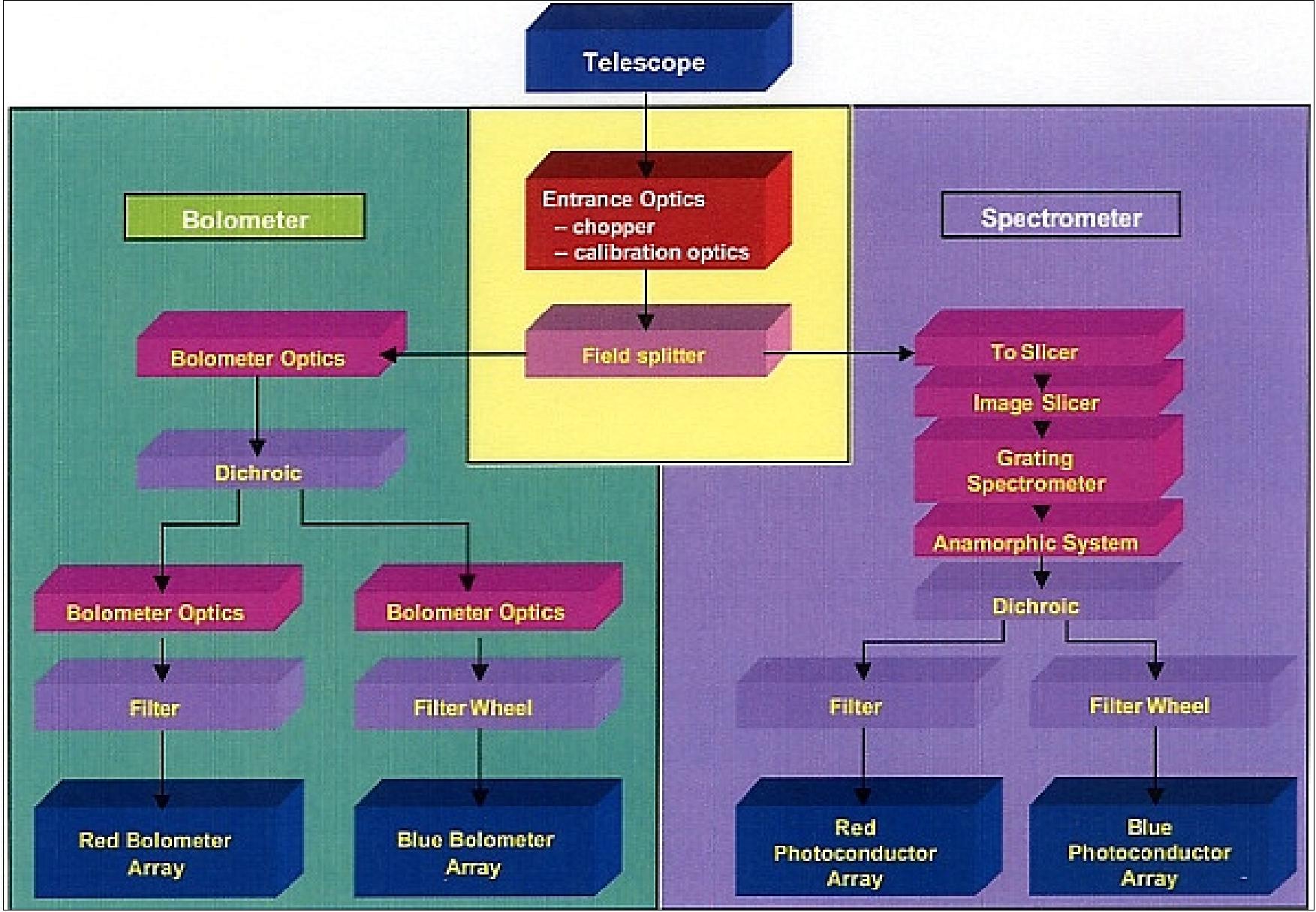
The focal plane sharing of the instrument channels is shown in Figure 98. The photometric bands, which can be observed simultaneously, cover the same FOV. The FOV of the spectrometer is offset from the photometer field. However, this has no effect on the observing efficiency.
The focal plane unit provides photometric and spectroscopic capabilities through five functional units :
- common input optics with the chopper, calibration sources and a focal plane splitter
- a photometer optical train with a dichroic beam splitter and separate re-imaging optics for the two short-wavelength bands (60-85 µm/ 85-130 µm) selectable via a filter wheel and the long-wavelength band (130-210 µm), respectively
- two bolometer arrays with cryogenic buffers/multiplexers and a common 0.3 K sorption cooler
- a spectrometer optical train with an image slicer unit for integral field spectroscopy, an anamorphic collimator, a movable diffraction grating in Littrow mount, anamorphic re-imaging optics, and a dichroic beam splitter for separation of diffraction orders. The blue channel contains an additional filter wheel for selecting its short or long wavelength part
- two photoconductor arrays with attached cryogenic readout electronics (CRE).
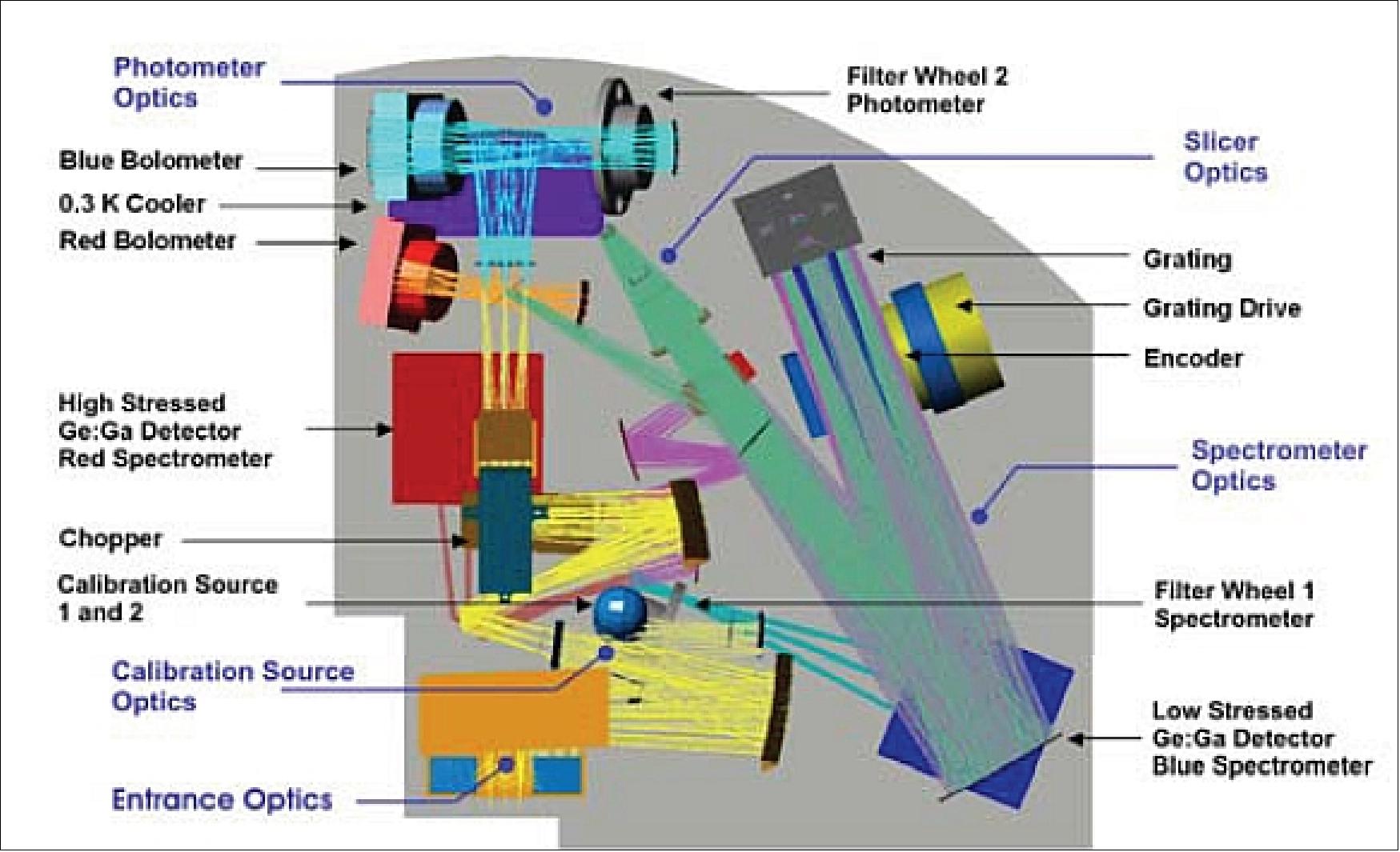

Legend: to Figure 99: Long-wavelength and short-wavelength photometry bands cover identical FOVs. The spectrometer FOV is offset in the -z direction. Chopping is done along the y axis (left-right in this view) and also allows observation of the internal calibrators on both sides of the used area in the telescope focal plane. The chopper throw for sky observations is ±1/2 the width of the photometer field such that object and reference fields can be completely separated (photometer field 1 and 2).
The photometric bands, which can be observed simultaneously, cover the same FOV, while the FOV of the spectrometer is offset from the photometer field. Since photometry and spectroscopy operation are mutually exclusive this has no effect on the observing efficiency.
Parameter | 70 µm (blue band) | 100 µm (green band)) | 160 µm (red band) |
Wavelength range (µm) | 60-85 | 85-130 | 130-210 |
Resolution | ~3 | ~2 | |
Pixel size (arcsec) | 3.2 | 6.4 | |
FOV (arcmin) | 3.5 x 1.75 | ||
FWHM (Full Width Half Maximum) | 5.2 arcsec | 7.7 arcsec | 12 arcsec |
Bolometer arrays: The PACS bolometers are filled arrays of square pixels which allow instantaneous beam sampling. 4 x 2 monolithic sub-arrays of 16 x 16 pixels are tiled together to form the short-wave focal plane array (Figure 100). The subarrays are mounted on a 0.3 K carrier which is thermally isolated from the surrounding 2 K structure. The buffer/multiplexer electronics is split in two levels; a first stage is part of the indium-bump bonded back plane of the focal plane arrays, operating at 0.3 K, and a buffer stage running at 2 K. The multiplexing readout samples each pixel at a rate of 40 Hz or 20 Hz. Both array assemblies are mounted in a subunit of the FPU (Focal Plane Unit) together with the 0.3 K cooler which provides uninterrupted operation for two days.
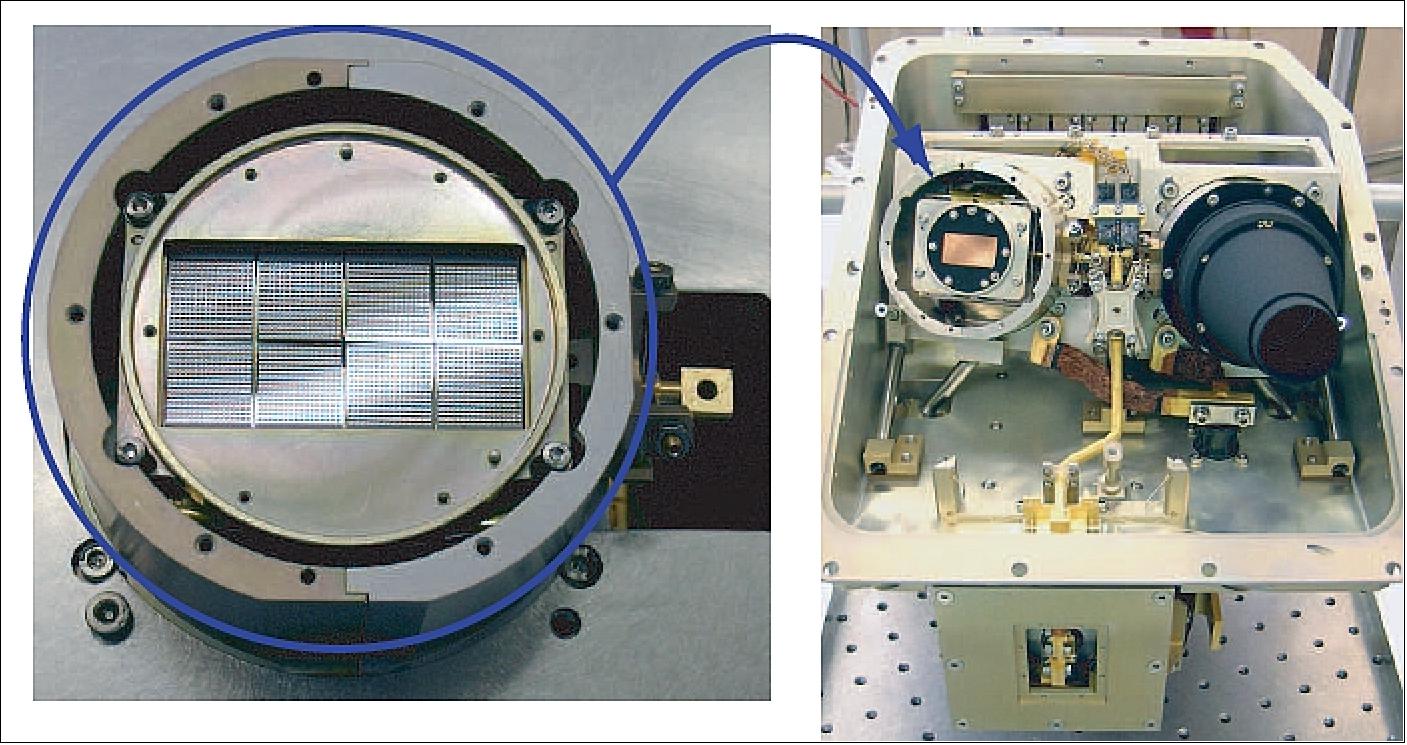
Legend to Figure 100: The 0.3 K focal plane is suspended from its 2 K enclosure by Kevlar strings. Close to the right edge of the left picture, the thermal interface to the 0.3 K cooling bar is visible. The complete photometer subunit with the two bolometer assemblies (short-wave, baffle cone removed / long-wave, with baffle cone) and the 0.3 K sorption cooler is shown in the right panel.
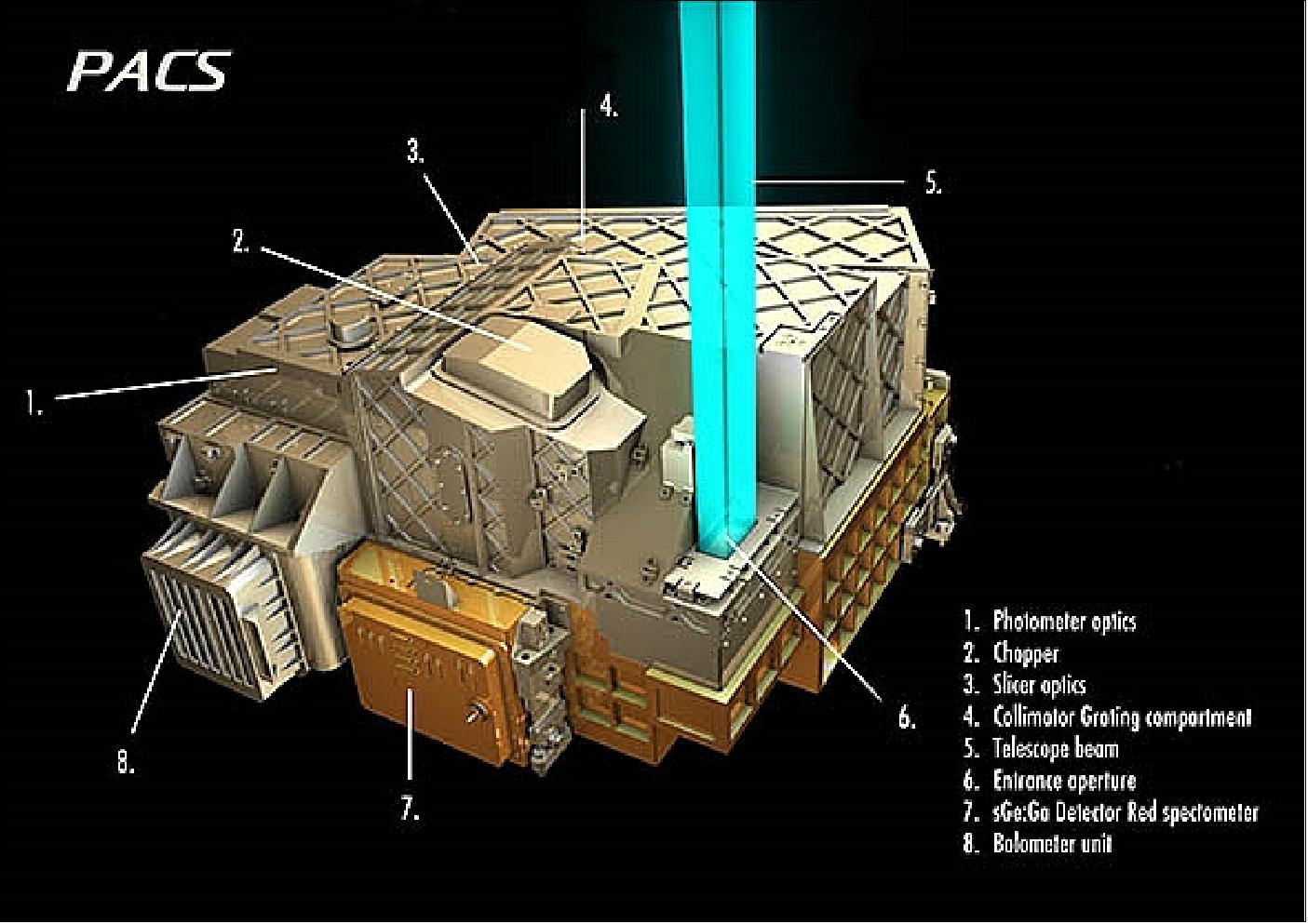
Spectrometer
The spectrometer covers the wavelength range from 55 µm to 210 µm, in two channels that operate simultaneously in the blue (55-98 µm) and red (102-210 µm) band. It provides a resolving power between 1000 and 5000 (i.e. a spectral resolution of ~75-300km/s), depending on wavelength for a fixed grating position The instantaneous coverage is ~1500km/s. It allows simultaneous imaging of a 47" x 47" FOV, resolved in 5 x 5 pixels. An image slicer employing reflective optics is used to re-arrange the 2-D FOV along a 1 x 25 pixels entrance slit for the grating.
This integral-field concept allows efficient detection of weak individual spectral lines with sufficient baseline coverage and high tolerance to pointing errors without compromising spatial resolution, as well as for spectral mapping of extended sources regardless of their intrinsic velocity structure.
Image slicer: The image slicer's main function is to transform the 5 x 5 pixel image at its focal plane into a linear 1 x 25 pixel entrance slit for the grating spectrometer. The slicer assembly consists of 3 set of mirrors:
- The slicer stack: 5 identical spherical field mirrors, individually tilted, which forms separate pupil images for each "slice" on the set of 5 capture mirrors.
- The capture mirrors re-combine the separate beams into the desired linear image on the set of 5 spherical mirrors at the exit of the slicer assembly.
- The field mirrors at the exit re-combine the pupils separated in the slicer into a common virtual pupil. The collimators of the spectrometer will later form an (anamorphic) image of this virtual pupil onto the grating. At the same time, the field mirror apertures serve as the entrance slit of the grating spectrometer.
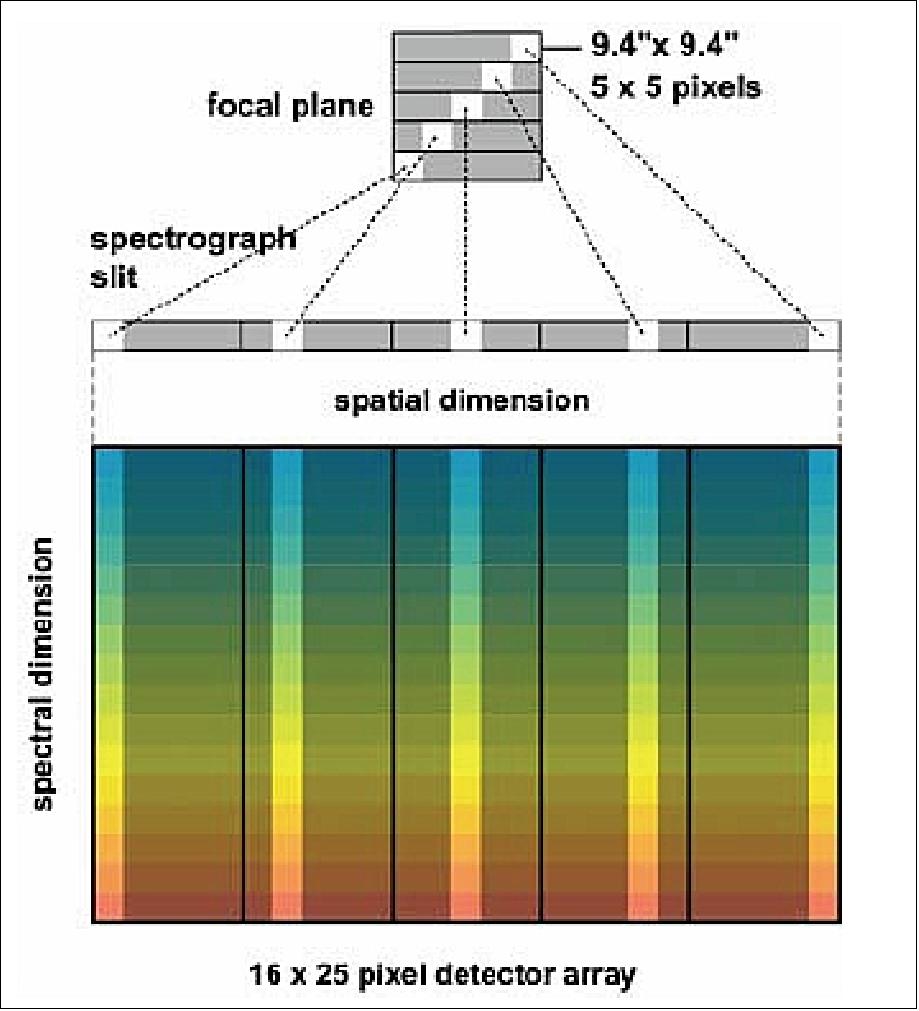
Grating order | Wavelength | FWHM of an unresolved line | Instantaneous spectral coverage (16 pixels) | Pixels per FWHM | ||
| (µm) | km/s | (µm) | km/s | (µm) |
|
3 | 55 | 114 | 0.021 | 1420 | 0.26 | 1.06 |
3 | 60 | 98 | 0.020 | 1400 | 0.28 | 1.06 |
3 | 72 | 55 | 0.013 | 580 | 0.14 | 1.38 |
2 | 75 | 156 | 0.039 | 1720 | 0.43 | 1.37 |
2 | 90 | 121 | 0.036 | 1220 | 0.236 | 1.53 |
1 | 105 | 318 | 0.111 | 3030 | 1.06 | 1.56 |
1 | 158 | 239 | 0.126 | 1650 | 0.87 | 2.16 |
1 | 175 | 212 | 0.124 | 1340 | 0.78 | 2.37 |
1 | 210 | 114 | 0.098 | 715 | 0.50 | 3.58 |
Photoconductor arrays: The 25 x 16 pixels Ge:Ga photoconductor arrays (Figure 103) are a completely modular design. 25 linear modules of 16 pixels each are stacked together to form a contiguous, 2-dimensional array. The light cones in front of the actual detector block provide for area-filling light collection in the focal plane. Each linear module of 16 detectors is read out by a cryogenic amplifier/multiplexer circuit [CRE (Cryogenic Readout Electronics)] in CMOS technology.
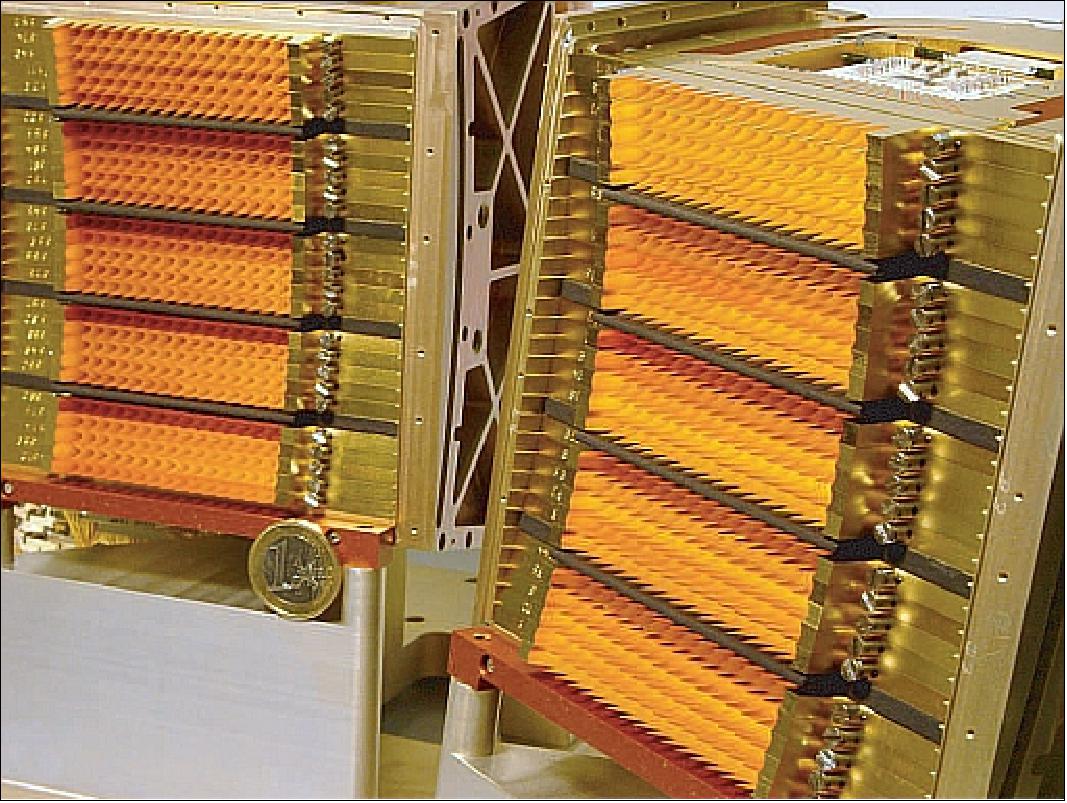
PACS Photometer AOTs
Three generic observing modes are offered with the AOT (Astronomical Observing Template) photometer:
• Point-source photometry: This mode is devoted to target a source which is completely isolated and point-like or smaller than one blue matrix. A typical use of this mode is for point-source photometry. It uses chopping and nodding, both with amplitude of 1 blue matrix, and dithering with a 1 pixel amplitude, keeping the source on the array at all times.
• "Small source" photometry: This mode is devoted to target sources that are smaller than the array size, yet larger than a single matrix. To be orientation independent, this means sources that fit in circle of 1.75 arcmin diameter. This mode uses also chopping and nodding, but this time the source cannot be kept on the array at all times.
• Large area or extended source mapping: This mode is necessary to map sources larger than the array size, or to cover large contiguous areas of the sky, e.g. extragalactic surveys. There are two ways to perform these kinds of observations:
- raster mapping with chopping
- scan mapping without chopping
In all photometer observing modes, dual-band imaging observations are performed, either in the blue (70 µm) and red (160 µm) bands or in the green (100 µm) and red (160 µm) bands, via the a selection button in the main AOT panel.
PACS Spectrometer AOTs
Two different observation schemes are offered with the PACS spectrometer: line and range spectroscopy.
• Line spectroscopy mode: A limited number of relatively narrow emission/absorption lines can be observed for either a single spectroscopic FOV (0.78' x 0.78') or for a larger map. Background subtraction is achieved either through standard chopping/nodding, for faint/compact sources, or through 'wavelength-switching' techniques for line measurement of the grating mechanism of bright extended sources.
• Range spectroscopy mode: This is a more flexible and extended version of the line spectroscopy mode, where a freely defined wavelength range is scanned by stepping through the relevant angles of the grating, synchronized with the chopper. Both arrays are used at a time.
The full wavelength ranges covered by the scan and the ranges covered to the highest sensitivity, i.e. the wavelength seen by all 16 spectral pixels are shown in Table 12 and compared with respective FWHM of the spectrometer at these wavelengths, for an unresolved line.
Diffraction order | Wavelength (µm) | Full range (km/s) | Full range (µm) | Highest sensitivity range (µm) | FWHM (µm) |
3 | 55 | 1880 | 0.345 | 0.095 | 0.021 |
3 | 72 | 799 | 0.192 | 0.053 | 0.013 |
2 | 72 | 2658 | 0.638 | 0.221 | 0.039 |
2 | 105 | 1039 | 0.364 | 0.126 | 0.028 |
1 | 105 | 5214 | 1.825 | 0.875 | 0.111 |
1 | 108 | 2869 | 1.511 | 0.724 | 0.126 |
1 | 175 | 2337 | 1.363 | 0.654 | 0.124 |
1 | 210 | 1314 | 0.92 | 0.441 | 0.098 |
PACS Calibration Framework
The calibration of the PACS observing modes is addressed centrally by the Observatory. About 5-7% of the observing time will be spent on calibrating the PACS instrument. The PACS Instrument Control Centre Team in collaboration with the Herschel Calibration Scientists will plan, work out, execute and analyze dedicated observations on celestial standards, according to the In-flight Calibration Plan, in order to consistently and thoroughly characterize all instrumental effects. They will generate the calibration files needed for the Standard Product generation, as indicated in the flow diagrams in chapter 7, as well as for more sophisticated Interactive Analysis steps.
SPIRE (Spectral and Photometric Imaging Receiver)
The SPIRE project represents a large international collaboration. The University of Wales, Cardiff (School of Physics and Astronomy), is the lead institute, with Matthew Griffin as the Principal Investigator (PI). The SPIRE instrument was built at Rutherford Appleton Laboratory (RAL), UK. The RAL Space Science and Technology Division provides the overall project management and system engineering for the SPIRE hardware and ICC (Instrument Control Center) teams. The Co-PI is Laurent Vigroux of IAP (Institut D'Astrophysique de Paris), France. The Consortium includes more than 150 scientists, engineers and managers from eight countries (Canada, China, France, Italy, Spain, Sweden, UK, USA). Major funding was provided from STFC (Science and Technology Facilities Council), UK; CNES, CEA and CNRS (France), NASA (USA), and other contributions such as those from ASI (Italy), CSA (Canada), Ministerio de Educación y Ciencia (Spain), Stockholm Observatory (Sweden), and the National Astronomical Observatories (China). 149) 150) 151) 152) 153) 154) 155) 156)
SPIRE is a three-band imaging photometer and an imaging FTS (Fourier Transform Spectrometer), which provides medium spectral resolution over a broad range. Both instruments use bolometer arrays operating at 0.3 K and are coupled to the telescope by hexagonally close-packed conical feedhorns. Three bolometer arrays are used for broadband photometry (λ/Δλ ~3) in spectral bands centered on approximately 250, 350 and 500 µm. The same 4 arcmin x 8 arcmin FOV is being observed simultaneously in these three bands through the use of two fixed dichroic beamsplitters. Signal modulation can be provided either by SPIRE's two-axis BSM (Beam Steering Mirror) or by scanning the telescope across the sky. An internal thermal source is available to provide a repeatable calibration signal for the detectors (and can also be seen by the FTS detectors).
The compact optical layout with dual input and output ports follows a Mach-Zehnder configuration using two high-efficiency intensity beamsplitters. The servo-controlled scanning mirror mechanism is based on a double-pendulum design. A mechanical displacement leads to a four-fold change in the optical path difference. A thermal calibration source is placed at the entrance of the second input port of the FTS to compensate for the emission from the warm telescope.
The FTS has spatially separated input and output ports. One input port views a 2.6 arcmin diameter FOV on the sky and the other is fed by an on-board reference source. Two detector arrays at the output ports cover overlapping bands of 194-324 µm and 316-672 µm. The FTS spectral resolution is set by the total optical path difference, and can be adjusted between 0.04 and 1 cm-1 (corresponding to λ/Δλ = 1000 - 40 at 250 µm).
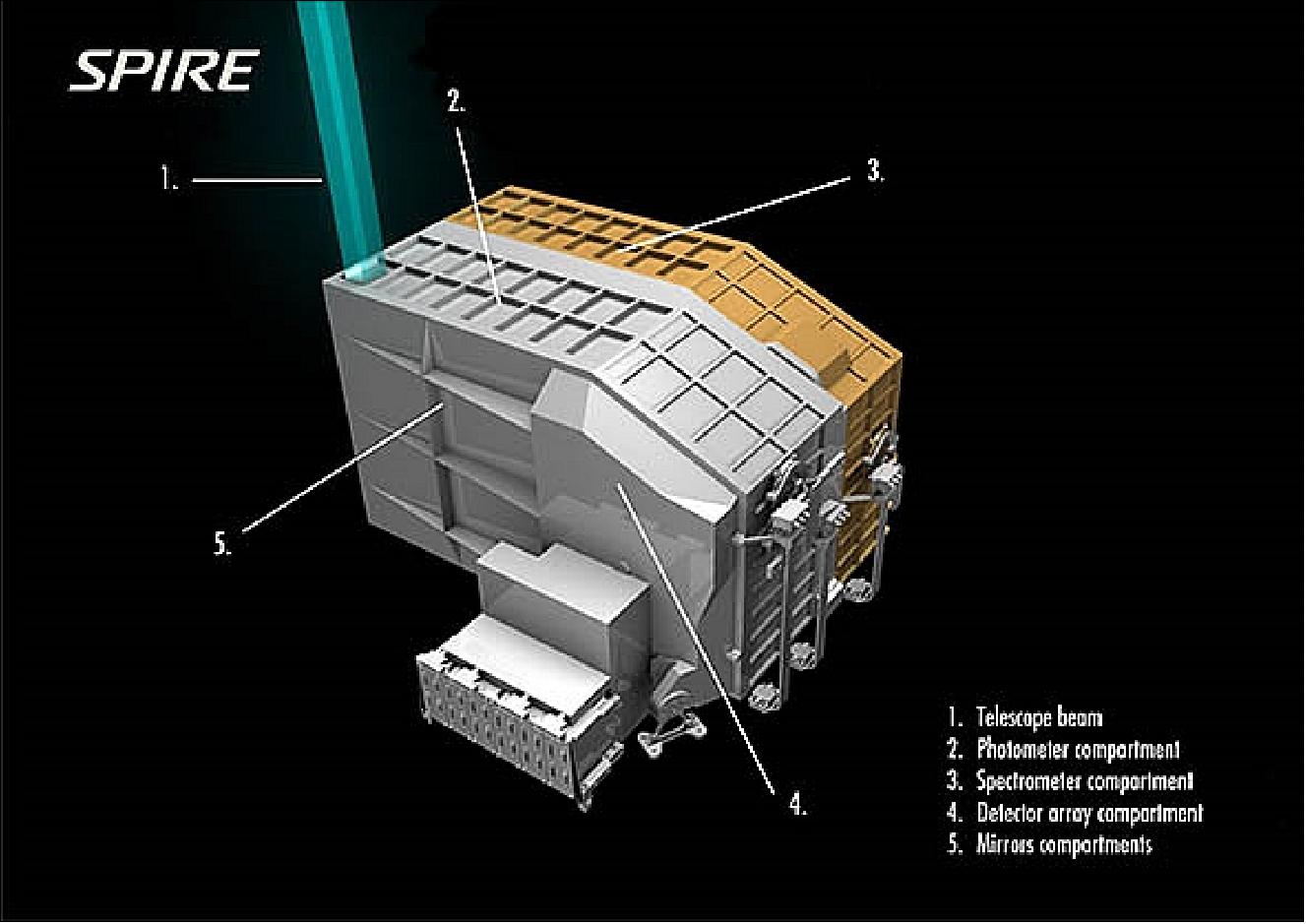
The photometer and spectrometer both have cold pupil stops conjugate with the Herschel secondary mirror, which is the system pupil for the telescope and defines a 3.29 m diameter used portion of the primary. Feedhorns provide a roughly Gaussian illumination of the pupil, with an edge taper of around 8 dB in the case of the photometer arrays.
The cold FPU (Focal Plane Unit) of SPIRE has a size of about 700 mm x 400 mm x 400 mm; it is supported from the 10 K cryostat optical bench by thermally insulating mounts. The inside is divided into two compartments, on either side of a central panel. One side contains common input optics and the photometer, and the other side contains the FTS..
The FPU has three temperature stages: the Herschel cryostat provides temperatures of 4.5 K and 1.7 K via high thermal conductance straps to the instrument, and an internal 3He refrigerator cools all five detector arrays to approximately 0.3 K. Two sets of JFET (Junction-gate Field Effect Transistor) preamplifiers are used to read out the bolometer signals, one for the photometer and one for the spectrometer. The JFET units are attached to the 10 K optical bench next to the 4.5 K enclosure, with the JFETs heated internally to their optimum operating temperature of ~120 K.
There are three SPIRE warm electronics units: the DCU (Detector Control Unit) provides the bias and signal conditioning for the arrays and cold electronics, and demodulates and digitizes the detector signals; the FCU (FPU Control Unit) controls the 3He cooler and the two FPU mechanisms, and reads out all the FPU thermometers; and the DPU (Digital Processing Unit) runs the on-board software and interfaces with the spacecraft for commanding and telemetry. The 130 kbit/s available data rate allows all photometer or spectrometer detectors to be sampled and the data transmitted to the ground with no on-board processing.
The relative position of the SPIRE focal plane with respect to the other two instruments, HIFI and PACS, is shown in Figure 105.
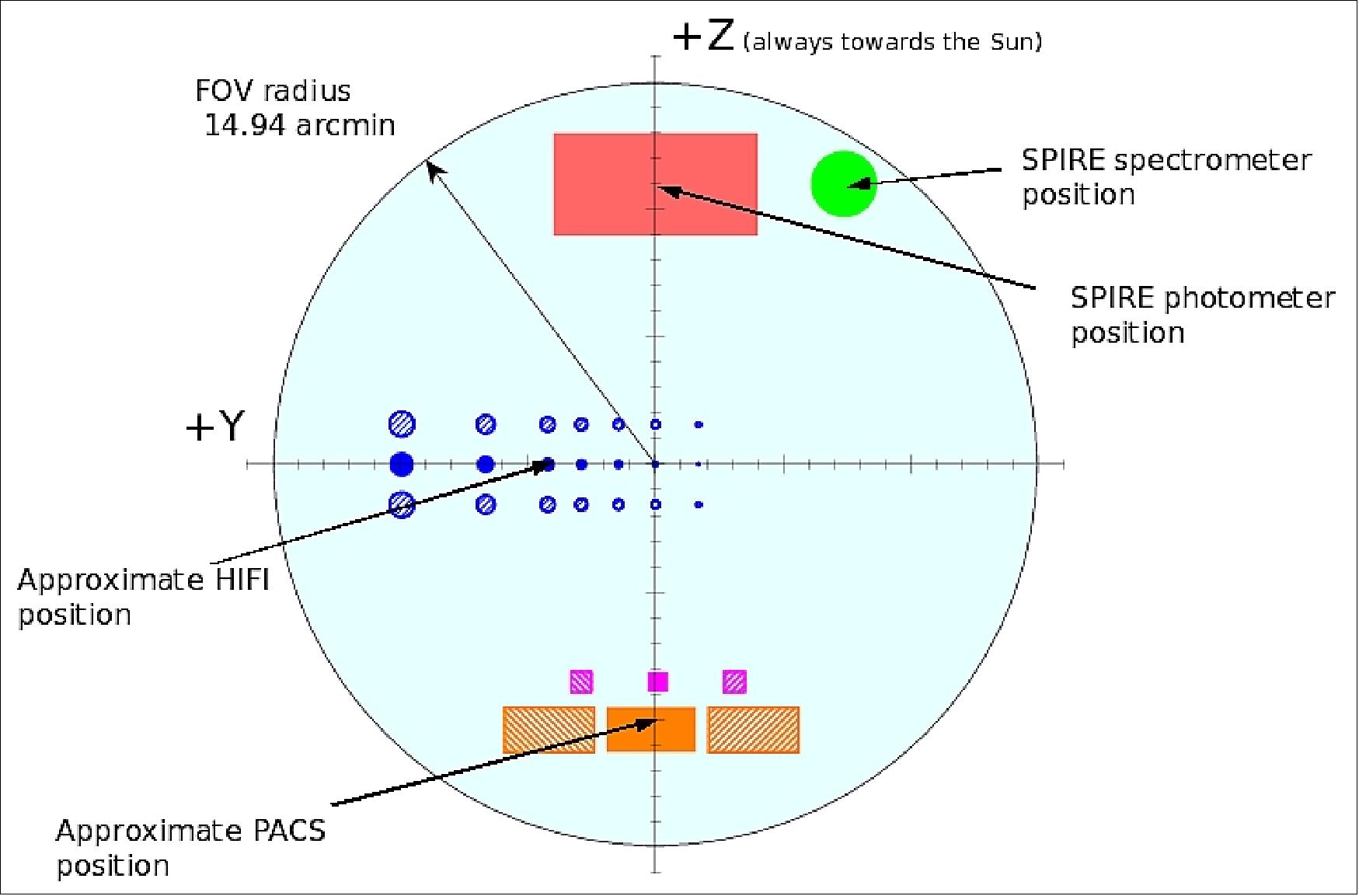
Legend to Figure 105: The center of the SPIRE photometer is offset by ~11 arcmin from the centre of the highly curved focal surface of the Herschel telescope, shown by the large shaded circle.
Parameter / Device | Photometer | Spectrometer | |||
Array | PSW (Photometer Short-Wave) | PMW (Photometer Medium-Wave) | PLW (Photometer Long-Wave) | SSW (Spectrometer Short-Wave) | SLW (Spectrometer Long-Wave) |
Band (µm) | 250 | 350 | 500 | 194-324 | 316-672 |
Resolution (λ/Δλ) | 3.3 | 3.4 | 2.5 | ~40-1000 @ 250 µm (variable) | |
Unvignetted FOV | 4 arcmin x 8 arcmin | 2.6 arcmin (diameter) * | |||
Beam FWHM size | 18 arcsec | 25 arcsec | 36 arcsec | 16 arcsec | 34 arcsec |
* The unapodized spectral resolution can be low (Δσ = 1 cm-1), medium (Δσ = 0.25 cm-1) or high (Δσ = 0.04 cm-1) | |||||
Photometer
The photometer is implemented as a three-band camera with a single FOV common to three detector arrays. The optical scheme brings the telescope focal plane first to an intermediate pupil, at which a Beam Steering Mirror is placed, and thence to an intermediate focal plane (at which the FTS field of view is picked off). This is in turn re-imaged by a one-to-one optical relay onto the detectors. The highly tilted and curved focal surface of the telescope is corrected by the optics so as to produce flat and undistorted focal planes at the arrays.
The layout of the common input optics and the photometer side of the instrument is shown in Figures 106 and 107. The optics are all-reflective except for the dichroics used to direct the three bands onto the bolometer arrays, and the filters used to define the passbands. The image is diffraction-limited over the 4 x 8 arcmin. field of view, which is offset by 11 arcmin. from the centre of the Herschel telescope's highly curved focal surface.
The input mirror M3 lies below the telescope focus, and receives the f/8.7 Herschel telescope beam and forms an image of the secondary at the flat beam steering mirror, M4. Mirror M5 converts the focal ratio to f/5 and provides an intermediate focus at M6. The three mirrors M7, M8 and M9 (inside the 1.7 K box) form an optical relay to bring the focal plane to the detector arrays. The beam is spectrally divided and directed onto the three arrays a by a combination of two fixed dichroics and flat folding mirrors (also inside the 1.7 K box). M3-M8 are at 4.5 K and all subsequent optical elements are at 1.7 K.
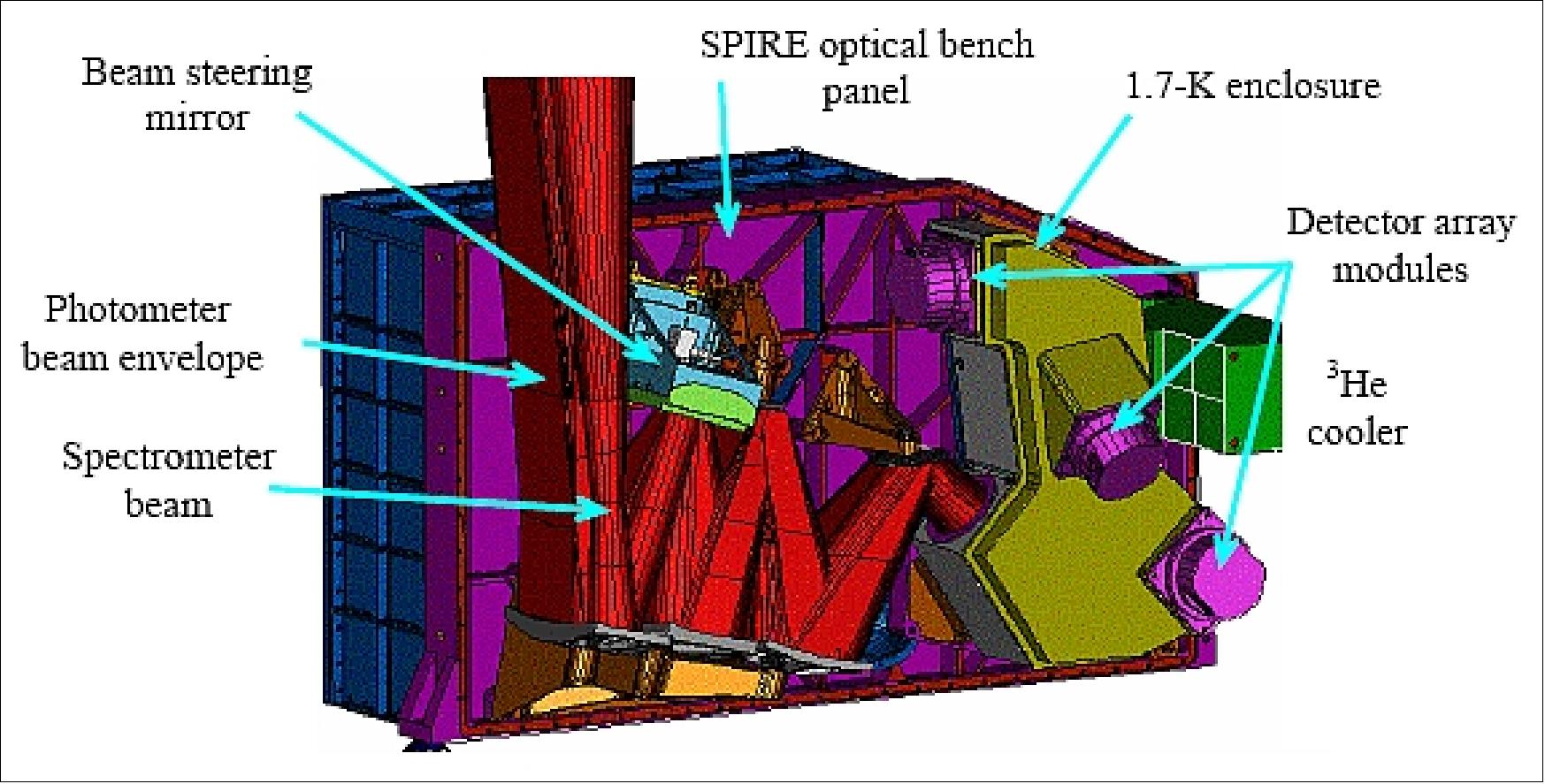
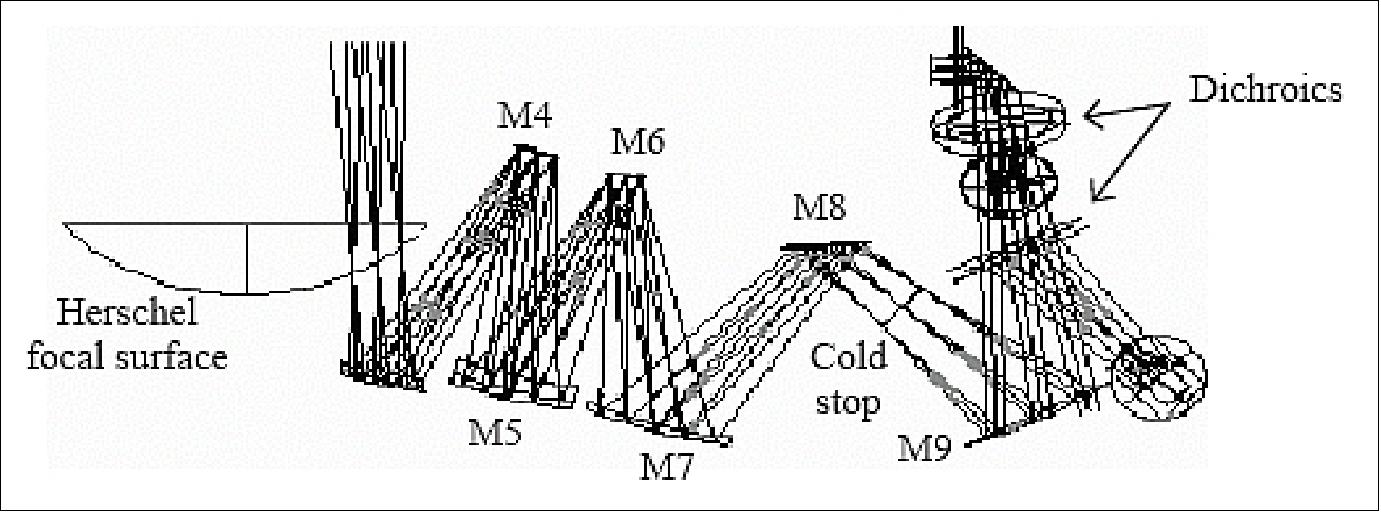
BSM (Beam Steering Mirror): The BSM (M4) is located in the optical path before any subdivision of the incident radiation into photometer and spectrometer optical chains, and is used both for photometer and FTS observations. For photometric observations of point sources, the BSM is used to make a small map around the nominal position to eliminate pointing or source position uncertainties. For small maps using the photometer (and also the FTS), it is used to create a fully sampled image. It can chop up to ±2 arcmin along the long axis of the 4 x 8 arcmin FOV. The nominal chop frequency for the photometer is 2 Hz. It can simultaneously chop at up to 1 Hz in the orthogonal direction by up to 30 arcsec. This two-axis motion allows "jiggling" of the pointing to create a fully sampled image of the sky.
Filters and passbands: The spectral passbands are defined by a sequence of metal mesh filters at various locations (the instrument input aperture, directly in front of the detector, and at intermediate locations in the optical train), the reflection/transmission edges of the dichroics, and the cutoff wavelengths of the feedhorn output waveguides. The three bands are centered at approximately 250, 350 and 500 µm, with λ/Δλ of 3.3, 3.4, and 2.5 respectively.
Bolometer arrays: The SPIRE detectors are spider-web bolometers using NTD (Neutron Transmutation Doped) germanium thermometers, which are coupled to the telescope by hexagonally close-packed 2Fl-diameter single-mode conical feedhorns, giving diffraction limited beams of FWHM 18, 25 and 36" for the 250, 360 and 520 µm bands respectively.
In contrast to HIFI's heterodyne technique, SPIRE will detect photons directly, by means of five arrays of bolometers. Bolometers can detect very small amounts of energy and convert them to electrical signals. They are currently the most sensitive direct detectors for radiation in the far-infrared to millimeter range. - SPIRE's bolometers are of a "spider web" design developed by JPL (James Bock). Each consists of a weblike mesh of silicon nitride, which absorbs light and conducts the energy to the tiny thermistor that sits at the center of the web. 157)
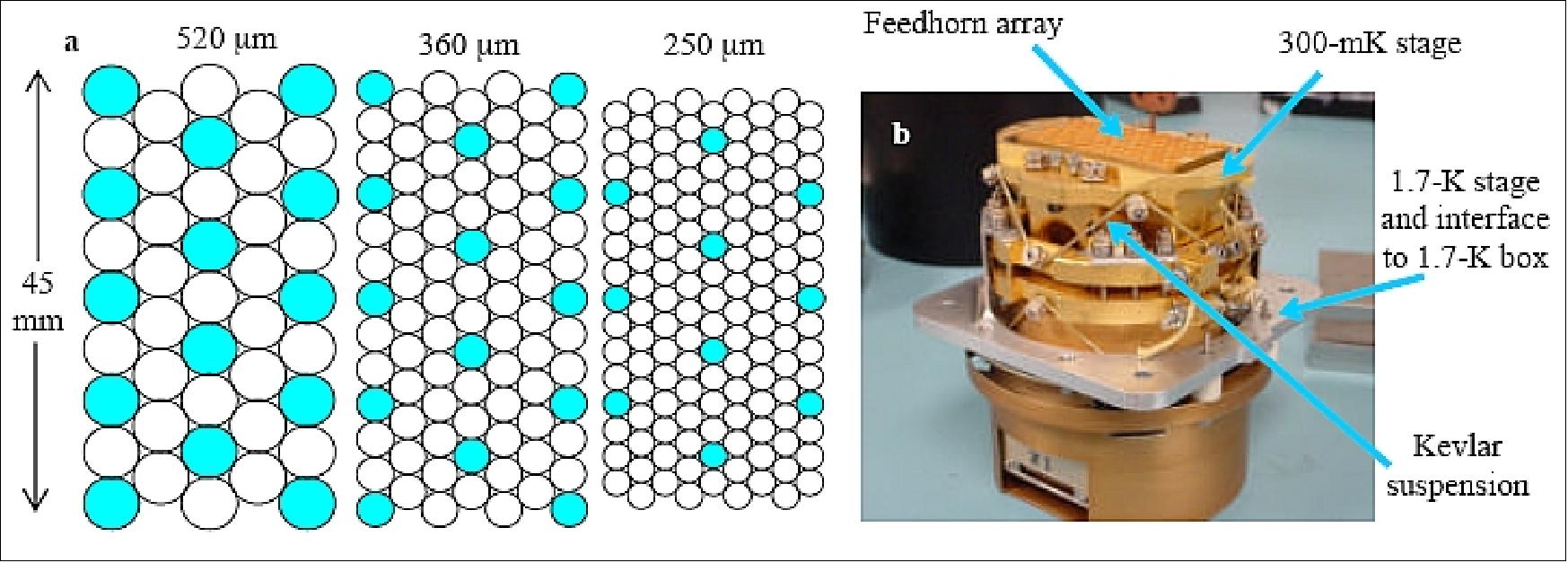
Photometer calibration source: An internal thermal source is used to provide a repeatable signal for the bolometers. It is not designed to provide an absolute calibration - that will be done by observing standard astronomical sources. It radiates through a 2.8 mm hole in the center of M4, occupying an area contained within the region of the pupil obscured by the hole in the primary. The source can produce a power at the detector of 1-2% of the telescope background. The latter is typically a few pW, so the signal level is a few x 10-14 W. With a detector NEP of a few x 10-17 W Hz-1/2, this gives a large instantaneous S/N. Mirror M4 is at a pupil, so the illumination is close to uniform over the arrays.
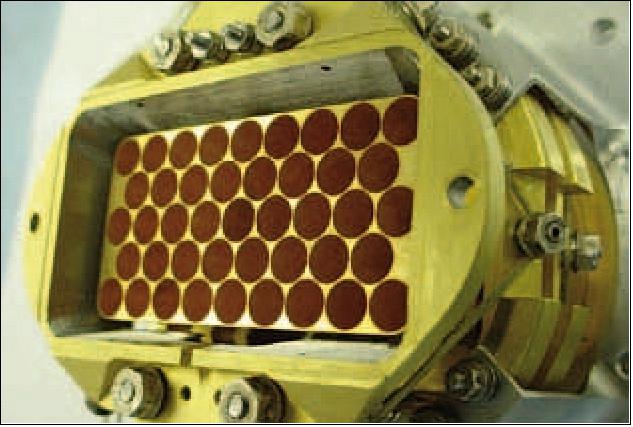
Spectrometer
The FTS uses two broadband intensity beam splitters in a Mach-Zehnder configuration. All four ports of the interferometer are independently accessible as in the Martin-Puplett (M-P) polarizing FTS. But the throughput is a factor of two higher than for the M-P as none of the incoming radiation is rejected, and there is no sensitivity to the polarization of the incident radiation. A thermal source at the second input port allows the background power from the telescope to be matched. The amplitude of the interferogram central maximum is proportional to the difference in the radiant power from the two ports, so this allows the large telescope background to be nulled, reducing the dynamic range requirements for the detector sampling. Detector arrays are placed in the two output ports, with overlapping bands of 200-325 µm and 315-670 µm. A single back-to-back scanning roof-top mirror serves both interferometer arms. It has a frictionless mechanism using double parallelogram linkage and flex pivots, and a Moiré fringe sensing system.
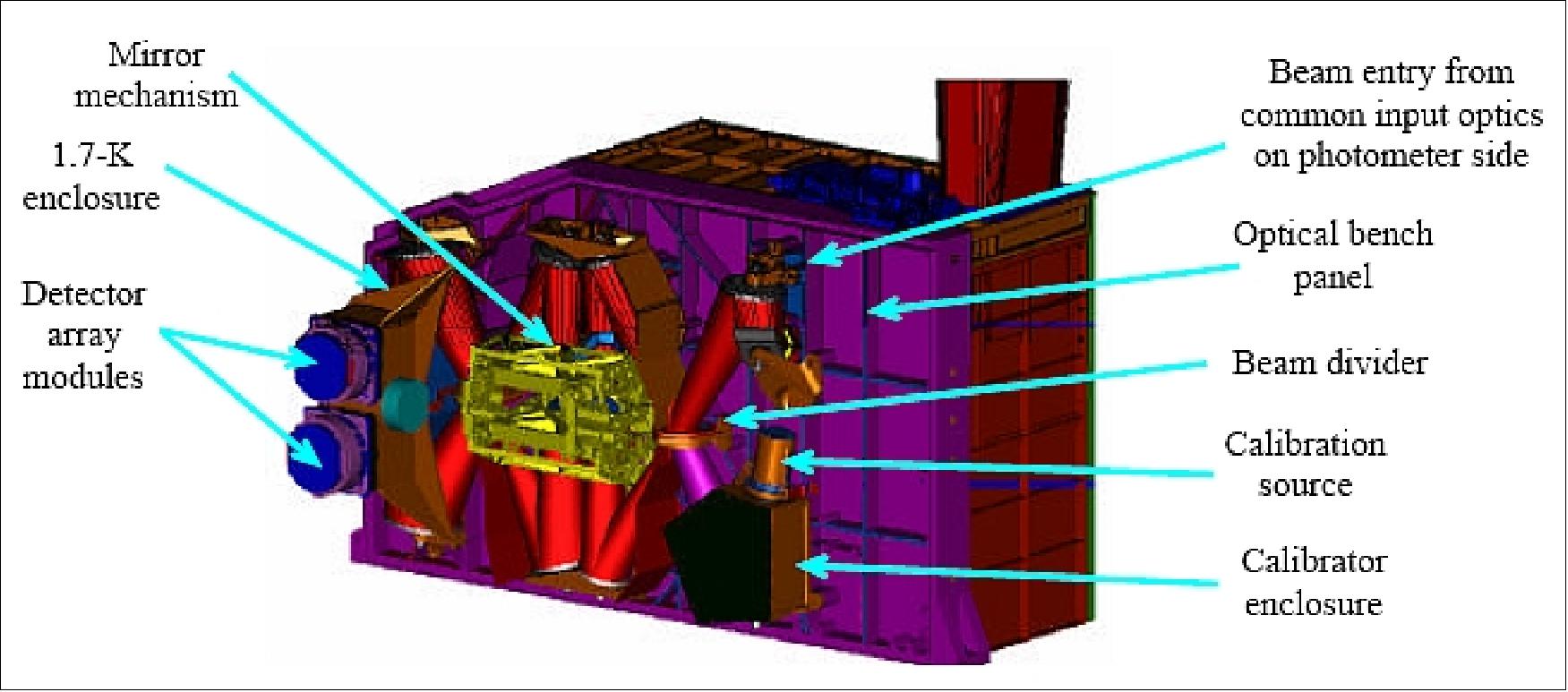
FTS optics: The focal plane layout of the FTS is shown in Figure 110 and the optical design is illustrated in Figure 111. The spectrometer beam enters through a hole in the panel into the FTS side of the instrument. A pupil stop is located between the pick-off mirror and the input fold mirror. The input relay mirror brings the beam to an intermediate focus just after the first beam divider, after which the beam is collimated and sent to the moving roof-top mirror. The roof-top shifts the beam and sends it towards the camera mirror, which produces an image just before the output beam divider. A pupil is located near the final fold mirror, making this a convenient location for the entrance to the 1.7 K enclosure. This pupil moves when the optical path difference changes, so it is not suitable for a limiting cold stop. Instead, the limiting aperture is located at the 4.5 K pupil between the pick-off mirror and the input fold mirror. The output relay mirror focuses the beam onto the detector arrays. Each array has a lens incorporated in its 0.3 K filter stack to correct for the non-telecentric FTS optics and provide more uniform fringe contrast and efficiency across the field.
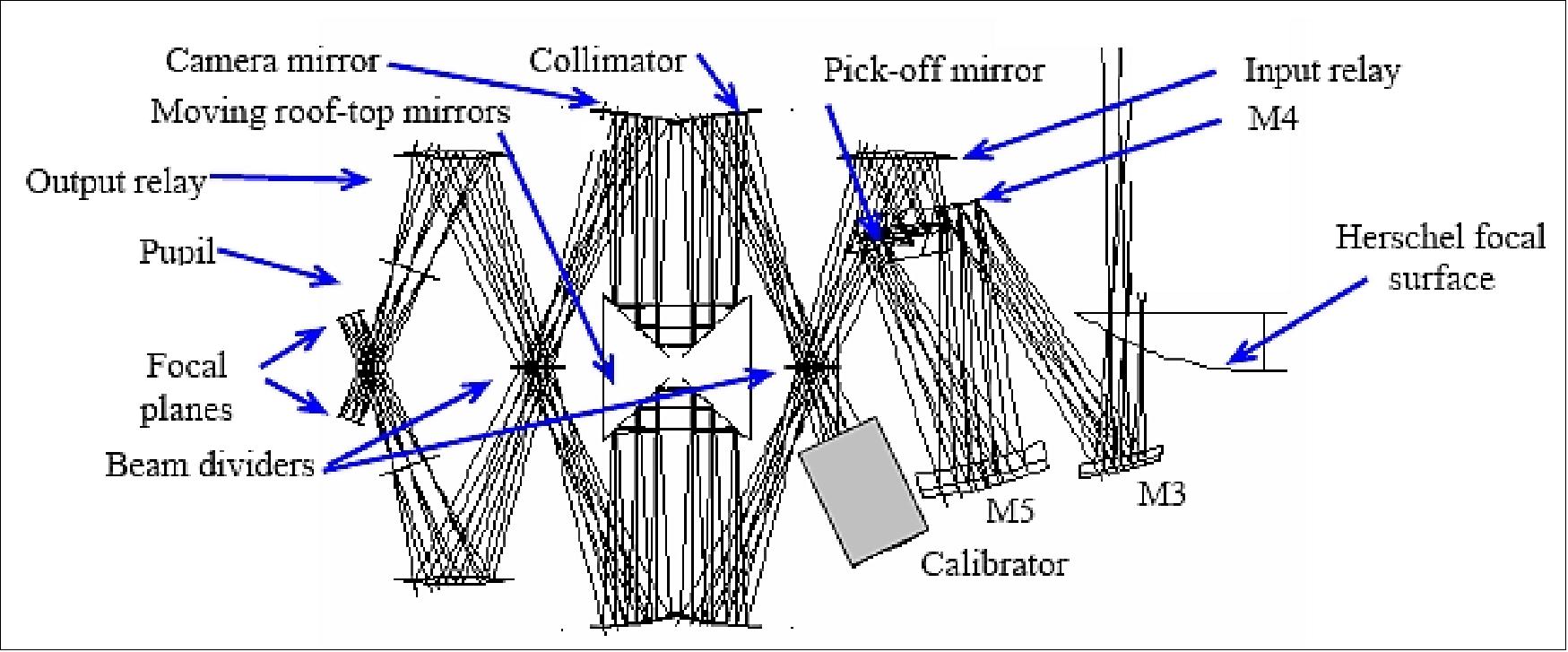
FTS detector arrays: The two spectrometer arrays contain 37 hexagonally closely-packed detectors in the shortwavelength array and 19 in the long-wavelength array. The array modules are similar to those used for the photometer, with an identical interface to the 1.7 K enclosure. The detectors on the periphery are partly vignetted by the 2.6 arcmin FOV admitted by the instrument optics (shown by the large circles in Figure ). The feedhorn and detector cavity designs are carefully optimized to provide good sensitivity across the whole wavelength range of the FTS.

3He cooler and 300 mK Thermal Strap System
The same 3He cooler design is being used for both the SPIRE and PACS instruments. Gas gap heat switches control the cooler and there are no moving parts. Liquid confinement in zero g is achieved by a porous material which holds the liquid by capillary attraction. A Kevlar wire suspension supports the cooler during launch, whilst minimizing the parasitic heat load.
The cooler contains 6 STP (Standard Temperature Pressure) liter of 3He, fits in a 200 mm x 100 mm x 100 mm envelope and has a mass of about 1.7 kg. Operating from 1.7 K, it achieves a temperature of 274 mK with a 10 mW load and a 46 hr hold time, and a total time-averaged power load on the 1.7 K heat sink of ~ 3 mW. Copper straps connect the 0.3 K stage to the five detector arrays, and are held rigidly at various points by Kevlar support modules. The supports at the entries to the 1.7 K boxes are also designed to be light-tight. The cooler will be recycled during periods when the Herschel telemetry antenna is pointed towards Earth for data downlink and command uplink. In these DTCPs (Daily Telecommunications Periods) of ~ 3 hours, operation of the science instruments is not planned due to possible interference from the transponder operation and the highly restricted pointing.
Ground Segment
The operations of the HSO (Herschel Space Observatory) are conducted in a decentralized manner. The ground segment comprises the following elements: 158)
• HSC (Herschel Science Center), provided by ESA, located at ESAC (ESA/European Space Astronomy Centre) in Villafranca near Madrid, Spain. The HSC is the prime interface between Herschel and the science community. - The HSC, supported by the NHSC (NASA Herschel Science Center) and located at IPAC (Infrared Processing and Analysis Center) in California, acts as the point of interface to the science community and the outside world in general (primarily to the US-based users). The HSC is supported by the Herschel Science Team, for the maximization of the scientific return of the mission, and by the Herschel Observing Time Allocation Committee (HOTAC) for the selection of observing proposals. 159) 160)
• Three dedicated ICCs (Instrument Control Centers), one for each instrument, provided by the respective PI institution. Each ICC is responsible for enabling the operation and for the calibration of its instrument.
• MOC (Mission Operations Center), provided by ESA, located at ESOC, Darmstadt, which is responsible for the execution of all in-orbit operations.
- Mission Control based on SCOS-2000 (Satellite Control and Operation System 2000 - the generic mission control system software of ESA) including the NCTRS (Network Controller and Telemetry Router System).
- Simulator based on SIMSAT (Simulation Infrastructure for the Modeling of SATellites)
- Flight Dynamics based on ORATOS (Orbit and Attitude Operations. System) infrastructure
- Ground Stations based on TMTCS (Telemetry and Telecommand System).
These applications require communication services within the MOC and remote locations:
- Spacecraft Integration sites (Cannes (France), Torino (Italy), ESTEC (European Space Research and Technology Centre) at Noordwijk (Netherlands), CSL (Centre Spatial de Liège), Belgium.
- ESA Ground Stations CSG (Guiana Space Centre) at Kourou (French Guyana), New Norcia and Perth (Australia), Cebreros (Spain), Maspalomas (Gran Canaria)
- ICCs (Instrument Control & Science Centers): PACS ICC, HIFI ICC, SPIRE ICC, HSC, Planck: PSO, HFI DPC, LFI DPC.
Herschel and Planck are the first ESA missions launched using novel computer solutions based on Linux operating systems and hosted in the modernized ESOC data centers.
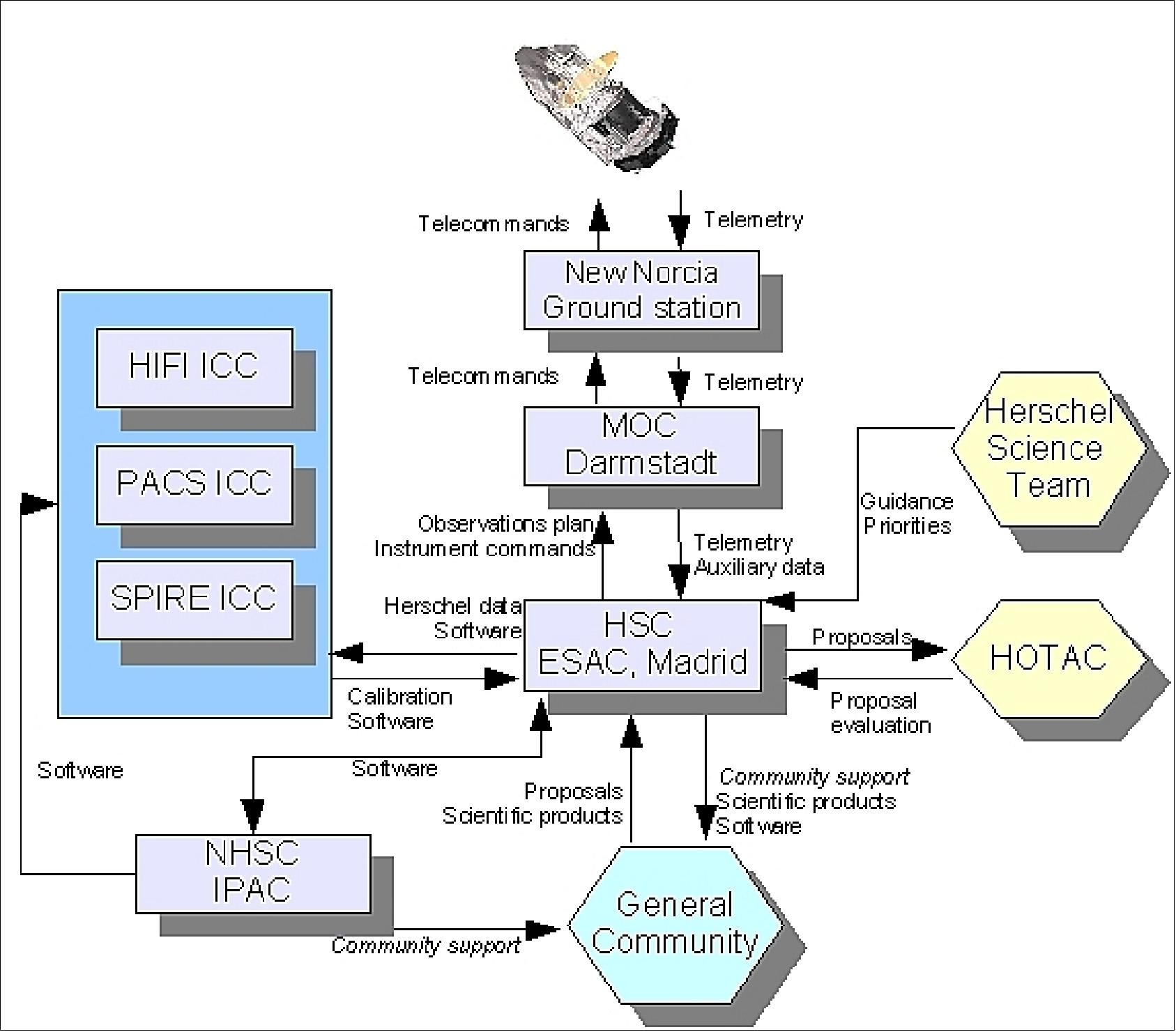
MOC (Mission Control Center):
SCOS 2000 is the generic mission control system built by ESA following the CCSDS telemetry and telecommand packet standards and PUS (Packet Utilization Standard) and used by the agency to support its missions.
The MOC architecture follows the client/server logic, as a distributed system running across a network of workstations grouped in several independent chains (3 for each spacecraft in the case of Herschel and Planck), each chain composed by a main server and several clients attached to it and with only one chain being allowed to have the operational control at a given time. This control can be transferred from one chain to the other wither explicitly or as a result of a fail-over. 161)
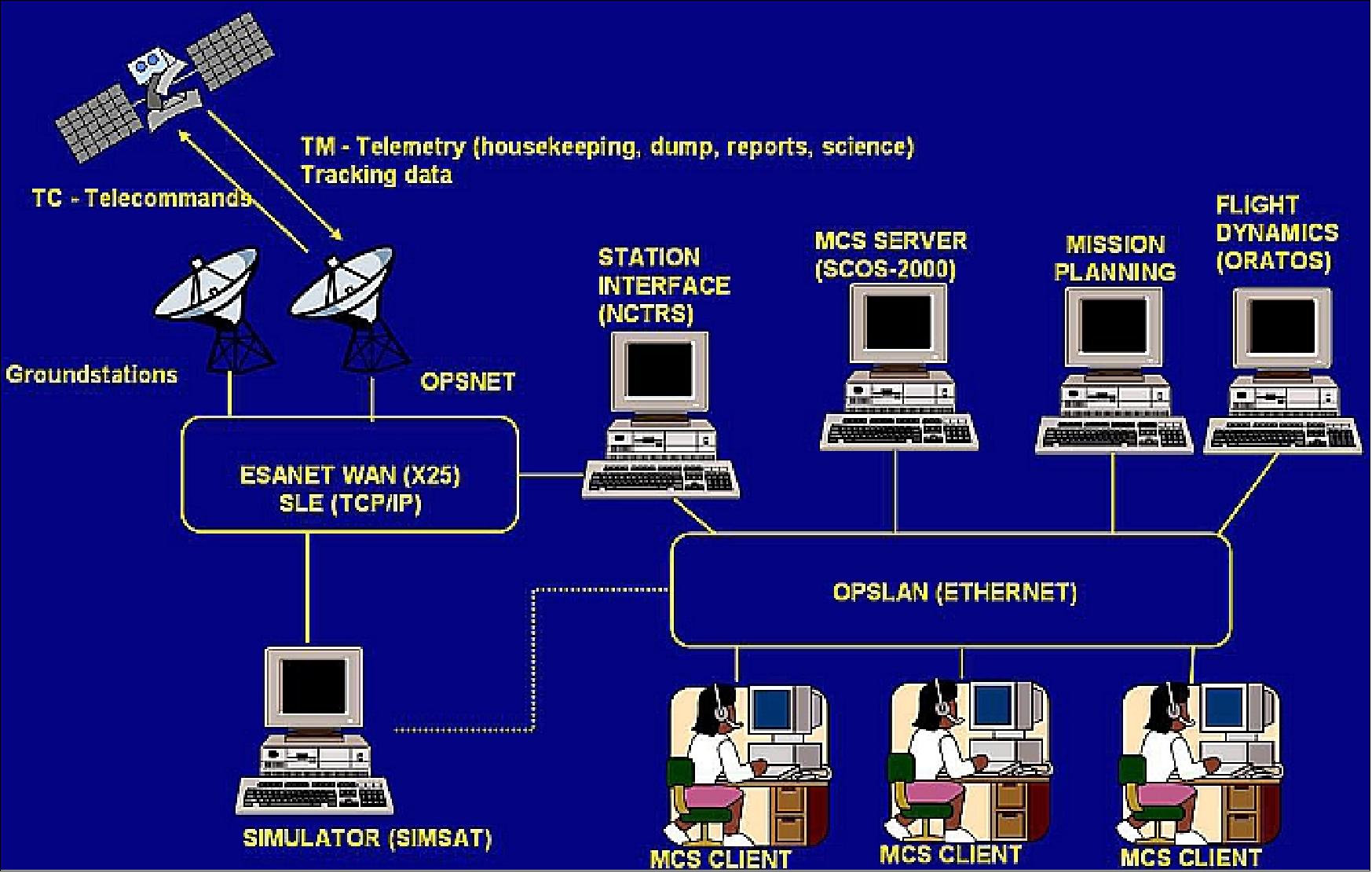
References
1) http://www.esa.int/esaMI/Herschel/SEM8600P4HD_0.html2) http://esamultimedia.esa.int/docs/herschel/Herschel-Factsheet.pdf
3) Göran L. Pilbratt, “Herschel Mission Overview and Key Programs,” SPIE Astronomical Instrumentation 2008, Space Telescopes and Instrumentation I: Optical, Infrared, and MillimeterWave, Marseille, France, June 23-28, 2008, SPIE Vol. 7010, URL of presentation: http://herschel.esac.esa.int/Publ/2008/SPIE2008_Herschel_talk.pdf , URL of paper: http://herschel.esac.esa.int/Publ/2008/SPIE2008_Herschel_paper.pdf
4) M. Talevi, G. Pilbratt, T. Passvogel, K. Fletcher, A. Mehta, “Herschel – Unveiling hidden details of star and galaxy formation and evolution,” Herschel brochure, 2009, ESA, BR-262, URL: http://herschel.esac.esa.int/Publ/2009/BR-262_Herschel_brochure_v42.pdf
5) Göran Pilbratt, Thomas Passvogel, Monica Talevi, “Continuing the Infrared Revolution - The science behind ESA's Herschel observatory,” ESA Bulletin 138, May 2009, pp. 12-18,
6) “Herschel brochure,” BR-262, ESA, URL: http://esamultimedia.esa.int/docs/herschel/HERSCHEL262-LOW-complete.pdf
7) Jean-Michel Reix, Thomas Passvogel, Garry Crone, Bernard Collaudin, Pascal. Rideau, Yvan Roche, “The Herschel / Planck Programme Technical Challenges for two Science Missions Ready for Launch,” Proceedings of the 59th IAC (International Astronautical Congress), Glasgow, Scotland, UK, Sept. 29 to Oct. 3, 2008, IAC-08-A.3.4
8) http://www.esa.int/esaSC/120390_index_0_m.html
9) “The Observatory,” URL: http://herschel.esac.esa.int/Docs/Herschel/html/ch01.html
10) J.-M. Reix, T. Passvogel, G. Crone, B. Collaudin, P. Rideau, Y. Roche, C. Vogel, “The Herschel/Planck programme, technical challenges for two science missions, successfully launched,” Acta Astronautica, Vol. 66, 2010, pp.130-148
11) Micha Schmidt, Dave Salt, “Herschel Pointing Accuracy Improvement,” Proceedings of SpaceOps 2012, The 12th International Conference on Space Operations, Stockholm, Sweden, June 11-15, 2012, URL: http://www.spaceops2012.org/proceedings/documents/id1275622-Paper-001.pdf
12) Miguel Sanchez, “Herschel pointing performance (current and past),” May 3, 2012, URL: http://herschel.esac.esa.int/twiki/bin/view/Public/SummaryPointing
13) M. Mascarello, M. Ariagno, O. Fratacci, S. Thürey, “Herschel & Planck TT&C Subsystem: An Efficient End-to-end 'Full X Band' TTC Architecture for TTC and Data Transmission,” 4th ESA International Workshop on Tracking, Telemetry and Command Systems for Space Applications, Sept. 11-14, 2007, ESA/ESOC, Darmstadt, Germany
14) ESOC brochure, “Europe's Access to Deep Space - The Deep Space Ground Station in Australia,” URL: http://esamultimedia.esa.int/multimedia/esoc/esoc_newnorcia_brochure.pdf
15) M. Dugast, P. Droll, L. Foiadelli, G. Billig, M. Lugert, “ESA’s X-Band LEOP experience in dual spacecraft scenario,” Proceedings of the SpaceOps 2010 Conference, Huntsville, ALA, USA, April 25-30, 2010, paper: AIAA 2010-1912
16) Göran L. Pilbratt, “Herschel Open Time Key Program Workshop,” ESA7ESTEC, Noordwijk, The Netherlands, Feb. 20-21, 2007, URL: http://herschel.esac.esa.int/OT_KP_wkshop/11_Herschel_GLP.pdf
17) Emmanuel Sein, Yves Toulemont, Frederic Safa, Michel Duran, Pierre Deny, Daniel de Chambure, Thomas Passvogel, Goeran L. Pilbratt, “A 3.5 m diameter SiC telescope for Herschel Mission,” Proceedings of the SPIE, 'IR Space Telescopes and Instruments,” Edited by John C. Mather, Volume 4850, 2003, pp. 606-618, URL: http://herschel.esac.esa.int/Publ/2002/telescope_spie02.pdf
18) J. Breysse, D. Castel, B. Laviron, D. Logut, M. Bougoin, “All-SiC telescope technology: recent progress and achievements,” Proceedings of the 5th International Conference on Space Optics (ICSO 2004), March 30, - April 2, 2004, Toulouse, France
19) Brian Catanzaro, Dominic Doyle, “Herschel Space Telescope: Optical Test and Model Correlation,” Proceedings of the 2009 IEEE Aerospace Conference, Big Sky, MT, USA, March 7-14, 2009
20) ”Herschel in the cleanroom,” ESA, 13 May 2009, URL: http://m.esa.int/var/esa/storage/images/esa_multimedia/images/2009/05/herschel2/10105771-2-eng-GB/Herschel_article_mob.jpg
21) http://www.esa.int/esaMI/Herschel/SEMZETEH1TF_0.html
22) ”New Images Using Data From Retired Telescopes Reveal Hidden Features,” NASA/JPL News, 16 June 2022, URL: https://www.jpl.nasa.gov/news/new-images-using-data-from-retired-telescopes-reveal-hidden-features?utm_source=iContact&utm_medium=email&utm_campaign=nasajpl&utm_content=daily20220616-1
23) ”Herschel and Planck views of star formation,” ESA Science & Exploration, 5 July 2020, URL: https://www.esa.int/Science_Exploration/Space_Science/Herschel_and_Planck_views_of_star_formation
24) Juan D. Soler, ”Using Herschel and Planck observations to delineate the role of magnetic fields in molecular cloud structure,” Astronomy & Astrophysics, Volume 629, Published online: 12 September 2019, https://doi.org/10.1051/0004-6361/201935779
25) ”Looking back in time with Herschel and Planck,” ESA Science & Exploration, 28 May 2020, URL: http://www.esa.int/ESA_Multimedia/Images/2020/05/Looking_back_in_time_with_Herschel_and_Planck
26) ”Orion A in infrared,” ESA Science & Exploration, 18 November 2019, URL: http://www.esa.int/ESA_Multimedia/Images/2019/11/Orion_A_in_infrared
27) ”Space sparkle,” ESA, Space Science Image of the Week: The glowing remnants of stellar fireworks, 7 January 2019, URL: http://m.esa.int/spaceinimages/Images/2019/01/Multi-wavelength_view_of_a_supernova_remnant
28) ”Herschel’s view of the Galactic Center,” ESA, Space Science Image of the Week, 24 September 2018, URL: http://m.esa.int/spaceinimages/Images/2018/09/Herschel_s_view_of_the_Galactic_Centre
29) ”Galaxies galore — Every point is a galaxy,” ESA Space Science Image of the Week, 16 July 2018, URL: http://m.esa.int/spaceinimages/Images/2018/07/Every_point_is_a_galaxy
30) ”Hidden secrets of a massive star-formation region,” ESA, 21 May 2018, URL: http://m.esa.int/spaceinimages/Images/2018/05/Hidden_secrets_of_a_massive_star-formation_region
31) ”A space ant fires its lasers,” ESA, 16 May 2018, URL: http://m.esa.int/Our_Activities/Space_Science/Herschel/A_space_ant_fires_its_lasers
32) ”Stellar evolution,” ESA, 05 March 2018, URL: http://m.esa.int/spaceinimages/Images/2018/03/Stellar_evolution
33) ”Star-forming filaments,” ESA Space Science Image of the Week, 26 March 2018, URL: http://m.esa.int/spaceinimages/Images/2018/03/Chaotic_web_of_filaments_in_a_Milky_Way_stellar_nursery
34) ”Herschel data links mysterious quasar winds to furious starbursts,” ESA, 7 Dec. 2017, URL: http://sci.esa.int/herschel/59840-herschel-data-links-mysterious-quasar-winds-to-furious-starbursts/
35) Peter Barthel, Pece Podigachoski, Belinda Wilkes, Martin Haas, ”Starburst-driven Superwinds in Quasar Host Galaxies,” The Astrophysical Journal Letters, Volume 843, Number 1, Published 2017 June 30, © 2017, The American Astronomical Society, doi: 10.3847/2041-8213/aa7631
36) ”Star formation in the Chamaeleon,” ESA,Space Science Image of the Week, 27 Nov. 2017, URL: http://m.esa.int/spaceinimages/Images/2017/11/Star_formation_in_the_Chamaeleon
37) ”Herschel discovers galaxy merger in the very early Universe,” ESA, 13 Nov. 2017, URL: http://m.esa.int/Our_Activities/Space_Science/Herschel/Herschel_discovers_galaxy_merger_in_the_very_early_Universe
38) Dominik A. Riechers, T. K. Daisy Leung, Rob J. Ivison, Ismael Pérez-Fournon, Alexander J. R. Lewis, Rui Marques-Chaves, Iván Oteo, Dave L. Clements, Asantha Cooray, Josh Greenslade, Paloma Martínez-Navajas, Seb Oliver, Dimitra Rigopoulou, Douglas Scott, Axel Weiss, ”Rise of the Titans: A Dusty, Hyper-luminous "870 µm Riser" Galaxy at z ~ 6,” The Astrophysical Journal, Volume 850, Number 1, Published 2017 November 13, 2017. The American Astronomical Society
39) ”The Horse and the Dragon,” ESA, 10 Nov. 2017, URL: http://m.esa.int/spaceinimages/Images/2017/11/The_Horse_and_the_Dragon
40) Göran Pilbratt, Philip Appleton,”Herschel's chronicles of galaxy evolution,” ESA, 20 Sept. 2017, URL: http://sci.esa.int/herschel/59495-herschel-s-chronicles-of-galaxy-evolution/
41) ”Herschel's view of the W3/W4/W5 complex,” ESA, 18 Sept. 2017, URL: http://sci.esa.int/herschel/59538-herschel-s-view-of-the-w3w4w5-complex/
42) ”Celebrating Herschel's legacy,” ESA, 18 Sept. 2017, URL: http://m.esa.int/spaceinimages/Images/2017/09/Celebrating_Herschel_s_legacy
43) ”How Herschel unlocked the secrets of star formation,” ESA, 18 Sept.2017, URL: http://sci.esa.int/herschel/59493-how-herschel-unlocked-the-secrets-of-star-formation/
44) ”Intense star formation in the Westerhout 43 region,” ESA, 31 July 2017, URL: http://m.esa.int/spaceinimages/Images/2017/07/Intense_star_formation_in_the_Westerhout_43_region
45) ”Star formation on filaments in RCW106,” ESA, Feb. 20, 2017, URL: http://m.esa.int/spaceinimages/Images/2017/02/Star_formation_on_filaments_in_RCW106
46) ”Interstellar filaments in Polaris,” ESA, Jan. 3, 2017, URL: http://m.esa.int/spaceinimages/Images/2017/01/Interstellar_filaments_in_Polaris
47) ”The Little Fox and the Giant Stars,” ESA, space science image of the week, May 23, 2016, URL: http://www.esa.int/spaceinimages/Images/2016/05/The_Little_Fox_and_the_Giant_Stars
48) ”New Herschel maps and catalogues reveal stellar nurseries across the Galactic Plane,” ESA, Mission News as of April 22, 2016, URL: http://sci.esa.int/herschel/57755-new-herschel-maps-and-catalogues-reveal-stellar-nurseries-across-the-galactic-plane/
49) S. Molinari, E. Schisano, D. Elia, M. Pestalozzi, A. Traficante, S. Pezzuto, B. M. Swinyard, A. Noriega-Crespo, J. Bally, T. J. T. Moore, R. Plume, A. Zavagno, A. M. di Giorgio, S. J. Liu, G. L. Pilbratt, J. C. Mottram, D. Russeil, L. Piazzo, M. Veneziani, M. Benedettini, L. Calzoletti, F. Faustini, P. Natoli, F. Piacentini, M. Merello, A. Palmese, R. Del Grande, D. Polychroni, K. L. J. Rygl, G. Polenta, M. J. Barlow, J.-P. Bernard, P. G. Martin, L. Testi, B. Ali, P. André, M.T. Beltrán, N. Billot, S. Carey, R. Cesaroni, M. Compiègne, D. Eden, Y. Fukui, P. Garcia-Lario, M. G. Hoare, M. Huang, G. Joncas, T. L. Lim, S. D. Lord, S. Martinavarro-Armengol, F. Motte, R. Paladini, D. Paradis, N. Peretto, T. Robitaille, P. Schilke, N. Schneider, B. Schulz, B. Sibthorpe, F. Strafella, M. A. Thompson, G. Umana, D. Ward-Thompson, F. Wyrowski, ”Hi-GAL, the Herschel infrared Galactic Plane Survey: photometric maps and compact source catalogues. First data release for Inner Milky Way: +68º > l >-70º,” Astronomy & Astrophysics, April 20, 2016, DOI: http://dx.doi.org/10.1051/0004-6361/201526380, URL: http://www.aanda.org/articles/aa/pdf/forth/aa26380-15.pdf
50) ”Herschel reveals a ribbon of future stars,” ESA, Space science image of the week, March 29, 2016, URL: http://www.esa.int/spaceinimages/Images/2016/03/Herschel_reveals_a_ribbon_of_future_stars
51) ”Herschel reveals filaments in the Serpens Core,” ESA, Jan. 18, 2016, URL: http://www.esa.int/spaceinimages/Images/2016/01/Herschel_reveals_filaments_in_the_Serpens_Core
52) ”Sparkling Stephan’s Quintet,” ESA Space Science Image of the Week, Dec. 21, 2015, URL: http://www.esa.int/spaceinimages/Images/2015/12/Sparkling_Stephan_s_Quintet
53) “Feathery filaments in Mon R2,” ESA Space Science Image of the Week, August 24, 2015, URL: http://www.esa.int/spaceinimages/Images/2015/08/Feathery_filaments_in_Mon_R2
54) “Herschel's hunt for filaments in the Milky Way,” ESA, May 28, 2015, URL: http://sci.esa.int/herschel/55942-herschels-hunt-for-filaments-in-the-milky-way/
55) “Herschel's view of the filament G49,” ESA, May 28, 2015, URL: http://sci.esa.int/herschel/55948-herschels-view-of-the-filament-g49/
56) “Black hole winds pull the plug on star formation,” ESA, March 25, 2015: URL: http://www.esa.int/Our_Activities/Space_Science/Herschel/Black_hole_winds_pull_the_plug_on_star_formation
57) F. Tombesi, M. Meléndez, S. Veilleux, J. N. Reeves, E. González-Alfonso, C. S. Reynolds, “Wind from the black-hole accretion disk driving a molecular outflow in an active galaxy,” Nature, Vol. 519, pp: 436–438, 26 March 2015, doi:10.1038/nature14261
58) “Exploring the colors of the Small Magellanic Cloud,” ESA, Feb. 23, 2015, URL: http://www.esa.int/spaceinimages/Images/2015/02/Exploring_the_colours_of_the_Small_Magellanic_Cloud
59) “A Dwarf Galaxy's Star Bar and Dusty Wing,” >NASA, January 12, 2012, URL: http://www.nasa.gov/mission_pages/herschel/multimedia/pia15255.html
60) “Herschel's view of the early Universe reveals galaxy cluster fireworks,” ESA, Dec. 18, 2014, URL: http://sci.esa.int/herschel/55150-herschel-view-of-the-early-universe-reveals-galaxy-cluster-fireworks/
61) J. S. Santos, B. Altieri, I. Valtchanov, A. Nastasi, H. Böhringer, G. Cresci, D. Elbaz, R. Fassbender, P. Rosati, P. Tozzi, M. Verdugo, “The reversal of the SF (Star Formation)–density relation in a massive, X-ray-selected galaxy cluster at z = 1.58: results from Herschel,” Monthly Notices Letters of the Royal Astronomical Society, Vol. 447, Issue 1, pp: 165-169, Dec. 13, 2014
62) “Nearby M33 galaxy blossoming with star birth,” ESA, July 28, 2014, URL: http://www.esa.int/spaceinimages/Images/2014/07/Nearby_M33_galaxy_blossoming_with_star_birth
63) “Young sun's violent history solves meteorite mystery,” ESA, July 1, 2014, URL: http://sci.esa.int/herschel/54252-young-suns-violent-history-solves-meteorite-mystery/
64) C. Ceccarelli, C. Dominik, A. López-Sepulcre, M. Kama, M. Padovani, E. Caux, P. Caselli, “Herschel Finds Evidence for Stellar Wind Particles in a Protostellar Envelope: Is This What Happened to the Young Sun?,” The Astrophysical Journal Letters, Volume 790, Number 1, July 1, 2014
65) Markus Bauer, Isabel Aleman, Mireya Etxaluze, Göran Pilbratt, “New molecules around old stars,” ESA, June 17, 2014, URL: http://sci.esa.int/herschel/54158-new-molecules-around-old-stars/
66) I. Aleman, T. Ueta, D. Ladjal, K. M. Exter, J. H. Kastner, R. Montez, A. G. G. M. Tielens, Y. H. Chu, H. Izumiura, I. McDonald, R. Sahai, N. Siodmiak, R. Szczerba, P. A. M. van Hoof, E. Villaver, W. Vlemmings, M. Wittkowski, A. A. Zijlstra, “Herschel Planetary Nebula Survey (HerPlaNS) - First Detection of OH+ in Planetary Nebulae,” Astronomy and Astrophysics, Vol. 566, June 2014, Published online: June 17, 2014, DOI: http://dx.doi.org/10.1051/0004-6361/201322940
67) M. Etxaluze, J. Cernicharo, J. R. Goicoechea, P. A.M. van Hoof, B. M. Swinyard, M. J. Barlow, G. C. van de Steene, M. A. T. Groenewegen, F. Kerschbaum, T. L. Lim, F. Lique, M. Matsuura, C. Pearson, E. T. Polehampton, P. Royer, T. Ueta, “Herschel spectral mapping of the Helix Nebula (NGC 7293): Extended CO photodissociation and OH+ emission,” Astronomy and Astrophysics, Vol. 566, June 2014, Published online: June 17, 2014, DOI: http://dx.doi.org/10.1051/0004-6361/201322941
68) “Herschel’s population of trans-Neptunian objects,” ESA Space science image of the week: Cold worlds beyond Neptune, observed by ESA’s Herschel space observatory , June 9, 2014, URL: http://www.esa.int/spaceinimages/Images/2014/06/Herschel_s_population_of_trans-Neptunian_objects
69) R. Duffard, N. Pinilla-Alonso, P. Santos-Sanz, E. Vilenius, J. L. Ortiz, T. Mueller, S. Fornasier, E. Lellouch, M. Mommert, A. Pal, C. Kiss, M. Mueller, J. Stansberry, A. Delsanti, N. Peixinho, D. Trilling, “'TNOs are Cool': A survey of the trans-Neptunian region,” Astronomy and Astrophysics, Volume 564, April 2014, Article No: A92
70) Thomas Müller and the TNOs-are-Cool Team, “TNOs are Cool: A Survey of the Transneptunian Region,” URL: http://herschel.esac.esa.int/FirstResultsSymposium/presentations/P51_MullerT_TNOs.pdf
71) “Herschel completes largest survey of cosmic dust in local Universe,” ESA, March 18, 2014, URL: http://www.esa.int/Our_Activities/Space_Science/Herschel/Herschel_completes_largest_survey_of_cosmic_dust_in_local_Universe
72) “Star factory NGC 7538,” ESA, released March 3, 2014, URL: http://www.esa.int/spaceinimages/Images/2014/03/Star_factory_NGC_7538
73) C. Fallscheer, M. A. Reid, J. Di Francesco, P. G. Martin, T. Hill, M. Hennemann, Q. Nguyen-Luong, F. Motte, A. Men'shchikov, Ph. André, D. Ward-Thompson, M. Griffin, J. Kirk, V. Konyves, K. L. J. Rygl, S. Sadavoy, M. Sauvage, N. Schneider, L. D. Anderson, M. Benedettini, J.-P. Bernard, S. Bontemps, A. Ginsburg, S. Molinari, D. Polychroni, A. Rivera-Ingraham, H. Roussel, L. Testi, G. White, J. P. Williams, C. D. Wilson, M. Wong, A. Zavagno, “Herschel reveals massive cold clumps in NGC 7538,” The Astrophysical Journal, Vol. 773, No 2, Aug. 20, 2013, doi:10.1088/0004-637X/773/2/102
74) “Herschel discovers water vapor around dwarf planet Ceres,” ESA, January 22, 2013, URL: http://www.esa.int/Our_Activities/Space_Science/Herschel/Herschel_discovers_water_vapour_around_dwarf_planet_Ceres
75) Tony Phillips, “Water detected on dwarf planet Ceres,” NASA, Jan. 22. 2014, URL: http://science.nasa.gov/science-news/science-at-nasa/2014/22jan_ceres/
76) Michael Küppers, Laurence O’Rourke, Dominique Bockelée-Morvan, Vladimir Zakharov, Seungwon Lee, Paul von Allmen, Benoît Carry, David Teyssier, Anthony Marston, Thomas Müller, Jacques Crovisier, M. Antonietta Barucci, Raphael Moreno, “Localized sources of water vapour on the dwarf planet (1) Ceres,” Nature, Vol. 505, Jan. 22, 2014, pp: 525-527, doi:10.1038/nature12918
77) “Herschel image and spectrum of the Crab Nebula,” ESA, Dec. 13, 2013, URL: http://sci.esa.int/herschel/53337-herschel-image-and-spectrum-of-the-crab-nebula/
78) “Herschel spies active argon in Crab Nebula,” ESA, Dec. 12, 2013, URL: http://sci.esa.int/herschel/53332-herschel-spies-active-argon-in-crab-nebula/
79) M. J. Barlow1, B. M. Swinyard, P. J. Owen, J. Cernicharo, H. L. Gomez, R. J. Ivison, O. Krause, T. L. Lim, M. Matsuura, S. Miller, G. Olofsson, E. T. Polehampton, “Detection of a Noble Gas Molecular Ion, 36ArH+, in the Crab Nebula,” Science, 13 December 2013, Vol. 342, No 6164, pp. 1343-1345. DOI: 10.1126/science.1243582
80) “Herschel and Hubble composite image of the Crab Nebula,” ESA, Dec. 12, 2013, URL: http://sci.esa.int/herschel/53338-herschel-and-hubble-composite-image-of-the-crab-nebula/
81) “There is more gas in the galaxy than is dreamt of by astronomers,” ESA, June 11, 2013, URL: http://sci.esa.int/science-e/www/object/index.cfm?fobjectid=51909
82) Jorge L. Pineda, William D. Langer, Thangasamy Velusamy, Paul F. Goldsmith, “A Herschel [CII] Galactic plane survey I: the global distribution of ISM gas components,” Astronomy & Astrophysics, Vol. 554, p. A103, 2013
83) “Herschel ends operations as orbiting testbed,”ESA, June 17, 2013, URL: http://www.esa.int/Our_Activities/Operations/Herschel_ends_operations_as_orbiting_testbed
84) “Herschel closes its eyes on the Universe,” ESA, April 29, 2013, URL: http://www.esa.int/Our_Activities/Space_Science/Herschel/Herschel_closes_its_eyes_on_the_Universe
85) “Observation gives way to examination as Herschel coolant runs out,” ESA, April 29, 2013, URL: http://sci.esa.int/science-e/www/object/index.cfm?fobjectid=51550
86) J. D. Harrington, Whitney Clavin, “Herschel Completes Its 'Cool' Journey in Space,” NASA, Release: 13-091, URL: http://www.nasa.gov/home/hqnews/2013/apr/HQ_13-091_Herschel_Mission_Ends.html
87) “Herschel links water in Jupiter's stratosphere to 1994 Comet impact,” ESA, April 23, 2013, URL: http://sci.esa.int/science-e/www/object/index.cfm?fobjectid=51720
88) T. Cavalié, H. Feuchtgruber, E. Lellouch, de Val-Borro, C. M. Jarchow, R. Moreno, P. Hartogh, G. Orton, T. Greathouse, F. Billebaud, M. Dobrijevic, L. M. Lara, A. Gonzalez, H. Sagawa, “ The spatial distribution of water in the stratosphere of Jupiter from Herschel-HIFI and -PACS observations,” Astronomy & Astrophysics, Vol. 553, A21, 2013, doi: 10.1051/0004-6361/201220797
89) “Herschel and Hubble see the Horsehead in new light,” ESA, April 19, 2013, URL: http://www.esa.int/Our_Activities/Space_Science/Herschel/Herschel_and_Hubble_see_the_Horsehead_in_new_light
90) “Herschel’s view of the Horsehead Nebula,” ESA, April 19, 2013, URL: http://spaceinimages.esa.int/Images/2013/04/Herschel_s_view_of_the_Horsehead_Nebula
91) J. D. Harrington, Ray Villard, “NASA's Hubble Sees a Horsehead of a Different Color ,” NASA, Release 13-106, April 19, 2013, URL: http://www.nasa.gov/home/hqnews/2013/apr/HQ_13-106_Hubble_Horsehead_Nebula.html
92) “Hunting High-Mass Stars with Herschel,” ESA, March 27, 2013, URL: http://www.esa.int/Our_Activities/Space_Science/Herschel/Hunting_high-mass_stars_with_Herschel , publication: A. Rivera-Ingraham, P. G. Martin, D. Polychroni, F. Motte, N. Schneider, S. Bontemps, M. Hennemann, A. Menshchikov, Q. Nguyen Luong, Ph. Andre, D. Arzoumanian, J.-Ph. Bernard, J. Di Francesco, D. Elia, C. Fallscheer, T. Hill, J. Z. Li, V. Minier, S. Pezzuto, A. Roy, K. L. J. Rygl, S. I. Sadavoy, L. Spinoglio, G. J. White, C. D. Wilson, “Herschel observations of the W3 GMC: Clues to the formation of clusters of high-mass stars,” The Astrophysical Journal, Vol. 766, No 85; 2013, doi:10.1088/0004-637X/766/2/85
93) “Herschel to finish observing soon,” ESA, March 5, 2013, URL: http://sci.esa.int/science-e/www/object/index.cfm?fobjectid=51468
94) “Herschel and Keck take census of the invisible Universe,” ESA, Dec. 04, 2012, URL: http://www.esa.int/Our_Activities/Space_Science/Herschel/Herschel_and_Keck_take_census_of_the_invisible_Universe
95) Jason Major, “The Brightest Galaxies in the Universe Were Invisible ....Until Now,” Universe Today, Dec. 4, 2012, URL: http://www.universetoday.com/98791/the-brightest-galaxies-in-the-universe-were-invisible-until-now/
96) “Astronomers Go Infrared to Map Brightest Galaxies in Universe,” Keck Observatory, Dec. 4, 2012, URL: http://keckobservatory.org/news/astronomers_go_infrared_to_map_brightest_galaxies_in_universe
97) “Low-mass planets make good neighbors for debris discs,” ESA, Nov. 27, 2012, URL: http://sci.esa.int/science-e/www/object/index.cfm?fobjectid=51153
98) “Herschel delves into dusty space debris to reveal the secrets of solar system formation,” UKSA, Nov. 27, 2012, URL: http://www.bis.gov.uk/ukspaceagency/news-and-events/2012/Nov/herschel-delves-into-dusty-space-debris-to-reveal-the-secrets-of-solar-system-formation
99) “Do missing Jupiters mean massive comet belts?,” Royal Astronomical Society, Nov. 27, 2012, URL: http://www.ras.org.uk/news-and-press/219-news-2012/2192-do-missing-jupiters-mean-massive-comet-belts
100) “Herschel Status Report in August 2012,” ESA Bulletin No 151, August 2012, p. 68
101) “Herschel Status Report - June/July 2012,” ESA, July 11, 2012, URL: http://sci.esa.int/science-e/www/object/index.cfm?fobjectid=50618
102) “Current and future mission phases,” ESA, URL: http://herschel.esac.esa.int/Docs/Herschel/html/ch01s02.html#sec2:Boil
103) “Herschel status,” ESA Bulletin, No 150, May 2012, p. 76
104) “The Eagle Nebula as never seen before,” ESA, Jan. 17, 2012, URL: http://sci.esa.int/science-e/www/object/index.cfm?fobjectid=49862
105) “Stardust in our backyard provides new clues to galaxy evolution,” ESA, July 7, 2011, URL: http://sci.esa.int/science-e/www/object/index.cfm?fobjectid=48906
106) “Herschel, Status Report archive,” URL:http://sci.esa.int/science-e/www/object/index.cfm?fobjectid=31529&farchive_objecttypeid=30&farchive_objectid=30930
107) “Herschel status,” ESA Bulletin, No 147, Aug. 2011, p. 69
108) “Glowing jewels in the Galactic Plane,” ESA, April 28, 2014, URL: http://www.esa.int/spaceinimages/Images/2014/04/Glowing_jewels_in_the_Galactic_Plane
109) “Herschel status,” ESA Bulletin, No 145, Feb. 2011, p. 78
110) http://herschel.esac.esa.int/
111) http://sci.esa.int/science-e/www/area/index.cfm?fareaid=16
112) “Andromeda’s once and future stars,” ESA, Jan. 5, 2010, URL: http://www.esa.int/esaSC/SEMY1K0SDIG_index_0.html
113) Pascal Rideau, Bernard Collaudin, Gerald Crone, Thomas Passvogel, Jean-Michel Reix, Yvan Roche, “The Herschel-Planck program - the two spacecrafts in orbit, already a success,” Proceedings of the 61st IAC (International Astronautical Congress), Prague, Czech Republic, Sept. 27-Oct. 1, 2010, IAC-10.A3.4.2
114) Göran Pilbratt, “Herschel – one year into the mission,” Herschel First Results Symposium – ESLAB 2010, Noordwijk, May 4, 2010, URL: http://herschel.esac.esa.int/FirstResultsSymposium/presentations/P11_PilbrattG_Herschel.pdf
115) D. Doyle, “On orbit optical performance of the Herschel telescope,” ICSO 2010 (International Conference on Space Optics), Rhodes Island, Greece, Oct. 4-8, 2010, URL: http://congrex.nl/icso/Presentations%20Done/Session%201b/01_Doyle.pdf
116) http://herschelmission.wordpress.com/
117) http://herschel.cf.ac.uk/
118) “Herschel readies itself for the Orion Nebula,” ESA, January 19, 2010, URL: http://www.esa.int/esaCP/SEMWIOOJH4G_index_0.html
119) Herschel SDP (Science Demonstration Phase) Workshop, Dec. 17-18, 2009, Madrid, Spain, URL: http://herschel.esac.esa.int/SDP_IR_wkshop.shtml
120) Göran Pilbratt, “Herschel - mission status and future,” Herschel Science Demonstration Phase Initial Results Presentations, Workshop, Dec. 17-18, 2009, Madrid, Spain, URL: http://herschel.esac.esa.int/SDP_wkshops/presentations/IR/1_Pilbratt_Herschel_SDP2009.pdf
121) A. Poglitsch, “ Herschel/PACS Status/Performance/Issues,” SDP Workshop, Dec. 17-18, 2009, Madrid, Spain, URL: http://herschel.esac.esa.int/SDP_wkshops/presentations/IR/2_Poglitsch_PACS_SDP2009.pdf
122) Matt Griffin, “SPIRE In-flight Performance, Status and Plans,” SDP Workshop, Dec. 17-18, 2009, Madrid, Spain, URL: http://herschel.esac.esa.int/SDP_wkshops/presentations/IR/3_Griffin_SPIRE_SDP2009.pdf
123) Frank Helmrich, “HIFI status and outlook,” SDP Workshop, Dec. 17-18, 2009, Madrid, Spain, URL: http://herschel.esac.esa.int/SDP_wkshops/presentations/IR/4_Helmich_HIFI_SDP2009.pdf
124) “Baby stars in the Rosette cloud,” ESA, April 12, 2010, URL: http://www.esa.int/esaSC/SEMWQ59MT7G_index_0.html
125) “Herschel's HIFI instrument ready to resume operations,” ESA, January 18, 2010, URL: http://sci.esa.int/science-e/www/object/index.cfm?fobjectid=46304
126) HSC Operations (B) Log, URL: http://herschel.esac.esa.int/operations_log.shtml
127) “New Herschel images reveal previously unseen detail in the Milky Way,” ESA, Oct. 2, 2009, URL: http://sci.esa.int/science-e/www/object/index.cfm?fobjectid=45627
128) http://herschel.esac.esa.int/FirstParallelModeImages.shtml
129) “Herschel and Planck pass in-orbit 'exam',” ESA, July 24, 2009, URL: http://www.esa.int/esaMI/Herschel/SEM778E3GXF_0.html
130) Herschel Latest News , URL: http://herschel.esac.esa.int/latest_news.shtml
131) “Herschel’s daring test: a glimpse of things to come,” ESA, June 19, 2009, URL: http://www.esa.int/esaSC/SEM76A0P0WF_index_0.html
132) “Herschel and Planck commissioning has begun,” May 21, 2009, URL: http://www.esa.int/esaSC/SEMKN80OWUF_index_0.html
133) “ESA's Herschel calls home using mobile phone technology,” ESA, May 19, 2009, URL: http://www.esa.int/SPECIALS/Operations/SEM2EU9BWUF_0.html
134) M. Mascarello, S. Thurey, E. Vassallo, “Herschel & Planck first GMSK In-flight Utilization,” Proceedings of 5th ESA Workshop on Tracking, Telemetry and Command Systems for Space Applications (TTC20110), Noordwijk, The Netherlands, Sept. 21-23, 2010
135) Daniel Clery, “Herschel will open a new vista on infant stars and galaxies...,” Science, Vol. 324, Issue 5927, pp. 584-586, May 1, 2009
136) “Herschel Science Instruments,” URL: http://herschel.esac.esa.int/science_instruments.shtml
137) J-M. Reix, T. Passvogel, G. Crone, B. Collaudin, P. Rideau, Y. Roche, C. Vogel, “The Herschel / Planck Programme, Technical Challenges for two Science Missions Successfully Launched,” Proceedings of the 60th IAC (International Astronautical Congress), Daejeon, Korea, Oct. 12-16, 2009, IAC-09.A3.4.1
138) Sarah Sadavoy, “A Different Perspective with the Herschel Space Observatory,” RASC (Royal Astronomical Society of Canada), Feb 8, 2012 [web source no longer available]
139) Thijs de Graauw , Nick Whyborn, Frank Helmich, Pieter Dieleman, Peter Roelfsema, Emmanuel Caux, Tom Phillips, Juergen Stutzki, Douwe Beintema, Arnold Benz, Nicolas Biver, Adwin Boogert, Francois Boulanger, Sergey Cherednichenko, Odile Coeur-Joly, Claudia Comito, Emmanuel Dartois, Albrecht de Jonge, Gert de Lange, Ian Delorme, Anna DiGiorgio, Luc Dubbeldam, Kevin Edwards, Michael Fich, Rolf Güsten, Fabrice Herpin, Netty Honingh, Robert Huisman, Herman Jacobs, Willem Jellema, Jon Kawamura,Do Kester, Teun Klapwijk, Thomas Klein, Jacob Kooi, Jean-Michel Krieg, Carsten Kramer, Bob Kruizenga, Wouter Laauwen, Bengt Larsson, Christian Leinz, Rene Liseau, Steve Lord, Willem Luinge, Anthony Marston, Harald Merkel, Rafael Moreno, Patrick Morris, Anthony Murphy, Albert Naber, Pere Planesas, Jesus Martin-Pintado, Micheal Olberg, Piotr Orleanski, Volker Ossenkopf, John Pearson, Michel Perault, Sabine Phillip, Mirek Rataj, Laurent Ravera, Paolo Saraceno, Rudolf Schieder, Frank Schmuelling , Ryszard Szczerba, Russell Shipman, David Teyssier, Charlotte Vaste, Huib Visser, Klaas Wildeman, Kees Wafelbakker, John Ward, Roonan Higgins, Henri Aarts, Xander Tielens, Peer Zaal, “The Herschel-Heterodyne Instrument for the Far-Infrared (HIFI): Instrument and Pre-launch Testing,” SPIE Astronomical Instrumentation 2008, Space Telescopes and Instrumentation I: Optical, Infrared, and MillimeterWave, Marseille, France, June 23-28, 2008, SPIE Vol. 7010, URL of paper: http://herschel.esac.esa.int/Publ/2008/SPIE2008_HIFI_paper.pdf
140) http://www.sron.nl/index.php?option=com_content&task=view&id=95&Itemid=367
141) http://herschel.esac.esa.int/Docs/Flyers/HIFI_flyer_4July2007.pdf
142) “HIFI Observers' Manual,” HERSCHEL-HSC-DOC-0784, version 1.1, 28-May-2007, URL: http://herschel.esac.esa.int/Docs/HIFI/html/hifi.html
143) “HIFI Focal Plane Unit,” URL: http://herschel.esac.esa.int/Docs/HIFI/html/ch02s03.html
144) Albrecht Poglitsch, Christoffel Waelkens, Otto H, Bauer, Jordi Cepa, Helmut Feuchtgruber, Thomas Henning, Chris van Hoof, Franz Kerschbaum, Oliver Krause, Etienne Renotte, Louis Rodriguez, Paolo Saraceno, Bart Vandenbussche, “Herschel Photodetector Array Camera & Spectrometer for the Herschel Space Observatory,” SPIE Astronomical Instrumentation 2008, Space Telescopes and Instrumentation I: Optical, Infrared, and MillimeterWave, Marseille, France, June 23-28, 2008, SPIE Vol. 7010, URL of presentation: http://herschel.esac.esa.int/Publ/2008/SPIE2008_PACS_talk.pdf, URL of paper: http://herschel.esac.esa.int/Publ/2008/SPIE2008_PACS_paper.pdf
145) “PACS - A Photodetector Array Camera and Spectrometer for Herschel,” URL: http://pacs.mpe.mpg.de/
146) “PACS Observer's Manual,” HERSCHEL-HSC-DOC-0832, Version 1.5, 17-October-2007, URL: http://herschel.esac.esa.int/Docs/PACS/html/pacs_om.html
147) Alfrecht Poglitsch, Christoffel Waelkens, Otto H, Bauer, Jordi Cepa, Thomas Henning, Chris van Hoof, Reinhard Katterloher, Franz Kerschbaum, Dietrich Lemke, Etienne Renotte, Louis Rodriguez, Pierre Royer, Paolo Saraceno, “Herschel Photodetector Array Camera & Spectrometer,” From Spitzer to Herschel and Byond, June 8, 2004, URL: http://safir.jpl.nasa.gov/BeyondSpitzerConf/proceedings/sessionG/Poglitsc.pdf
148) Albrecht Poglitsch for the PACS Consortium, “Herschel Photodetector Array Camera & Spectrometer,” Herschel OT KP Workshop, ESA/ESTEC, Feb. 20-21, 2007, URL: http://herschel.esac.esa.int/OT_KP_wkshop/13_PACS_AP.pdf
149) Matthew Griffin, Alain Abergel, Peter Ade, Philippe André, Jean-Paul Baluteau, James Bock, Alberto Franceschini, Walter Gear, Jason Glenn, Douglas Griffin, Ken King, Emmanuel Lellouch, David Naylor, Göran Olofsson, Ismael Perez-Fournon, Michael Rowan-Robinson, Paolo Saraceno, Eric Sawyer, Alan Smith, Bruce Swinyard, Laurent Vigroux, Gillian Wright, “Herschel-SPIRE: Design, Performance, and Scientific Capabilities,” URL: http://www.astro.cf.ac.uk/research/instr/resources/Griffin_et_al_SPIRE_2006.pdf
150) “SPIRE Observers' Manual,” HERSCHEL-HSC-DOC-0789, version 1.2 11-Sep-2007, URL: http://herschel.esac.esa.int/Docs/SPIRE/html/spire_om.html
151) Maohai Huang, “NAOC Participation of SPIRE/Herschel,” UK-China Workshop on Astronomy, Beijing, China, Sept. 20, 2005, URL: http://www.scitech.ac.uk/Resources/PDF/pres9.pdf
152) Matthew Griffin, Alain Abergel, Peter Ade, Philippe André, Jean-Paul Baluteau, James Bock, Alberto Franceschini, Walter Gear, Jason Glenn, Douglas Griffin, Ken King, Emmanuel Lellouch, Suzanne Madden, David Naylor, Seb Oliver, Göran Olofsson, Mat Page, Ismael Perez-Fournon, Michael Rowan-Robinson, Paolo Saraceno, Eric Sawyer, Bruce Swinyard, Laurent Vigroux, Gillian Wright, and the SPIRE Consortium, “The Herschel–SPIRE instrument and its capabilities for extragalactic astronomy,” Advances in Space Research, Vol. 40, Issue 5, 2007, pp. 612-619
153) M. Griffin, P. Ade, Ph. André, J.-P. Baluteau, J. Bock, A. Franceschini, W. Gear, J. Glenn, M. Huang, K. King, E. Lellouch, D. Naylor, S. Oliver, G. Olofsson, M. Page, I. Perez-Fournon, M. Rowan-Robinson, P. Saraceno, E. Sawyer, B. Swinyard, L. Vigroux, G. Wright, A. Zavagno, “The SPIRE Instrument,” EAS (European Astronomical Society) Publication Series, Volume 34, 2009, pp. 33-42
154) http://smsc.cnes.fr/HERSCHEL/GP_spire.htm
155) : http://www.scitech.ac.uk/Resources/PDF/UKContHerschel.pdf
156) Bruce. M. Swinyard, Kjetil Dohlen, Didier Ferand, Jean-Paul Baluteau, Dominique Pouliquen, Pascal Dargent, Guy Michel, Jerome Martignac, Peter Ade, Peter Hargrave, Matthew Griffin, Donald Jennings, Martin Caldwell, “The Imaging FTS for Herschel SPIRE,” SPIRE-RAL-PUB-001696, URL: http://research.uleth.ca/spire/documents/pdf/Swinyard_et_al_SMEC_2003.pdf
157) http://herschel.jpl.nasa.gov/spireInstrument.shtml
158) http://herschel.esac.esa.int/Docs/Herschel/html/ch03.html
159) Ken Ganga, Geoge Helou, “NASA's Herschel Science Center at IPAC,” URL: http://safir.jpl.nasa.gov/BeyondSpitzerConf/proceedings/sessionG/Ganga.pdf
160) Danielle Heinzer , Ernesto Doelling, “Novel ICT Services and Systems Architecture for a Successful Herschel-Planck Mission,” Proceedings of the SpaceOps 2010 Conference, Huntsville, ALA, USA, April 25-30, 2010, paper: AIAA 2010-1978
161) Gabriel Mihail, Aurelian Tomescu, “Mission data management and analysis solution for the Herschel satellite,” Proceedings of the SpaceOps 2010 Conference, Huntsville, ALA, USA, April 25-30, 2010, paper: AIAA 2010-1954
The information compiled and edited in this article was provided by Herbert J. Kramer from his documentation of: ”Observation of the Earth and Its Environment: Survey of Missions and Sensors” (Springer Verlag) as well as many other sources after the publication of the 4th edition in 2002. - Comments and corrections to this article are always welcome for further updates (eoportal@symbios.space).
Spacecraft Launch Mission Status Sensor Complement Ground Segment References Back to top